

Hiking The W Trek In Patagonia: A Self-Guided Itinerary [2024]
01 apr 2024 11 nov 2023 | dan.
You can choose your own adventure when it comes to trekking in Chile, but if you like to plan ahead, here’s our tried-and-tested 5 day/4 night, east-to-west, self-guided itinerary for hiking the W Trek Patagonia .
Last updated on 26 March 2024 by Dan
Torres del Paine National Park is a place so epic and otherworldly, its name is often spoken with a kind of hushed reverence. This vast and dramatic stretch of Chilean Patagonia is home to some of the most mind-blowingly beautiful scenery on Earth, and hiking the W trek is one of the greatest ways to immerse in it.
This is Patagonian hiking at its very best, but how you trek the W trail is entirely up to you .
You can go with a guide, or do the W trek self guided (in the warmer months anyway). You can stay in lodges and enjoy a cooked meal and a warm bed. You can carry your own gear and pitch your tent in one of the designated campsites along the way, or carry no gear and book a tent at each site. You can carry all your food, or add a half or full board meal package to your booking, or do a bit of both.
We opted to camp but rather than carry all the gear, we arranged for a pitched tent to be waiting for us each day. We packed food for most of the trek and booked a full board meal package (dinner, breakfast and packed lunch) at one of our overnight camping stays.
The direction you hike and the time you take to do the trek is also your call. As occasional hikers with temperamental knees, we opted for the typical self guided W trek itinerary of 5 days and 4 nights .
Many argue that hiking west to east, and saving the striking granite peaks of Las Torres for the last day is a fitting finale to this incredible hike. We took the opposite view though, starting with the awe-inspiring torres and hiking the W trek east to west so that we could tackle the toughest legs of the trail in the first couple of days, while we still had plenty of energy.
At the end of the day, no matter how you take on the W hike, you’re still trekking one of the most spectacular trails on the planet. And you’ll still get to enjoy the jaw-dropping vista of Las Torres. Twice even, if you’re keen.
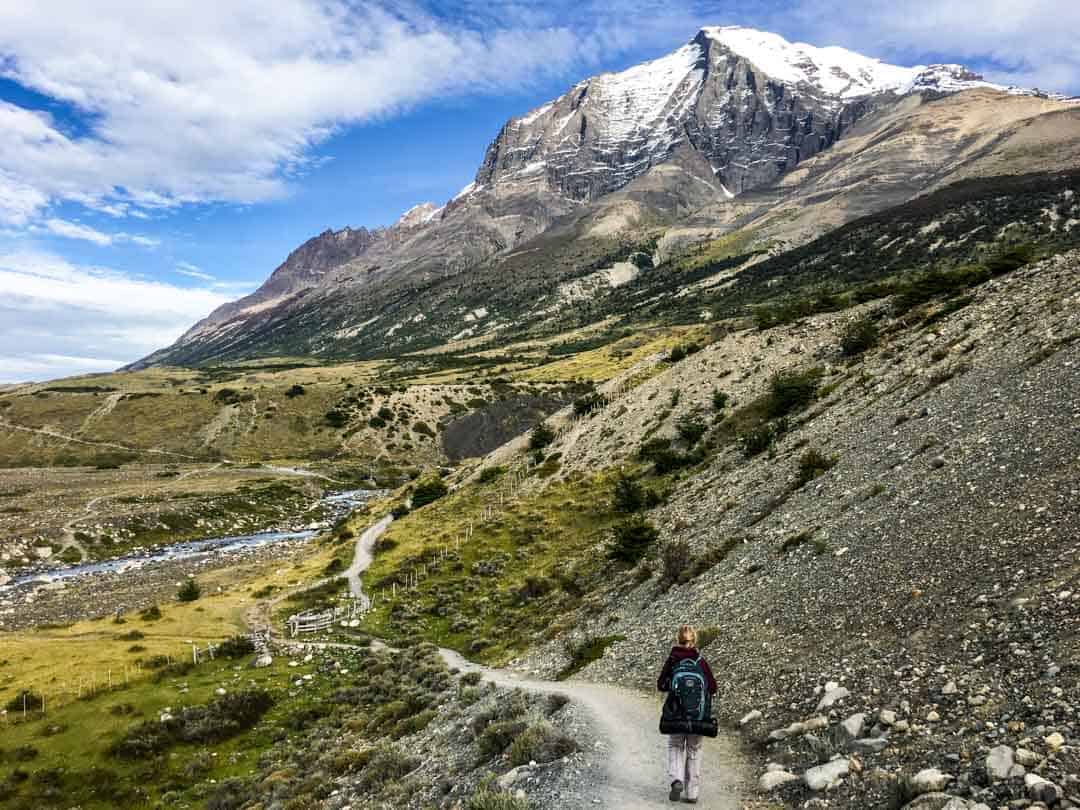
Hiking the W Trek Snapshot Location: Torres del Paine National Park, Chile Nearest town: Puerto Natales, Chile Getting to and from the park: Torres del Paine is easily accessible by bus from Puerto Natales. Park entry: Park entry tickets and overnight stays in the park (campsites and lodges) must be arranged before visiting the park. Start and finish: The W Trek traverses a roughly w-shaped route through Torres del Paine National Park between Refugio Las Torres in the east and Refugio Paine Grande in the west. For this itinerary, we start in the east and hike west. Distance: appx. 74 kilometres (46 miles) one-way Time: This itinerary is 5 days and 4 nights Difficulty: Moderately difficult, with some challenging stretches and steep climbs, plus highly changeable weather. We’re occasional hikers but with some preparation and a reasonable level of fitness, we found the W Trek very do-able (even if all our muscles were screaming for days afterwards!).
What’s in this post?
Preparing for hiking the W Trek Patagonia What time of year is best for hiking the W? Where to stay before and after the trek Entry to Torres del Paine National Park Booking Camping and Accommodation on the W Trail Bus tickets to and from Torres del Paine Packing for the W Trek Our Self-guided itinerary for hiking the W Trail Day 1 – Puerto Natales to Chileno via Las Torres Day 2 – Chileno to Francés Day 3 – Francés to Paine Grande via Francés Valley Day 4 – Paine Grande to Grey Day 5 – Grey to Paine Grande (and return to Puerto Natales)
This post contains affiliate links. If you find these links useful and you choose to purchase through these links we may receive a small commission, at no extra cost to you, which helps us to keep this website running. Your support is much appreciated!
Preparing for hiking the W Trek Patagonia
We aim to fully check and refresh this post for each trekking high season (October to April). Things can change without notice though, so we recommend also visiting the links below for information while you’re planning and before you go:
- For the latest updates on requirements for travel to Chile, visit the official Chile tourism website .
- Torres del Paine National Park is managed by the park agency CONAF. Visit the official national park website for park reports, park entry information and more.
- When you check-in at the park for your trek, you’ll receive an information guide with a map showing the park’s trails, services and accommodations. The current brochure can be found here .
What time of year is best for hiking the W?
Patagonian weather will keep you on your toes no matter when you visit Torres del Paine National Park. Be ready for everything. However, there are two distinct periods to be aware of when planning your trip.
High Season – October to April
These are the warmer months in the southern hemisphere, and December to March is the busiest time of year to trek in the park, with visitation peaking over January and February. During this period, you can choose to do a self-guided hike or go with a guide .
If you’re travelling in high season, and particularly if you’re planning to visit during the peak months, be sure to reserve your place in the lodges or campgrounds as far in advance as possible . Torres del Paine is now one of the most popular places to trek in Chile and overnight places book up very quickly.
We hiked the W trail towards the end of March, and while sections were busy, like the path to Las Torres, there were stretches where we wouldn’t see more than a handful of people in hours.
That said, despite making our campsite reservations months prior to our visit, we initially struggled to find availability and had to change our trekking dates to suit what we were able to book.
Low Season – May to September
Many people say winter is even more magical in Torres del Paine.
The park entry fee drops during the low season and you’ll find far fewer people in the park. But temps will also be lower, daylight hours are shorter, rain is frequent and there can be snow and ice. Many of the mountain trails are closed, as are a number of the mountain lodges and services. Trails that are open can also close suddenly due to weather (though that can happen at any time of the year).
Most importantly, to do the W Trek or hike to the base of Las Torres during the low season, you must have a qualified guide . This period typically runs from 1 May to the end of August, but check the official Torres del Paine website for more information if you’re planning to visit over this time.
The bottom line: No matter what time of year you visit Torres del Paine, given the changeability of the weather there, you should check in with park agency CONAF for latest updates and closures.
Where to stay before and after the trek
The nearest major population centre, and the main jump-off point for a Torres del Paine trek is Puerto Natales , a low-key Patagonian town hugging the shores of the picturesque Última Esperanza Sound.
The drawcard of Torres del Paine’s trails has seen Puerto Natales develop a buzzing trekker scene.
We suggest giving yourself a couple of days in Puerto Natales before your trek to get organised, shop, hire any gear you need, and sort out transport to and from Torres del Paine if you haven’t already (see our section on sorting out bus tickets further on).
Just about everyone staying in Puerto Natales is out and about doing the same thing, so having extra time in town means you can stress less if you don’t find what you’re looking for in the first place you visit.
Spending a couple of days here after your trek is also worthwhile – you can rest your weary bones and enjoy this charming little town.
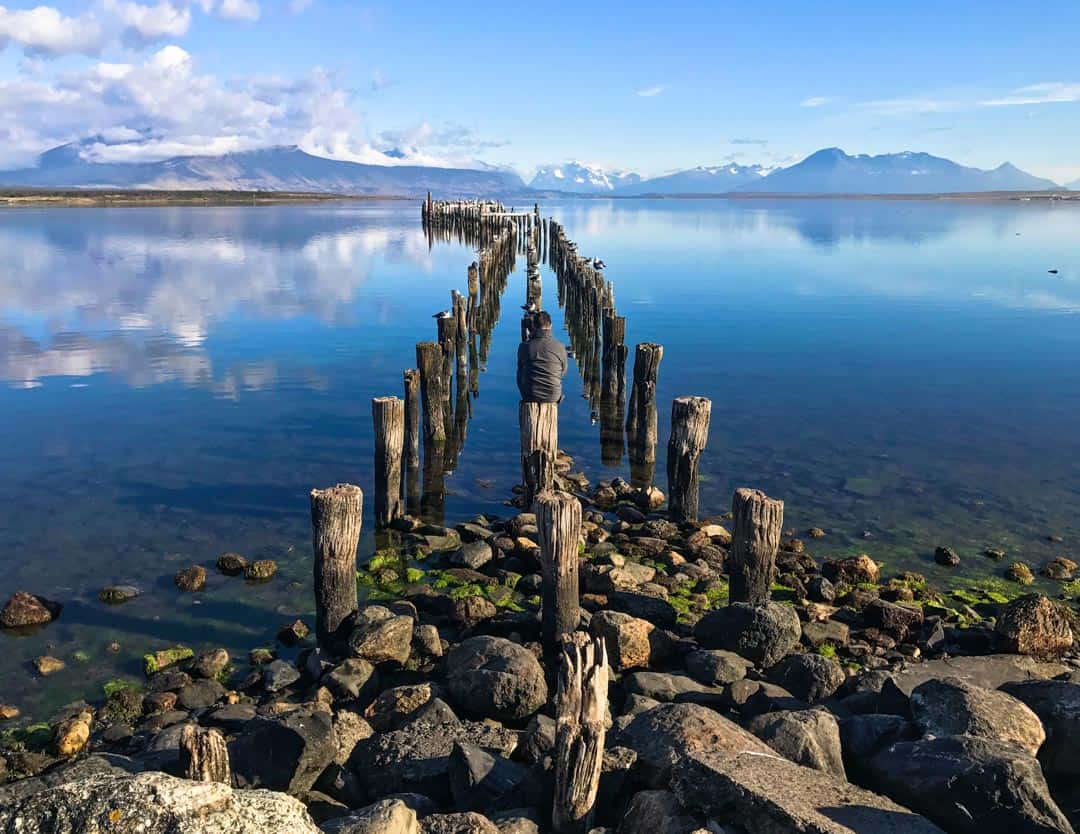
Accommodation in Puerto Natales
Puerto Natales isn’t a big place, but you’ll find everything from budget hostels through to five-star luxury in and around the town.
We stayed at the charming, centrally-located Hotel Aquaterra both before and after our trek. This is a great mid-range option and we really enjoyed our time here. They also stored our luggage for us while we were on the trail.
For more accommodation options like this in Puerto Natales, take a look at Booking.com . Or, if you’re after something more in the budget range, you’ll find various hostel options here .
One place we’ve definitely got our eye on for a future stay is this unique domed apartment . It’s about eight kilometres (five miles) out of town, but with the views this place has, we wouldn’t be moving from the window seats anyway. Perfect for a post-trek, legs-up retreat!
Entry to Torres del Paine National Park
Entry to Torres del Paine National Park is ticketed and there are capacity limits in the mountain lodges and campgrounds. This is for the long-term care and protection of this wild and remote place, and for the safety of visitors to the park. So whether you’re planning to hike the W, trek the O circuit or visit for the day, you will need a ticket to get into the park.
You must now buy your entrance ticket for Torres del Paine National Park at least 24 hours in advance of your visit to the park. You can no longer buy an entry ticket at the park itself. Visit the CONAF website to buy your park entry ticket .
Entry fees vary depending on whether you are Chilean or international, as well as your age, and whether you intend to stay in the park up to, or more than, three days. At last check, international adults 18 and over will pay CLP$31,200 (CLP is Chilean pesos) for up to three days in the park, and CLP$44,500 for more than three days.
Download your ticket to your phone before you head to the park (you won’t have reception there) and carry a printed copy just in case. You should also carry a copy of your passport as you may be asked to show your ID/nationality.
Booking Camping and Accommodation on the W Trail
There are various ways to stay overnight on the W trek in Torres del Paine National Park, but whether you’re planning a lodge stay, hiring camping equipment, or camping with all your own gear, you’ll need advance reservations to do so.
Overnight reservations are mandatory for Torres del Paine and, like park entry tickets, need to be made in advance . You cannot book camping or accommodation once you’re at the park, or camp outside the designated bookable camping zones.
You’ll also need to carry evidence of your overnight reservations as you may be asked to show proof at any time by a park ranger or when passing through checkpoints. We printed our reservation confirmations and carried these with us.
With trekking in Torres del Paine becoming ever more popular, limited accommodation spots and advance booking necessary, sorting out campsites or lodge accommodation is – in our experience – probably the trickiest part of planning a self guided W trek itinerary.
For this reason, we recommend booking your overnight stays as far in advance as possible , preferably as soon as bookings open for the season.
It also pays to be flexible about where you stay, as you may find you need to rework your trekking dates and approach based on what’s available.
Our final W trail hiking itinerary was the direct result of where and when we could get an overnight booking.
How to book your overnight stays in the park
There are a number of mountain lodges (refuges) and campsites in Torres del Paine, and you can only stay overnight in these designated zones.
Broadly speaking, the zones in the east are managed by Las Torres Patagonia (formerly Fantástico Sur) and those in the west are managed by Vertice Travel .
There are also a couple of free campgrounds in the park which are managed by the Chilean park agency CONAF. However, these campgrounds are closed for the 2023-24 season – visit the CONAF website for updates.
You can book direct via the Las Torres Patagonia and Vertice Travel websites, however we know from experience that trying to align availability and book spots for a workable W circuit itinerary across different websites can be complicated and time-consuming. Another reason to plan well ahead.
We’re now aware of a new website called Booking Patagonia , which offers an integrated booking system for travel, tickets and accommodation for Torres del Paine. Tours can also be booked through this site. We haven’t used it yet so we can’t personally vouch for it, but if you do use it, we’d love to know how you go (one of our readers has recently provided some feedback about their experience in the comments at the end of this post).
Bus tickets to and from Torres del Paine National Park
We based ourselves in Puerto Natales, the nearest town to Torres del Paine, before and after our trek and most travellers do the same. From Puerto Natales, it’s an easy bus trip to and from the park.
If you’re travelling by bus, we recommend organising your bus tickets to and from Torres del Paine well in advance . Don’t leave this until the day you head to the park or you may find the buses already full.
If you plan to buy your tickets when you arrive in Puerto Natales, aim to do so as soon as you arrive in town. You can buy bus tickets at the main bus station (Terminal Rodoviario), or through your hotel or hostel. We travelled to Puerto Natales by bus so we bought our tickets to Torres del Paine at the bus station the day we arrived. You can also search bus services and buy tickets online here .
It’s important to note that your bus drop-off/pick-up points at the park may vary depending on your final W trail itinerary, so keep this in mind when booking your bus ticket.
If you follow this itinerary and trek from east to west, you’ll start with the bus from Puerto Natales to Laguna Armaga . After your trek, you will board the bus at Pudeto for the return journey to Puerto Natales (this follows a catamaran ride across Lake Pehoe to Pudeto from Paine Grande). Vice versa if you’re hiking the W from west to east.
To ensure you’re on the trail in good time (and in line with this itinerary), we recommend booking one of the earliest buses out of Puerto Natales on Day 1.
Packing for the W Trek
Any hike, but especially a multi-day hike, can quickly lose its appeal if you’re carrying too much weight in your pack; something we can personally attest to. So we strongly recommend packing light and only carrying the clothes, gear and food you need for the trek.
If you’re travelling longer term and have more stuff with you – which was our situation – leave it in storage at your hotel. Your back will thank you for it.
You can find most of what you need to buy or rent in Puerto Natales for hiking into the surrounding landscapes, from sleeping bags, camping stoves and hiking poles to dried fruit and nuts for your trail mix.
That said, this is a small and relatively remote town and the local prices reflect it. We’re told there’s more choice and better prices at the supermarkets and shops in Punta Arenas, so if you’re coming from or via Punta Arenas, you might consider doing your trek shopping while in that town.
We’ve also read recent reports that it hasn’t been so easy to find dehydrated meals lately in Puerto Natales. If you’re planning your menu around these, you might think about sourcing them elsewhere.
It’s important to know that Chile has stringent rules around what foods you can and can’t bring into the country (fresh foods, fruits, honey, etc are a no-no). Be sure to declare any foodstuffs you do bring in and plan on buying most of what you need for trek meals and snacks once you’re in the country.
We had a tight meal plan for our spin on the W, but with hindsight, we would swap out some of the bulkier food stuffs we packed for lighter, more compact foods. Next visit, we’ll be looking to pack some dehydrated camping meals and light-weight but filling carbs like cous cous and oats.
The night before the trek, organise any food you’re carrying into daily packages of brekkie, lunch and dinner. Pre-bundling your meals saves scrabbling around in your pack for particular items on the trail). Then pack all the gear you’ll be taking with you in waterproof bags inside your backpack.
Cash, pesos or credit card? One question we get asked is whether to carry US dollars or Chilean pesos into the park, and whether the refuges accept credit cards. We carried all three. We paid for some things in pesos, like snacks and the shuttle to the trail head, and other things in USD, like the catamaran from Paine Grande to Pudeto. We also used our credit card at one of the refuges to buy beers. It’s our understanding that all of the refuges accept credit cards.
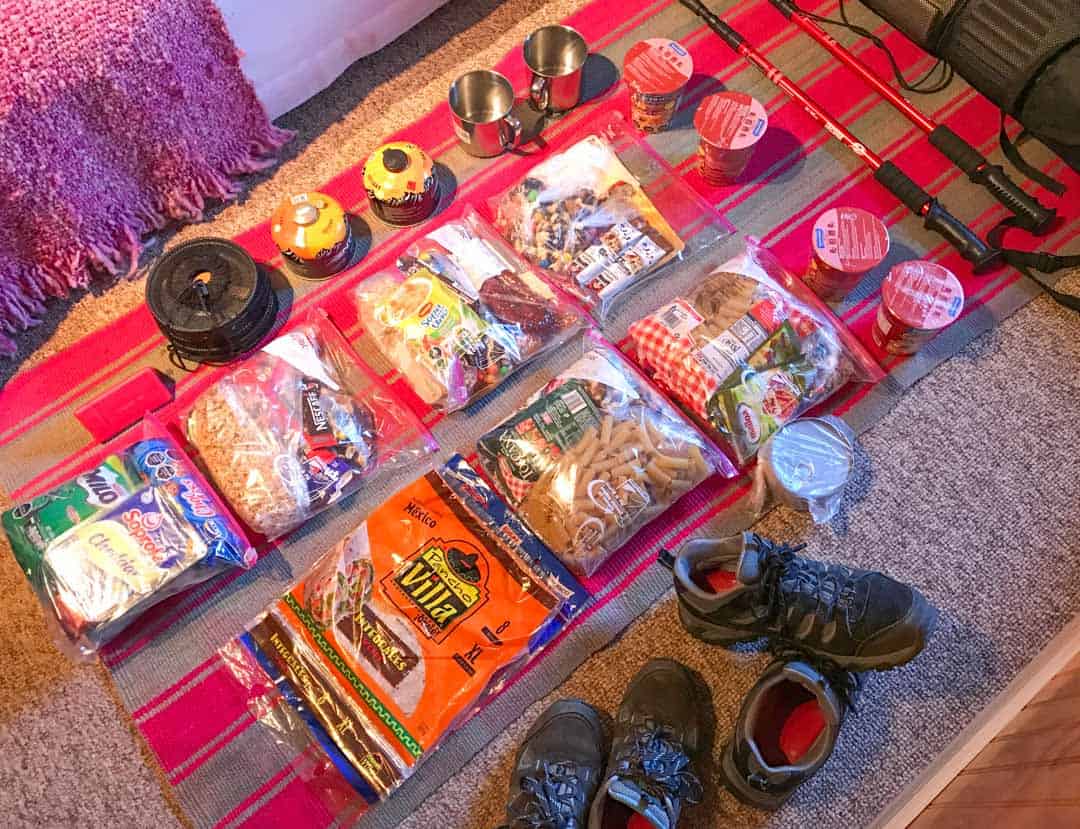
Our self-guided itinerary for hiking the W Trail
Day 1 – puerto natales to chileno via las torres, total distance: appx. 13.8 km (8.5 miles) total time: appx. 8 hours overnight: camping chileno.
Let’s get trekking! Hopefully you’ve secured your seat on one of the earliest buses out of Puerto Natales this morning (see above regarding buying your bus tickets in advance).
Buses making the run to Torres del Paine National Park generally depart from Terminal Rodoviario in town. Find your bus and load your pack, then kick back until it’s time to go. It’s around two hours to Laguna Amarga, the gateway to Torres del Paine National Park, so settle in, this is a perfect excuse to grab some extra sleep before starting the hike.
When you arrive at the Laguna Amarga Ranger Station, have your pre-purchased park entry ticket ready on your mobile phone or bring a printout. Here, you’ll check in and receive information about visiting the park, and its rules and regulations.
Don’t forget to buy your entrance ticket for Torres del Paine in advance, and at least 24 hours before you head to the park . It’s no longer possible to buy entry tickets on arrival at at the park. Head to the CONAF website for more information .
At Laguna Amarga, hikers split into two groups: those starting their journey here at the eastern end of the park, and those heading to the western starting point at Paine Grande, which involves a further bus trip to Pudeto and a catamaran ride across Lake Pehoé (even if you’re hiking west to east, you’ll get off the bus here to check-in before reboarding the bus for Pudeto).
If, like us, you’re hiking the W from east to west , your next step after check-in is to jump aboard the Hotel Las Torres public shuttle bus from Laguna Amarga to the Welcome Centre and the eastern starting point of the trek. This costs around US$5 per person and is paid in cash as you board (we paid this in pesos).
Alternatively, you can start your hike here from Laguna Amarga. The shuttle will just spare you a dusty 7 kilometre walk along the gravel road.
There’s a toilet at Laguna Amarga, and another at the Welcome Centre. This is a good chance to go before setting off into the mountains.
Trekking tip: We booked our first night’s accommodation at Camping Chileno, which is en route to today’s main destination – the towering granite peaks of Las Torres. We’ll be checking in at Chileno on the way and dropping off our packs ahead of the steep and challenging climb to the Las Torres mirador. If, however, you’ve booked your first night at Hotel Las Torres or Central Refuge and Camping, then we’d suggest dropping off your packs there first, and setting out on today’s hike to Las Torres with a lighter load.
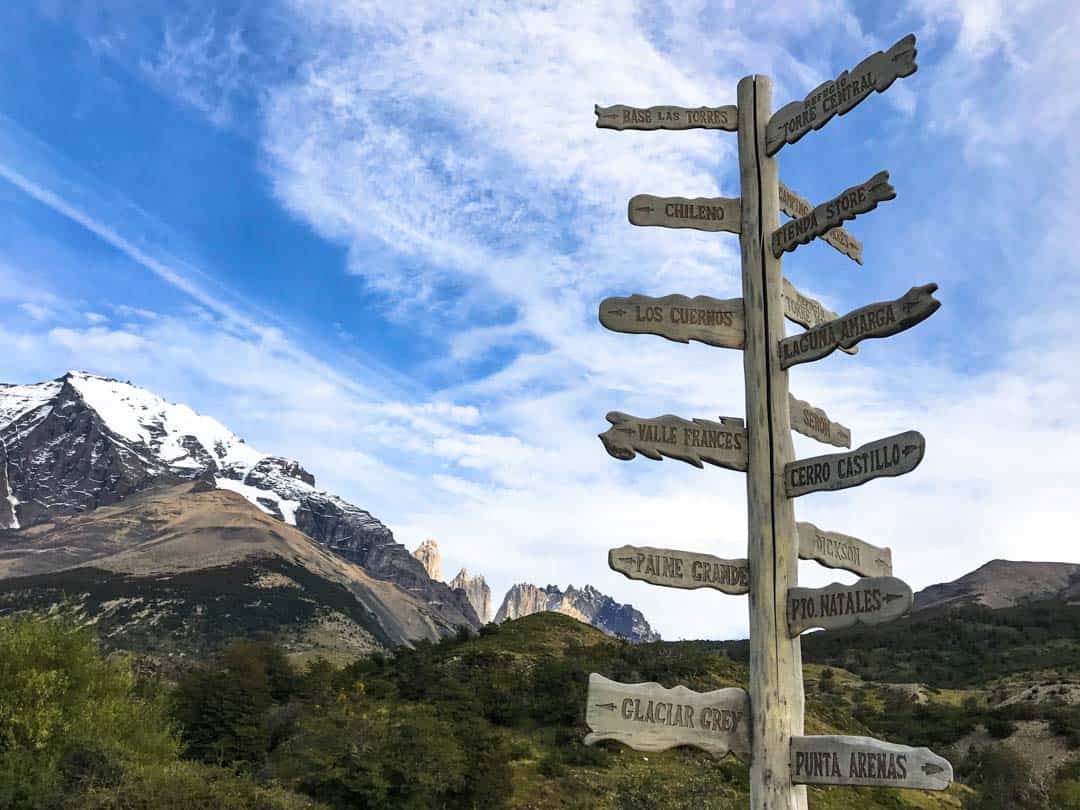
1st Leg: Hotel Las Torres to Chileno ( appx. 5 km / 3.1 miles, around 2 hours)
We’re officially underway on the W trail around 10.30am and from the word go, the views are eye-popping. After a flat kilometre or so, the path starts to climb: get used to it, it’s pretty much uphill from here.
The hike is moderately steep in some spots, until about a kilometre (0.6 miles) or so from Camping Chileno, where the trail flattens out a little before descending into the campground.
Despite feeling like our hearts might explode for much of this first stretch, we cover the distance in around two muscle-busting hours, with frequent stops to take in the views, rehydrate, and give our racing pulses a break.
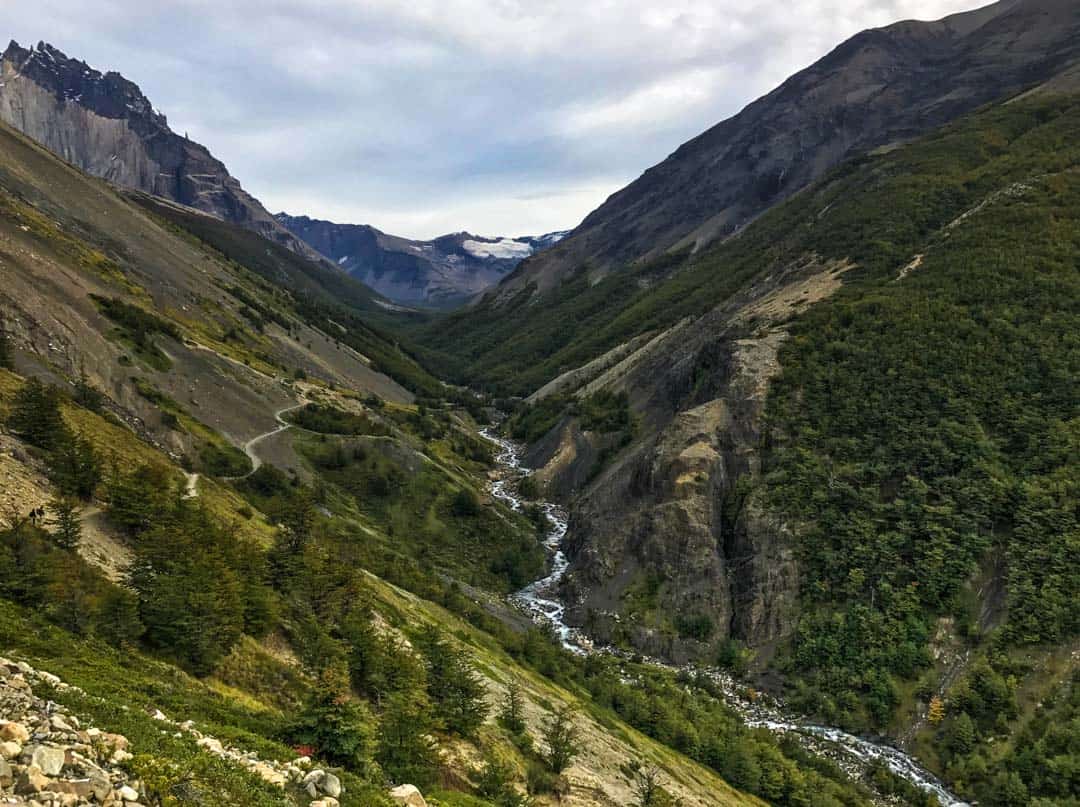
Drinking water There’s no need to lug extra water with you on the Torres del Paine circuit. You’ll pass pristine mountain streams regularly throughout your journey. Bring a water bottle, fill up at nature’s tap and enjoy some of the purest water you’ll ever drink. Just remember to top up well away from the camps and upstream of the trails.
We haul our packs into Chileno around 12.30pm . This campground is operated by Las Torres Patagonia (formerly Fantástico Sur), and is the closest camp you can stay at to the famous Las Torres hike and mirador (the CONAF-managed campground near the base of the Las Torres climb has been closed for some time).
The riverside setting at Chileno is truly stunning and the sheer peaks of the three granite towers – our ultimate goal today – rise tantalisingly above the forested mountains ahead.
The campground itself is a nice set-up of tiered camping platforms among the trees. There are shared bathrooms with hot showers, and a restaurant and bar with big windows, plus an outdoor terrace for soaking up the epic views.
Our tent is ready for us when we arrive at Chileno, so we check in, drop our bags in our tent, grab a smaller pack with snacks, water bottles and cameras, eat the lunch we prepared last night, and set out for Las Torres around 1.30pm . Timings here may vary depending on your check-in.
2nd Leg: Chileno to Las Torres (appx. 4.4 km / 2.7 miles, around 2 hours)
This is without doubt today’s toughest leg, so there’s a huge bonus in not having to tote your full pack up the mountain.
From Chileno, you’ll hike for around 3 kilometres (1.9 miles) or so along a meandering path through pretty woodland, across rushing rivers, and through a wonderfully moody stretch of fallen forest that we dub the ‘tree cemetery’. It’s a lovely, moderate walk, and we have no sense of what’s ahead when we reach the sign that tells us ’45 minutes to Mirador Las Torres’.
My notes from this point in our trek simply state: ‘hiking hell starteth here’. A touch dramatic maybe, but as irregular hikers, this was probably the hardest section of the entire W for us. Maybe you’ll breeze through it, just be ready for it.
Shortly after the sign, the climb to Las Torres begins in earnest. It’s a gritty, rocky terrain of steep, gravelly inclines and large boulders. The panoramas as you climb are absolutely breathtaking, but so is the hike itself. There are moments while we’re in the throes of it, looking up and spotting the tiny trekkers far above, that this stretch feels like it will never end.
It does end though, about an hour later, and the scene that awaits as we round a final boulder and face the towering granite pillars of Las Torres makes every single breath-wrenching step worth it.
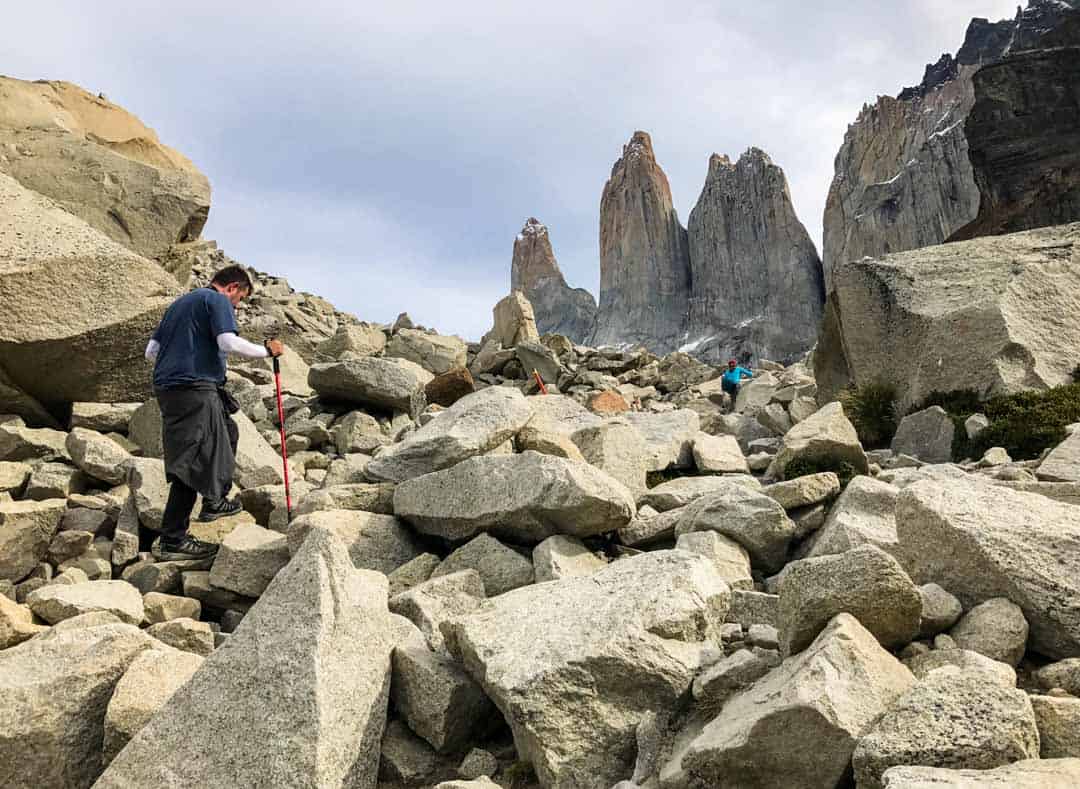
It’s buzzing at the top: hikers drape the rocks surrounding the glacier lake; a bushy-tailed Patagonian fox weaves its way between the boulders; there’s even a guy getting his hair cut at the water’s edge (one hairdresser’s quirky approach to memorialising his travels while promoting his business).
We spend some time taking pics before settling onto a boulder of our own to simply take in this awe-inspiring scene. Aim to spend around an hour at Las Torres .
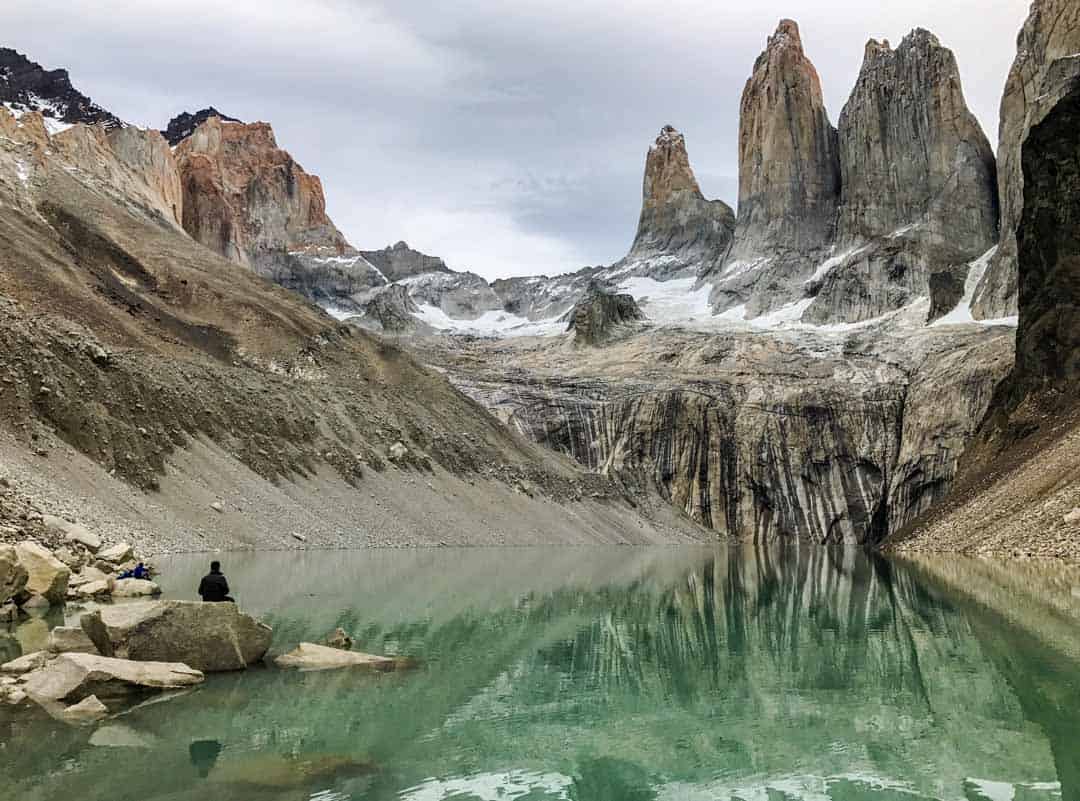
3rd Leg: Las Torres to Chileno (appx. 4.4 km /2.7 miles, around 2 hours)
The journey back down from Las Torres is in some respects even more challenging than the climb up. The constant down is tough on knees and the gravel makes the going slippery. We’re beyond grateful for our hiking poles, though we both still manage to pull off some memorable butt slides.
Trekking tip: Hiking poles made all the difference for us when we were trekking in Patagonia. We carried one each, which was ideal as it left us both with a hand free to grab branches and rocks, haul each other up and down, and catch our fall when we slipped. Which was often.
It takes us around two hours to get back to Chileno; we have time to shower, buy a couple of well-earned beers and watch the sunset burn the tips of Las Torres molten gold.
It was cloudy the entire time we were up at the base of the towers, so watching them all beautifully backlit now is a bit of a kicker, but if there’s one thing you’ll learn quickly hiking the W Patagonia, it’s that the weather doesn’t give a rats what you think.
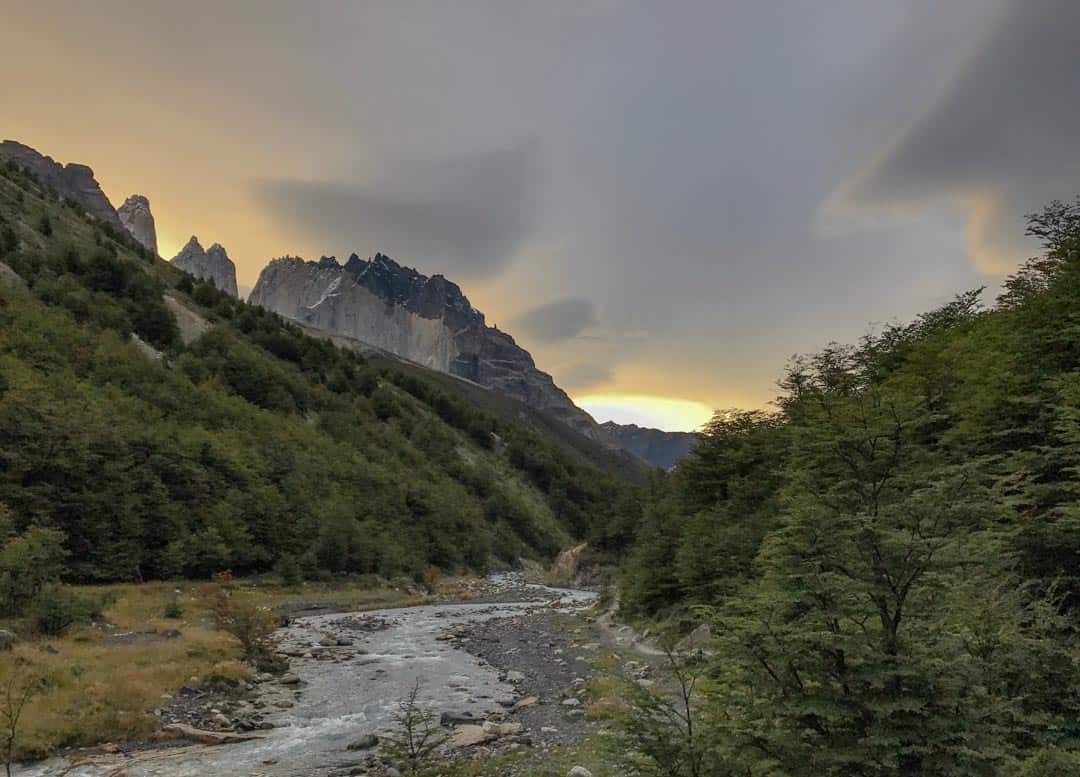
Preparing for Patagonian weather If there’s one constant about the weather in Patagonia, it’s that there’s nothing constant about it. We were particularly lucky on our five days in Torres del Paine, but you should be ready for four seasons in a day. Layer up, have a rain jacket handy, and wear quick-dry clothes. Skip a rain cover for your bag though. While we never experienced the legendary winds that tear through the park from time to time, we heard plenty of stories of pack covers being whipped off suddenly and disappearing into the wilds. Expect to get rained on, and pack your gear in bag liners or waterproof bags inside your backpack instead.
Cooking stoves are not allowed to be used in the Chileno zone, so we opted for the full board food package here, which includes dinner tonight, breakfast tomorrow and a packed lunch to take with us.
Later in the evening, we join a host of other hikers in the restaurant for a surprisingly tasty and filling three-course meal full of protein and carbs.
We’re absolutely wrecked by the end of dinner, and we’re tucked up in our sleeping bags by 9.30pm.
Sunrise at Las Torres When we originally planned our itinerary for hiking the W, we had every intention of doing a second trek to Las Torres for sunrise on Day 2. In late March, this would have entailed getting back on the track up the mountain by 5.30am . As we climbed into our sleeping bags that first night though, we decided to pull the pin: we were just too tired, and we were also a little wary of making the tricky climb in the poor dawn light.* It was a tough call at the time, and it didn’t help when we poked our heads out of our tent the next morning to see the torres erupting with golden light above the silhouetted foreground. As we watched though, the clouds rolled in and soon enough the peaks were shrouded in mist. There’s no accounting for Patagonian weather, or how your body may feel after a long day of hiking. The best you can do is plan, and be flexible on the day. *PS. For safety reasons, hiking in the dark isn’t actually allowed in Torres del Paine. Trail sections have opening and closing times, check the park brochure for more info.
Day 2 – Chileno to Francés
Total distance: appx. 18 km / 11.2 miles total time: appx. 6 hours 45 minutes overnight: camping francés.
Sunrise is around 8am when we do the W trek in late March, and as we haven’t made the dawn hike to Las Torres, we enjoy a more leisurely start to the morning on Day 2.
If you do decide to do the dawn hike up to Las Torres for sunrise, factor in around five hours this morning and adjust the following timings for today’s next legs accordingly.
As breakfast is part of our full board package at Camping Chileno, we pack up our gear and head to the dining room at 8.30am for a hearty kickstart to the day.
1st Leg: Chileno to Los Cuernos (appx. 15 km / 9.3 miles, around 4.5 hours)
We’re on the trail by 9.15am , heading back towards Hotel Las Torres. We won’t be going all the way to the hotel though as there’s a shortcut off to the right around half-an-hour after leaving Chileno. The shortcut is signposted and takes you along a mostly downward sloping path surrounded by undulating hills and lake views.
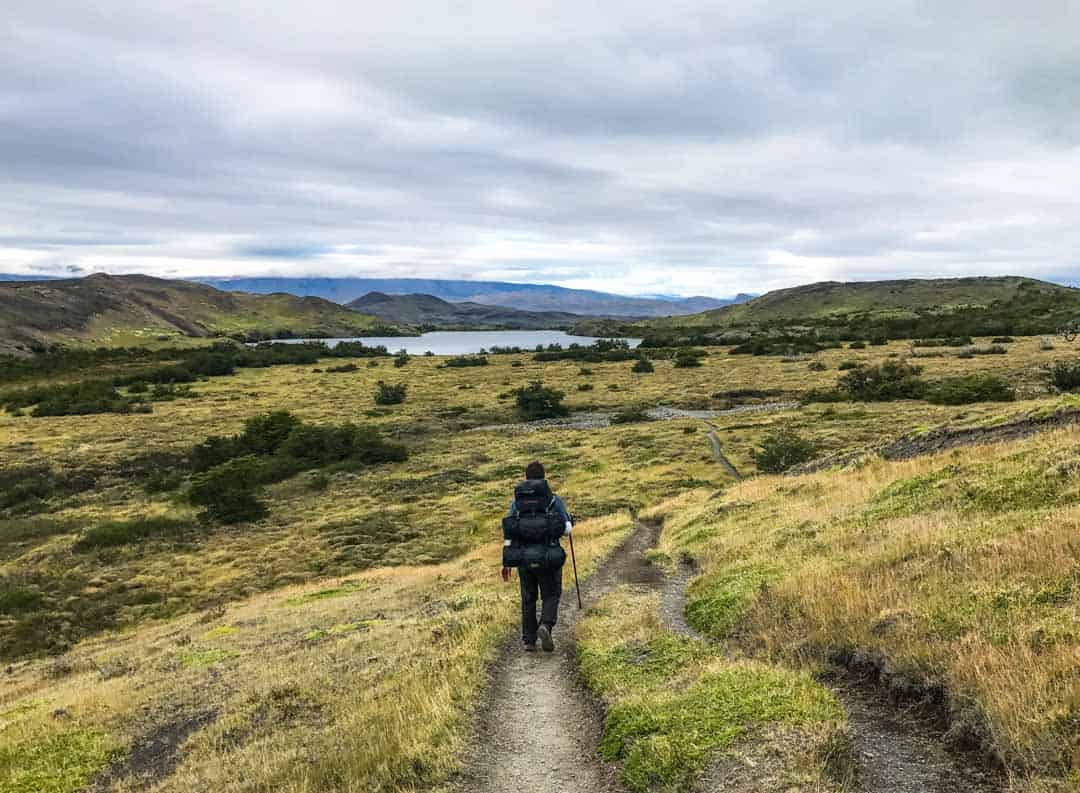
We reach the end of the shortcut and rejoin the main W route around 11am . At some point after this though, we suddenly find ourselves in what can only be described as the Patagonian Swamps of Mordor and we start to wonder whether we’ve veered off on to a secondary trail by mistake.
We can still glimpse the Nordernskjöld Lake off to left, and we know the official trail travels alongside it. To this day, we’re unsure if we did actually go off piste (though the number of bootprints in the mud suggests not).
Eventually, we seem to be back on track according to the map, just a little muddier for the experience (and even more grateful for our depth guage hiking poles).
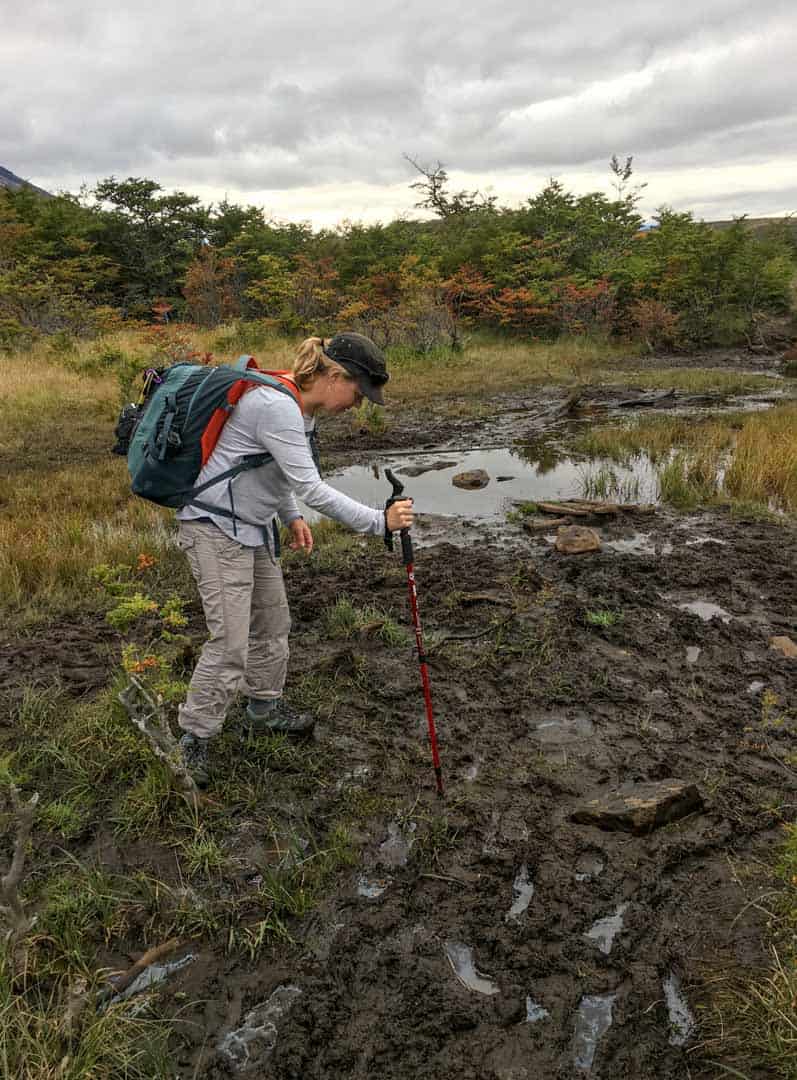
The next stretch travels up and down through very pretty lakeside country, with the occasional steep section, before passing down into the valley at Los Cuernos. We arrive at the Los Cuernos shelter and camping area around 1.45pm .
You could stop at any point along the stretch to Los Cuernos for a lunch break; we stop just past the shelter and find a nice rock with a view. We opted for the full board meal package with Camping Chileno so we’ve been provided with a packed lunch today as part of this.
We chill for around 45 minutes and then set off around 2.30pm for Camping Francés , where we’ll be staying tonight.
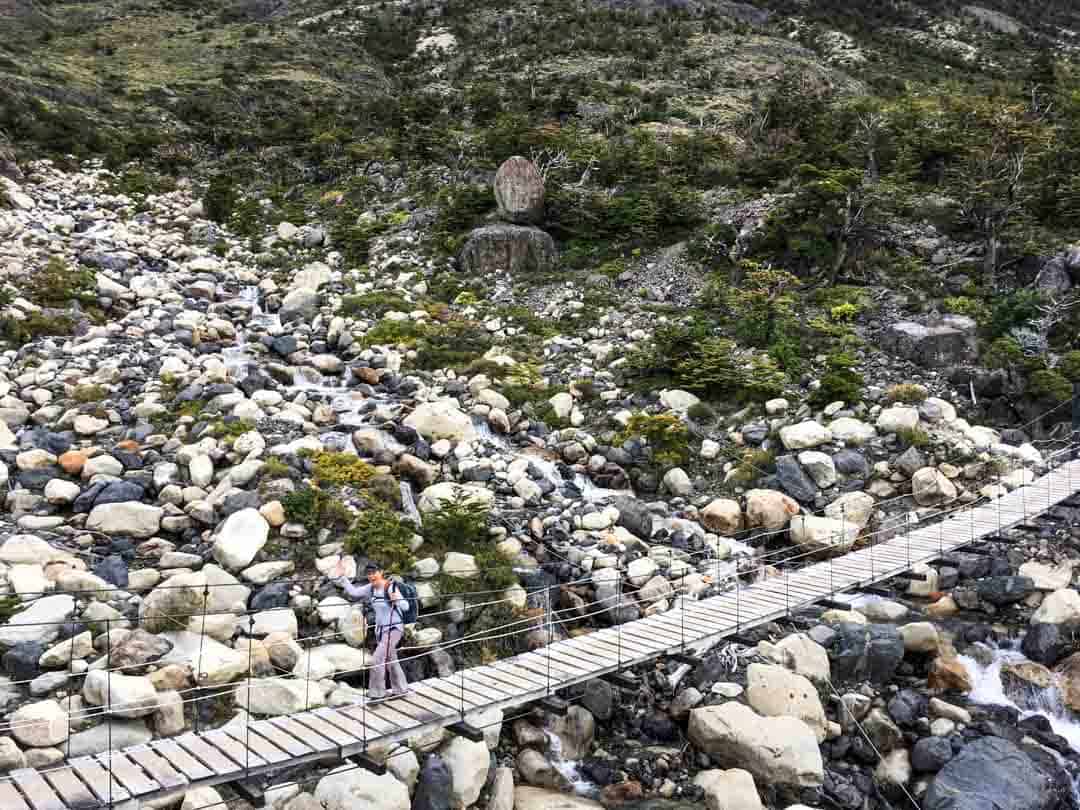
2nd Leg: Los Cuernos to Francés (appx. 3 km / 1.9 miles, around 1.5 hours)
The trail to the Francés campground is up and down and rubbly, with some steep sections, and a pretty pebbly beach crossing. Today’s walk has been positively sedate compared to yesterday’s heart-starter climbs, but never fear, a leg-burning rise awaits just before the descent into the camp.
We arrive at Camping Francés around 4.00pm . The campground here is run by Las Torres Patagonia (formerly Fantástico Sur).
The tent platforms are clustered between the trees and there’s a good shower and toilet block a short walk from the campsite. There’s also a small shop with basic amenities.
By 5.15pm we’re checked in and set up on our platform. We’ve arranged for a tent at Camping Frances but we’re cooking our own food tonight.
Sunset is close to 8pm in late March, and having made it through our second day on the W trail, we’re zipped up in our sleeping bags soon after.
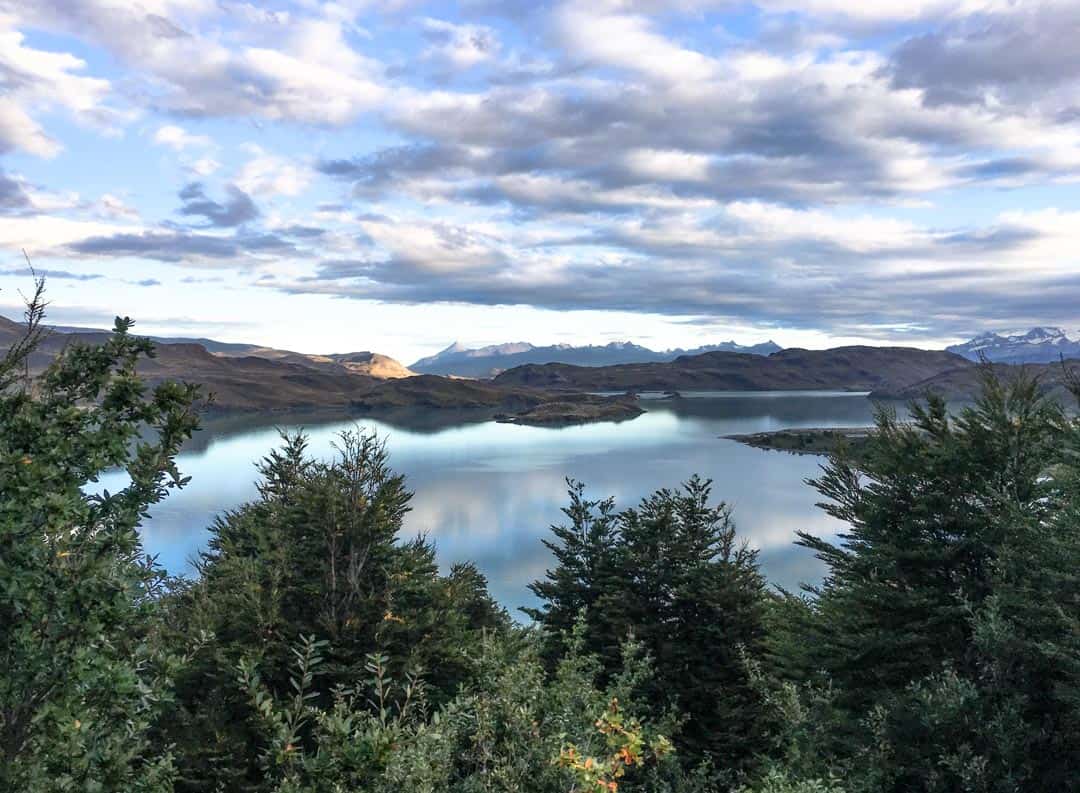
Day 3: Francés to Paine Grande via Francés Valley
Total distance: appx. 20.3 km / 12.6 miles t otal time: appx. 9 hours overnight: camping paine grande.
Despite our fatigue, neither of us sleeps particularly well on our second night and we’re both groggy when the alarm goes off at 7am.
Our restlessness is partly due to the strange soundtrack that has accompanied us throughout the night: sharp cracking sounds like distant shot gun blasts and deep, thunderous rumbles. It’s not until we set out on the trail through the Francés Valley today though, that the source of the unnerving noises becomes obvious.
On this itinerary, today is the longest day hiking the W, and based on our experience, we recommend getting on the trail by 8am at the latest to maximise your time in the Frances Valley. We departed later when we trekked, so we’ve adjusted the timings below to suit an earlier start.
1st Leg: Francés to Italiano Ranger Station (appx. 2 km / 1.2 miles, around 30 minutes)
The first leg this morning is a rejuvenating, 30-minute leg-stretcher to Italiano Ranger Station. Aim to pack up and set out from camp by 8am.
There’s a ranger at the Italiano Ranger Station when we arrive. He points to some racks opposite the office building; this is where we opt to leave our backpacks ahead of the challenging hike into Francés Valley.
We sort our valuables and lunch into a smaller daypack, lock up the big packs, and get going again. Look to be back on the trail by 8.45am .
2nd Leg: Italiano Ranger Station to Británico Lookout (appx. 5.4 km / 3.4 miles, around 3 hours)
The first kilometre (0.6 miles) out of Italiano is a flat trail through pleasant forest, after which the track starts to climb steeply through a rocky, rubbly stretch.
The scenery is seriously beautiful, serving up views of the ironically named Paine Grande Hill – 3,050 metres above sea level – and the Francés glacier that clings to it. This is the source of the crackshots and grumbles we’ve been hearing as the hanging ice shifts, melts and avalanches down the mountain.
Soon enough, you’ll reach the Francés mirador, a lookout offering spectacular panoramas over the ‘hill’ and its glacier; this is the perfect spot for a short break and a snack, as the next stretch is tough.
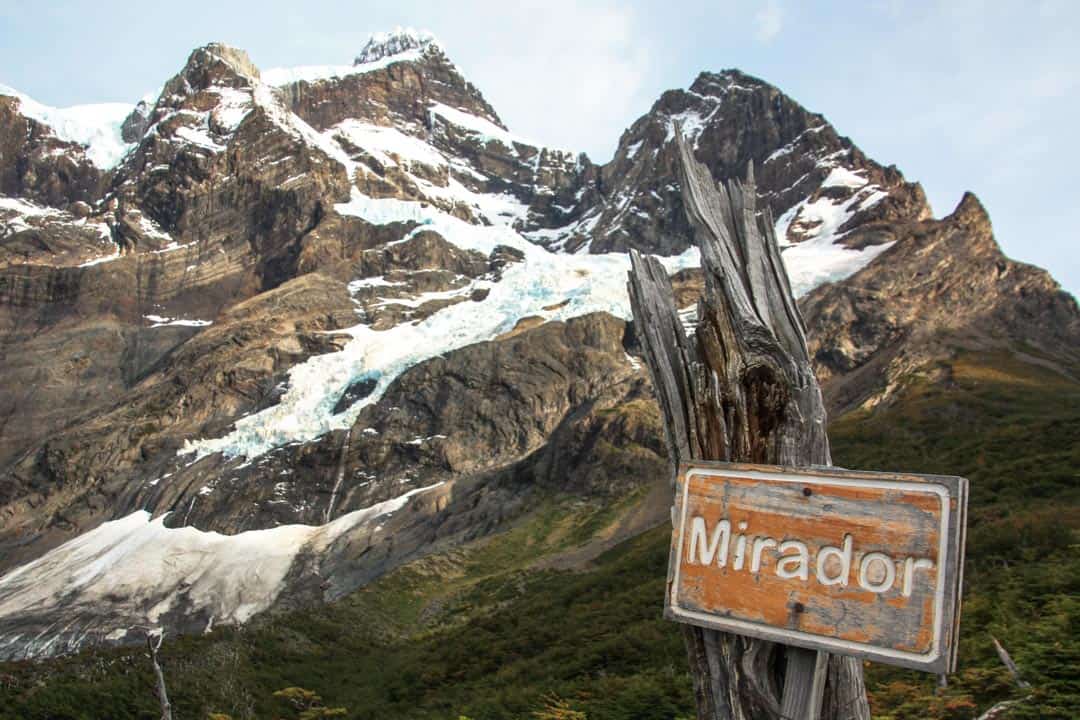
From here, the trail to Británico Lookout is a challenging, rubble-strewn boulder dash with lots of climbing.
A flat, rocky clearance scattered with the parched white trunks of dead trees and overshadowed by the jaw-dropping Cuernos massif, marks the final stretch before a steep, 10-minute climb to the mirador itself.
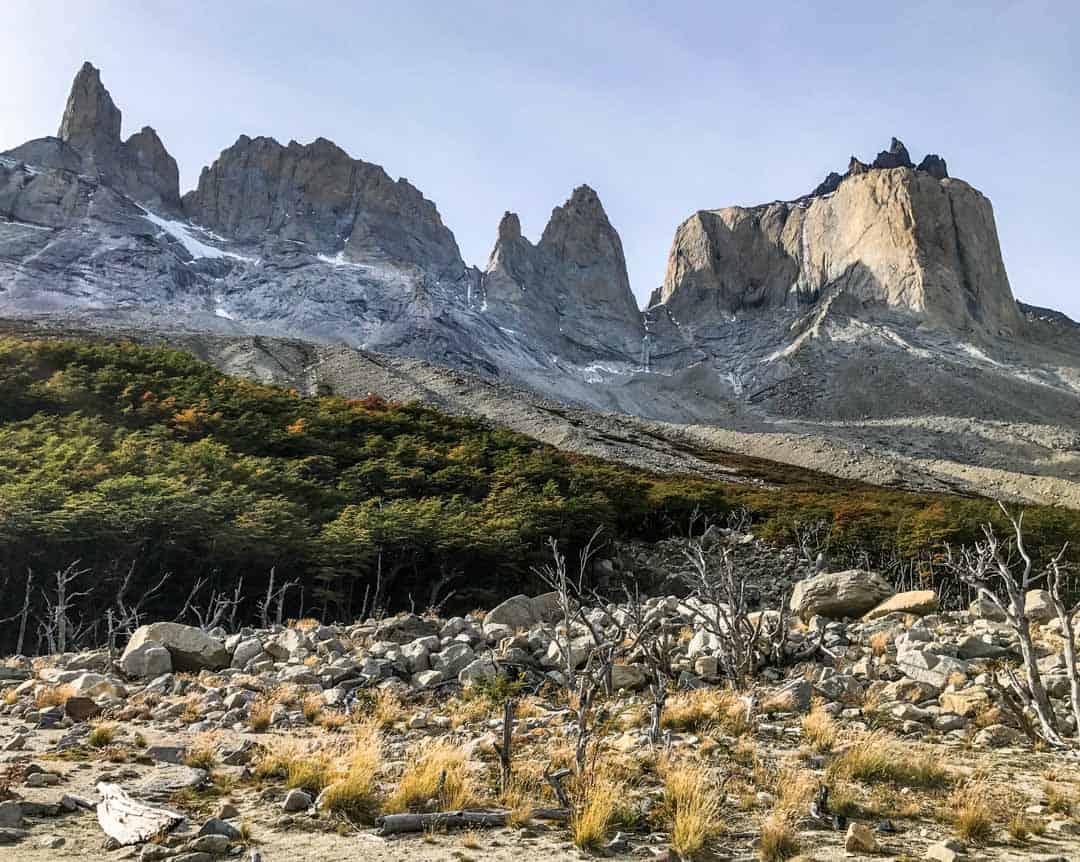
Summitting the boulders of the Británico Lookout around three hours after setting out , we cast our eyes over what will become our favourite panorama of this epic journey: the vast and spectacular Francés Valley. Find a rock to perch on and settle in for lunch with this glorious scene at your feet.
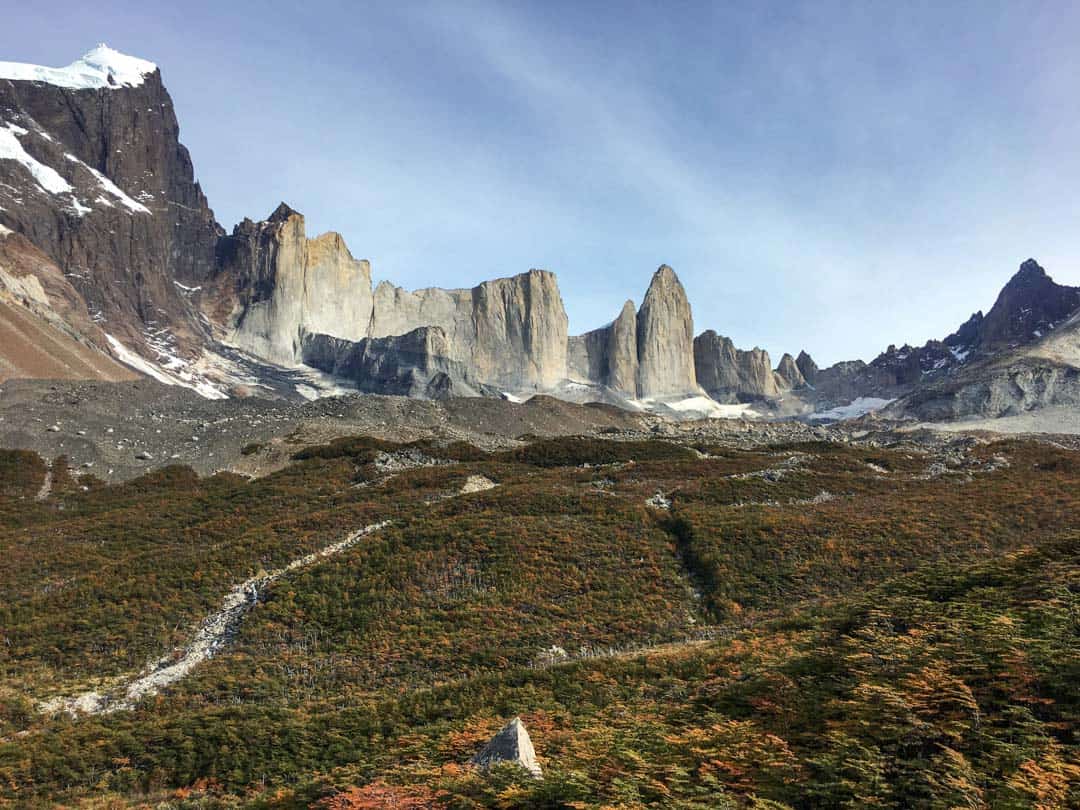
We’ve come a long way, but there’s still a huge day of hiking the W ahead. To our eternal regret, we were only able to linger here for half an hour as we left camp too late on this morning. That’s why we recommend getting on the trail no later than 8am today – trust us, you’ll want as much time at Britanico as possible and by arriving around 11.45am, you’ll have close to an hour here.
We’ve promised ourselves that next time, we’ll spend an extra day or two in this valley so we can take in this view at our leisure. For us, this remains one of the most magnificent vistas we’ve come across in all our world travels.
Trekking tip: Get on the trail by 8am at latest this morning so you can hang out for at least an hour at Britanico, or better yet, stay an extra day in the Francés Valley.
3rd Leg: Británico Lookout to Italiano Ranger Station (appx. 5.4 km / 3.4 miles, around 2 hours)
Aim to set off back down the trail to Italiano around 12.45pm . We find this a knee-buckling downward journey and our legs are screaming by the time we reach our packs back at the Italiano Ranger Station just over two hours later.
Once we’ve retrieved our packs (now four-deep in a giant bag pile), re-sorted them, and stopped for a quick breather, we set out for the Paine Grande refuge and camping area, starting with a bridge crossing out of Italiano. It’s around 3pm by this stage .
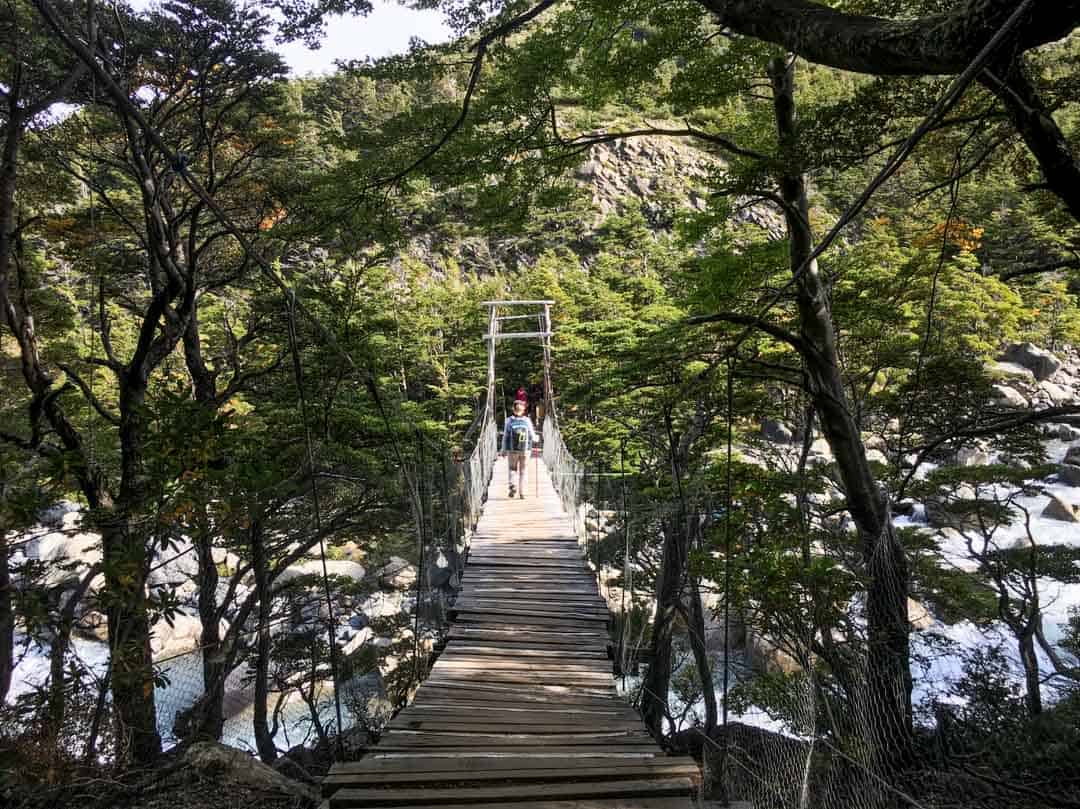
4th Leg: Italiano Ranger Station to Paine Grande (appx. 7.5 km / 4.6 miles, around 2.5 hours)
The final stretch of the W trail today is a journey of around 7.5 kilometres (4.6 miles) and it’s mostly flat with some sloping ups and downs.
Travelling out of the valley and along the raised walkway as you head towards Sköttsberg Lake, remember to turn around and take in the mountain scene back the other way: it is immense.
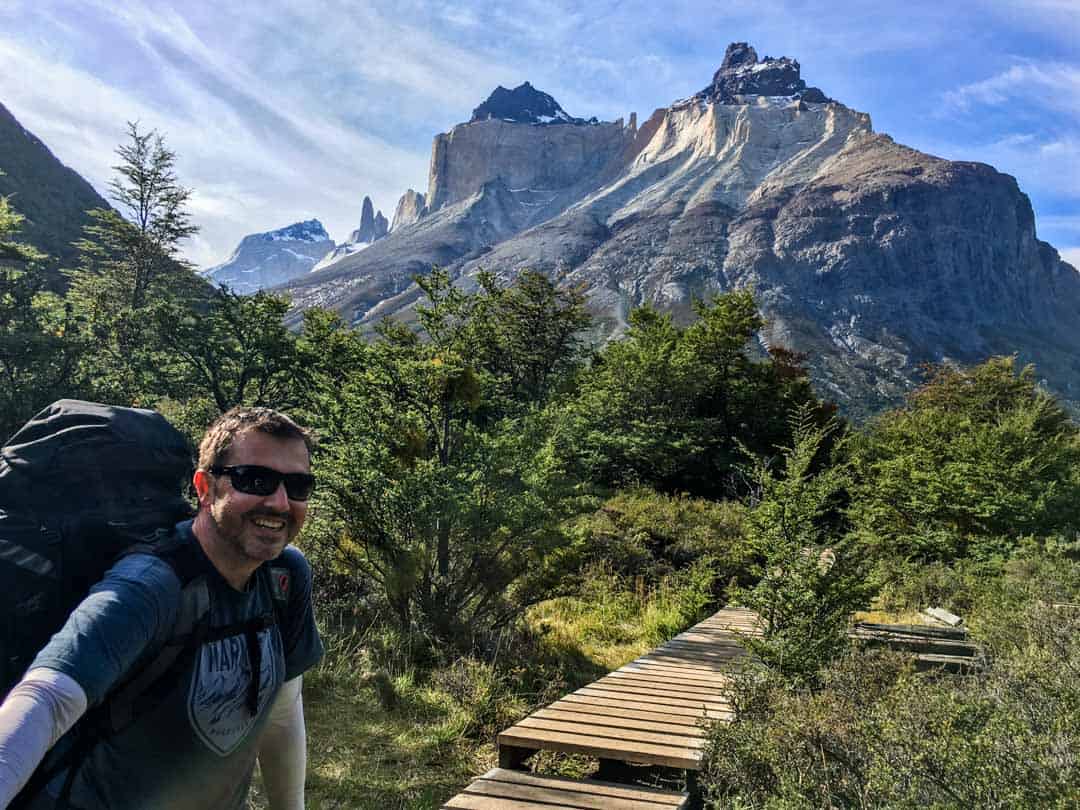
After some more steady rises, we make our final descent into Paine Grande Refuge and Camping around 5.30pm . By this stage, we’re seriously sore and tired and very ready for a beer from the lodge bar, which is the first thing we do once we’ve checked in and dropped our packs at our tent.
The campground at Paine Grande, which is managed by Vertice Travel, is large and separated into sections for campers carrying their own gear, and those like us who have booked a tent. A wooden walkway links the campgrounds with the lodge, the campers’ kitchen and bathrooms.
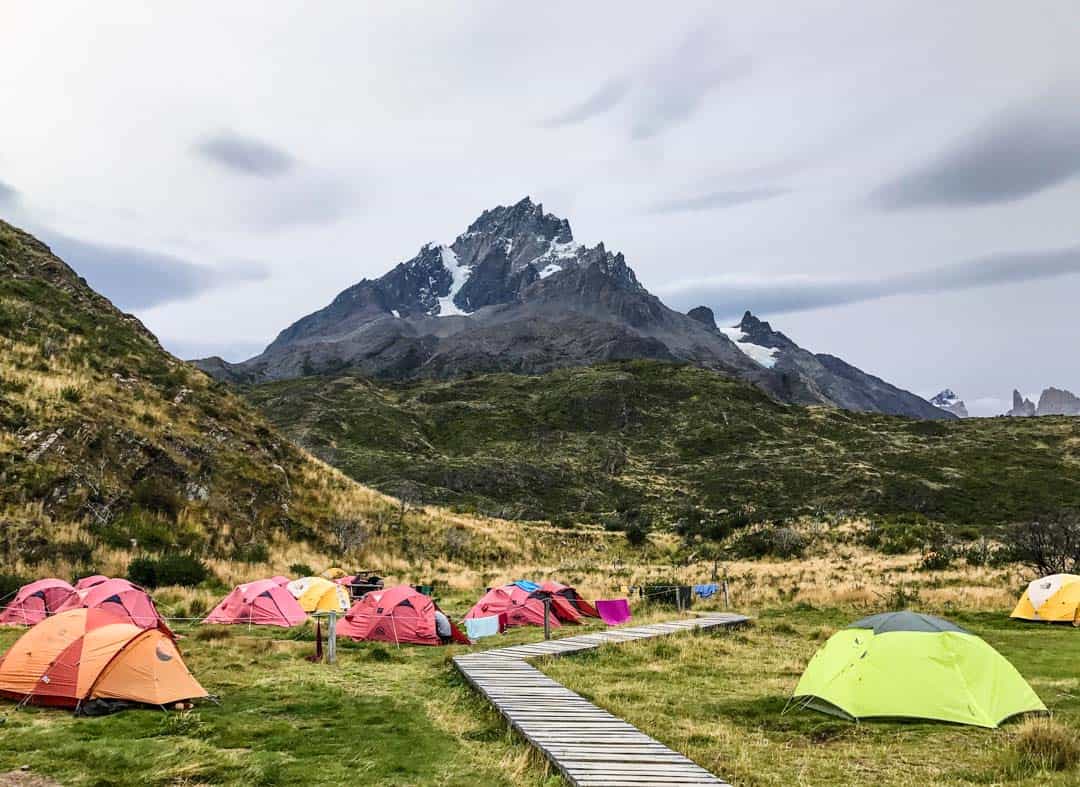
As Paine Grande is the western starting point for hiking the W and a transit point for O circuit trekkers, as well as for day trippers and short stay visitors, this is the largest and busiest lodge and campground in the park.
There’s a good-sized kitchen building, which is heaving with trekkers when we make our way in there to cook dinner around 7pm.
The camp shower and toilet facilities here are basic. We recommend getting your ablutions out of the way while everyone else is cooking dinner and before the post-meal rush. Paine Grande also has dorms, a restaurant and bar, and a mini-market.
We’re tucked up in our tent just as a light rain begins to fall around 8.30pm.
Day 4 – Paine Grande to Grey
Total distance: appx. 11 km / 6.8 miles total time: appx. 3 hours 45 minutes overnight: camping grey.
Today is our shortest day so far on the W trail, so we decide to set out a little later as we’re definitely starting to feel the past three days’ hiking, and a strange kind of exhilarated fatigue.
We’re up at 8am with plans to be on the trail by 9am. However the banshee-like screeches of a fox followed by the thrilling appearance of a large, tawny-coloured puma on the hill behind the camp has us – and everyone else – lingering for a while in hushed awe, until the sleek big cat disappears around a bend into the next valley. Which happens to be the same valley we’re about to trek into.
After checking in at the ranger station for advice on what to do if we see the puma again, we set off through the narrow, pretty dell at around 10am . We’re both relieved (and maybe a touch disappointed) to find no further sign of our feline friend.
The big cats of Patagonia Don’t let the thought of pumas roaming the forests of Torres del Paine put you off trekking there. The fact is, these magnificent creatures are extremely shy and actively avoid humans. Seeing a puma is incredibly rare. Spotting one near camp as we did is apparently almost unheard of. However, it’s important to be across what to do and how to act if you do encounter a puma; you’ll find advice on this in the guide that you receive when you register for your Torres del Paine trek.
The valley walk is flat at first but soon begins to climb, and continues to serve up steady inclines followed by some steep descents into the Grey refuge and camping area.
The scenery on this leg is still epic, but maybe a touch more serene than the high drama mountainscapes of the last couple of days. Grey Lake is flat and still on the day we hike the trail, and dotted with blueish lumps of ice from the vast Grey Glacier at its head.
About halfway along the trail, a rocky lookout reveals the first glimpses of this immense glacier, a sea of ice six kilometres (3.7 miles) wide and 30 metres (98 feet) high in places.
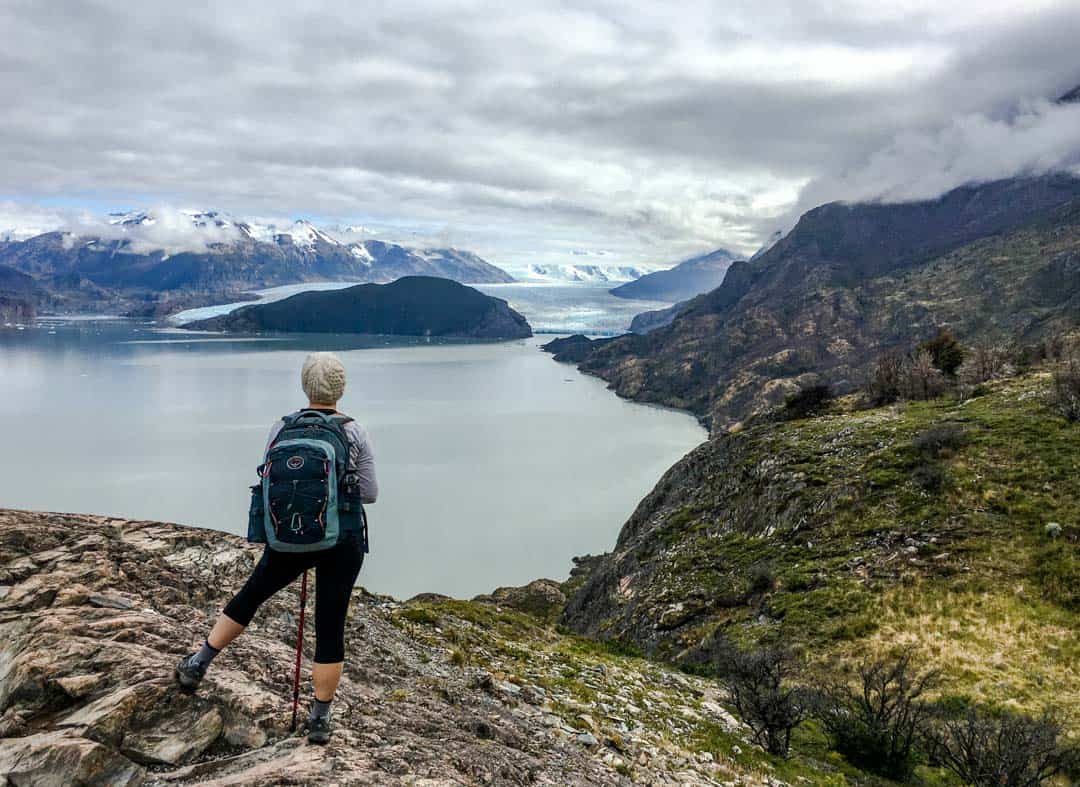
We arrive at the Grey Camping area around 1.45pm , a journey of 3 hours and 45 minutes, with plenty of photo and snack stops along the way.
Grey Refuge and Camping is also operated by Vertice Travel. The lodge has a lovely bar and lounge area in addition to its dorms, and the campground out front is overlooked by the stunning peaks of the Cordon Olguín. By the time we arrive, the clouds have cleared and the mountains burn golden as the sun drops.
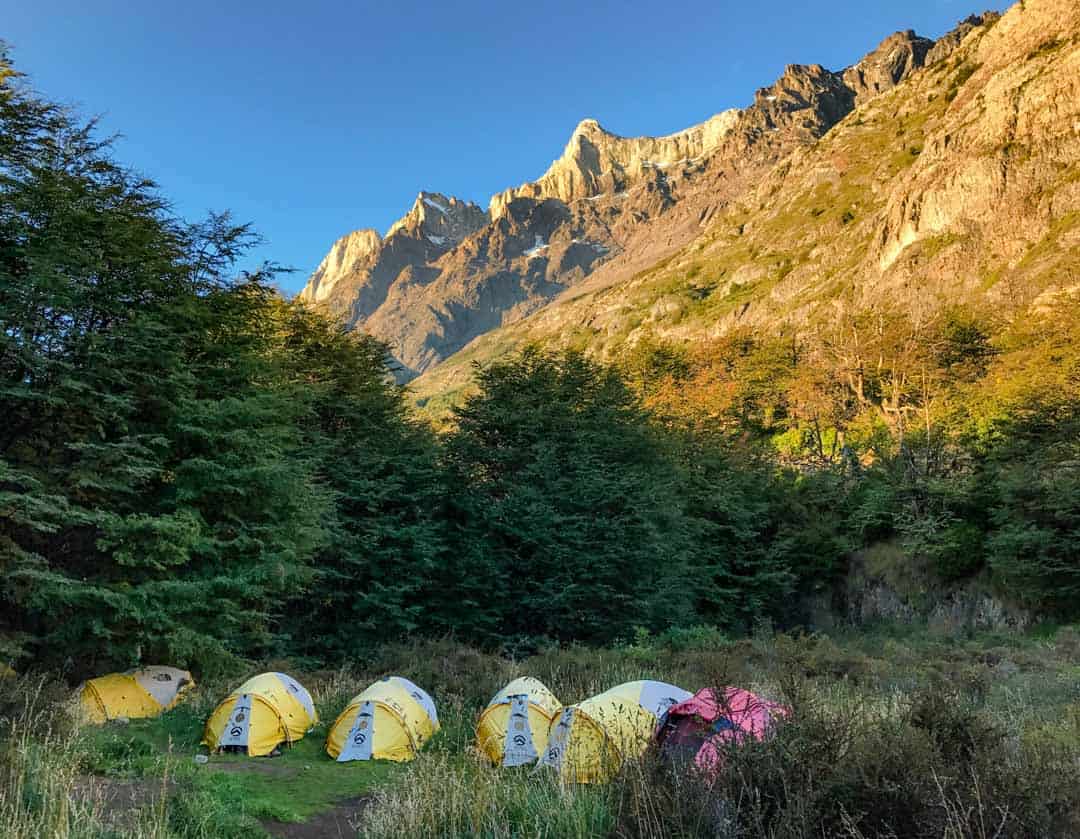
If you’ve got the energy, check in (or leave your pack with the office if check-in hasn’t opened yet), and then head back out to hike past the western tip of the W trail and on to the first leg of the O circuit towards Paso Ranger Station. This will bring you much closer to the glacier, but bear in mind, it’s a five hour, one-way hike to Paso itself.
Trekking tip: Leaving Paine Grande at 10am worked well for us, but if you do want to hike a stretch of the trail from Grey towards Paso and back to Grey today, consider starting out from Paine Grande earlier in the morning so you have more time to do this.
We opt to stop and enjoy our lunch with mountain views, then roll out our mats and nap in the sun until check-in opens.
After getting our tent sorted, we hike to a rocky outcrop on the lake just 15 minutes from camp. The views from here towards the glacier’s terminus are gorgeous and we spend time here just soaking up the scene.
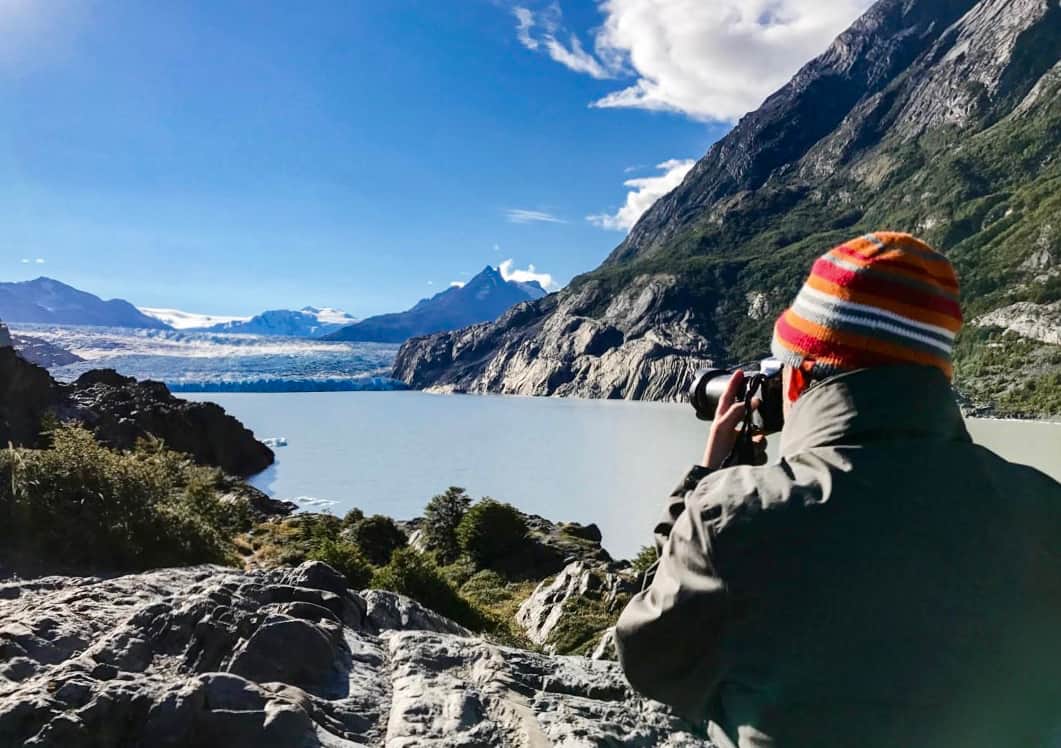
On our return to camp, we head to the lodge for a drink at the bar before making dinner on one of the picnic benches outside the buzzing campers’ cooking area.
In addition to the bar, there’s a restaurant at Grey, and a small shop selling grocery basics. There’s an equally small toilet and shower block for campers (the showers only have certain hours of operation but the water is hot).
We’re in bed by 9pm and prepped for a very early departure in the morning.
Day 5 – Grey to Paine Grande (and return to Puerto Natales)
Total distance: appx. 11 km / 6.8 miles total time: 3 hours 15 minutes.
It’s our last day on the W hike! We’re on the trail early so we can get back to Paine Grande in time for the late morning catamaran across Lake Pehoe to Pudeto, where we’ll pick up the bus back to Puerto Natales.
It shouldn’t take more than four hours to get back to Paine Grande from the Grey campground, but we’re feeling pretty exhausted by this stage and John has nurtured some nasty blisters, so we’re up and on the trail before sunrise .
It’s freezing when we set out at dawn but as the day lightens, we’re treated to a stunning peach-tinted sky reflecting off the lake, and we stop often to snap pics.
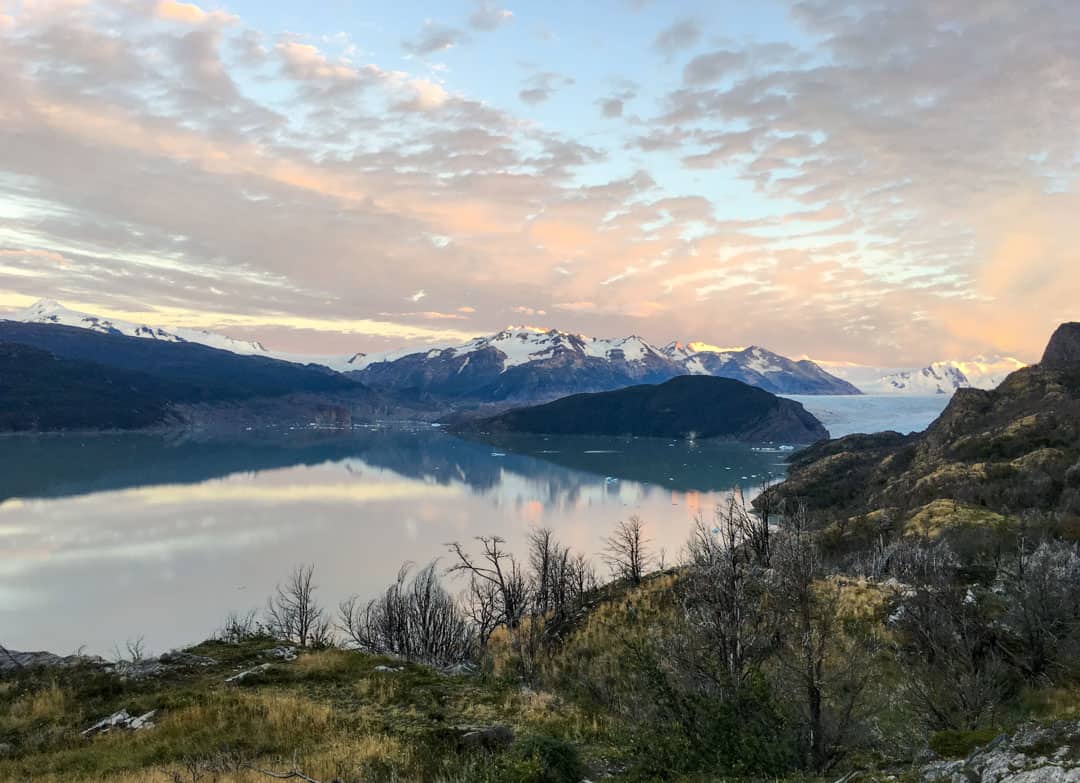
Despite John’s sore feet, we make good time on the return journey and while we’re climbing for much of the first half, it feels easier than the trek up from Paine Grande yesterday. Maybe it’s because we’re on the home run, even though the thought makes us sad.
Our journey back to Paine Grande takes us 3 hours and 15 minutes , 30 minutes less than yesterday’s hike in the opposite direction.
We haven’t eaten breakfast and we’re starving by the time we arrive. We were planning to grab something to eat at the restaurant at Paine Grande, but we discover it’s closed between breakfast and lunch.
We make do with our leftover trail mix instead, which is a bigger deal than you might think: we packed way too much of the bitty hiker’s snack and after five days we have a serious love/hate relationship with it.
Fortunately, there’s now a mini market at Paine Grande, which is apparently open from 7am. But if you’re setting out really early like us, perhaps have something you can eat on the go for this final morning.
Tickets and times for the ferry between Paine Grande and Pudeto Ferry departure times from Paine Grande and Pudeto change throughout the year so be sure to check the schedule when you’re planning your w trek itinerary, and adjust your final day hiking start time to ensure you arrive back at Paine Grande at least 30 minutes before the ferry departs. You don’t need to reserve a place on the boat, just hop aboard and buy your ticket with cash (at last check, it’s US$30 for internationals). The journey to Pudeto takes around 30 minutes.
We board the late morning catamaran for our return to the eastern side of the park. The boat trip across Lake Pehoé offers spectacular views of the entire mountainscape we’ve spent the last five days traversing. It’s an epic perspective of the W panorama and a mesmerising finale to our W trek itinerary.
If the weather is nice, we totally recommend taking a seat outside on the catamaran so you can properly admire the breathtaking scenery.
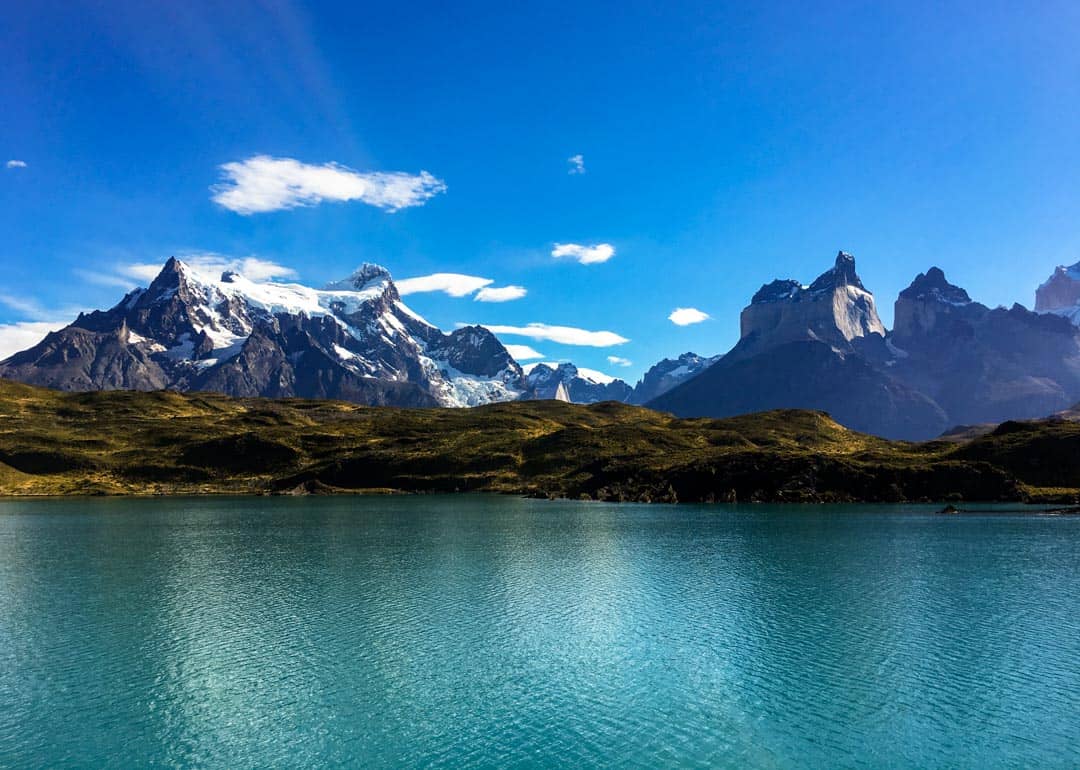
Disembarking the ferry at Pudeto, we grab a coffee from the lakeside café (open from October throughout the trekking season), take a seat in the sun, and enjoy our last moments in Torres del Paine while we wait for our bus.
Pudeto ferry and bus connections In addition to checking ferry times for the catamaran between Paine Grande and Pudeto when you’re organising your trek, it’s also worth checking the bus connections to and from Pudeto, so you can work out the best approach for your final day on the trail.
From Pudeto, the bus makes its way back to the Laguna Amarga Ranger Station to collect hikers finishing their trek at the eastern end of the park. From there, we settle in for the return two hour bus journey to Puerto Natales .
Tonight, back in Puerto Natales, after a good hot shower and a lamentation on the ridiculous amount of trail mix we’ve got left over, we head out for a celebratory drink.
Our legs might be seizing, our knees protesting and we’re beyond exhausted, but we’re buzzing with the sheer thrill of having completed this epic trek. We’re already talking about when we might come back and hike the W trail again, or better yet, take on the longer O circuit.
However we do it, trekking in Torres del Paine is one nature experience we’re keeping firmly on our bucket list.
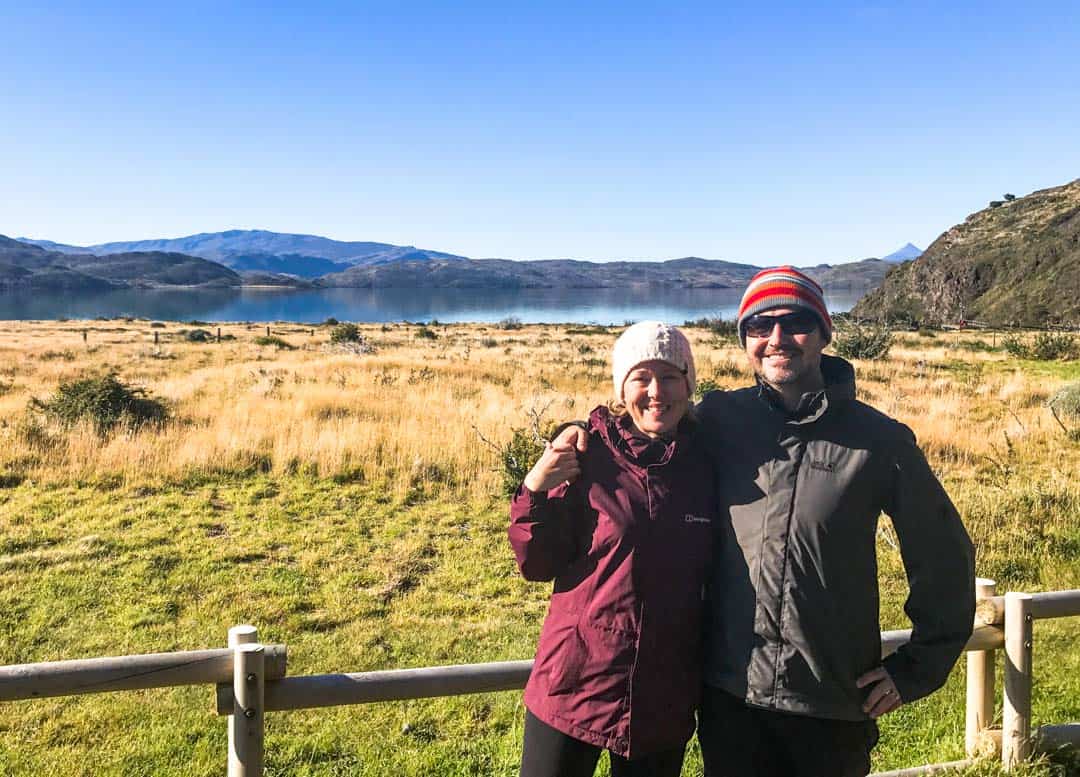
Got any questions? Have you trekked in Torres del Paine recently? We’d love to hear from you, drop us a message below.
For more exciting experiences and things to do in this incomparable part of the world, head to our Chile page or our South America section.
49 thoughts on “Hiking The W Trek In Patagonia: A Self-Guided Itinerary [2024]”
Great website! We’re hoping to do this February/March 2025, and are wondering how best to spend our time on either side of this hike. Did you travel to El Calafate and El Chalten while you were in the area? Or do you recommend other areas down there? Any advice greatly appreciated!
Hi Lisa, thanks for your message! Fantastic to hear you’re planning a trip to Patagonia! Besides the W Trek, there are various activities you can do in and around Puerto Natales and Torres del Paine, like boat trips on Grey Lake to Grey Glacier or horseback riding.
We most definitely did travel to El Calafate and El Chalten after our trek and absolutely recommend, especially if you’re keen to get out on some further hikes. We bussed from Puerto Natales to El Calafate and the next day did a day trip to the Perito Moreno Glacier, which is an absolute must. From El Calafate, we travelled by bus to El Chalten (the panoramas on the bus ride in are wow – try and get the front seats!) and spent a good couple of days exploring this gorgeous area and just hanging out. There are a range of hikes you can do out of El Chalten – the day hikes to Laguna de Los Tres and Cerro Torre are epic.
If you head south from Puerto Natales to Punta Arenas, you can do day trips to see King penguins, Magellan penguins, whales and dolphins, so that’s another option.
Have a wonderful time and happy trip planning! Cheers, Danielle
Thank you for sharing your Patagonia insights! I found it very thorough and incredibly helpful. I we are planning our trip for October 2024. I have a question. How did you book your meal plan? Thanks! Kim
Hi Kim, thanks for your feedback, we’re glad you’ve found our post helpful! When you go through the booking process for each accommodation (including camping) along the trail, you’ll have the opportunity to add meals as part of those bookings. Links to the accommodation providers are in the post. Good luck with your planning and happy trekking in October! Cheers, Danielle & John
Hi thank you so much for this detailed blog. It appears that one would have to stay at Frances camp if going east to west in order to shave hiking time on day 3. Is there a bus company through which we have to pre-book a bus ticket from Pudeto ferry to Las Amargo? Or is it a shuttle service? Do you have any idea if booking a guided tour via Las Torres means that they carry your heavy rucksacks?? Is the last day at Grey really worth it ? Or would you rather end the trek on day 4? Thank you!
Hi SK, thanks for your message. Until the CONAF Italiano camp reopens, Frances camp is the closest camp to the Frances Valley so yes, it is the best bet timing-wise for getting in and out of the Frances Valley and on to Paine Grande on Day 3 if travelling from east to west. You could also stay at Los Cuernos, but that would add around 1.5 hours to Day 3.
The buses running from Puerto Natales to Torres del Paine drop off and pick-up from Laguna Amarga and Pudeto. When you buy your bus ticket to Torres del Paine, you’ll note where you’ll be getting off and on again (it will depend on your itinerary, but for us, travelling from east to west, we got off at Laguna Amarga and boarded at Pudeto on our return. Check out the section in our post on bus tickets to and from the park for more info. There’s a shuttle that runs between the Laguna Amarga ranger station and Hotel Las Torres for a fee.
We would suggest contacting the tour company you’re interested in for advice about whether porter services are available on their guided tours. We left most of our luggage in one of our backpacks at our hotel in Puerto Natales and carried only what we needed for the trek to keep the weight down.
We personally feel that every leg of the W is absolutely worth it – the scenery is superb throughout. Five days gave us just the right amount of time to enjoy the whole trail without pushing too hard. To do the trek in four days, you’d likely need to compromise on either the full hike into Frances Valley or the Grey leg in order to reach camps before dark, and we wouldn’t want to skip either. But that’s us. If four days was all we had to trek, we would possibly leave Grey but we’d have to make sure we did a boat tour out to the glacier instead! 🙂
All the best with your planning! Cheers, Danielle & John
This is seriously one of the best breakdowns I’ve read. Patagonia is one of three “Someday” treks I have on my list to head off on once my son is a little bigger and can carry more of his own gear. We’re building up now with longer and longer trips around Central/Eastern Europe
Love this site!
Thanks for your message Brian, we really appreciate your feedback. So cool that you and your son are already hiking together, and what an awesome bucket list adventure to look forward to with him! Happy trekking and thanks again! Danielle & John
Do you have a map with the accommodations you booked or where you rented out tents/gears? Planning on doing this solo in June!
Hi Erika, thanks for your message! There’s a trail map available at the official Torres del Paine website: https://parquetorresdelpaine.cl/mapa-2023-2024/ – it shows all the accommodations/campsites along the trail. You can also find links in our post to the accommodation providers we booked our campsites and camping gear through.
As you’re considering a June trip, we’d also encourage you to check out the official Torres del Paine website for information about winter hiking regulations – https://parquetorresdelpaine.cl/permisos-especiales/ . Many of the accommodations and trails close over winter and while you can visit the park, we understand it’s mandatory to have a guide for the W Trek and the trek to the base of Las Torres between 1 May and 30 August (though the timeframes can change depending on weather). All the best with your planning! ~ Danielle
Hello Dan, What a great find this was. Thank you so much for writing it. I’m looking to mimic your trek with some modifications. I will very likely have a car rental when I arrive into Punta Arenas. My plan is to drive myself and 2 others into the park and leave the vehicle parked at the welcome center or hotel (unsure if this is allowed). At the end you mention that you ferry to Pudeto- then catch a bus that swings by Laguna Amarga into Puerto Natales. Is there a bus that goes directly back to the welcome center or hotel from Pudeto so we can get back in my rental? It looks like the Laguna Amarga ranger station is about 8.5 km from the welcome center. Or is it best to just shuttle from Puerto Natales for the whole thing and leave the rental somewhere in town?
Hi Bruce, thanks so much for your message and feedback! Very good question re. parking – based on our limited research into this, our understanding is that you can leave your car at Hotel Las Torres while you trek if you’re a guest there, otherwise, cars can be parked at the nearby Welcome Centre. We’ve also seen reference online to a small car parking area at Pudeto, so in theory you could arrange bus tickets from Pudeto to Laguna Amarga, and from there get the hotel shuttle to Hotel Las Torres/the Welcome Centre. I would suggest posting your question on Tripadvisor and hopefully someone has done something similar recently and can provide latest info. It might also be worth contacting Hotel Las Torres and asking their advice; no doubt they get questions like this frequently. All the very best for your trip planning and the trek itself – it’s an unforgettable experience! Cheers, Danielle & John
Thank you so much for the great information. I’m a long term planner and we’re looking to book for our family of four, Christmas 2024. I found this blog really really helpful in hiking cost effectively. Thanks Again!
Hi Melissa, thank you so much for your message, we’re really happy you’ve found our post helpful in your planning. Also very excited for you and your family – what a fantastic Christmas experience! We hope you have a really wonderful time hiking the W, it’s just such an incredible place! All the best and happy hiking! Danielle & John
Thanks for the article, I find it very useful. I have just booked the circuit trail for this April. About that: I looked into using Booking Patagonia for the reservations, and it works really well. Though, there is a downside: they charge an extra $90. You’ll notice this at the very and of the booking process, which I found quite frustrating. For me that was a reason to book directly at Vertice and Las Torres Patagonia, which works fine.
Hi Valentijn, thanks so much for this update, that’s really helpful to know! Thanks also for your feedback on our post, we’re pleased you’ve found it useful. All the best for your upcoming trip in April, have a sensational time and happy hiking! Cheers, Danielle & John
Thanks for the great write up. The details are useful and your descriptions are inspiring. I’m leaving for Chile in a couple days and your post just added to my excitement.
Hey Mike, thanks so much for your feedback, we hope you have a really fantastic trip. Chile is an incredible country, one of our faves!
Cheers, Danielle & John
Thank you for that informativ Blog! I have a question: are there any possibilities to heat up some water in the Refugiés without a stove?
All the best Sophie
Hi Sophie, thanks for your message!
As we had a cooking stove (and booked meals at Chileno where stoves can’t be used), we can’t personally say for sure whether hot water is currently available at all of the stops on the route. That said, we did find a trekker’s report online from late 2023 noting that they were able to access hot water (not boiling) through the coffee/tea dispensers at each of the refugios they stayed at, which they used for their dehydrated meals. Would suggest seeing if there are other trip reports from this season, or posting on a forum for latest updates. Or perhaps hire a stove in Puerto Natales and buy a gas canister just to be on the safe side! We’d love to know what you find out!
Have a magic time trekking the W!
Cheers, Dan & John
Hi guys. Thanks for all the detailed info. Just wondering if you could give an estimate of how much it cost for the W trek. I am being quoted $1180 per person for 4 nights and five days starting 12th February with this included:
• camping accommodation with all the equipment • all the meals • transportation from/to natales-park • park entrance • catamaran • welcome kit
Not sure if this price is really high or if it would work out as that much if I book everything myself separately anyway.
Many thanks
Thanks for your message and feedback – we’re really excited for your trek in Torres del Paine.
We were travelling long-term when we did the W Trek so we went out of our way to keep costs down by booking the campsites directly, carrying some of our own camping gear and bringing most of our own food. Travelling as a pair also helped as the single supplements can add quite a bit. We’d also note that, like everything, prices have hiked post-Covid.
We’ve included some costings in our post but not many as we’re conscious things can change quickly (plus there are so many potential cost combos for accommodation/food, it’s tricky to provide a general estimate). As the bulk of your costs will be in the camping, gear and food components, you might consider checking out the latest price lists for camping and food package options on the Vertice and Las Torres Patagonia websites; that would give you a sense of costs in the context of your quote. Given how quickly accomm/campsites book up for the season and the challenge of trying to coordinate an itinerary across multiple websites, having a third party making the arrangements, while costing more, would take the hassle out of that.
All the best with your planning and we hope you have a sensational time trekking!
Cheers Danielle & John
Your hikes sounded amazing. We are going in Feb and I wasn’t sure what to expect. Sounds like I should do some training! Do you recommend stiff hiking boots to navigate the big rocks or are light hikers enough support?
Thanks for sharing, Karen. Canada
Hi Karen, many thanks for your feedback! To be honest, if you’re a regular walker/hiker, you may find the W Trek a breeze – we met plenty of people who barely cracked a sweat, lol. As irregular hikers, we found some of the steeper sections a little more ‘breath-taking’ but still very do-able. We both wore regular lightweight hiking shoes and they were fine (apart from John developing blisters towards the end), but we also saw people in solid boots. I guess it depends on your preference. We did find having a hiking pole each was useful on some of the more uneven terrain like the rocky climb to Las Torres. We’d love to hear about your trek when you get back – have a fantastic time! Danielle
Going in February, cant wait. Did you know how anyone who did the kayak at Grey and talked about there experience?
Hi Efren, that’s so exciting! We don’t personally know anyone who has kayaked at Grey but we wish we’d had time for it – what an amazing experience! The lake is beautiful and the glacier is epic! If you do kayak, we’d love to hear about it! Have a fantastic time, Cheers, Danielle & John
Awesome Post!
I’m looking at doing this the same direction as you guys did around the same time in 2025.
You mentioned availibilty determined your campgrounds; that being said would you change any of your stays if you could in retrospect? Maybe saw some better campgrounds/lodges along the way that you wish you could have booked had there been availibilty?
Hi Chris, thanks for your message and good question! We were on a long travel stint when we did the W Trek so we opted for camping to keep our costs down, plus the campsites we ended up with proved to be very well located for a five-day itinerary. That said, all of the lodges and refuges looked quite nice so if we were to do it again (and we hope to!), we would consider adding some lodge/refuge stays, following the same itinerary. Location-wise, the Cuernos and French refuges would be good alternatives to camping (though these are beds in dorms, which is less appealing to us). We would definitely consider the Cuernos Cabins (2-3 people per cabin), especially if we were planning a longer stay in the French Valley! We’d also consider staying at the lodge at Grey next time as, of all the campgrounds, this was probably our least favourite (plus we were very ready for a bed by that stage!). Overall, the quality of the campgrounds/refuges throughout the park is very good and we were really happy with our camping experience and itinerary. Best of luck with your planning and we’d love to know how you go! Happy travels!
Wonderful description. We are going in Jan 2024! Looking forward to it.
Hi Kishore Joshi, thank you so much for your feedback, we hope you’ve found it helpful! Wishing you a fantastic W Trek, it really is the most incredible place! Happy travels!
Hi! How much cash would we need, knowing that the bus and entrance are paid for and also full board meal plan at the refugios is booked? So for snacks, water or other costs etc? Do they accept USD or should we have it exchanged? Thanks!
PS, did you also really use ‘poop bags’ for your used toilet paper along the way? 😅
Thanks for your message. We carried both USD and Chilean pesos with us just in case, and we were able to use credit cards at the refuges. We paid for the shuttle from Laguna Amarga and the catamaran from Paine Grande in pesos, though we have read that the catamaran operators may take USD in high season. It’s handy to have pesos for smaller purchases like snacks. We carried a refillable bottle and filled up in streams and at the refugios, so we didn’t purchase water.
We have packed degradable doggy bags for carrying out toilet paper on past hikes! 🙂 On the W Trek though, we carried a loo roll and some trusty Ziploc bags, but we mostly just made strategic use of the campground facilities!
Happy trekking!
Hi John and Dan Thanks for such good info. Is it safe doing it self guided ? Thanks
Hey Iris, thanks so much for your message, we hope you found the post helpful. We found going self-guided very easy – the trails are well trodden and during the peak season, there are plenty of other people hiking too (guides are mandatory in winter). Plus all trekkers have to stay in the designated camping and accomm areas so there are others around and you can stay in dorms if you’re not keen on camping. Conditions can vary dramatically though and it is the great outdoors, so having appropriate gear is essential and hiking with friends is good idea though we hear lots of people do it solo. Everyone we met en route were friendly, encouraging and helpful too. We absolutely loved the hiking the W and hope you get to experience it too! Happy travels! Dan & John
This is really helpful thank you so much. Did you have much hiking experience before you took this on? Would you recommend any training prior to going? What size backpack would you recommend taking?
Thank you so much
Hi Jo, thanks for your kind words, we’re glad you found the post useful! We’re casual hikers and while we’d done a bit of hiking before the W, it was certainly one of the ‘biggest’ hikes we’d done. We definitely tried to up our walking/hiking game before the W in preparation and glad we did as we personally found some of the steeper, sustained-climbing parts of the trek relatively tough – we just took our time and had lots of breaks; necessary anyway to take in the gorgeous views! I carried a 30L daypack and John carried a 50L backpack – between us we carried everything we needed for the five day hike, but I would note that we didn’t have to carry tents, sleeping bags or mats as we hired these. We hope you have the chance to hike the W trek, it remains at the very top of our hiking list! Happy travels!
Thank you all for this awesome breakdown and information! We followed it exactly to book our accommodations and plan to do the trek end of March. Thanks again!
Hi Kristen, thanks so much for your feedback! We’re stoked you found our post helpful and we’re very excited for your upcoming trip. Torres del Paine is sooooo spectacular, wishing you a fantastic trek – let us know how you go! ~ Danielle & John
Thanks Dan for the great details and info.
Hi Kristen. I am doing the trek around of march with a friend. We are travelling from Perth, Australia. Would be great to collaborate in planning.
Thanks Bikash
Hello! This page is fantastic, thank you so much. We are looking at November and can be flexible in terms of dates. Did you book your accommodation first? Are there any other considerations i.e. tickets or entry to the park? Or should we just arrange accommodation and go from there? Do you mind sharing how much you paid approximately for your camping accommodation? No worries if not. Thanks 🙂 Amie
Hi Amie, many thanks! We booked our accommodation first and a couple of months in advance. Site availability ended up driving our approach to the trek – so it’s good that you have flexibility! Would definitely get in as early as possible to book. Tickets for the park itself are arranged at the park entry office, but you will need to have the accomm bookings in place (and evidence of them) when you get to that point. So it’s important to book the accommodation and bus tickets to the park in advance. Bus tix you can buy when you get to Puerto Natales, but try and do that as soon as you arrive rather than on the day you intend to travel to the park. Prices for camping and cabins may have changed since we trekked, but if you head to the accomm links in our post, you’ll be able to find out the current prices as it’s all bookable online. Hope that helps and have a fantastic trek! Cheers, Dan & John
Thank you for the detailed information. We are trekking this exact route this March 2020!
Hi Jackie, thanks for your message, we’re really happy you’ve found it helpful for planning. Hope you have a sensational trek!
Thank you so much for the detailed guide! This is really helpful 🙂
Hi Katherine, thanks for getting in touch! We’re really pleased you found the guide useful – happy hiking!
How did you book the campsite ? I unable to locate the source to book just the campsite
Hey Rajesh, thanks for the message.
The Camping areas are run by three different operators in the park, and you can find links to all three operators in our post.
All three operators’ websites have information about their camp sites, and how to book.
Hope this helps.
John & Dan
Exactly what I’m looking for, thanks! Chileno and Los Torres always been there on my bucket list, now I know where and how to start.
Awesome, thanks Rika, we’re really pleased you’ve found it helpful. It is the most spectacular walk – even if you just did the one leg to Las Torres, you’d have photography opps galore! Happy travels!
Leave a comment Cancel reply
Save my name, email, and website in this browser for the next time I comment.

The Ultimate Guide to Hiking the ‘W’ Trek in Torres del Paine Without A Tour
By Author Steph Dyson
Posted on Last updated: 12th December 2023
Hiking the W in Chilean Patagonia’s Torres del Paine National Park is one of the absolute highlights of a visit to Patagonia – I should know, I’ve done it twice!
Back in March 2016, I walked the Torres del Paine W trek as part of a tour around Patagonia and was so struck by the park that I returned in March 2017 to hike the Full O Circuit .
In September 2022, I returned on a third occasion, this time to explore the other attractions of Torres del Paine National Park beyond these two, multi-day hikes.
It’s fair to say that on all occasions I have fallen head over heels in love with this part of Chilean Patagonia.
The problem is, the first time I hiked the W trek in Patagonia, I did so as part of a guided tour. We were dropped off at the Pudeto ferry port on Lake Pehoé and from that point onwards barely even had to think for ourselves.
We hiked the W during the day led along the one path by our guides and arrived at night to pre-pitched tents and pre-paid food.
However, it didn’t take more than five minutes of being in the park to realize that a tour was utterly unnecessary and that trekking in Torres del Paine solo and self-guided is easy and will also save you a whole stash of money.
Click to navigate this article:
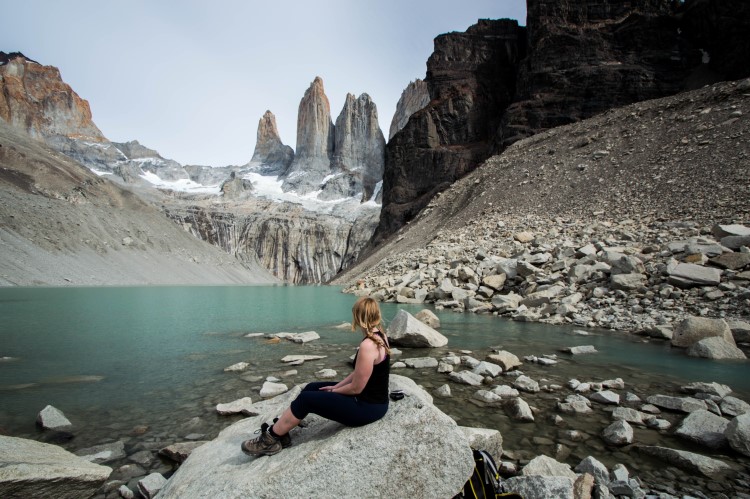
Know-before-you-go facts about the Torres del Paine W Trek
- How long is the W trek in Torres del Paine? It’s an 80-kilometer (50-mile) hike that most do over four or five days.
- When can you hike the W trek? The park is open year-round, however, for self-guided trekking, you can only hike between October and the end of April. If you want to hike during the winter months (May through September), you’ll need to arrange a guide. Our local partner, Chile Nativo, lead winter tours of the W trek and offer a 5% discount to Worldly Adventurer readers (use “Worldly Adventurer” in the referral discount box when you book!).
- Do you need to reserve camping spots/dormitory accommodation in advance of hiking the W? Yes, you must have reservations at each of the campgrounds or dormitories in which you plan to stay during the hike. You might be required to show your reservations when you enter the park, too.
- What about food? You can reserve full board at the campgrounds, which will include an evening meal, breakfast the day after your stay, and a packed lunch for you to take to the next campground. This typically needs to be booked in advance, although if you get to the campground early enough, you can sometimes do it on the day. Some campgrounds offer buffet dining (Grey and Paine Grande), so can be a good place to stock up on some snacks for the following day.
- Are reservations open for the campgrounds and dormitories along the W trek for the 2023/2024 season? Yes, reservations opened in July.
- How fit do you need to be to hike the W trek? While previous backpacking experience is not necessary, you do need a reasonable level of fitness to be able to climb up into the Frances Valley and up to the towers themselves. It’s helpful to have done a couple of practice walks, with a backpack weighing around 10 kilograms (22 pounds), in preparation for the trail.
- Do you need to book your park entrance ticket in advance? You must book online as they are no longer accept payments at the park entrance. Book your ticket online here . You need to download the QR code in Puerto Natales while you have internet (there is no signal in the park) and may need to show a copy of your passport to prove you do not live in Chile.
- How much does it cost to enter Torres del Paine National Park? The cost of entering the park varies according to how long you plan on staying. For up to three days in the national park, it costs $31,200 CLP ($34 USD) for adults and $16,000 CLP ($17 USD) for children aged 12 to 17. For over three days in the park, the cost is $44,500 CLP ($48 USD) for both adults and children.
- What is the altitude of Torres del Paine National Park? The highest point in the park is the John Gardner Pass at an altitude of 1,200 meters (3,900 feet) above sea level. However, only those trekking the O Circuit are required to reach this height; all of the W trek is at altitudes below this.
Firstly though, what actually is the W? The W is a four- or five-day hike in Chilean Patagonia’s Torres del Paine National Park. It’s named the W because it follows a W-shaped route and can be hiked either from west to east (my preferred route) or from east to west.
Along the way, you stay overnight in official campgrounds, which also have indoor dormitories, covered cooking areas for campers, and restaurants where you can eat pre-ordered meals.
Is the W worth it, though? It’s one of Patagonia’s easiest multi-day hikes and, while hiking for five days might not be at the top of everyone’s to-do list, the scenery in Torres del Paine National Park makes up for the hard work! Every day has spellbinding views: whether of Grey Glacier on day one, the French Valley on day two or three, or the eponymous towers on the final day of the hike.
You’ll finish tired but truly fulfilled by the experience – and proud of yourself for having completed it! Bear in mind that the W trek is a moderately challenging hike. If you’re able to walk up to 18 kilometers (11 miles) per day (and feel like you would be able to do that over multiple days), then you will find this hike perfectly doable.
That said, the hike up to the towers on the final day of the W (or the first, if you’re hiking east to west), is classed as a difficult hike due to the elevation gain of 900 meters (2,956 ft).
Bear in mind that you will be trekking with a backpack; the contents will depend on whether you’re carrying your tent and meals or planning on renting camping equipment and paying for meals at the campgrounds en route. Before hiking up the French Valley and up to the towers, you can also leave your backpacks at the rangers’ station or campsite, which means you won’t have to carry them up much elevation.
I highly recommend that, before heading to Patagonia, you go on a couple of hikes of around 18 kilometers (11 miles) with a backpack that will mimic the weight you’ll be carrying in the park – this will also help you to break in any hiking boots you might have bought for the trek and find out if they give you blisters!
How much does it cost to hike the W?
I’ve hiked the W twice: once as part of a tour and another time independently as part of hiking the O Circuit (which is a nine- or ten-day hike circumnavigating the national park and whose final five days are the W).
On my second visit to the national park, it became clear that I really didn’t need to hike the trails using a tour company. Not only is it expensive (it costs from $1,500 USD per person), but it’s unnecessary; all of the trails are clearly marked and busy with people and it’s easy enough to make camping reservations yourself.
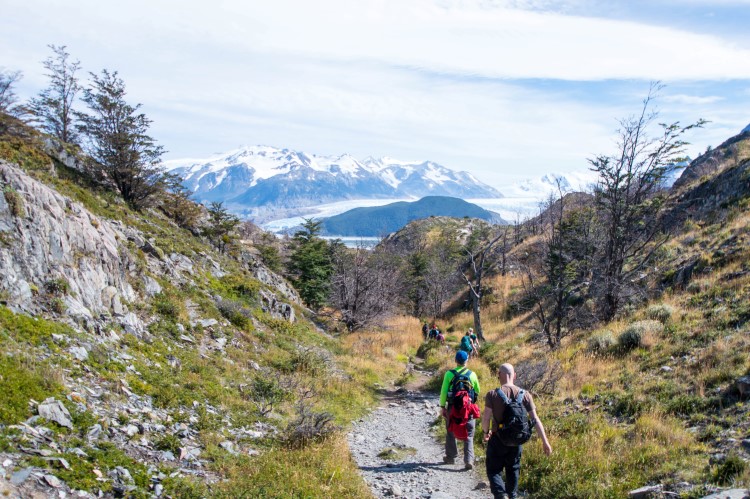
Hiking the W independently costs $157,000 CLP per person ($173 USD – check here for the most up-to-date conversion), plus the cost of food .
Camping and Transport cost breakdown*
- Return bus from Puerto Natales to Torres del Paine National Park: $13.323 CLP ($15 USD)
- Adult entrance fee into the park: $44,000 CLP ($49 USD)
- One-way ferry from Pudeto de Paine Grande Ranger Station: $30,000 CLP ($40 USD)
- Grey Campsite: $11,000 CLP (per person) ($12 USD)
- Paine Grande Campsite: $11,000 CLP (per person) ($12 USD)
- Francés Campsite: $31,000 CLP (per person) ($35 USD)**
- El Chileno Campsite: $31,000 CLP (per person) ($35 USD)***
* these figures are all updated for the 2023/2024 season.
**based on two people sharing a tent
***Torres Ranger Station (the free camping closest to the towers) is closed for the foreseeable future.
Food breakdown
- When we hiked the Full Circuit, we paid $68,620 CLP ($95 USD) between four people for all of our food. That’s $17,155 CLP ($20,5 USD) per person. No kidding.
- So for your food budget, expect to spend no more than $10,000 CLP ($12 USD) (read this full outline of exactly what we took with us in terms of food when we walked the Circuit)
If you want to save time, the website Torres Hike can show you the availability of accommodation and allows you to book it directly through them , rather than having to go via the Vertice Patagonia and Las Torres (previously known as Fantastico Sur) websites. All you need to do is plug in your dates and it’ll show you which campgrounds and refugios are available – saving you LOTS of time. You can then book directly with them, rather than having to try and book through the other websites!
How do you make campsite and refugio bookings for Torres del Paine?
The system for making refugio and camping reservations has changed dramatically over the past couple of years and a lot of the information you find online about the subject is out of date.
I also put together this epic, 5,000-word post about securing camping reservations in Torres del Paine that literally walks you through the process. However, I highly recommend just using Torres Hike . Yes, they charge you a small fee, but it honestly saves you so much time.
The reason it’s so challenging to make reservations independently is because there are two different companies who offer campgrounds and dorms in the park and you will have to reserve some campgrounds with one on their website and some with another on their website; trust me, it’s a painful process. Save yourself the stress and hassle of doing this by using Torres Hike instead.
Reservations are now open for the 2023/2024 season. If you’re struggling to find spots for the coming season, you should also read my article about alternative ways to hike the W if you can’t get camping reservations .
You can also check out this ultimate guide to Torres del Paine National Park , covering everything from the best time to visit, to where to stay and what to do beyond the W trek.
If you’re completely baffled by the process and just want someone else to deal with it, you can book with my partner in the region, Chile Nativo , who organise, guided, self-guided and fast-track (three-day) W treks. They give a 5% discount to Worldly Adventurer readers (use “Worldly Adventurer” in the referral discount box when you book!).
What equipment do you need to hike the W without a tour?
To pay as little as possible trekking Torres del Paine solo, it does require that you have the following pieces of equipment:
- A tent: I strongly recommend the lightweight Big Agnes Copper Spur HV UL2 tent ( REI | Backcountry | Amazon ), the North Face Stormbreak 2 (buy it on REI | Amazon ), or, for more room, the North Face Stormbreak 3 (buy it on ( REI ).
- A sleeping bag: I recommend the Nemo Disco 15 for women (buy it on REI ) and for men (buy it on REI ).
- A sleeping pad: Get a cheap foam pad ( REI | Backcountry | Amazon ) or a more comfortable Therm-a-rest Prolite (buy it on REI | Backcountry | Amazon ).
- A headlamp : Useful for midnight toilet visits and the hike up to the towers (buy one on REI | Black Diamond | Backcountry ).
- A cooking stove and gas: The affordable MSR PocketRocket 2 (buy it on REI | Backcountry | Amazon ) is great value for those on more of a budget, and is super lightweight.
- Cooking pots: I recommend the MSR pots set (buy them on Backcountry | Amazon ) as they’re good quality and food will stick less, which will make them easier to clean.
- Plates, a mug, and cutlery : A collapsible bowl is a great space saver (check out Sea to Summit on REI | Backcountry | Amazon ); I recommend a reasonably cheap, plastic mug (buy it on REI | Backcountry | Amazon ) and for cutlery, a multipurpose spork is a good choice (check them out on REI | Backcountry | Amazon ).
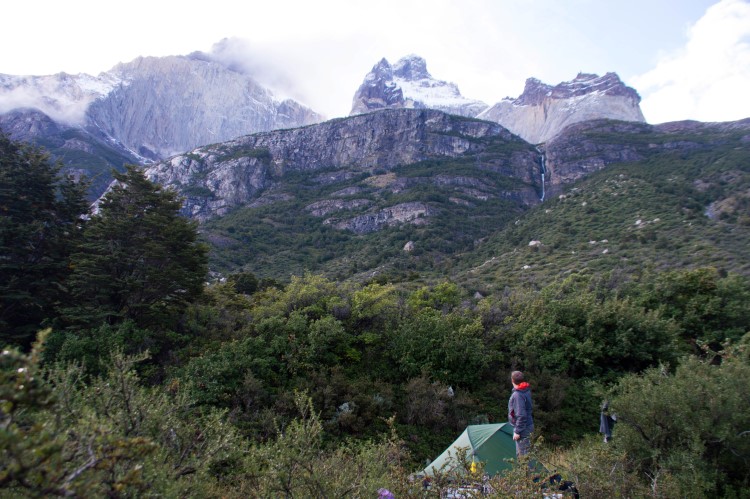
I’ve detailed exactly the items that I packed for the O Circuit in Torres del Paine (and which are still relevant to the W trek) and also what I pack in my rucksack on a trip to Patagonia in this packing checklist . Both have a free packing checklist download, too.
I recommend you take a look if you’re thinking of investing in camping equipment before you head over to Patagonia (something I would strongly advise if you plan on doing any other hikes or wild camping or if you’re looking at exploring the Carretera Austral ).
Planning Your Trip to Patagonia?
Save time, stress & money with a customized travel itinerary planned for you by a Patagonia expert
What previous clients have said:
Steph’s help laying out an itinerary for Chile was huge toward us having a great trip. She listened to our interests and compiled a framework that we could follow to make our plans. She included many practical tips as well as numerous options. She truly saved us many, many hours of research.
If you’re already traveling around Patagonia, what can you do to get your hands on this camping equipment for Torres del Paine?
You have three options:
Buy equipment in Punta Arenas or Puerto Natales
There is a wide range of hiking and camping equipment shops in these two towns. Punta Arenas is a tax-free zone so prices here are cheaper than you will find in Puerto Natales, although Calle Manuel Bulnes in the latter has some gear shops.
I actually found a pair of waterproof trousers for only $15,000 CLP ($18 USD) in one of the shops there, which is a lot cheaper than I thought they would be.
If you’re looking to buy equipment for camping and hiking in Torres del Paine National Park, you should be able to find everything that you need in these shops, but you will pay an elevated price for good-quality gear.
Estimated additional cost: $360,000 CLP+ ($400 USD+) per person
Rent equipment from Puerto Natales
Your second option is to rent all of your camping and cooking equipment from Rental Natales (you can book online) in Puerto Natales. However, they are very expensive.
There are other places in Puerto Natales to rent equipment too, so I suggest having a wander around and looking out for signs for rental equipment. Yaghan House (O’Higgins 584) and Lili Patagonico’s (Arturo Prat 479) have much cheaper, good-quality rental gear.
Remember to check the equipment thoroughly before committing as it does get a lot of wear and tear on the trail and you want something without holes and with zips that close to keep you warm and dry!
Estimated additional cost: $147,000 CLP ($162 USD) per person (based on two sharing) for five days’ rental
Rent equipment at each campsite in Torres del Paine National Park
Your final option is by far the most expensive. Each of the main camping grounds in Torres del Paine rents out tents, sleeping bags, and sleeping mats – but at a very high cost.
For example, in Grey campground, you can hire a two-man tent for $29,000 CLP ($32 USD), a sleeping bag for $21,000 CLP ($23 USD), and a sleeping mat for $8,000 CLP ($9 USD), bringing up your overnight cost (including the cost of the camping site) to $53,000 CLP ($58 USD) per person per night (based on two sharing).
Bear in mind, this doesn’t include the cost of hiring cooking equipment (which you can’t do at the campsites), so you will also need to pay for meals at each – an additional cost of between $55,000 CLP ($61 USD) and $80,000 CLP ($88 USD).
Estimated additional cost: $232,000 CLP ($256 USD) per person for equipment and $256,000 CLP ($282 USD) per person for full board for five days hiking the W circuit (based on two sharing).
How do you get from Torres del Paine National Park to Puerto Natales ?
It’s easy enough to get to Torres del Paine National Park with public transport.
Four companies travel from Puerto Natales to Torres del Paine each morning and all cost around $22,000 CLP ($25 USD) for a return ticket (which can be used on any of the company’s buses back from the park).
You can buy tickets online for Bus Sur (who have lots of departures); other companies do run this route, however you need to buy tickets from their offices, which are inside the Terminal Rodoviario (Av. España 1455) in Puerto Natales.
If there are a few of you, consider negotiating a group price like we did, which got us a few thousand pesos off per ticket.
It’s advisable to book your bus ticket at least a week in advance when visiting the park in high season (December through February).
Timetables for buses from Puerto Natales to Torres del Paine (east to south: Laguna Amarga, Pudeto and Administración)*
Conventionally, buses have departed from Puerto Natales and entered the park via the northeastern entrance at Laguna Amarga (for the minibus to the eastern starting point for the W), before continuing to Pudeto (for the catamaran to the western starting point for the W) and finally to Administración (not a destination along the W trek).
These now continue along to Hotel Lago Grey and stop at Camping Pehoé en route, too.
These bus timetables are below and can be booked online in advance via Bus Sur’s website:
Pre-pandemic, the following companies also offered services. However, their websites are no longer active and I can’t find them on any local booking sites.
That doesn’t mean they don’t have buses, however; if you can’t get a reservation with Bus Sur then it’s still worth going to the bus terminal in Puerto Natales as some will likely still be in operation and with similar departure times:
- Transport Maria José (tel. 61/2410 951)
- Buses Gómez (tel. 61/2415700)
- JB Buses Patagonia (tel. 61/2410 242)
- Buses Juan Ojeda (tel. 9/8943 7808)
*Service available November through April
Timetables for buses from Torres del Paine to Puerto Natales (Administración, Pudeto, Laguna Amarga)*
The following timetables are when buses can return you to Puerto Natales from the four different stops in the park. They can also be booked online and in advance via Bus Sur’s website.
Note that you have to return with the same bus company you entered the park with – you won’t be allowed on a different company’s buses. You don’t have to book a particular bus time; you will be able to turn up and get onto whichever bus you choose.
As above, there should be other companies offering buses to and from Puerto Natales into the park; visit the Terminal Rodovario in Puerto Natales to find out if you can’t make a reservation with Bus Sur.
Where do you buy your Torres del Paine entrance ticket?
The cost of entering the park varies according to how long you plan on staying. For up to three days in the park, it costs $31,200 CLP ($34 USD) for adults and $16,000 CLP ($17 USD) for children aged 12 to 17. For over three days in the park, the cost is $44,500 CLP ($48 USD) for both adults and children.
It’s no longer possible to buy your ticket at the Laguna Amarga entrance to the national park (the first stop on the bus if entering via that entrance) or at the Administración entrance (if entering via that entrance).
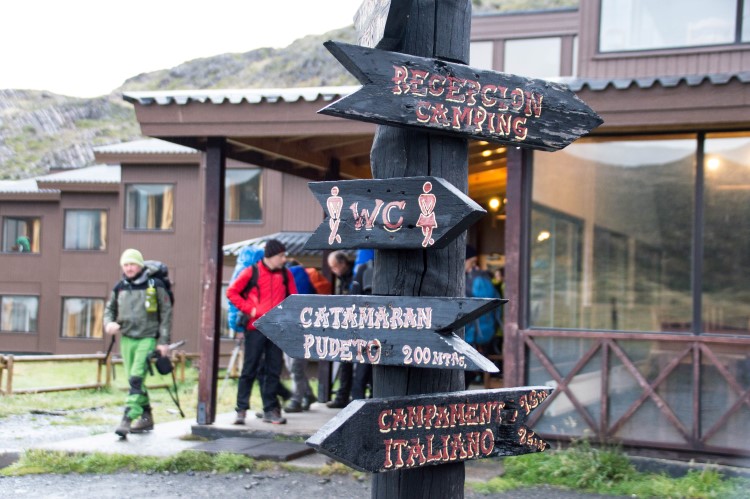
You must buy it in advance online here . You must download the QR code to your phone before you enter the park (as you won’t have signal when you get there!) and bring your passport to show that you’re not a Chilean resident.
Torres del Paine W trek itineraries
Hiking in Torres del Paine National Park is significantly cheaper if you go self-guided.
There is also absolutely no chance that you’ll get lost. Believe me, the W trek is now so busy that (unfortunately) you see people all the time.
If you want to trek Torres del Paine solo, you can either hike from west to east (my preference, as I’ll go into below) or east to west.
When you enter the park and pay your fee, you will be provided with a Torres del Paine W trek map to be used when you’re walking.
Unfortunately, the map that you get from CONAF doesn’t include distances. I would strongly recommend you download Maps.me, a free app that has all the trails marked and you can use it to work out distances if required.
Itinerary one: W trek in five days with sunrise at Mirador Las Torres (west to east route)
Why hike this route:
- This trail builds up to the most exciting part of the trek, the Mirador Las Torres viewpoint on the final day.
- It also starts with a short first day, giving you time to get into your stride.
Want to know how to book the campsites mentioned in this itinerary? Head over to this comprehensive article about booking Torres del Paine camping or hostel accommodation .
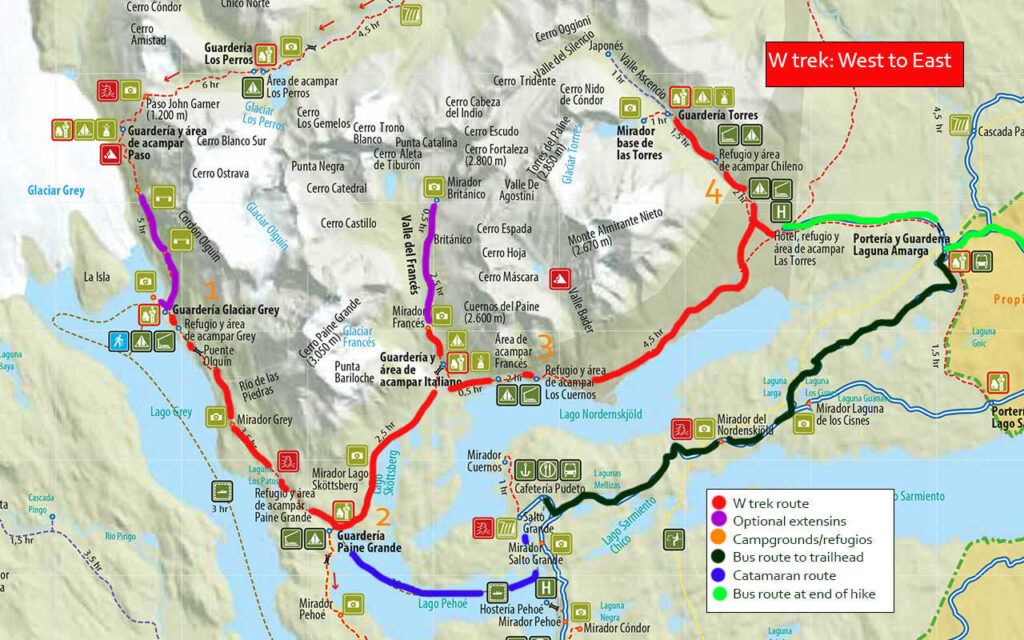
Day One: Puerto Natales to Grey
- Distance: 11 kilometers (6.8 miles)
- Duration: 3-4 hours hiking
6:50am Take a bus from Puerto Natales to the Pudeto (the catamaran ferry stop). You will stop at the park entrance when you first get into Torres del Paine to show your entrance ticket.
You must have bought this in advance online here and downloaded the QR code to your phone (there isn’t internet cell service at Laguna Amarga!).
9:50am Arrive at Pudeto. Queue up for the catamaran ferry across the lake.
10:30am Take the ferry across to Paine Grande*. This service is operated by Hielos Patagonicos ($25,000 ($30 USD) single, cash only). Tickets cannot be reserved in advance; you buy them at the ferry port.
Ferry schedules do sometimes change; you can check up-to-date ones here .
11:40am Arrive at Paine Grande and trek to Grey. The trail starts to go uphill but soon levels off and has great views of Lago Grey to keep your spirits up!
16:00pm The hike from Paine Grande takes between three and four hours so expect to arrive late afternoon at Grey to pitch your tent, meet some other hikers, and cook dinner.
Day Two: Grey to Paine Grande
- Distance: 18 kilometers (11 miles)
- Duration: 6-7 hours hiking
8:00am Wake up and have breakfast.
9:00am Leave your stuff at the campsite and return a few hours later to pack everything up. From the campsite, an additional one kilometre north through the forest brings you go two viewpoints lying over a kilometre from the glacier’s snout. From here, look out for enormous chunks of ice in the water.
Continue a further 2.5 kilometres (around a one-hour hike) along the path along the edge of the glacier to reach a series of two rope bridges hanging over ravines.
From here you get the best views of the glacier and, if you’re lucky and it’s a clear day, the Southern Patagonian Ice Field beyond.
Return to Grey along the same path and back to Paine Grande.
16:00pm You’ll arrive at Paine Grande at around 4pm, which is where you’ll spend the night. The facilities are great here, with a covered dining area for campers.
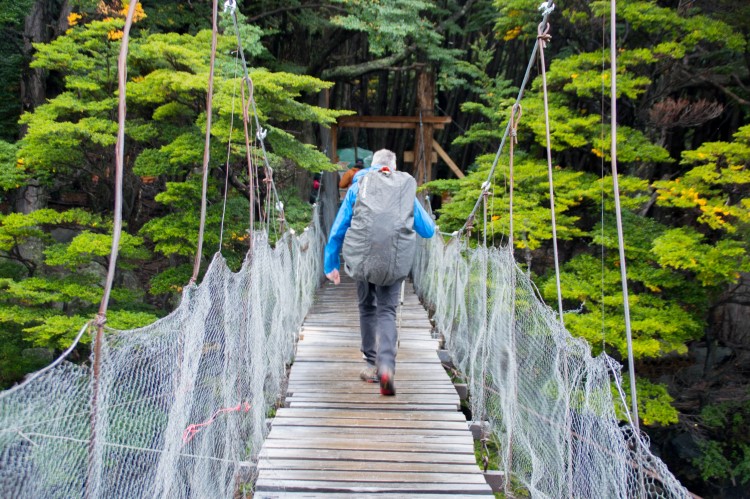
Day Three: Paine Grande to Francés
- Distance: 11.5 kilometers (6.8 miles) plus 9 kilometers (5.6 miles) for the extension to Mirador Británico)
- Duration: 4 hours hiking (7.5 hours with extension to Mirador Británico)
8:00am Get up, have breakfast and pack up your tent.
9:00am Today begins with a flattish trek around Lake Nordernskjold to Guardería Italiano. You can leave your bags here with the ranger before hiking up into the Francés Valley.
Note that there’s a new trail that begins about one km (15 mins) after you leave Paine Grande. It’s a little longer – 9 km (5.6 miles) rather than 7 km (4.3 miles) – and so takes around 30 minutes longer, but it has fewer hikers on it and is really pretty.
11:00am The hike up the Francés Valley may be long or painfully short – all depending on the weather. Both times I’ve walked Torres del Paine W hike I’ve experienced dreadful weather in the Francés Valley.
This part of the hike marks the central section of the W and it’s all uphill. After an hour’s steep gradient up a rocky, slippery trail to Mirador Francés, look for Glaciar Francés as it clings to the mountainside in the west.
If you’re feeling energetic, and the weather’s playing fair, you can continue climbing to Mirador Británico (an additional 3.5 km (2 miles) each way; around three hours’ return), where you’ll view a ring of toothy granite peaks, including the park’s second most famous landmark, the three-horned Cuernos del Paine.
It’s one of the park’s most stunning viewpoints—when the sky is clear. You may even see an endangered Southern Andean huemul (a type of deer) around here.
Luckily, the hike back is downhill to return to Campamento Italiano, where you pick up your rucksack and hike the 30 minutes to reach Francés.
13:00pm-16:00pm Arrive at Francés*, pitch up and enjoy the views across the lake.
*If there is no availability at Francés when you go to make your refugio or campsite reservations , you can instead book to stay at Los Cuernos, which is a further 3.5 kilometers (one hour) from Francés.
Day Four: Francés to El Chileno*
- Distance: 17 kilometers (10.5 miles)
- Duration: 4-5 hours hiking
9:00am Leave the campsite and begin the trek to El Chileno, situated about two hours from the bottom of the towers.
This trek meanders alongside the lake, gaining and losing altitude as it goes, until you reach the start of the valley where it becomes all uphill. The views are incredible but if it’s sunny, it will be hot!
16:00pm Arrive at El Chileno* and pitch your tent. Get everything organised for the morning as you’ll be leaving early. Check with the staff what time sunrise will be the next morning.
*For the 2023-2024 season, and for the foreseeable future, Torres Ranger Station is not open to the public. It’s no longer as easy to get to the towers for dawn as the distance is now around four kilometres, rather than one kilometre; however, it is still possible to do it.
If you can’t get a pitch at Chileno, it is possible to hike from Torres Central/Norte ($25 USD camping pitch per person). Although you’re not officially supposed to hike from here up to the towers, you can: leave four hours ahead of sunrise. It’s an additional one-hour 45 minutes if starting from Torres Central/Norte to reach the towers.
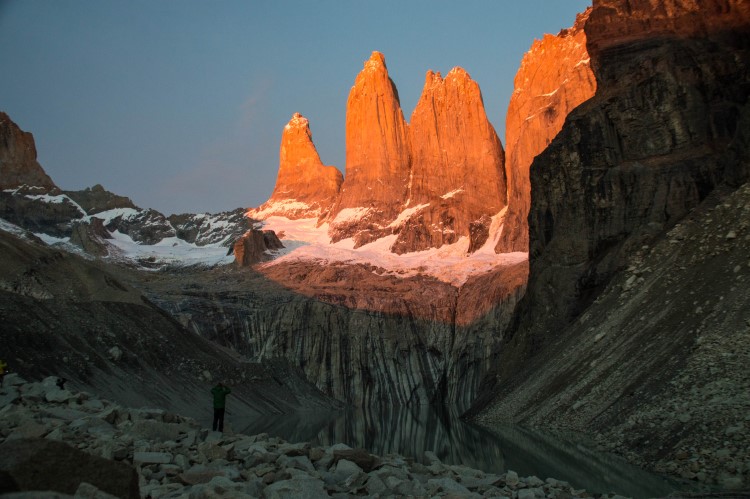
Day Five: El Chileno* to Laguna Amarga and Puerto Natales
- Distance: 13 kilometers (8 miles) plus 8 kilometers (5 miles) for the hike from the Centro de Bienvenida to Laguna Amarga)
- Duration: 6 hours hiking (add an extra 1.5-2 hours for the hike to Laguna Amarga)
4:30am Wake up and take a small bag (including warm clothes and a snack) to see the torres at dawn. Don’t forget your torch as the route is over rocks and can be treacherous.
4:45am Start hiking up to the torres . For us at the very start of March, dawn was at about 7:15am.
8:00am Leave the torres and return to the campsite. Pack up, have breakfast start the long walk down.
12.30pm When you get to Las Torres Hotel car park, there is a shop selling ice creams. To get the shuttle minibus to take you to Laguna Amarga, you need to hike one kilometre down the road towards Torres Central/Norte to reach the Centro de Bienvenida /Welcome Centre.
Shuttles ($4,000 CLP ($6 USD) – you must pay in cash at the shuttle) leave throughout the day to take you to Laguna Amarga. Departures leave the Welcome Centre at 8am, 2pm, 4pm and 7pm daily , and take about 30 mins.
If you can face the walk, it’s about another one and a half hours to the Laguna Amarga Ranger Station where buses are waiting to pick you up.
Hiking there, you can get good views of the towers as they rise out of the Cordillera Paine if the weather is clear.
14:30pm Take the bus from Laguna Amarga back to Puerto Natales.
17:00pm Arrive in Puerto Natales bus station and go and enjoy a pint at Cerveza Baguales on the Plaza de Armas to celebrate!
If time allows, consider spending a night in Puerto Natales to explore all the town has to offer before your onward journey. Our guide to the best hotels in Puerto Natales caters for all budgets, styles and preferences.
*If you can’t get a pitch at Chileno, it is possible to hike from Torres Central/Norte ($21 USD camping pitch per person). Although you’re not officially supposed to hike from here up to the towers, you can: leave four hours ahead of sunrise. It’s an additional one-hour 45 minutes if starting from Torres Central/Norte to reach the towers.
Make sure you bring a headtorch for climbing in the dark (it will get lighter as you reach the more difficult stretch of hiking just below the towers), plus warm clothing (even including a sleeping bag) to use at the top and keep you cozy as you enjoy the sunrise.
Itinerary two: Torres del Paine W trek in four days with sunrise at Mirador Las Torres (west to east route)
Why hike this route?
- It’s a good option if you don’t have much time
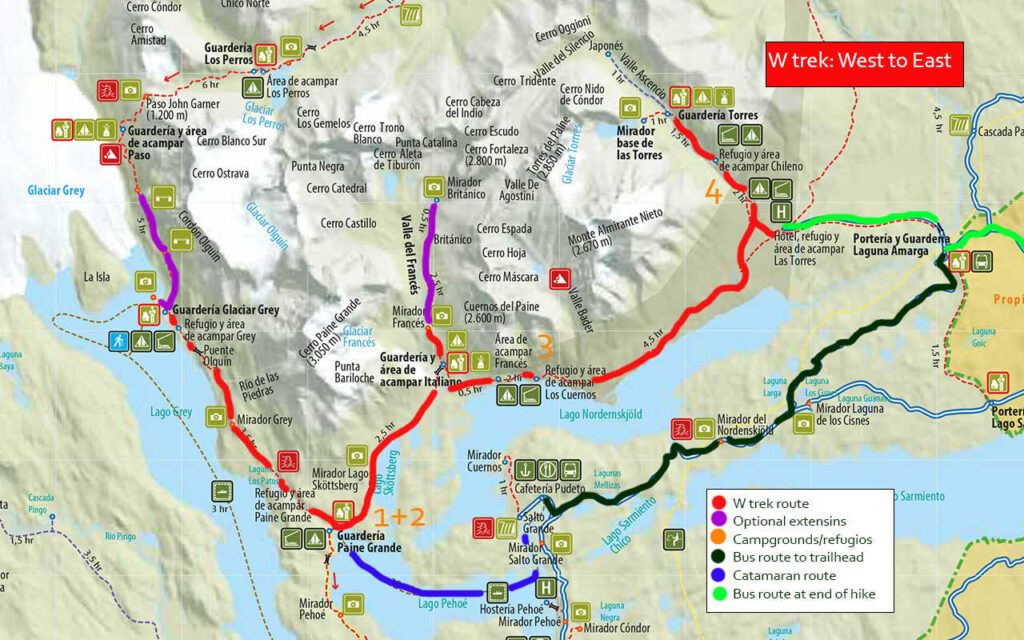
Day Zero – Puerto Natales to Paine Grande
- Distance: nil
- Duration: nil
2.30pm Catch the Bus Sur bus from Puerto Natales.
You will stop at the park entrance at Laguna Amarga when you first get into Torres del Paine to pay your entrance fee.
You must have paid for your ticket in advance online here AND downloaded the QR code; you will not find cell service or WIFI at the entrance.
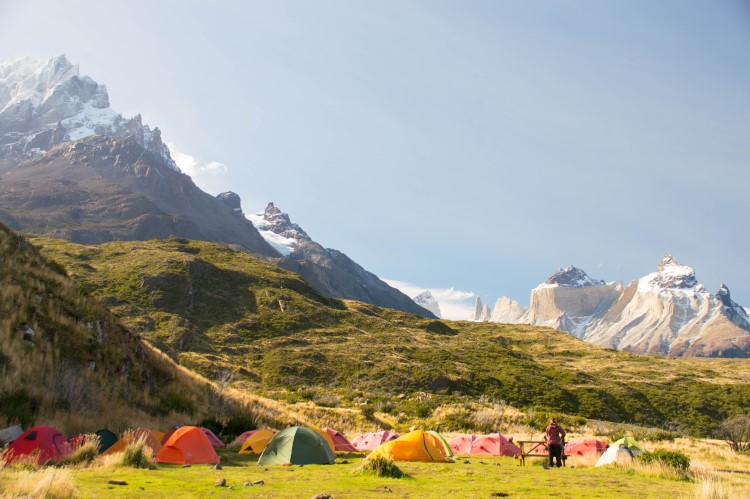
5.15pm Arrive at Pudeto take the ferry across to Paine Grande at 6pm. This service is operated by Hielos Patagonicos ($25,000 ($30 USD) single, cash only).
Tickets cannot be reserved in advance; you buy them at the ferry port. Ferry schedules and prices do sometimes change; you can check up-to-date ones here and the 9am ferry only runs November through the end of March.
6.30pm Pitch up at Paine Grande, have some dinner and then have an early night in preparation for a long day’s hiking tomorrow.
Day One – Paine Grande to Paine Grande
- Distance: 22 kilometers (14 miles) plus 7 kilometers (4.3 miles) if you hike to the last viewpoint)
- Duration: 7-9 hours hiking
7:00am Get up, have breakfast, and pack up your tent.
08:00am Take the trail towards Grey; it starts uphill but soon levels off and has great views of Lago Grey to keep your spirits up!
If you’re fit, you can hike an additional one kilometre north through the forest brings you go two viewpoints lying over a kilometre from the glacier’s snout. From here, look out for enormous chunks of ice in the water.
Turn back and return the way you came, past Grey and then back to Paine Grande.
17:00pm Arrive late afternoon back at Paine Grande to meet some other hikers and cook dinner.
Day Two – Paine Grande to Frances
9:00am Hike to the ranger station, Guardaria Italiano (around two hours), where you leave your rucksack with the ranger. You’ll pick it up on your way back down from the Francés Valley.
The hike up the Francés Valley may be long or painfully short – all depending on the weather. Both times I’ve walked Torres del Paine W hike I’ve experienced dreadful weather in the Francés Valley.
If you’re feeling energetic, and the weather’s playing fair, you can continue climbing to Mirador Británico (an additional 3.5 km each way; around three hours’ return), where you’ll view a ring of toothy granite peaks, including the park’s second most famous landmark, the three-horned Cuernos del Paine.
Luckily, the hike back is downhill to return to Italiano, where you pick up your rucksack and hike the 30 minutes to reach Francés.
*If there is no availability at Francés when you go to make your refugio or campsite reservations , you can instead book to stay at Los Cuernos, which is a further 3.5 kilometres (one hour) from Francés.
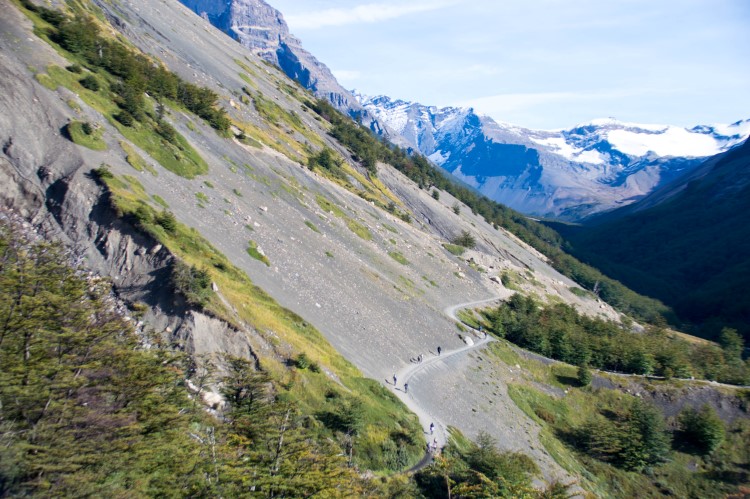
Day Three: Francés to El Chileno*
9:00am Leave the campsite and begin the trek to El Chileno, situated about two hours from the bottom of the towers. This trek meanders alongside the lake, gaining and losing altitude as it goes, until you reach the start of the valley where it becomes all uphill.
The views are incredible but if it’s sunny, it will be hot!
*For the 2023-2024 season and for the foreseeable future, Campamento Torres, the campground just below the towers, is not open to the public. It’s no longer as easy to get to the towers for dawn as the distance is now around four kilometres, rather than one kilometre; however, it is still possible to do it.
Day Four: El Chileno* to Laguna Amarga and Puerto Natales
Shuttles ($4,000 CLP ($6 USD) – you must pay with cash in the shuttle) leave throughout the day to take you to Laguna Amarga. Departures are at 8am, 2pm, 4pm, 7pm and takes about 30 minutes.
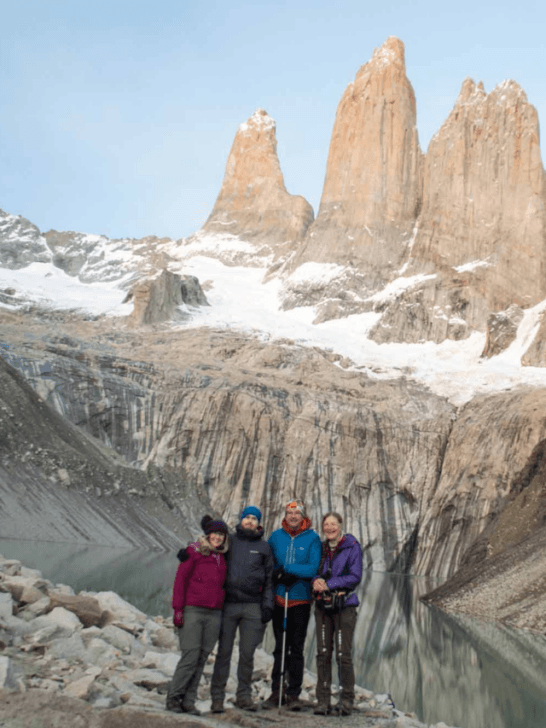
*If you can’t get a pitch at El Chileno, it is possible to hike from Torres Central/Norte ($25 USD camping pitch per person). Although you’re not officially supposed to hike from here up to the towers, you can: leave four hours ahead of sunrise.
Make sure you bring a headtorch for climbing in the dark (it will get lighter as you reach the more difficult stretch of hiking just below the towers), plus warm clothing (even including a sleeping bag) to use at the top and keep you cosy as you enjoy the sunrise.
Itinerary three: Torres del Paine W hike in five days (east to west route)
Why hike this route:
- Not only do you get to complete the W, it gives you time for a bonus extra hike to the Los Cuernos or Salto Grande viewpoints.
Want to know how to book the campsites mentioned in this itinerary? Head over to this comprehensive article about booking Torres del Paine camping or hostel accommodation .
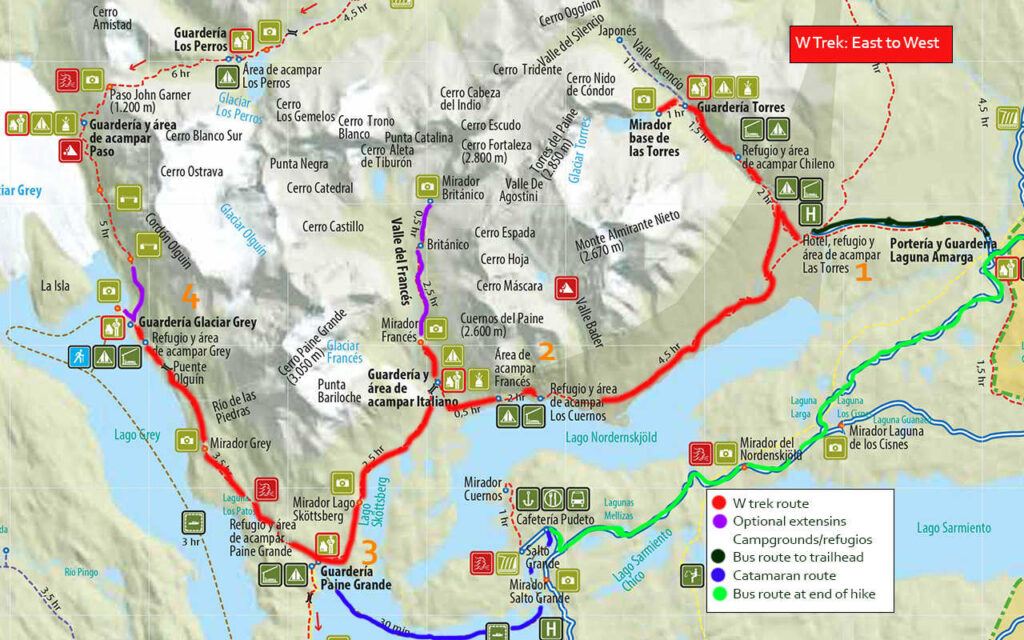
Day One: Puerto Natales to Mirador Las Torres & Torres Central/Norte
- Distance: 18.4 kilometers (11.4 miles)
- Duration: 6-7 hours hiking
6:45am Take a bus from Puerto Natales to Laguna Amarga. You can book tickets online with Bus Sur or go to the bus station in Puerto Natales the day before you start hiking and book with them or one of the other companies there.
8:45am Arrive at Laguna Amarga. Show your entrance ticket at the ranger’s station.
9:00am To get to the start of the W, you need to take a shuttle bus ($4,000 CLP ($6 USD) – you must pay in cash at the shuttle) to the Centro de Bienvenida (Welcome Centre).
Departures theoretically leave from Laguna Amarga at 9am, 3pm, 5pm and 8pm daily , and take about 30 mins. However, Las Torres (who run the shuttle service) have assured me that the shuttle bus awaits the arrival of the bus from Puerto Natales and will take all passengers that are waiting to board – sending for a second shuttle if there are more passengers than seats.
9.30am You’ll be staying overnight at the Torres Central/Norte campground, so check in and leave your big bags and take warm layers, food, and plenty of water for the hike up to the towers.
Start hiking up to the torres . It’s all uphill and it can be quite steep at points, but it’s worth the effort! All in all, you gain around 800m (2,620 feet).
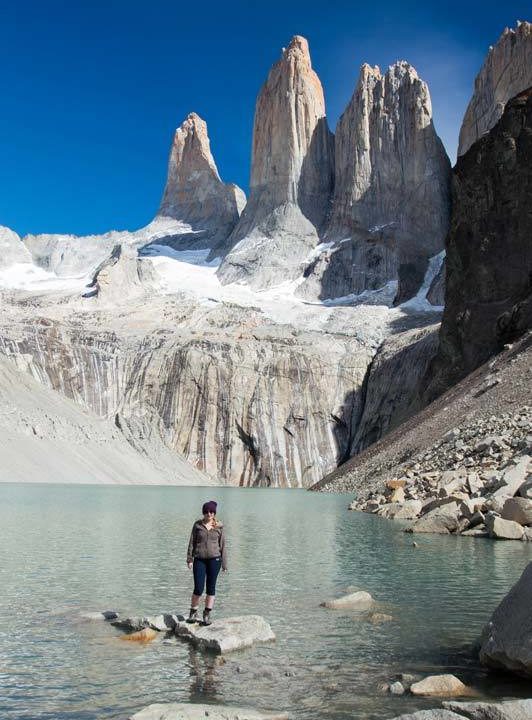
Take your time, drink plenty of water, and relax when you get to the top.
13:30pm Arrive at Mirador Las Torres and enjoy the views.
15.00pm Start hiking back to the campsite; you’re trekking back the way you came.
17.00pm Pitch your tent, have dinner, and relax!
Day Two: Torres Central/Norte to Francés
- Distance: 14.5 kilometers (9 miles)
- Duration: 5.5 hours hiking
9:00am Get up, have breakfast and pack up your tent.
10:00am You leave Torres Central heading west and reach Lago Nordernskjold. The trail meanders alongside the lake, gaining and losing altitude as it goes. The views are incredible but if it’s sunny, it will be hot!
15:30pm Reach Francés campground, where you’ll stay tonight. Pitch up and enjoy views across the lake. Bear in mind that check-in at Francés doesn’t start until 2.30pm and hot showers aren’t available until 5pm, so take your time on the hike.
Day Three: Francés to Mirador Británico & Paine Grande
- Distance: 14 kilometers (8.6 miles) from Francés to Mirador Británico and 7 kilometers (4.3 miles) from Guardería Italiano to Paine Grande
- Duration: 5.5 hours hiking from Francés to Mirador Británico and 2.5 hours from Guardería Italiano to Paine Grande
9:00am If the weather is good, today is going to be a long day as you climb up into the Francés Valley. Both times I’ve walked Torres del Paine W hike I’ve experienced dreadful weather in the Francés Valley.
From Francés, head west along the path beside the lake to reach Guardería Italiano, a rangers’ station and former (now defunct) campground. Here, you can drop your big rucksacks; just take warm clothing and food for the hike up to the Mirador Británico* (British Viewpoint). This part of the hike marks the central section of the W and it’s all uphill. After an hour’s steep gradient up a rocky, slippery trail to Mirador Francés, look for Glaciar Francés as it clings to the mountainside in the west.
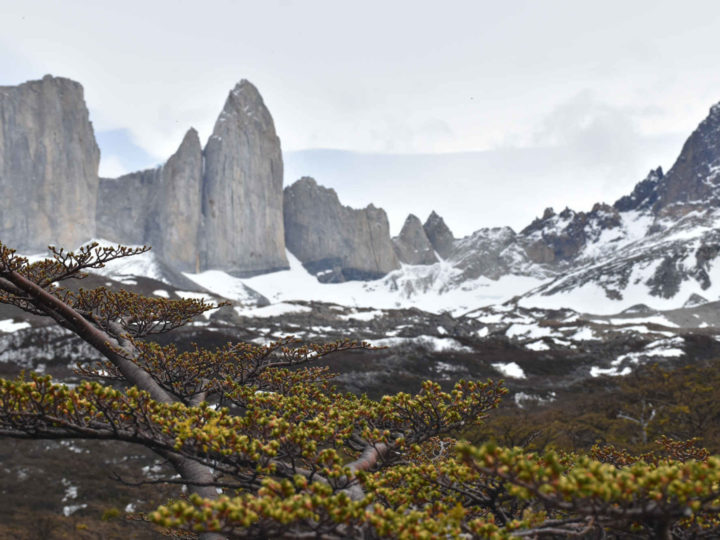
Luckily, the hike back is downhill to return to Guardería Italiano. Pick up your bags and take the new trail that begins just after the rangers’ station; take the lefthand fork that follows closer along the lake. It’s a little longer – 9 kilometers (5.6 miles) rather than 7 kilometers (4.3 miles) – and so takes around 30 minutes longer, but it has fewer hikers on it and is really pretty.
18:30pm Arrive at Paine Grande, pitch your tent and enjoy a hot shower!
*You’re only allowed to start hiking up to the viewpoint until midday, so don’t delay getting to the rangers’ station – although this rule isn’t always enforced!
Day Four: Paine Grande to Grey & Puerto Natales
- Distance: 11 kilometers (6.8 miles) plus six kilometers (3.7 miles) to reach rope bridges
- Duration: 4 hours hiking plus 1.5 hours to reach rope bridges
10:00am Take the trail heading north to Grey. It starts by going uphill but soon levels off and has great views of Lago Grey to keep your spirits up! It takes between three and four hours.
14:00pm Arrive at Grey, where you can leave your big bags. From the campsite, an additional one kilometre north through the forest brings you to two viewpoints lying over a kilometre from the glacier’s snout. From here, look out for enormous chunks of ice in the water.
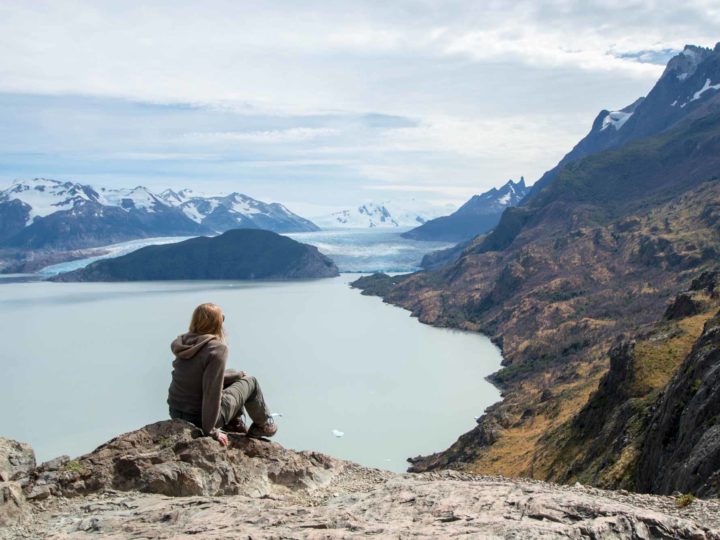
From here you get the best views of the glacier and, if you’re lucky and it’s a clear day, the Southern Patagonian Ice Field beyond. Return back to Grey.
16:00pm Arrive at Grey, pitch up and relax – you’ve almost finished the hike!
Day Five: Grey to Paine Grande and Puerto Natales
- Distance: 11 kilometers (6.8 miles) plus 2.3 kilometers (1.4 miles) to the Cuernos Viewpoint
- Duration: 4 hours hiking
7:00am Get up, pack up your tent, and have breakfast. Return to Paine Grande along the same path.
10:30am Join the queue for the ferry to Pudeto.
11:00am Take the ferry to Pudeto. This service is operated by Hielos Patagonicos ($25,000 ($30 USD) single, cash only). Tickets cannot be reserved in advance; you buy them at the ferry port.
11:30am Arrive at Pudeto. From here, you can either have lunch in the tiny cafeteria at the ferry dock or you can hike from Pudeto to the Cuernos Viewpoint, a 2.3-kilometer (1.4-mile) one-way hike from the ferry dock; it should take you around an hour each way and grants you incredible views west and east along the Paine Massif range.
A shorter option is the 600-meter (0.3-mile) trail to the Salto Grande Waterfall, which has stunning views of Los Cuernos behind it.,
2:30pm Take the bus from Pudeto back to Puerto Natales. You should arrive around 5.05pm.
Itinerary four: W trek in five days with sunrise at Mirador Las Torres (east to west route)
- You get to see the sunrise at Mirador Las Torres and hiking to it on your first day means your legs won’t be as tired.
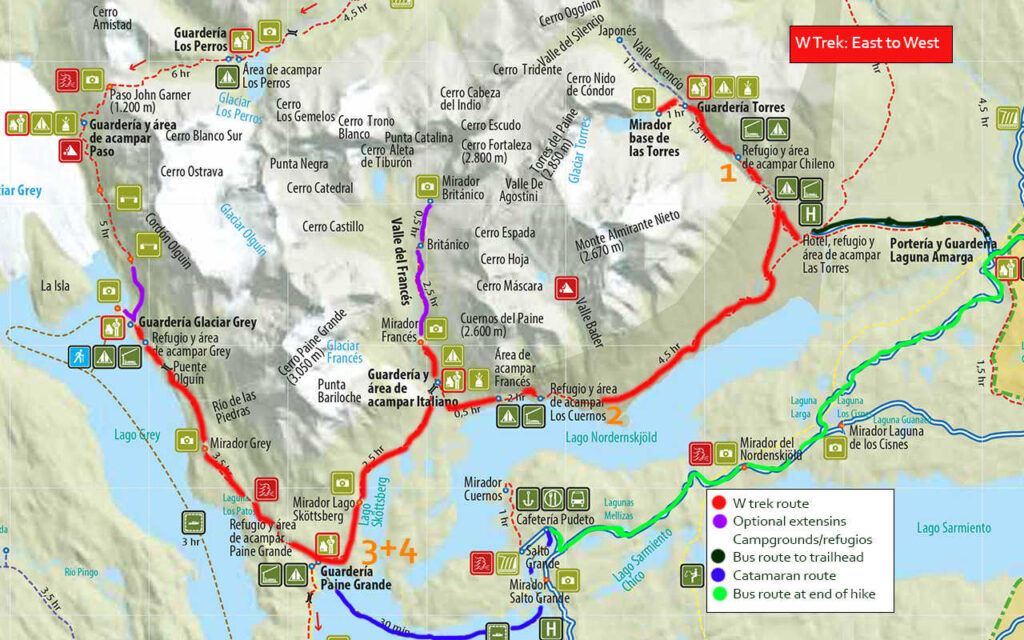
Day Zero: Puerto Natales to El Chileno
- Distance: 5 kilometers (3miles)
- Duration: 2 hours hiking
12:00pm Take a bus from Puerto Natales to Laguna Amarga.
2.00pm Arrive at Laguna Amarga. Show your entrance ticket at the ranger’s station.
2.30pm To get to the start of the W, you need to take the shuttle bus ($4,000 CLP ($6 USD) – you must pay in cash at the shuttle) to the Centro de Bienvenida (Welcome Centre).
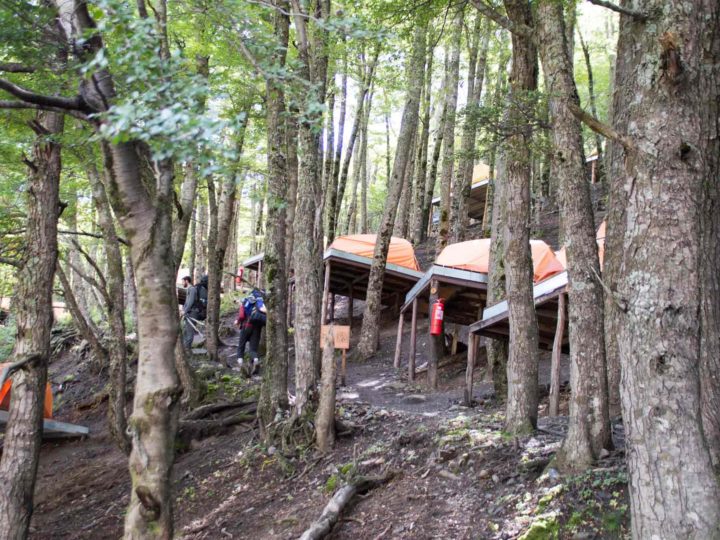
3pm Start hiking up to El Chileno, the closest campground to Mirador Las Torres, the famed viewpoint of the towers. This is the smallest campground, so sells out fast.
If you can’t get a spot here, you’ll need to camp at Torres Norte/Central and hike four hours tomorrow to reach the viewpoint.
5pm Arrive at El Chileno. Set up your tent, have dinner and relax.
Day One: El Chileno to Mirador Las Torres and then Los Cuernos
- Distance: 19.4 kilometers (12 miles)
- Duration: 6.5 hours hiking
4:30am Wake up and take a small bag (including warm clothes, a sleeping bag, and a snack) to see the torres at dawn. Don’t forget your torch as the route is over rocks and can be treacherous.
8:00am Leave the mirador and return to the campsite. Pack up, have breakfast start the walk down. When the trail splits, you’ll need to take the righthand path that goes alongside Lago Nordenskjöld.
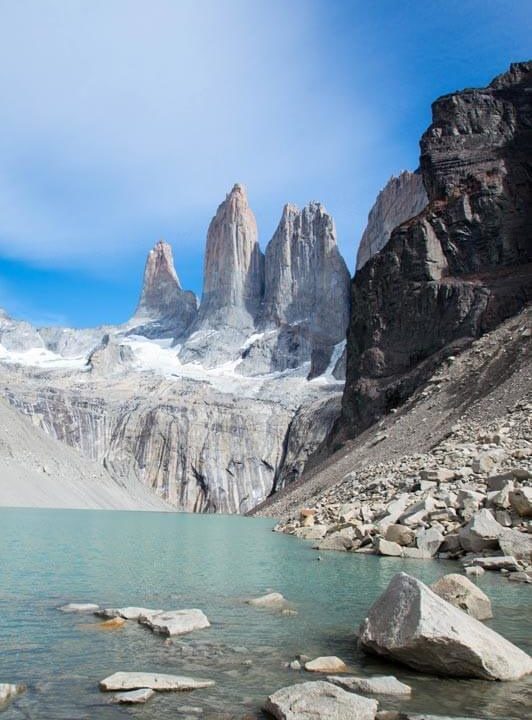
This trek meanders alongside the lake, gaining and losing altitude as it goes. The views are incredible but if it’s sunny, it will be hot!
3:00pm Arrive at Los Cuernos*, pitch up and relax.
*If there is no availability at Los Cuernos, when you go to make your refugio or campsite reservations , you can instead book to stay at Francés, which is a further 3.5 kilometers (one hour) beyond Los Cuernos.
Day Two: Los Cuernos to Paine Grande
- Distance: 17.5 kilometers (10.8 miles) from Los Cuernos to Mirador Británico and 7 kilometers (4.3 miles) from Guardería Italiano to Paine Grande
- Duration: 6.5 hours hiking from Francés to Mirador Británico and 2.5 hours from Guardería Italiano to Paine Grande
7:00am Get up, have breakfast and pack up your tent.
8:00am Today begins with the path alongside Lake Nordernskjold to Guardería Italiano. You can leave your bags here with the ranger before hiking up into the Francés Valley to Mirador Británico*.
10:30am The hike up the Francés Valley may be long or painfully short – all depending on the weather. Both times I’ve walked Torres del Paine W hike I’ve experienced dreadful weather in the Francés Valley.
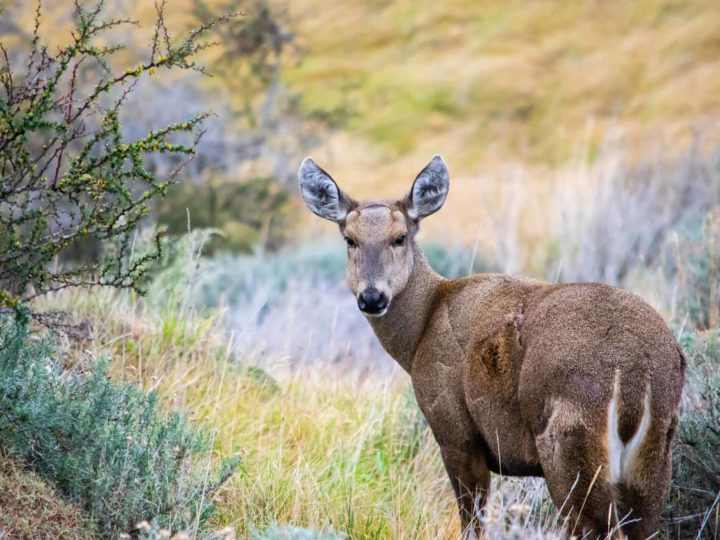
Luckily, the hike back is downhill to return to Campamento Italiano. From there, pick up your rucksack and hike the two remaining hours to reach Paine Grande.
Note that there’s a new trail that begins just after Campamento Italiano; take the lefthand fork that follows closer along the lake. It’s a little longer – 9 km (5.6 miles) rather than 7 km (4.3 miles) – and so takes around 30 minutes longer, but it has fewer hikers on it and is really pretty.
17:00pm-18:00pm Arrive at Paine Grande, pitch up and enjoy the views across the lake.
Day Three: Paine Grande to Grey and back to Paine Grande
9:00am Hike from Paine Grande to Grey; you can leave everything in your tent, except the items you need for today. The trail starts to go uphill but soon levels off and has great views of Lago Grey to keep your spirits up!
13:00pm Arrive at Grey. From the campsite, an additional one kilometre north through the forest brings you to two viewpoints lying over a kilometre from the glacier’s snout. From here, look out for enormous chunks of ice in the water.
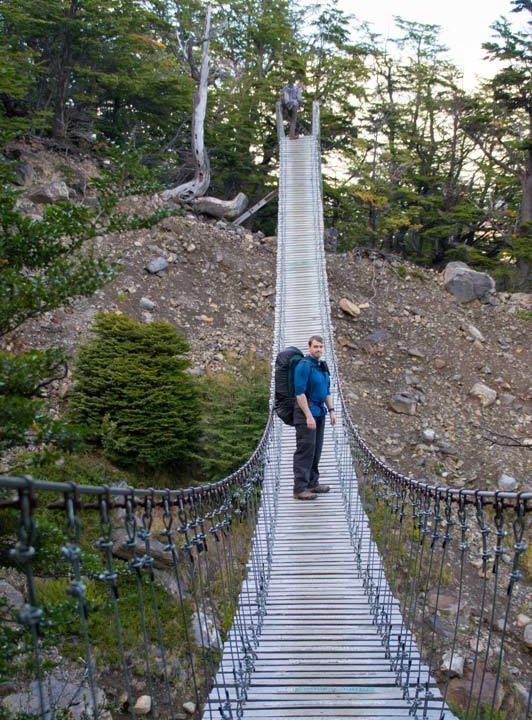
15:00pm Return to Grey along the same path and back to Paine Grande.
19:00pm Arrive at the campground, relax, have dinner and enjoy the feeling of finishing the trek!
Day Four: Paine Grande to Puerto Natales
- Distance: N/A
- Duration: N/A
9.00am Join the queue for the ferry to Pudeto.
9:30am Take the ferry to Pudeto. This service is operated by Hielos Patagonicos ($25,000 ($30 USD) single, cash only). Tickets cannot be reserved in advance; you buy them at the ferry port.
10:00am Arrive at Pudeto.
10.30am Take the bus from Pudeto to Puerto Natales and celebrate your successful completion of the W!
Top tips for hiking the Torres del Paine W Trek self-guided
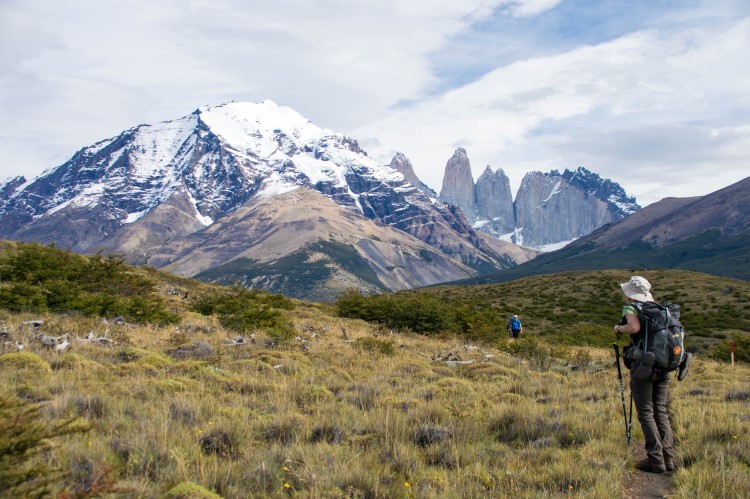
Having now been hiking in Torres del Paine National Park twice, I’ve learned a few important tips that have kept me happy, sane and comfortable en route :
Top equipment tips
- Camping in Torres del Paine at Francés, Los Cuernos, and El Chileno is on wooden platforms. If you plan to stay at any of these campsites, you will need extra cord or string to help you attach your tent without using pegs.
- Bring a range of warm and wet weather clothing. Check out my packing list for hiking the Circuit in Torres del Paine for the full guide to the clothing that I packed for the trip (and which is also a good guide to what to pack for the W). It also includes a free, downloadable checklist.
- Bring a book or some cards for the evenings as you tend to finish hiking quite early and if it’s cold and wet, you’ll want to retire to the shelters with something to do.
- Having a lightweight tent really does make a difference camping on this trek. Have a look at my review of the Big Agnes HVUL2 , the really lightweight backpacking tent that we used for the O Circuit.
- If you’re carrying all of your own equipment, a 60-litre rucksack should be big enough.
- Pack all of your clothes into dry bags (better than a bin bag which can easily rip). The weather changes rapidly and on days when it’s pissing it down, you’ll welcome the fact that your sleeping bag and clothes are dry. I recommend the Sea to Summit dry bags (buy them on REI | Amazon ).
- Bring a rucksack cover. I’ve heard mixed advice on this one, but a rucksack cover kept our bags dry (and so lighter) when we were hiking in Torres del Paine National Park and no, they didn’t blow away in the wind. If your rucksack doesn’t come with its own, you can find them in various sizes on | Osprey | Amazon (make sure it’s the correct size for your bag – otherwise it will blow away!).
Top food tips
- There is a much wider (and cheaper) selection of food in the supermarkets in Punta Arenas than in the one Unimarc supermarket in Puerto Natales. I recommend doing your food shop there before you take the bus to Puerto Natales. We left the stuff we didn’t need in our hostel in Punta Arenas.
- You can also buy trekking food and bring it with you , but it’s heavier and far more expensive than organising your food when you get to Puerto Natales.
- Pack everything into zip-lock plastic bags and bin all the original packaging that you can to save on carrying any extra weight. Also, don’t bring the full pack of rice if you’re only going to eat half of it – every bit of weight counts!
- You can buy basic staples (pasta, biscuits, tomato puree etc.) from the shops at Paine Grande, Grey, Francés and El Chileno to stock up on supplies. It’s pretty expensive, but totally worth it. They also all stock beer – an additional expense that I didn’t include in the costings for the W trek!
- You don’t need to bring water with you as it’s available from all the glacier meltwater streams that you’ll run into along the W and is drinkable from the taps at each of the campsites. If you’re nervous about drinking the water, you can also bring a Steripen (read my review of the Steripen Adventurer or buy one from Amazon or buy a newer Steripen UV Ultra from REI ) to zap anything that might be nasty or a Grayl ( REI | Backcountry | Amazon ) – find out why I recommend these water filters for South American travel .
- My dad is a pro at packing food for multi-day treks. Read what food we took with us for the O Circuit (and which you can use as a guide for the W too).
- You will need Chilean pesos on you for the park as nowhere accepts cards. You’ll need $25,000 CLP ($35 USD) for the catamaran ferry and then extras for additional food, beer, and anything else you want to buy.
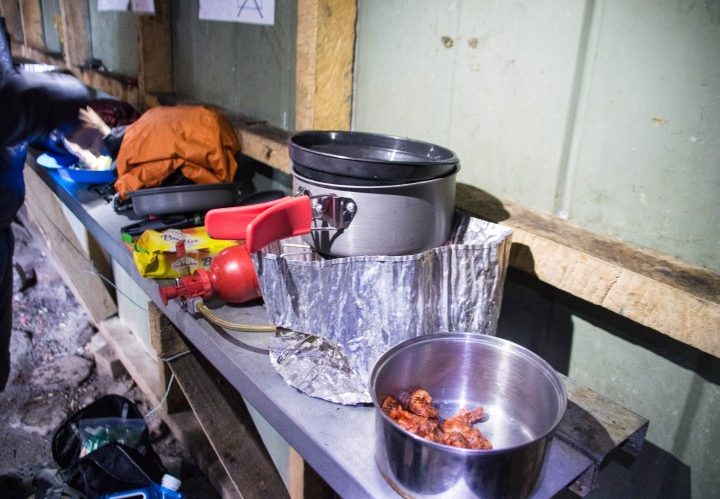
Camping in Torres del Paine
The following summarises some of the main points about booking campsites and refugios in Torres del Paine for the W trek, but you can get a full overview of how to book campsites in Torres del Paine with this article updated for the 2023/2024 season.
Reservations with Las Torres and Vertice Patagonia
You will need to book your campsites in Torres del Paine in advance. For example, in August 2022, many of the campsites and refugios were fully booked for December through February 2023, which just shows how far in advance it gets booked up.
Before you start panicking, what happens each year is that reservations free up again in September/October, probably due to the fact that tour agencies in Puerto Natales make mass reservations for the high season, and then cancel them when they don’t fill the bookings.
If you need anything planned well in advance, then this isn’t going to suit your plans. If your plans are a little more open and you can wait until closer until the time (and keep checking back to see if any spots have opened up), then you should still be able to hike the W during these months.
My recommendation would be to hike outside of these months anyway (November or March) to avoid the crowds as much as possible, but either way, you still MUST SECURE YOUR RESERVATIONS with Las Torres (Francés, Los Cuernos, El Chileno) and Vertice Patagonia (Paine Grande and Grey).
If you’re trying to get a space last-minute, you can always pop into either of their offices in Puerto Natales and see if they can book you in. I’ve heard of people having success with this with only a day or two’s notice.
Reservations with CONAF
For the 2023/2024 season, and for the foreseeable future, all of the CONAF campsites remain closed.
Upgrade your solo Torres del Paine W trek, Patagonia with these changes
If you’re not so bothered about hiking the W in Torres del Paine National Park on a complete budget, consider making the following small tweaks to your itinerary.
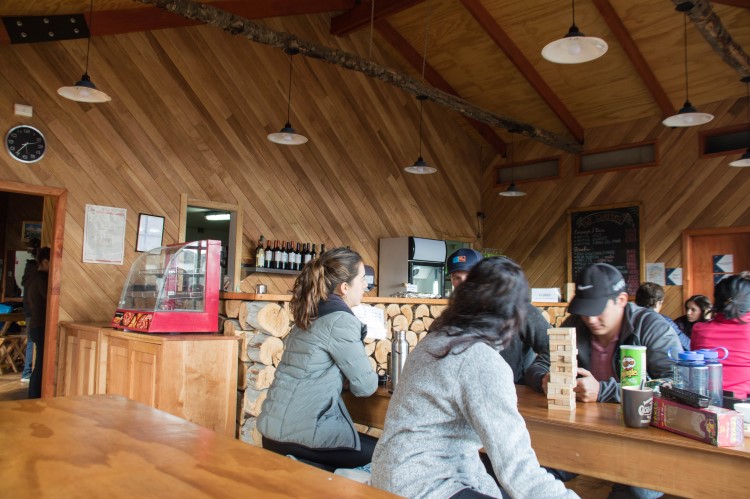
Stay overnight at Los Cuernos ($80,000 CLP ($88 USD) per person full board) instead of Francés
Again, this is only really possible if you stay overnight on Day Two in Paine Grande. When we hiked the Full Circuit, we decided to treat ourselves to an all-inclusive night at Los Cuernos.
This meant we still pitched our own tent on a wooden platform, but we had a three-course dinner, breakfast, and packed lunch for the next morning, which reduced the amount we had to pack in our rucksacks for the hike.
The food from Las Torres (previously known as Fantastico Sur) is much better than Vertigo Patagonia too, so I would recommend this instead of eating in the big canteen at Paine Grande.
Los Cuernos now offers camping sites without full board (previously you had to pay for full board at this campsite).
This means that for $25 USD per person you can pitch up your own tent here. They also offer half-board options priced at $62 USD per person, which include dinner and breakfast.
Book full board and a tent or bed at each campsite
You can rent gear and get food at all campgrounds, so if you don’t want to carry anything, then you can also book this way!
Bear in mind that full board at Los Cuernos comes in at $158 USD per person for a fully-equipped tent and full board – so it certainly won’t come cheap!
Did you find this guide to the Torres del Paine W hike useful? Pin it!
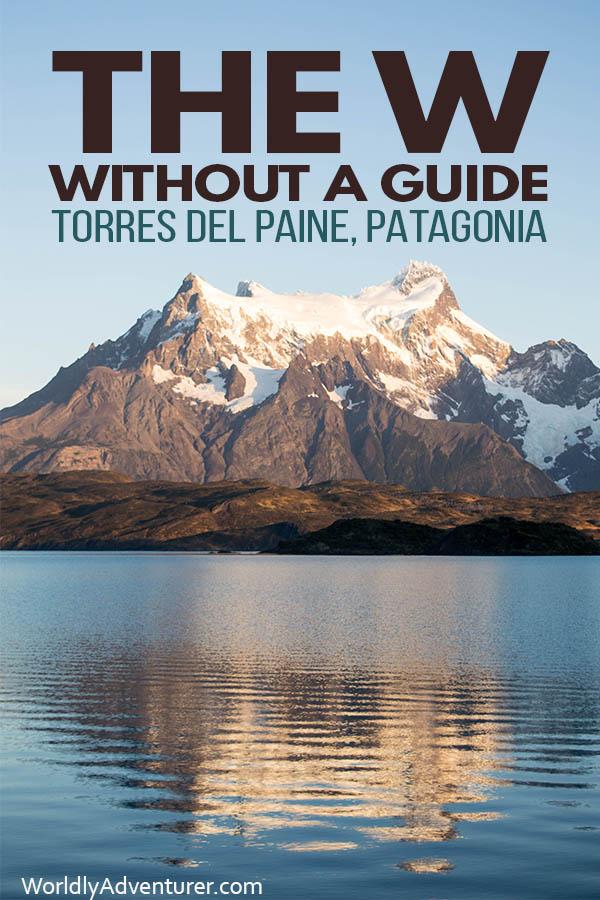
Helen Turner
Sunday 4th of February 2024
Excellent article. Plenty of food for thought. Thankyou
Steph Dyson
Friday 9th of February 2024
Thanks Helen! Steph
Sunday 26th of November 2023
We were hoping to hike to Refugio Grey, then take the Navigation boat toward Hotel Grey, then take a shuttle to our car at Pudeto. But I'm not sure how the timing works out. If we take the 14:00 navigation from Refugio Grey, is there time to make the last shuttle from Hotel Grey?
Tuesday 28th of November 2023
Hi Karen, I'm not sure. You would need to go off the timings on the Hotel Grey website or reach out to them directly. Steph
Jonny Collins
Tuesday 24th of October 2023
Thank you for your brilliant blog posts on all things South America - they're perfect for someone like me that loves knowing the logistics of our upcoming trips! My wife and I were meant to visit Patagonia for the first time in 2020 as part of a wider trip that was cut short due to COVID - we read your blog posts at the time whilst planning. We're finally planning to visit in 2024!
Unfortunately due to work commitments we are not able to take more than two weeks off and it is making our itinerary from the UK quite tight (we want to get to El Calafete and El Chalten in the same trip).
Whilst I appreciate you recommend doing the W Trek in 4 or 5 days, we are considering doing it in 3 days (we are experienced hikers and have done multi day hikes before). We had always planned hiking West to East. For the most even split on distance it seems that staying at Paine Grande and Los Cuernos would work best. We're really keen to see the towers at sunrise but appreciate that staying at Paine Grande and Torre Norte to do this would result in a very big second day. We have thought of two alternatives:
Option 1 (West to East): Night 1: Campo Italiano Night 2: Torre Norte
Option 2 (East to West): Night 1: Refugio Chileno Night 2: Campo Italiano
We've not considered yet if these options work with bus and ferry timetables. Do you think either of the above options are feasible to do the hike in 3 days and get to see the towers at sunrise? If not is there an alternative that might work, or if we do the trek in 3 days do we need to accept that we would not be able to see the towers at sunrise?
Any advice on the 'best' way to do the W trek in 3 days would be much appreciated. Apologies if anyone has asked this before! Thanks in advance :)
Sunday 28th of January 2024
Hi Steph, Thank you for your reply. In the end we decided to find an extra day from elsewhere in the trip so that we could do the W Trek and not miss out on anything! Thanks again for your help and for keeping this brilliant blog post up to date!
Thursday 23rd of November 2023
Hi Jonny, Italiano isn't open any more unfortunately. I would recommend just doing day hikes rather than the W. That way, you can actually enjoy your day hikes and not worrying about trying to cover the ground quickly. Steph
Tuesday 10th of October 2023
Great post, thank you! A group of five of us is heading to TDP to do the W-trek in January 2024. Very excited! We're flying from Santiago (SCL); is Puerto Natales a great option to fly into? I heard the drive to TDP from P. Natales is shorter than when coming from P. Arenas? It seems SKY airline has some flights during our time frame. Any great spot to hang out or visit at in P. Natales?
Hi LuAnn, yes you can fly directly into Puerto Natales. Steph
Wednesday 22nd of March 2023
Hi Steph! Can you please provide link where it is stated that a guide is required for hiking in May in Torres del Paine? I had not come across this requirement yet. Thank you!
Thursday 23rd of March 2023
Hi Megan, it's something I was told in a conversation with CONAF, the national parks office. You can reach out to them https://www.conaf.cl/parques/parque-nacional-torres-del-paine/ Steph
Connection denied by Geolocation Setting.
Reason: Blocked country: Russia
The connection was denied because this country is blocked in the Geolocation settings.
Please contact your administrator for assistance.

Dedicated to bringing you captivating stories, bucket list destinations, and off the beaten track experiences from near and far.
welcome to the blog
Inspiration
Middle east, latin america, north america, comprehensive guide to hiking the w-trek in patagonia, destination guides.
There are some views that are so iconic that they’re instantly recognizable – the Mona Lisa or Starry Nights of the natural world. They’re places that, even though you’ve seen hundreds of photos, feel surreal as you’re standing there, gazing, happily letting time slip away as you soak in their remarkable spirit.
The Base of the Towers in Chilean Patagonia is one of those spots. I’ve browsed through dozens, maybe hundreds of photos, hoping that I’d get the chance to see it myself. When that chance came last February, I grabbed it – even though I only had a couple of days to plan for a whirlwind trip. Luckily I had my friend Carrie from Venture Patagonia to plan the entire thing!
I would be joining my friend Andrea along the W-Trek through Torres Del Paine National Park, one of the most famous trails in a land famous for its natural beauty.
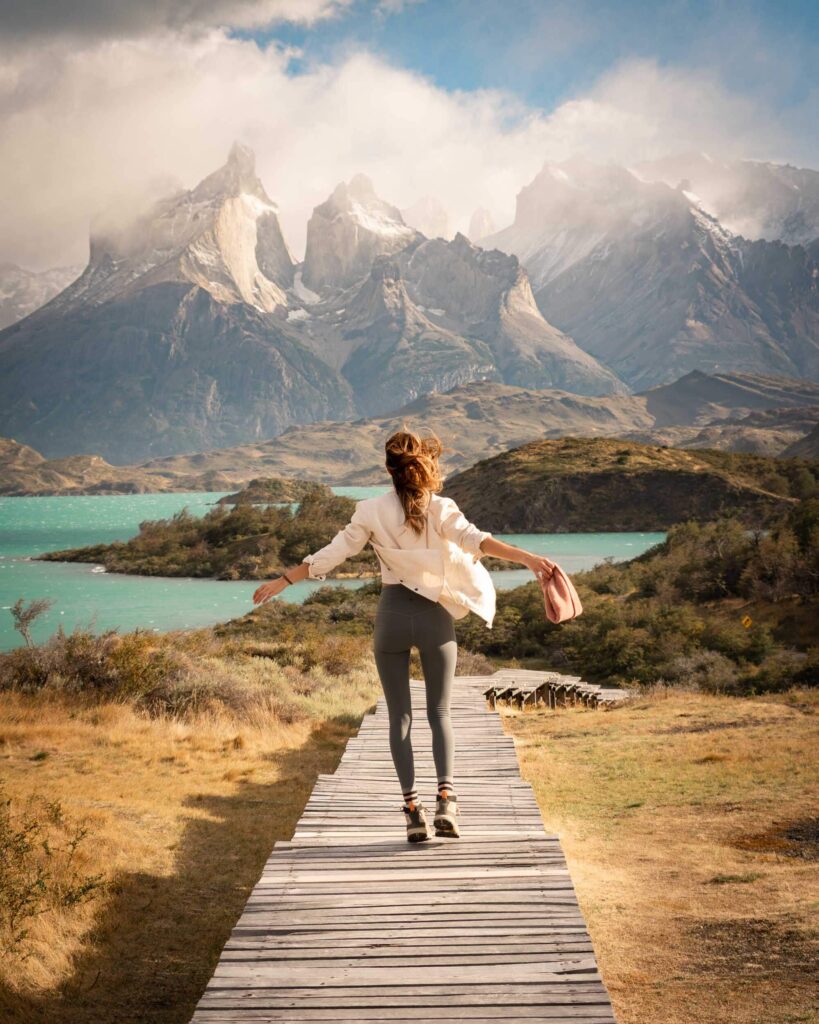
What is the W-Trek?
The mileage and elevation gain of the W-Trek is no joke – almost 50 miles and 9,000 feet of climbing through Torres Del Paine National Park. But that walking can be spread out between three and seven days, making it a manageable trip for those new to trekking. We decided to take four days but needed another day of travel to reach the hike’s launch point at Glacier Grey.
The W-Trek is normally walked east to west, starting at Refugio Las Torres and ending at Refugio Paine Grande. It runs up three valleys, creating the W shape that gives it its name. Instead of traveling east to west, we actually started on the west and at Glacier Grey.
There were two reasons for this: First, Andrea was actually backpacking the entire “O-Circuit” which, unlike the W-Trek, can only be completed in one direction. Second, we wanted to end our trek at its most famous viewpoint – the Base of the Towers.
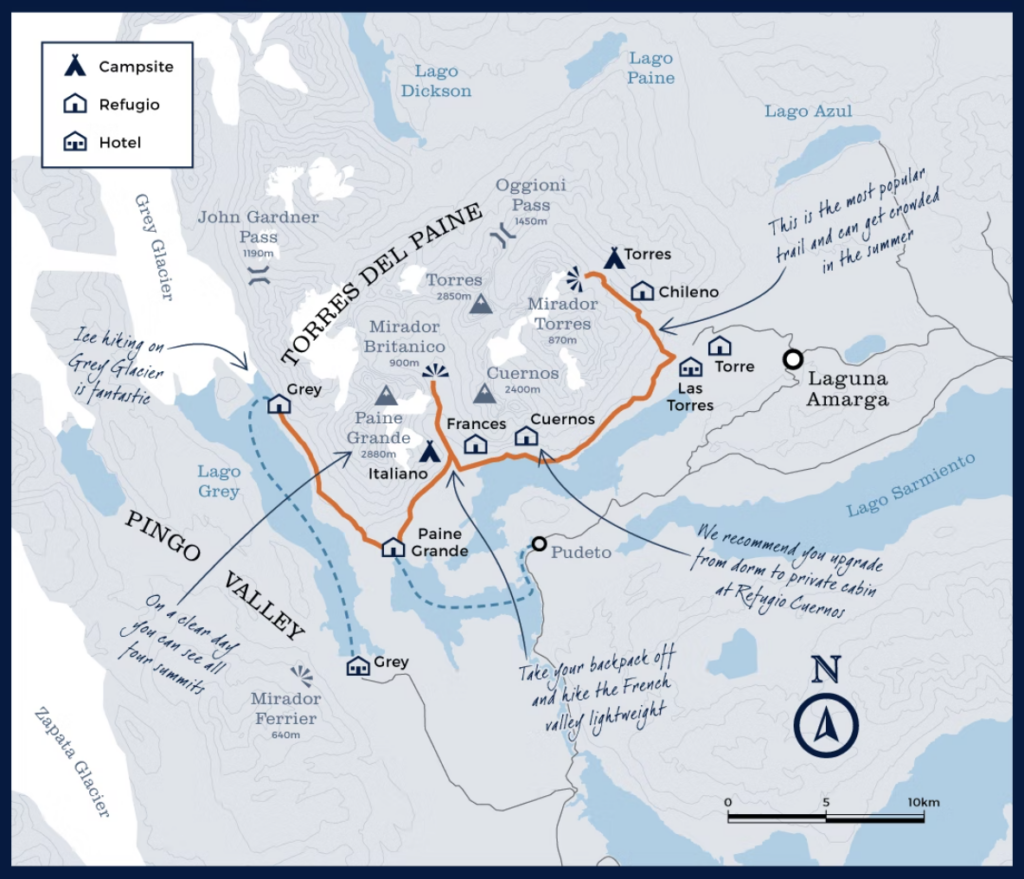
The W-Trek in five days
Day one: lago grey.
Torres Del Paine is a huge national park, covering about 700 square miles, and the larger Patagonia region encompasses 400,000 square miles. Not unlike its largest American cousins, just traveling through the park can take some time.
To reach our launch point, we took The Grey III Ferry across Lago Grey, a lake at the base of the Grey Glacier. We stayed at the campground at Glacier Grey but had time for some fun before calling it a night. There are two great options that can both be completed in a few hours.
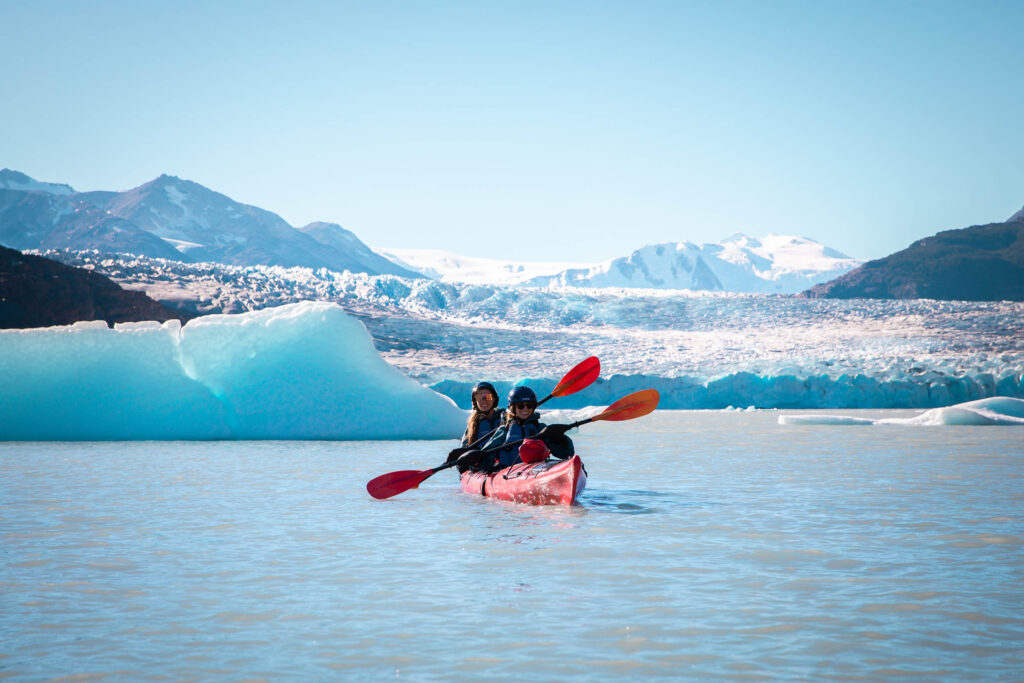
Activity One: Kayak Lago Grey
That first afternoon, after meeting up with Andrea, we kayaked Lago Grey , soaking in views of the glacier cascading into the lagoon, with more ice dotting the surrounding peaks. Talk about a cold lake – it was literally chilled by icebergs that had broken off the glacier!
Our 2.5 hour beginner-friendly expedition service outfitted us with kayaking gear, including a neoprene suit, additional drysuit and booties, and other safety gear. At the time (2022), kayaking Lago Grey cost: $66.000 CLP per person.
Andrea and I shared a double kayak, slowly weaving through icebergs as the sun glinted off the water. It was the sort of unexpected joy that can be hard to capture on a meticulously planned backpacking trip!
Activity Two: Suspension Bridge Hike
A great second option is to hike to a pair of suspension bridges that span the lagoon and glaciers, offering stunning views of the massive, shifting ice. The 2.3 mile hike gains about 950 feet of elevation, making it manageable for the day before embarking on a major trek.
Day 2. Glacial exploration and Paine Grande: 11 km/6.8 miles
It’s hard to comprehend the scope of glaciers in Torres Del Paine. That’s what makes a hike on a glacier so incredible; there’s really no other way to feel so dwarfed by these amazing structures.
Before hitting the trail on our second day, Venture Patagonia arranged for us to go on a five-hour walk across the Grey Glacier. Our guide did a wonderful job of pointing out pools of stunning blue melt water, navigating safely around crevasses, and finding great photo spots. We were outfitted with crampons, an ice axe, and helmets.
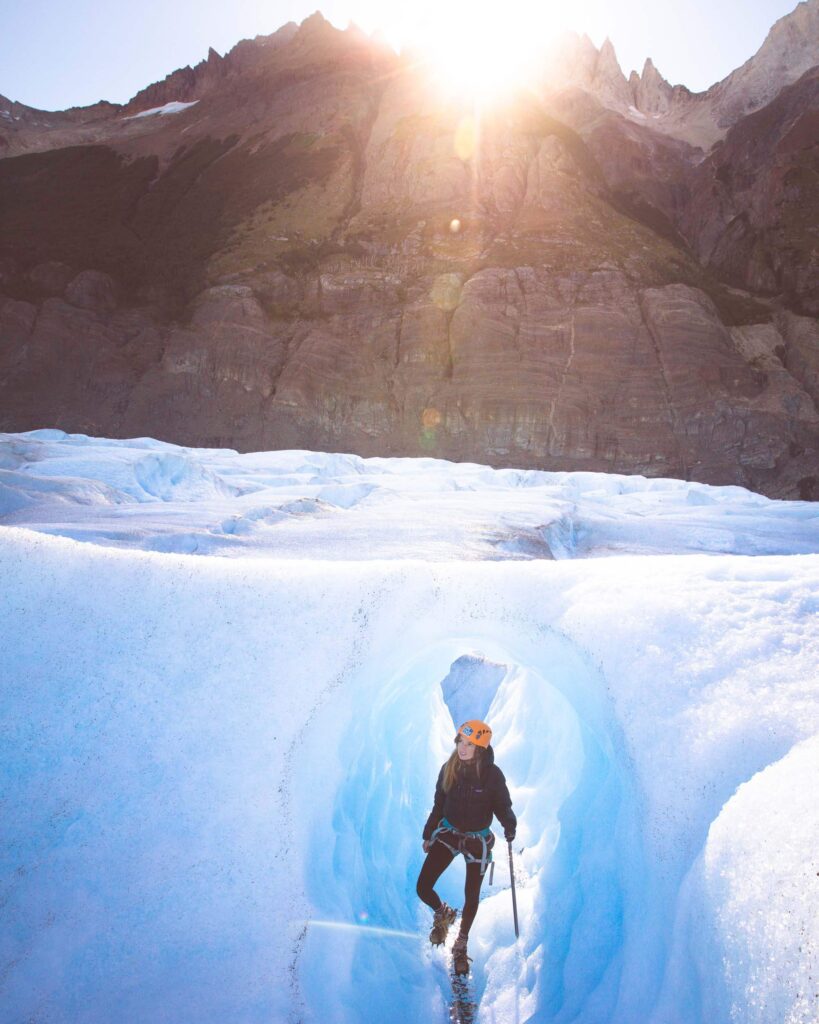
After the glacier walk, it was time to actually begin our path on the W-trek. Our first leg was the easiest, an 11km/6.8 mile walk. We set up our tent at Paine Grande and indulged in some luxuries like wifi, a shower, and a why-is-this-so-good ramen noodle dinner.
Day 3: Paine Grande to Los Cuernos: 25 km/15.8 miles
The realities of trekking set in quickly on day three. Sometimes, you just need to cover some miles. And sometimes, those days are hot – hot enough to make you wonder if hiking an extra section is worth it.
I’ve run into this question in a lot of different conditions. Making the safe choice matters most, but I’m almost always happy when I push forward… and we were thrilled that we pushed on to Mirador Britanico. After all, if you don’t do the French Valley to Mirador Britanico, did you even really hike the “W”?
This series of lookouts covers the middle swoop of the W, where the French Valley slices from Lake Nordenskjold into jagged highlands. We weren’t sure exactly what views would greet us as we hiked through the forested valley.
But the scenery was spectacular. Hanging glaciers lined sweeping rock walls, and sharp peaks gave us a taste of the famous towers to come. It’s amazing to think about how the same glaciers we walked across a few days ago helped to shape these gigantic peaks.
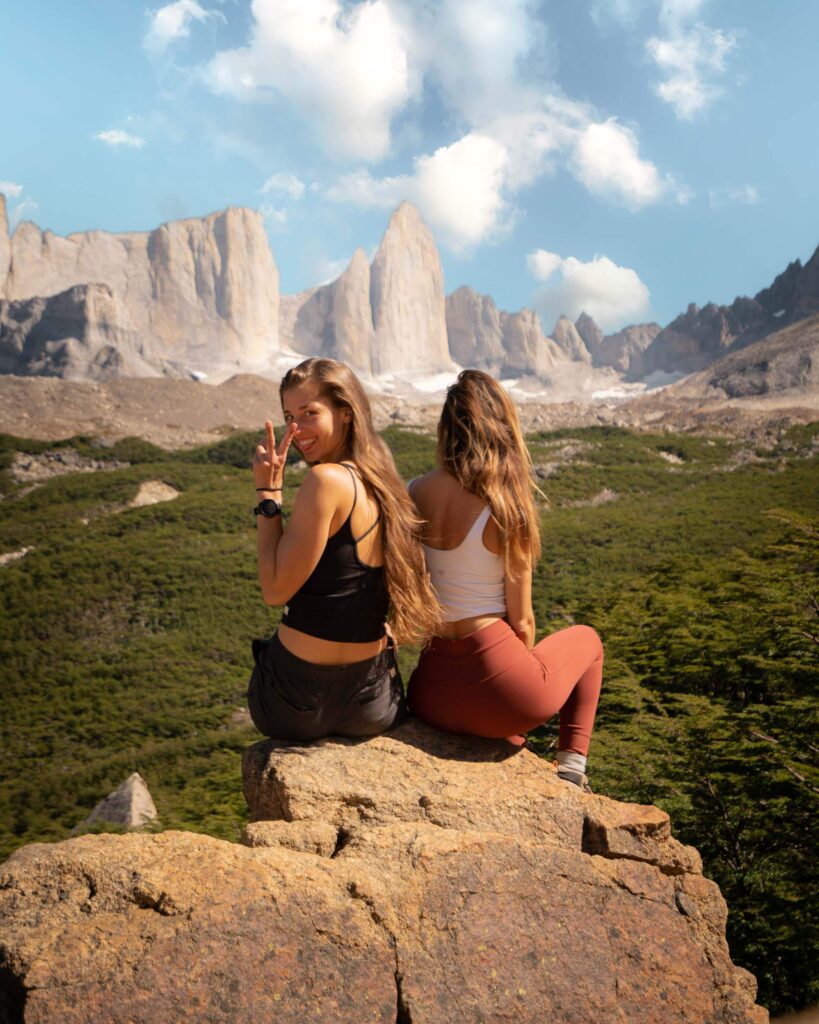
These were the sort of views that end up on Instagram feeds – the greatest hits of a hike. And that’s great! They’re hits for a reason!
But for me, the hot, wooded trek there, the decisions we made along the way, and even the extensive travel to just get to our trailhead all help build into a crescendo that peaks at these kinds of beautiful spots. Without the journey there, they don’t have the same power.
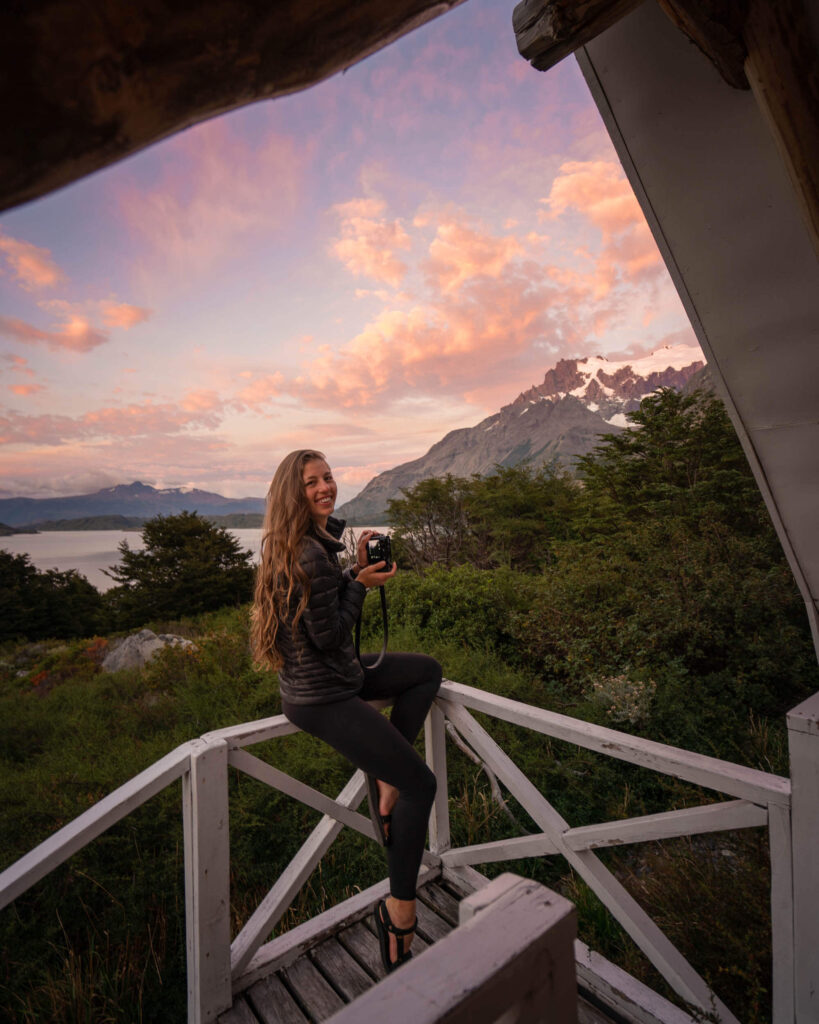
We stayed at Refugio Los Cuernos, which is named after “the horns,” a pair of massive granite peaks in the area. If you’re looking for a shorter day, Frances also has lodging options.
At Refugio Los Cuernos we opted to upgrade to our own private hut. Such a fun luxury! It was at this point that we also started enjoying breakfast and dinners at the refugios.
Day 4: Los Cuernos to Chileno: 12.8 km/8 miles
In some ways, this felt like a wrong way day. We hiked away from some of the most spectacular views at Los Cueros, traveling back along the middle swoop of the W, downhill past the towering granite and hanging glaciers.
At multiple points, Andrea and I mentioned how cool it would be to hike the W-Trek in the opposite direction – into the views. But we were soon back on the right track, continuing on the westward route that would eventually lead us to Los Torres.
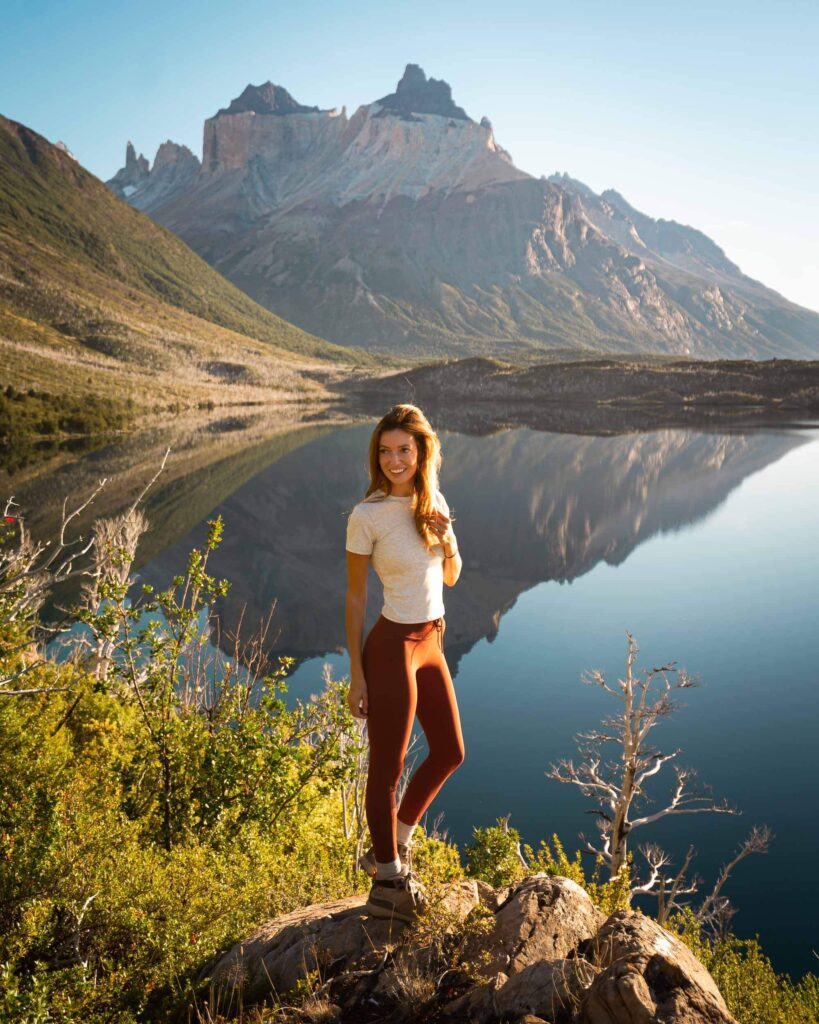
We climbed into the Ascension Valley gaining about 500 feet in a little more than a mile, reaching our camp at Refugio Chileno. Tomorrow would be our big day at the Base of the Towers… or at least we hoped so.
Day 5: Sunrise at Los Torres: 14 km/8.7 miles
This wasn’t a necessary sunrise hike. It’s only about 3 miles from Refugio Chileno to Los Mirador del Torres – The Base of the Towers – and we had enough time for a leisurely morning. Our beautiful weather was also running out.
A ranger at our refugio warned that ripping winds and rain were likely this morning. Those iconic towers would probably be swathed in clouds. But I’d seen too many photos of the stunning alpenglow that stains the towers bright pink at sunrise to give up that easily.
In hindsight, maybe it’s fitting that we decided to go anyway. It was a trip that I joined at the last second, that depended on so many little things going right. We put our faith in this one last thing breaking our way.
There’s no better way to soak in a beautiful view than in the early, changing light, as it shifts from a pale, even haze to a soft glow with hues of orange and pink.
We hiked up about 1,600 feet from Refugio Chileno, taking on the second major climb of the route. When we arrived at the base of the towers, it was still dark. We waited to see if we would get a weather window as the sun rose.
Did. We. Ever.
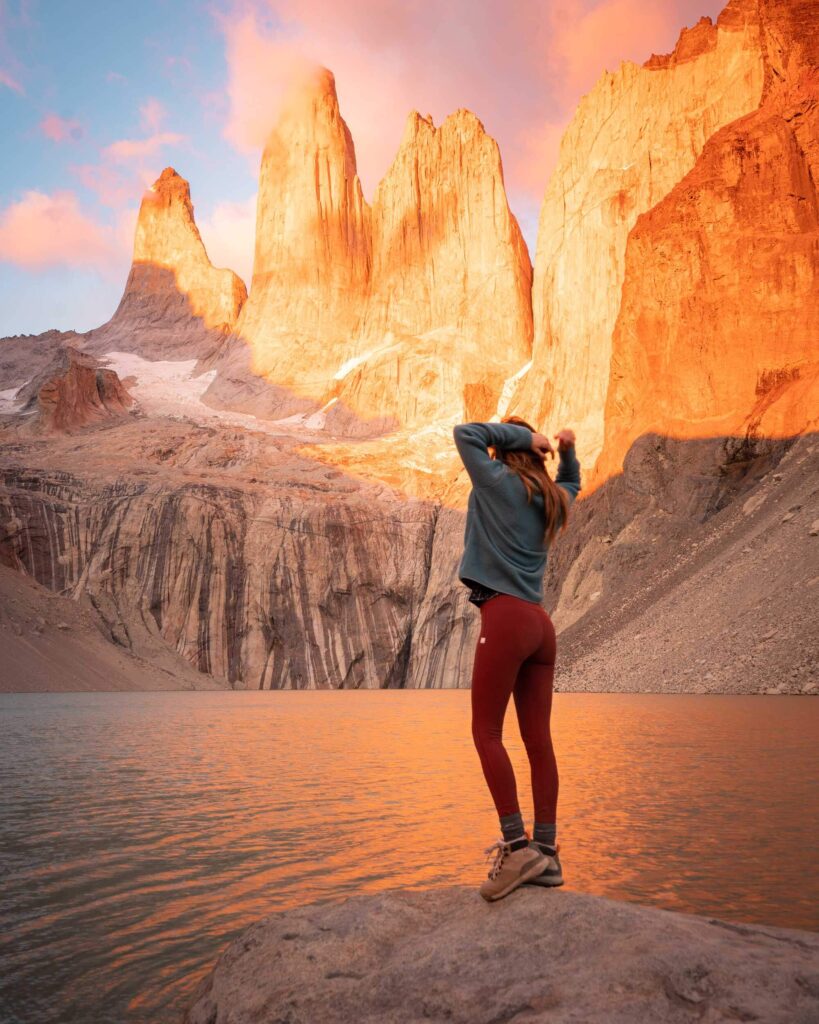
Orange light bathed the towers and washed into the lake below. It was a fitting way to cap a trip that I had already spent so much time thinking about.
Ironically, I botched the camera settings for my own photos. Maybe it was the 4 a.m. wake-up call. Maybe it was cold fingers. I’d like to think that I was just lost in a surreal moment.

After the light show was over up at The Towers, we headed back down to Refugio Chileno to eat some lunch and pick up all the gear we had left behind for our quick assent that morning. Once we had packed up it was time for the final push. We ended our W-Trek at Hotel Las Torres with celebratory pisco sours.
We spent our final night with a surprise stay at EcoCamp Patagonia , a domed refugio that sits at the western edge of the trail. There’s nothing like a hot shower at the end of a trek, and a picturesque rainbow gave us one last shot of Patagonia beauty.
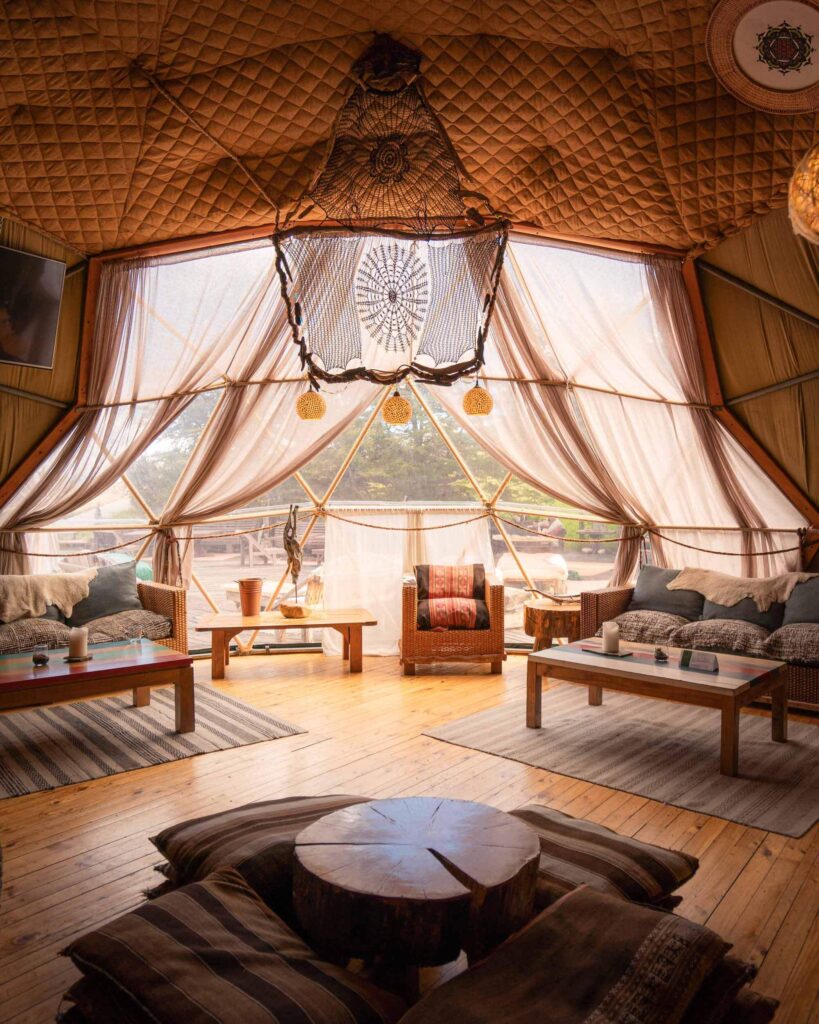
Final Thoughts About My Experience On The W-Trek
The towers are among the most spectacular scenery that I’ve seen. It’s truly a privilege to be able to explore natural beauty far beyond my backyard, with logistics taken care of by Venture Patagonia to ease our path.
It’s also a fundamentally different experience than taking friends to places I’ve long visited in Washington, where I’m the one who can teach them about what we pass by on the trail.
Travel can be a pain (Paine? Too much?). There’s cost, planning, time off work, logistical hurdles, and simply the anxiety of putting yourself in an unfamiliar place.
But it can be so rewarding, and not just for the spectacular views that show up in an Instagram post. I got to spend time with my friend Andrea, an amazing writer and photographer in her own right. I met wonderful people from Venture Patagonia, who graciously shared their wisdom about Torres Del Paine.
And, as it gets increasingly difficult to take time off for outdoor adventures, I got to spend five days on the trail filled with appreciation for natural beauty and personal reflection.
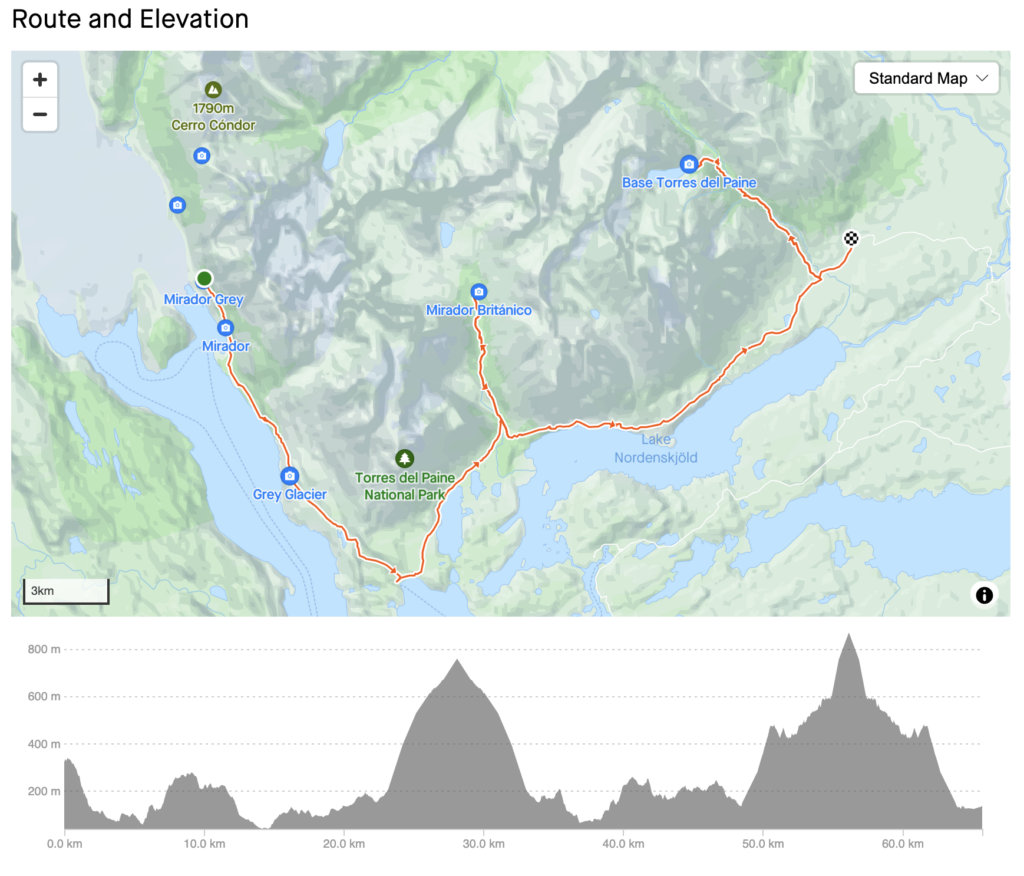
Camping vs. Refugios
It’s important to understand how lodging and backpacking operate in Torres Del Paine. There’s no dispersed camping like in some National Forests in the U.S. You can’t pitch a tent wherever you please.
Instead, camping occurs only at designated campgrounds. These are operated by different companies, have different costs, and are booked through different services.
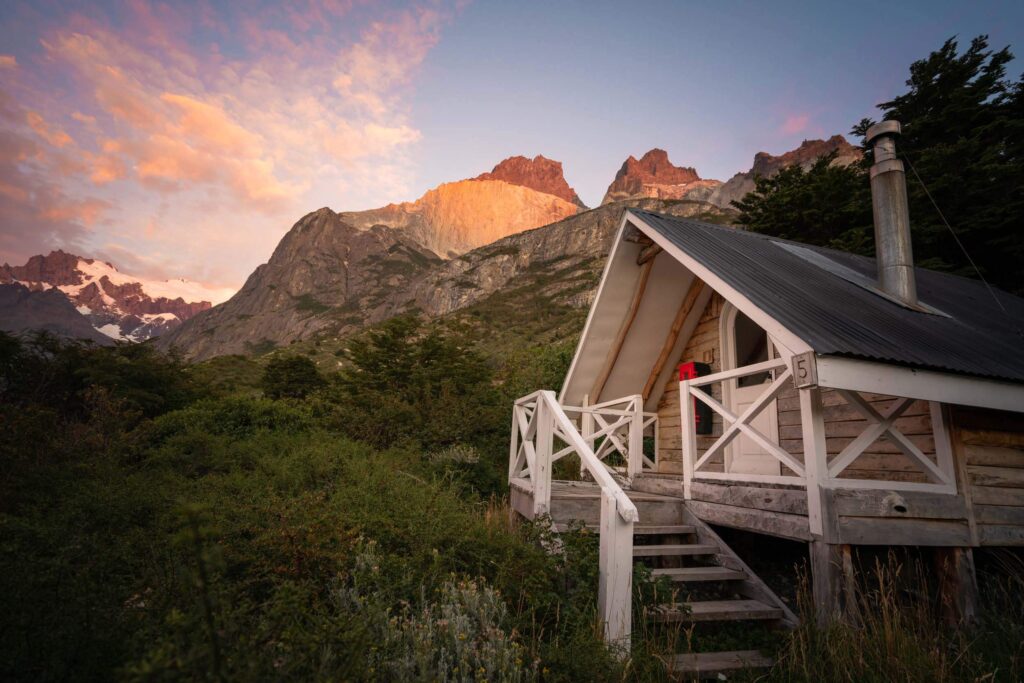
CONCAF (Chile’s version of the NPS) runs the Paso and Italiano campgrounds. Both are currently closed but might reopen for the 23-24 season. When open, they are free to stay at but need to be booked in advance at this Spanish-language website.
Fantastico Sur runs the Chileno, Frances, Los Cuernos, Seron, and Los Torres campgrounds. Each costs $21 USD for two people per night with an extra $11 USD per person. Book here.
Vertice Patagonia runs the Dickson, Los Perros, Glacier Grey, and Paine Grande campgrounds. Each campsite costs $9 USD per person. Book here.
We were lucky enough to get to experience a bit of everything. Our first two nights we camped in a 2-person tent I brought from home. Our third night we had a private hut at Los Cuernos, and our last night was spent in a dorm-style refugio room at Chileno.
There’s one huge advantage of spending every night at a refugio – you can carry way less stuff! There are also luxuries like wifi, showers, soft beds, and the comfort of enclosed sleeping quarters.
The flip side? Refugios are significantly more expensive than campgrounds. They aren’t available at all campgrounds in the park, including Italiano about halfway through the W-trek. Plus, you might end up in a dorm with a noisy sleeper.
Whether staying in a tent or refugios, you’ll share amenities like stores, restaurants, and bars. Some are great; others are a mixed bag. Most stores aren’t well stocked, campground bars can be a little noisy, and lodging whether by tent or refugio can seem a little cozy for those used to backpacking in solitude.
There’s also a middle ground. Many campsites rent tents, sleeping bags, and sleeping pads, helping you save on pack weight but avoid spending on a refugio. You can also bring some gear and rent some.
Does this seem like a lot to navigate? If so, you may want to work with a guide service like Venture Patagonia as we did !
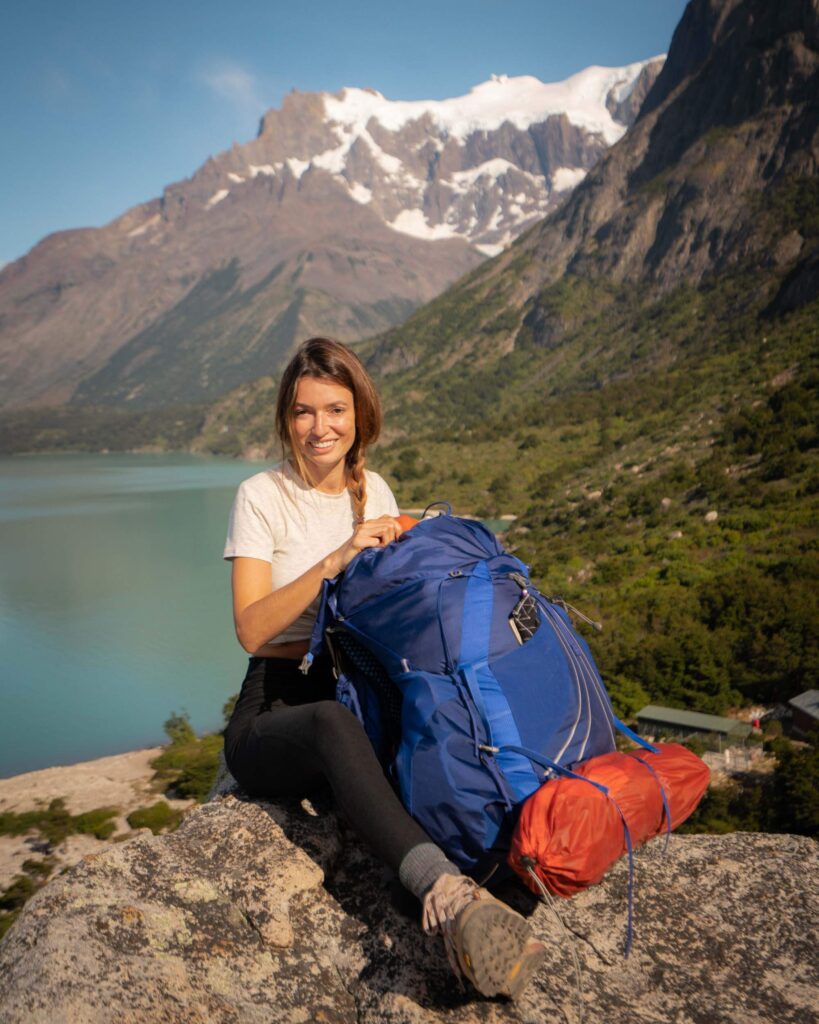
Full Board vs. Self Supported – The Best Way to Eat on the W-trek
The availability of restaurants and stores at campgrounds along the W-trek opens up a variety of possibilities for staying fueled. You can select options ranging from full board, with meals prepared for you to get through the entire day, to self-supported, which is more like a solo backpacking trip where you carry all your food.
Most campgrounds have a restaurant that can provide dinner and breakfast on site, plus lunch to go. They can accommodate vegetarian and gluten-intolerant diets. You can order full board whether you stay in refugios or campsites.
If you prefer to prepare your own food, options are much like backpacking that many of us are used to in the U.S. You carry what you can eat and what you need to cook with. This includes dried meals, snacks like bars and gels, and larger cooked meals if you like a larger spread and can carry a bit more.
Campgrounds also have stores that focus on calorie-heavy staples like pasta, beans, candy, soda, chips, and ramen. They also have hygiene products, and if you like to unwind, beer and wine.
You can also pick and choose from available options. Do you want to eat breakfast and dinner on full-board but prefer your own snacks for lunch? That works. Do you want to prepare your own meals but enjoy an evening beer? That works. At our first campsite, we feasted on ramen noodles. You do you!
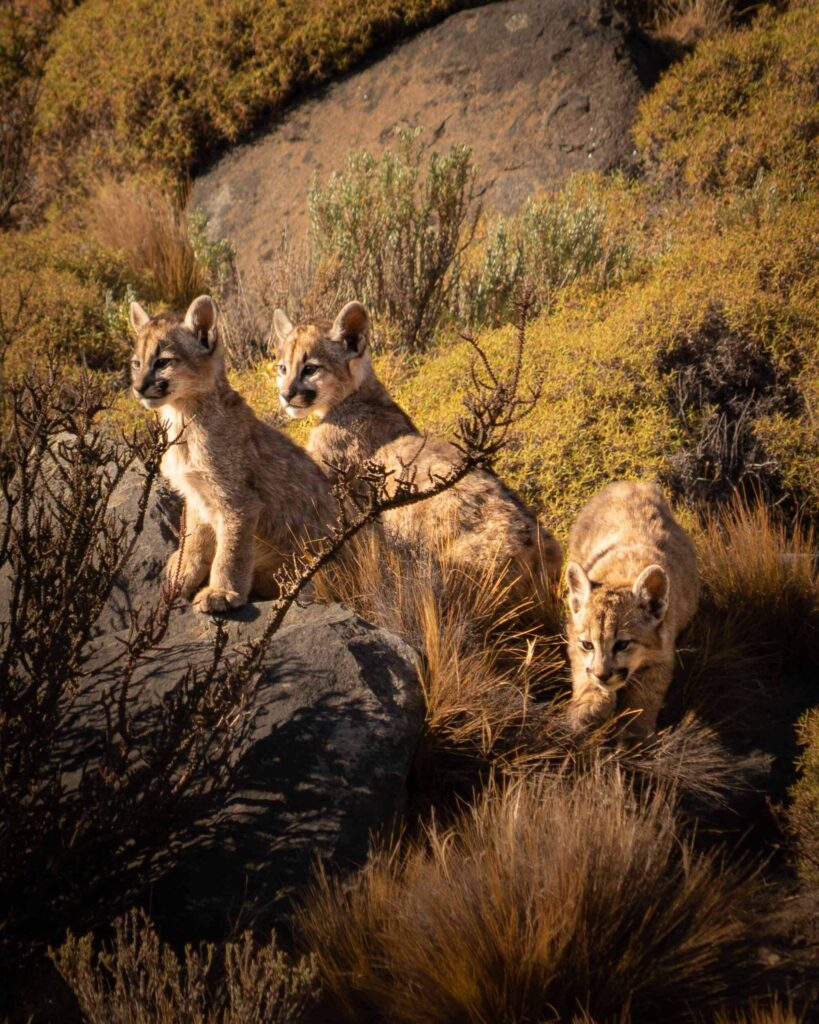
The Value of a Guide
A self supported hike along the W-Trek is not only possible, it’s an amazing experience! There are few things as rewarding as a successful solo backpacking trip. BUT given the extensive time and travel cost required to even get to Patagonia, you might consider going on a guided trip. Especially if you don’t have any previous trekking experience.
Reasons to Do a Guided Trek:
You don’t just hike the route, you learn about it. Guides are a wealth of information about the history, plants and animals, and hidden gems along the route. Hiking is so much more than trodding a path; guides help you immerse yourself in a place.
Lodging is a breeze. Guide companies take care of the sleeping arrangements, letting guests relax and enjoy the hike. A guide can also help secure any additional permits and fees you need.
No giant packs! I know I mentioned this already, but it’s a real treat to be able to embark on a multi-day hike without hoisting on a full pack.
Guides support local jobs. Outdoor recreation can be a critical resource for local economies, and services like guiding help local residents steward amazing natural places while providing for their families. Venture Patagonia’s owners Carrie and Kevin, live in Patagonia where Kevin grew up in a 5th-generation ranching family.
Self Supported W-Trek
If you are an experienced backpacker, self-supported can be a great option. The trail is in good shape and easy to follow, especially if you use a mapping application. You frequently see other hikers, who are usually happy to help with questions.
In many ways, the biggest challenge is booking campgrounds and refugios, arranging transportation into Torres Del Paine, and navigating the wider scope of international travel.
Self-Guided – An In-Between option!
You can also select a mix of services – which is what Andrea and I did. We felt confident that we could hike self-supported, but didn’t want to deal with the logistics of booking campgrounds, ordering meals, planning activities along the route, or arranging transportation before and after the trek.
That’s where Venture Patagonia came in! Many services let you customize the level of support you need.
When to Visit Torres Del Paine
Torres Del Paine is best visited during the Southern Hemisphere’s summer months of December-February, though spring (September-November) and fall (March-May) also have their charms.
Winter (June-August) is more challenging and usually requires a guide but can be an amazing experience. Even during the summer months, be prepared for all types of weather!
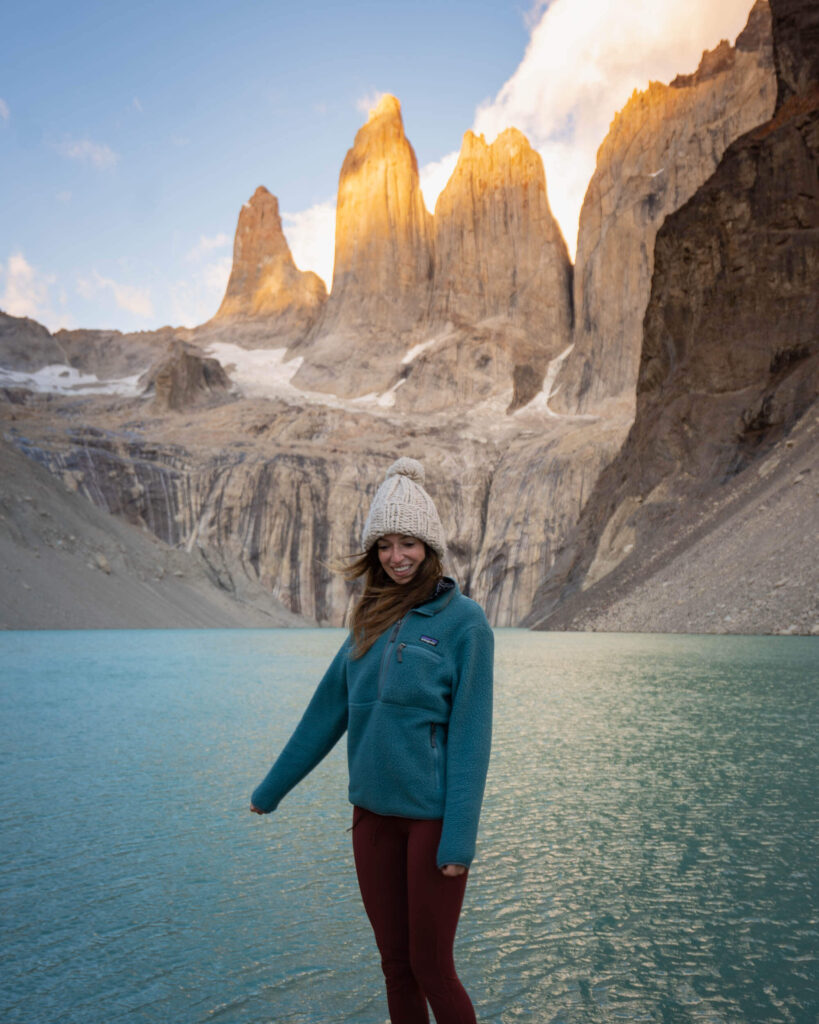
What to Pack for The W-Trek in Torres Del Paine
Packing layers is a crucial aspect of preparing for any trekking trip as it helps you stay comfortable and safe in changing weather conditions. The weather can be unpredictable in Torres del Paine, and temperatures can vary significantly at different elevations and times of day.
Packing appropriate layers for the W-Trek allows you to adjust your clothing to match the changing conditions, keeping you warm, dry, and protected. I have an entire blog post dedicated to the gear you will need for the W-Trek , but here’s a packing list to help you get started:
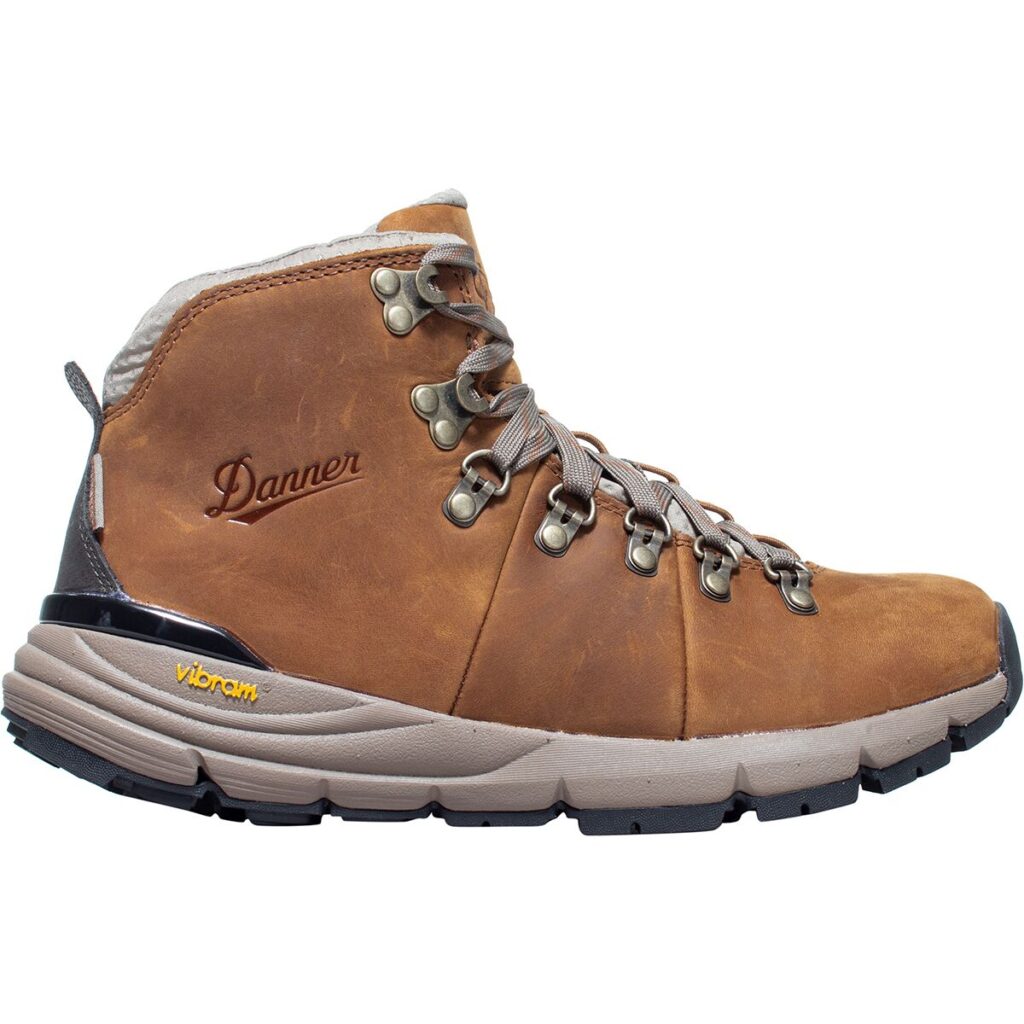
- Hiking boots : Choose sturdy, waterproof hiking boots that provide ankle support.
- Waterproof and breathable rain jacket : The weather in Torres del Paine can be unpredictable, so a waterproof and breathable rain jacket is essential.
- Insulated jacket : Nights can get chilly, so bring a warm, insulated jacket.
- Quick-dry hiking pants : Opt for lightweight and quick-dry hiking pants that are comfortable for long hikes.
- Moisture-wicking base layers : Bring moisture-wicking base layers, including shirts and underwear, to stay dry and comfortable during the trek.
- Hiking socks : Pack several pairs of moisture-wicking hiking socks to keep your feet dry and prevent blisters.
- Sun hat : A wide-brimmed sun hat will protect you from the sun during the trek.
- Gloves and beanie : Bring gloves and a beanie for warmth, especially if you plan to hike during the colder months.
Camping gear (For Self Supported Trips):
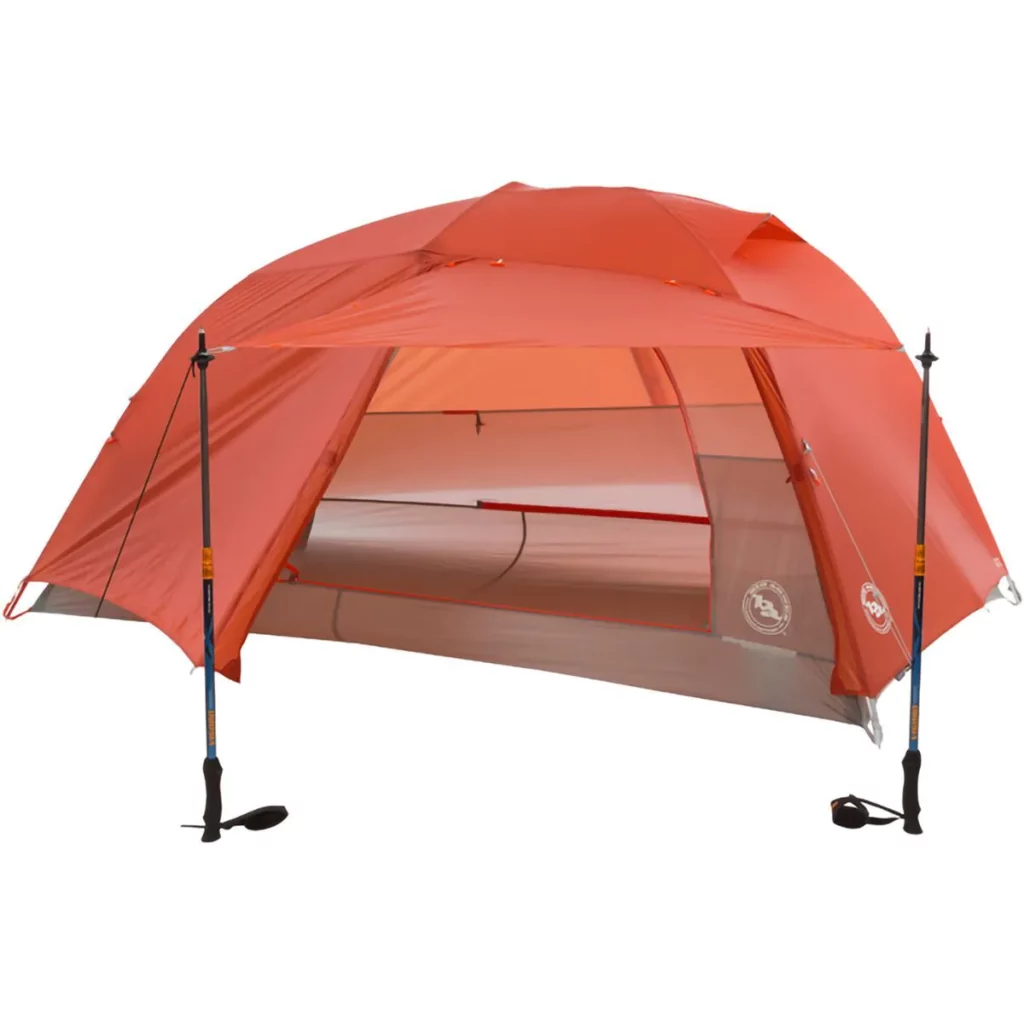
- Tent : If you plan to camp along the trail, bring a lightweight and waterproof tent.
- Sleeping bag : Choose a sleeping bag suitable for the weather conditions, preferably rated for cold temperatures.
- Sleeping pad : A sleeping pad provides insulation and comfort while camping.
- Cooking equipment : If you plan to cook your meals, bring a lightweight camping stove, cooking utensils, and a fuel canister (wait until you get to Patagonia to purchase).
Food and water:
- High-energy snacks : Bring lightweight, high-energy snacks like nuts, trail mix, and energy bars to keep you fueled during the hike.
- Water bottles or hydration bladder : Carry enough water bottles or a hydration bladder to stay hydrated along the trail, as water sources may be limited.
Other essentials:

- Backpack : A sturdy and comfortable backpack with a hip belt is necessary to carry all your gear during the trek.
- Trekking poles (optional): Trekking poles provide stability and reduce strain on your knees during steep ascents and descents.
- Headlamp : A headlamp is essential for navigating in the dark, especially if you plan to camp.
- Sunscreen and sunglasses : Protect your skin and eyes from the sun’s harsh rays with sunscreen and sunglasses.
- Insect repellent : Torres del Paine has mosquitoes and other insects, so bring insect repellent to protect yourself.
- First aid kit : Carry a basic first aid kit with essentials like bandages, blister pads, and any necessary medications.
Remember to check the weather forecast and trail conditions before your trip, and pack accordingly. It’s also advisable to pack light and only bring what you absolutely need to keep your backpack manageable during the trek. Happy hiking!
Just a quick heads up! Some of the links on this blog may be affiliate links, which means that if you click on them and make a purchase, I may earn a commission. Don’t worry, though – it won’t cost you anything extra, and it’s a way for me to keep this blog up and running. Thanks for your support!
Leave No Trace
Don’t be that tourist! It can be tough to remember that areas of Patagonia are a fragile wilderness when your campground has a bar. But continue to keep a clean camp and embrace zero-impact principles when on the trail and in the backcountry to ensure that future generations have the chance to enjoy this amazing place!
Other Treks You Might Enjoy
Complete Packing List For The W-Trek In Patagonia
Tips For Hiking The Tour Du Mont Blanc
Complete Guide To Backpacking The Mineral King Loop
Thru-Hike The Enchantments In One Day
4-Day Ausangate & Rainbow Mountain Trek
Like this post? Pin it for later and share it with others!
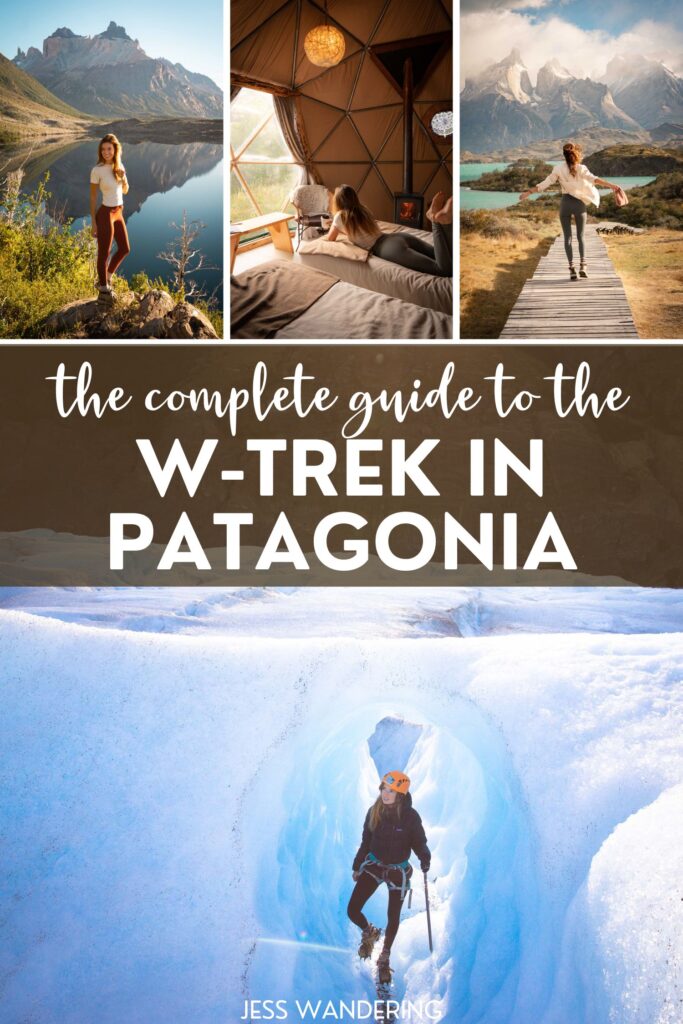
Complete Packing List For The W-Trek In Torres Del Paine »
« a complete guide to the baunei coast: sardinia’s east coast paradise.

keep reading
Leave a reply cancel reply.
Your email address will not be published. Required fields are marked *
Save my name, email, and website in this browser for the next time I comment.
WoW! Always inspiring and so hard to choose which views are my favorite when all are fantastic. I love living my life vicariously through your treks!
Thanks so much for the kind feedback John! the W-Trek was definitely one of my favorite adventures. Thanks for taking the time to stop by the blog and leave a comment – always very appreciated.
Amazing W-trik. I go through your blog post and it’s Wounderfull and very attractive. For a short time I feel like I was with you on your five day trip. Enjoy your day
Hi Jess, thanks a lot for the very detailed itinerary. Wondering what did you do on the final day after the trek before returning to Puerto Natales ? Did you have some private transportation to get you back while stopping at view points along the way ?
Yes! That’s exactly what we did. After the trek we spent the night at EcoCamp Patagonia, then the next day Venture Patagonia picked us up and drove us on a scenic tour through the park back to Puerto Natales.
Reader Favs

Travel Writing
The stories behind your favorite instagram posts of 2020.
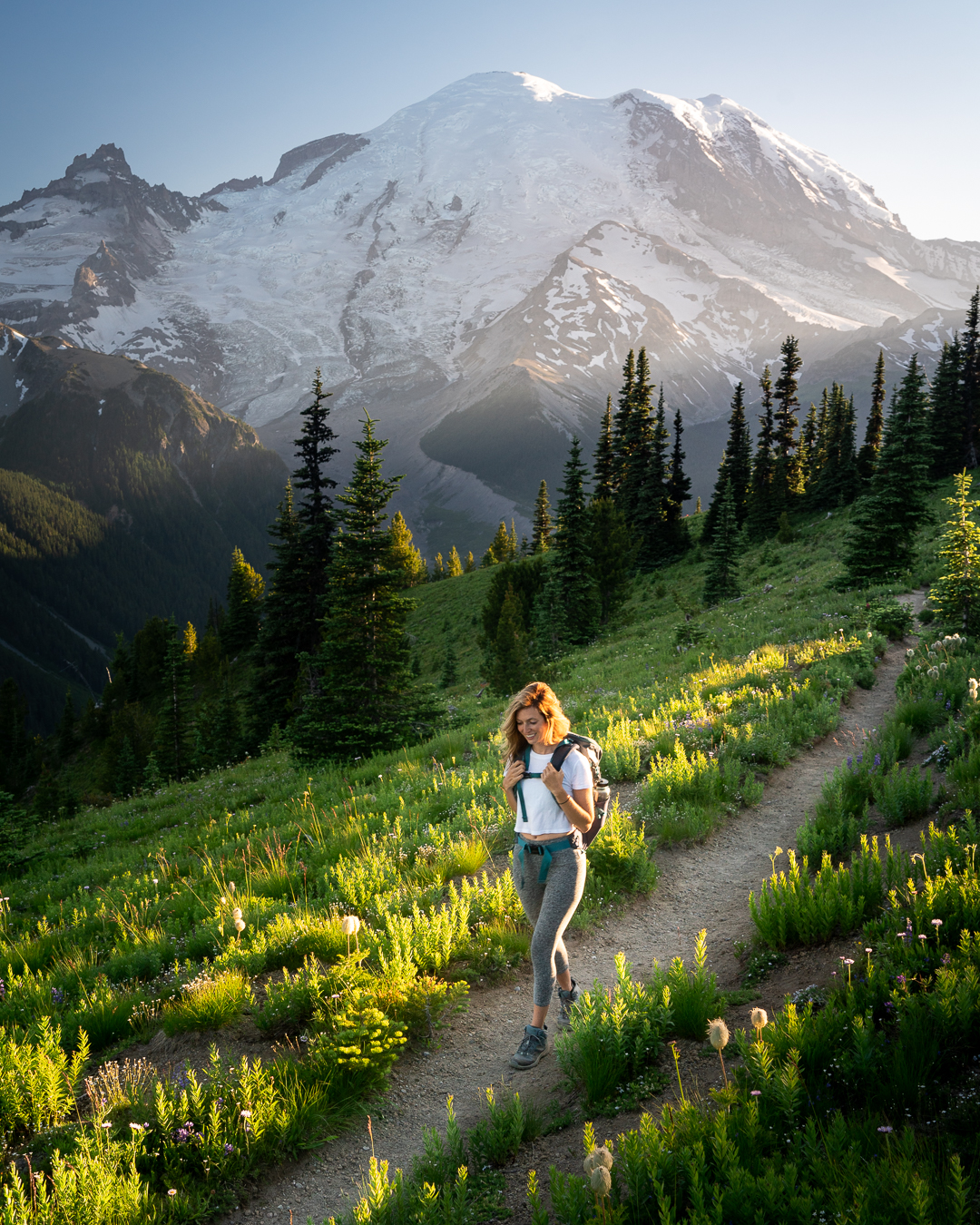
10 Best Hikes in Washington (A Local’s Must Do Washington Hikes)
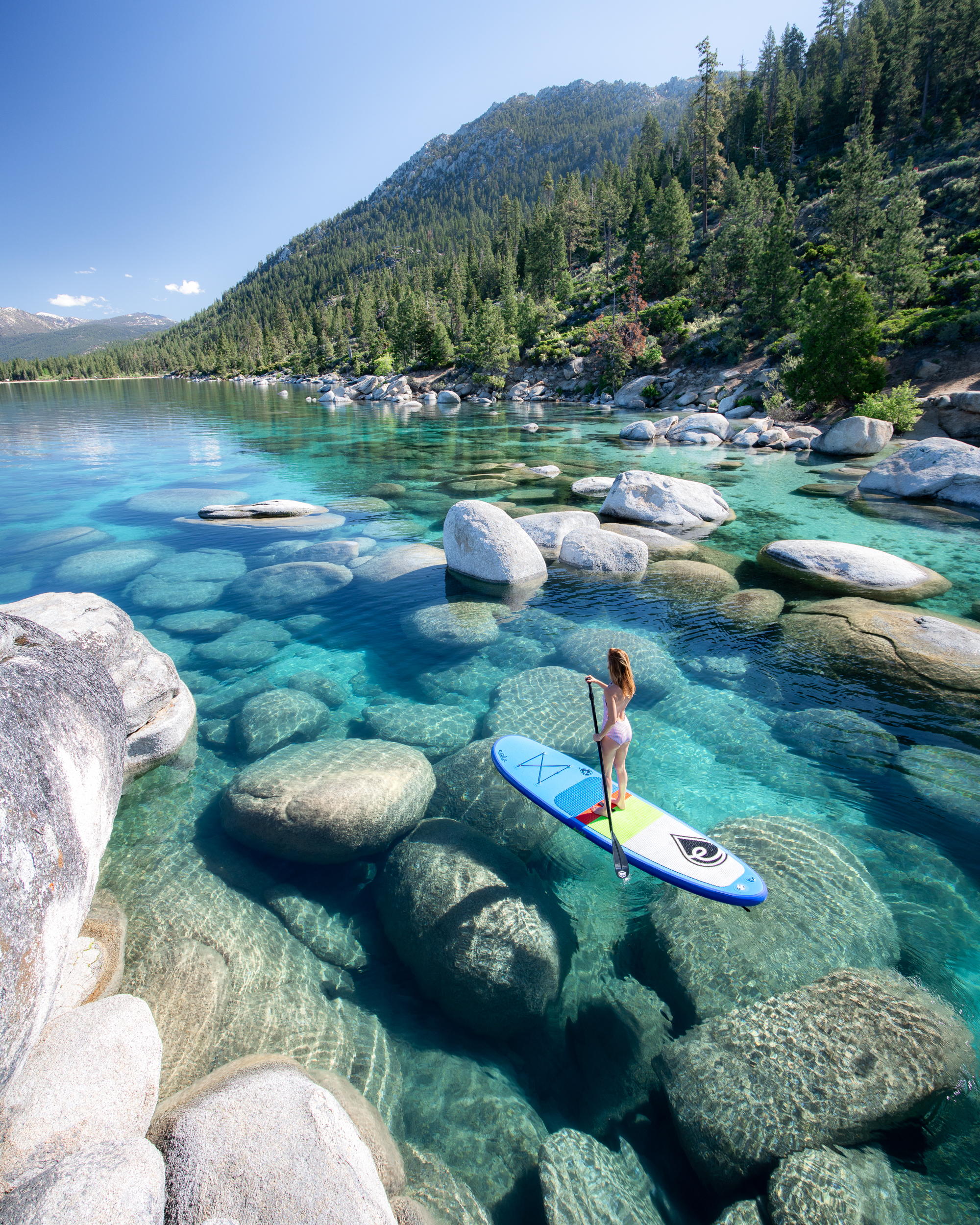
72 Perfect Hours In Lake Tahoe: Best Things to Do
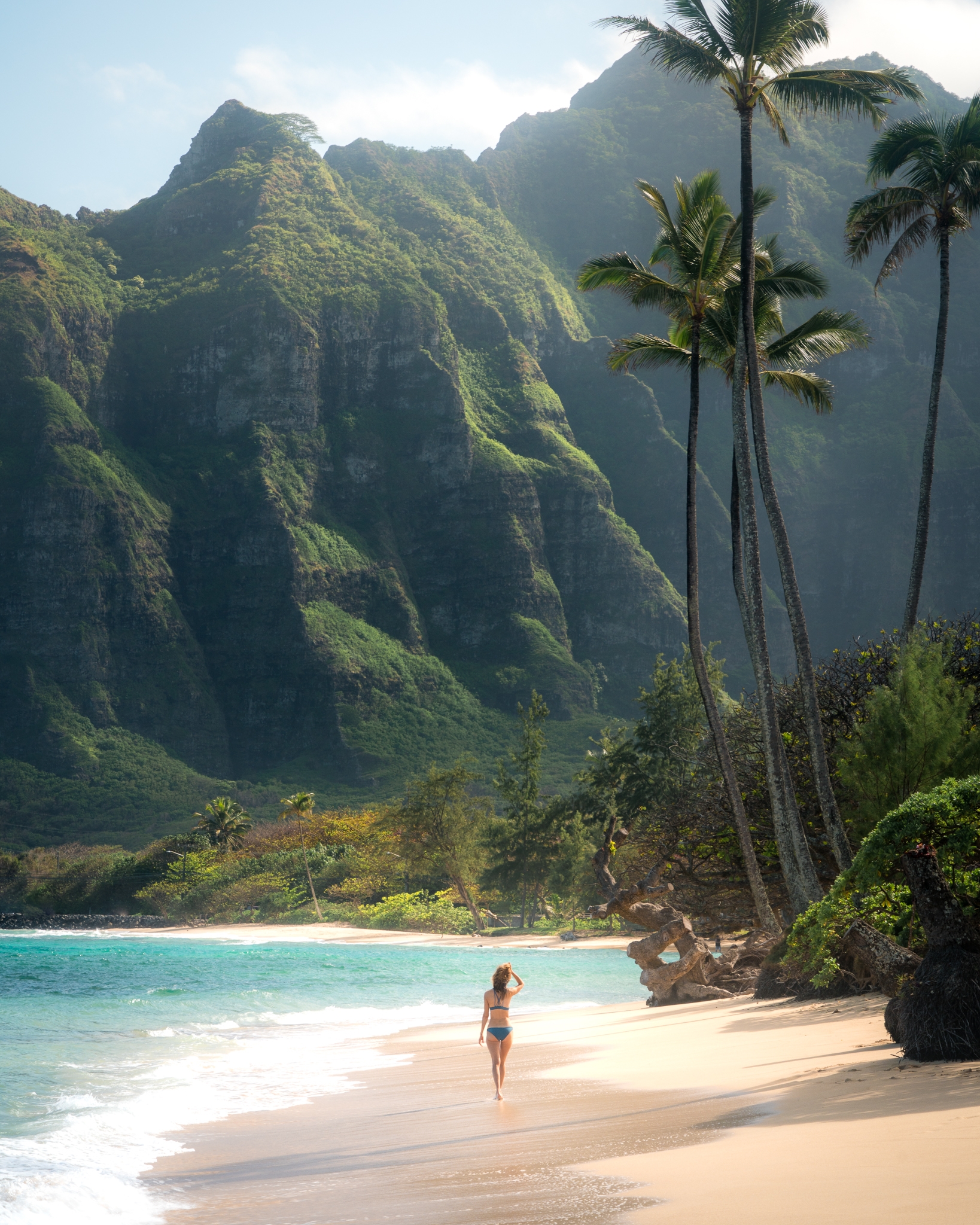
How I Afford To Travel All The Time

Hi, I’m Jess, an outdoor enthusiast based in Seattle. I grew up exploring the Pacific Northwest, and early on was infected with the travel bug. I tried to suppress my wanderlust in pursuit of a traditional career path, but after a short stint as a lawyer, I left the confines of my office to get back in touch with my roots. Now, I wander the world taking photos, making memories, and sharing my love for travel with others!
Meet the Writer

Before you go, make sure to subscribe so that you don’t miss out on new blog posts, upcoming events, and other fun travel resources!
Wander with Me
@jess.wandering
Back to Top
Design by Oregon Lane
Privacy Policy
©2021 Jess Wandering
Terms and Conditions

Hiking the W Trek in Torres Del Paine, Patagonia: Itinerary, Gear & Camping Tips
Want to hike the W Trek in Torres Del Paine? We answer all of your questions about itineraries, gear, campsites, and whether a guide is necessary.
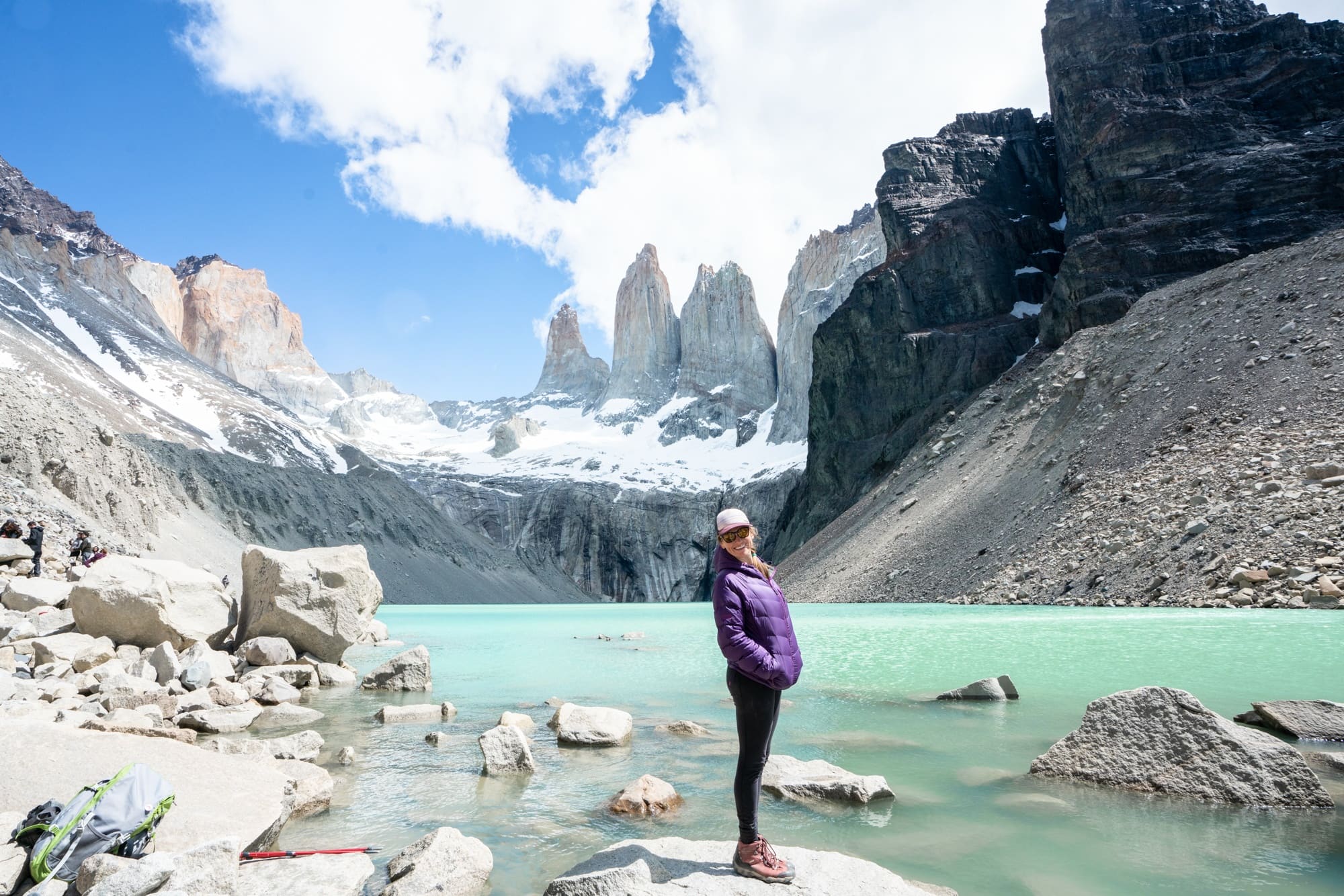
During my guided trip to Patagonia, I hiked the famous W Trek with G Adventures as part of the most recent Bearfoot Theory group trip. I spent four days and three nights in and around Torres del Paine and took in the amazing scenery of wild and rugged Patagonia.
There were comfortable campsites, home-cooked meals at the park’s well-known refugios which exist to serve backpackers and day hikers alike, not to mention top-notch guides. If you’ve ever thought about hiking this world-famous trail look no further.
Keep reading if you plan on hiking the W Trek in Patagonia for a complete itinerary, gear and camping tips.
W Trek YouTube Video
Watch my new YouTube vlog from our time on the W Trek in Torres Del Paine!
What is the W Trek in Patagonia?
Torres del Paine National Park in Chilean Patagonia is the most famous hike in the entire region. It’s a four to five-day hike that makes stops at the park’s iconic refugios for overnight stays with an option to hike the entire trek without carrying food. While hiking, it gives travelers unparalleled views of the granite towers and some of the park’s most well-known sites from up close.

Do you need a guide to hike the W Trek?
Now I’ll say that I’m not necessarily a “guided-tour-kinda-person.” I love traveling independently and the spontaneity that comes with being your own guide. However, it really depends on the destination for me and in the case of hiking the W Trek, there are a number of benefits to joining a tour, or hiring a local guide at a minimum. Hiking the W trek requires a ton of advanced planning. All of the campsites are run by different operators and fill up from 6 months to even a year in advance . Getting your desired dates and sites can be difficult.
If you hike the W Trek with a tour, you can be more spontaneous with your travel plans since the campsite reservations are made for you. You won’t have to book a year in advance in the case that you find yourself with unexpected vacation time. You’ll also learn so much more about the culture, local language, geography and history of the park because of the guide’s own personal experience and familiarity with the area.
Our two local guides contracted by G Adventures, Jarek and Marcello (along with our G Adventures tour guide Marina ) were very knowledgeable, a lot of fun, and had high safety standards, and I had a more memorable experience because of them.
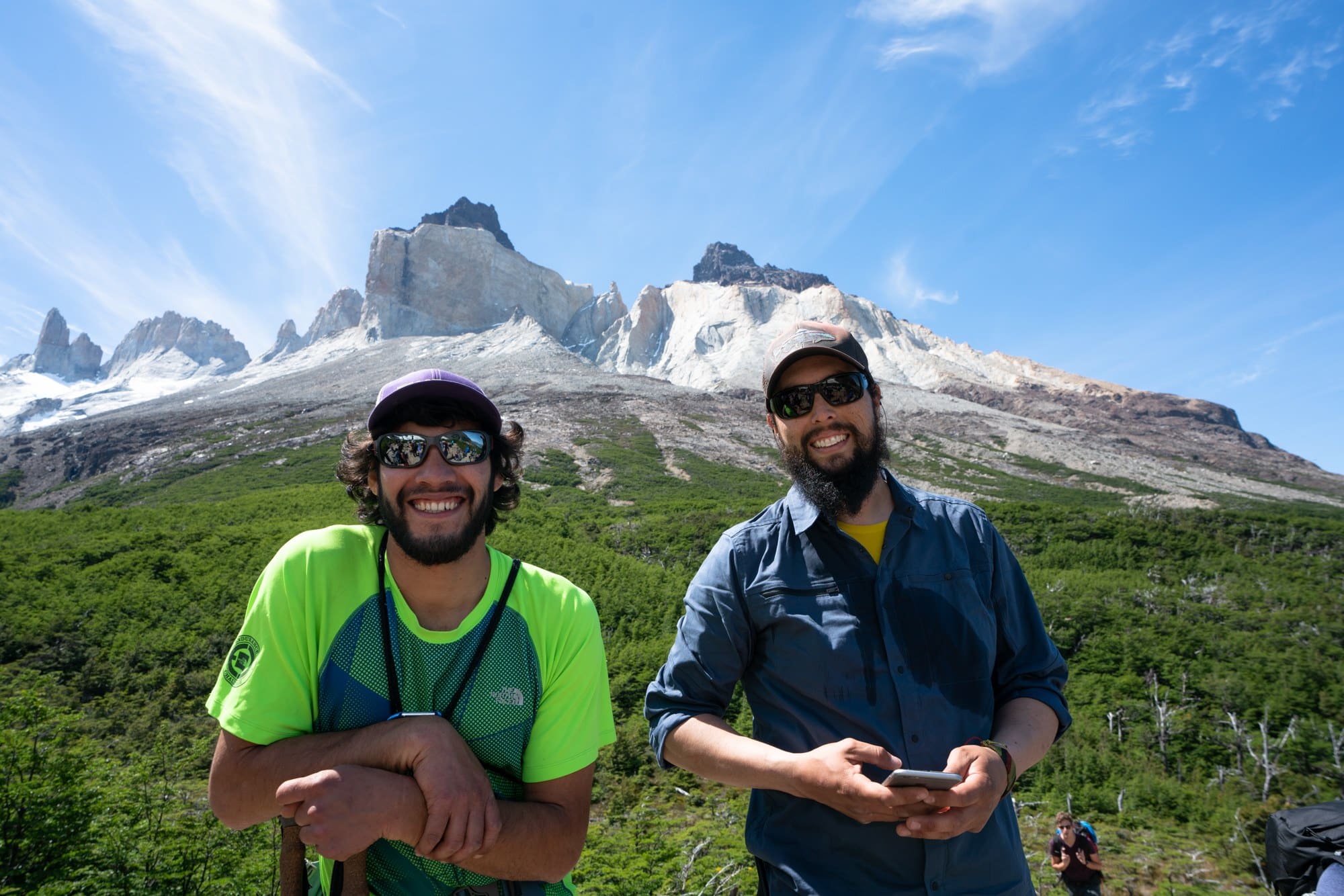
They were adamant about Leave No Trace practices and were full of local insight including what water sources were safe to drink, prime lunch spots, and more.
G Adventures even arranged for us to have all of our gear transported for us each day to the next campsite. So all we had to carry was our daypacks full of food, water, camera, and extra hiking layers. Plus, all of our meals were set up for us, we always had a hot breakfast and dinner at the refugios and were given a boxed lunch for the trail every day.
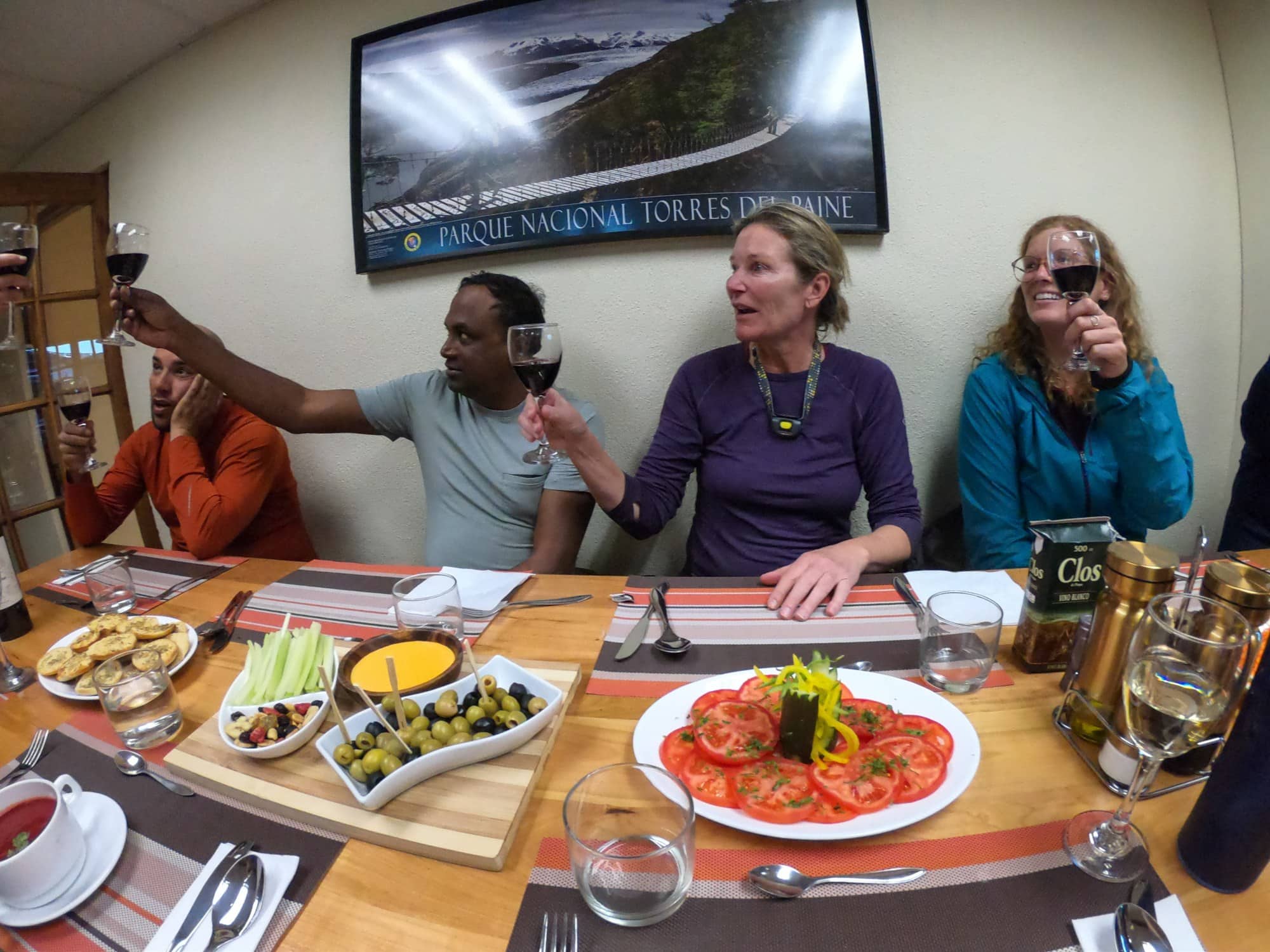
It’s worth pointing out that joining a tour or hiring a guide is the more expensive option; so you have to decide if the logistical conveniences are worth it to you. If you do decide to do it independently, don’t worry about hiking it solo. The trail is very well marked and well traveled, so it would be tough to get lost.
Overall, I thought our G Adventures tour was a great value given how much time and effort they saved us in planning and the amazing experience we had as a group. You can read the full review of my Patagonia G Adventures tour here .
If you do want to do it independently, check out these resources:
- Camping in Torres Del Paine
- 6 Options If You CAN’T Get Torres Del Paine Reservations
- Torres Del Paine Park Information, Fees, and Boat Schedules
Leave No Trace When Hiking in Patagonia
Whether you are traveling with a guide or not, please educate yourself on local Leave No Trace practices. Here’s a quick refresher if you’re a little fuzzy on the most basic (and global!) ethics…
- Anytime you go outside, pack out your toilet paper and don’t go to the bathroom near water sources
- Stay on the trail. Don’t cut switchbacks or take shortcuts.
- Only camp at established campsites (making your own campsite in Torres Del Paine is prohibited)
- NO CAMPFIRES OR BURNING TOILET PAPER (there was a huge fire recently that burned a huge portion of the park).
- There is also no smoking allowed on the trail.
- Make sure you secure your trash when you are eating. It is very windy in Patagonia and if you leave a wrapper sitting on your pack while you eat, there is a good chance it will blow away.
- Pack out all of your trash, and don’t leave your food trash in refugio bathrooms. It’s much easier if everyone just takes the trash they produce back with them to Puerto Natales and disposes of it there.
- Leave wildlife alone. If you are lucky enough to encounter wildlife, don’t approach or feed them.
- Yield to uphill hikers and be friendly . This is a world-famous hike and it’s important to share it and practice good trail etiquette.
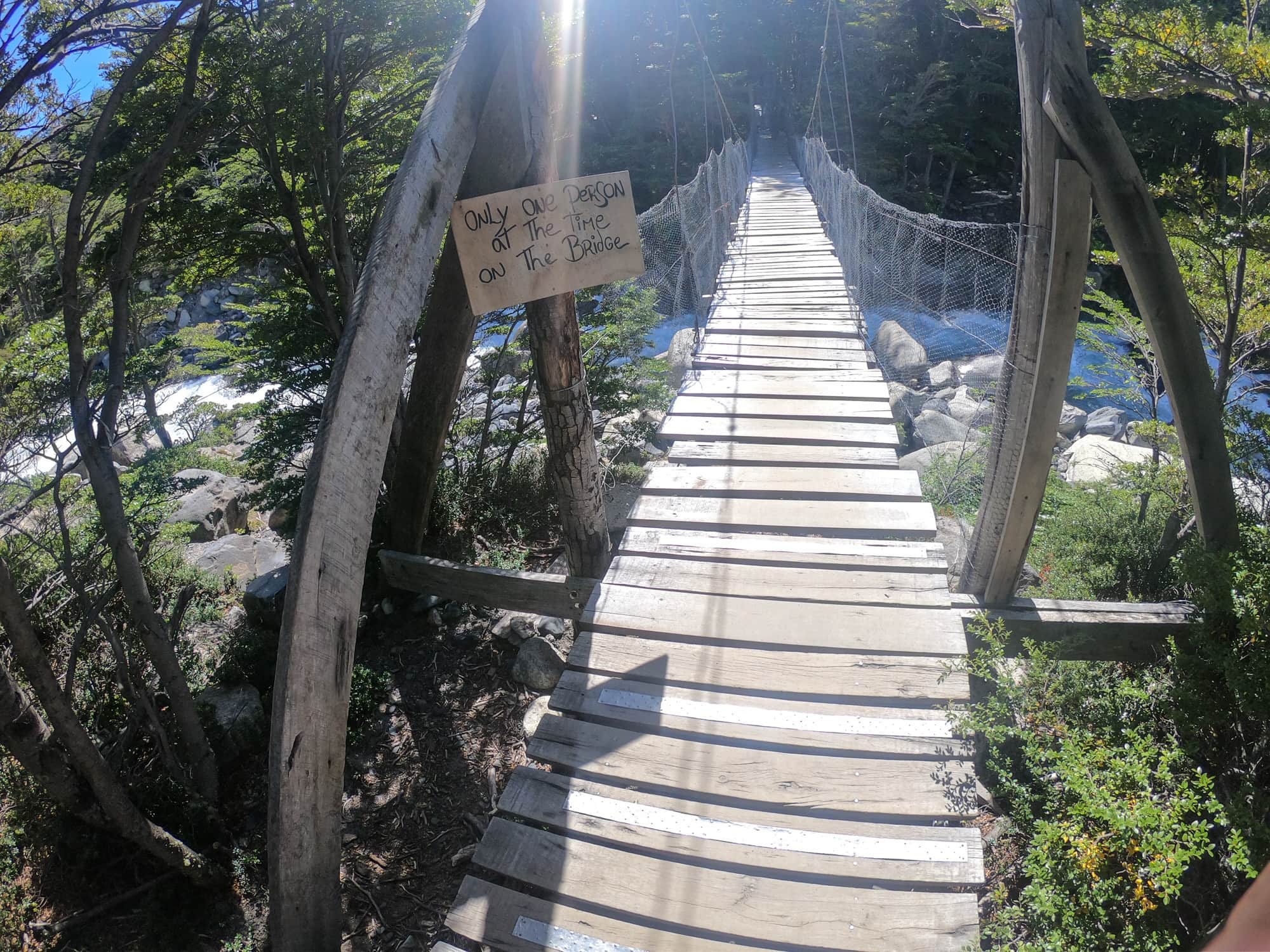
Best Time to Hike the W Trek
The W Trek can be hiked year-round (including winter with a guide). The busy season is December through late March. This is the warmest time of year, but also when you’ll experience the strongest winds. April is Patagonia’s fall with beautiful bursts of colors, while November is Spring when you’ll encounter wildflower blooms. No matter when you go, you should always be prepared for crazy weather.

What Gear do you need to hike the W Trek?
I wrote up a detailed W Trek gear list that you can check out here.
On our tour, G Adventures provided sleeping bags, tents, and sleeping pads. The tents and pads were already set up at each site so all we had to do was unpack our sleeping bag. We were given a small dry bag for all of our clothes and personal belongings for camping. Both that and our sleeping bag were put in the dry bag and transported for us each day to the next campsite. All we had to carry was lunch, water, camera, and extra layers in our day packs.
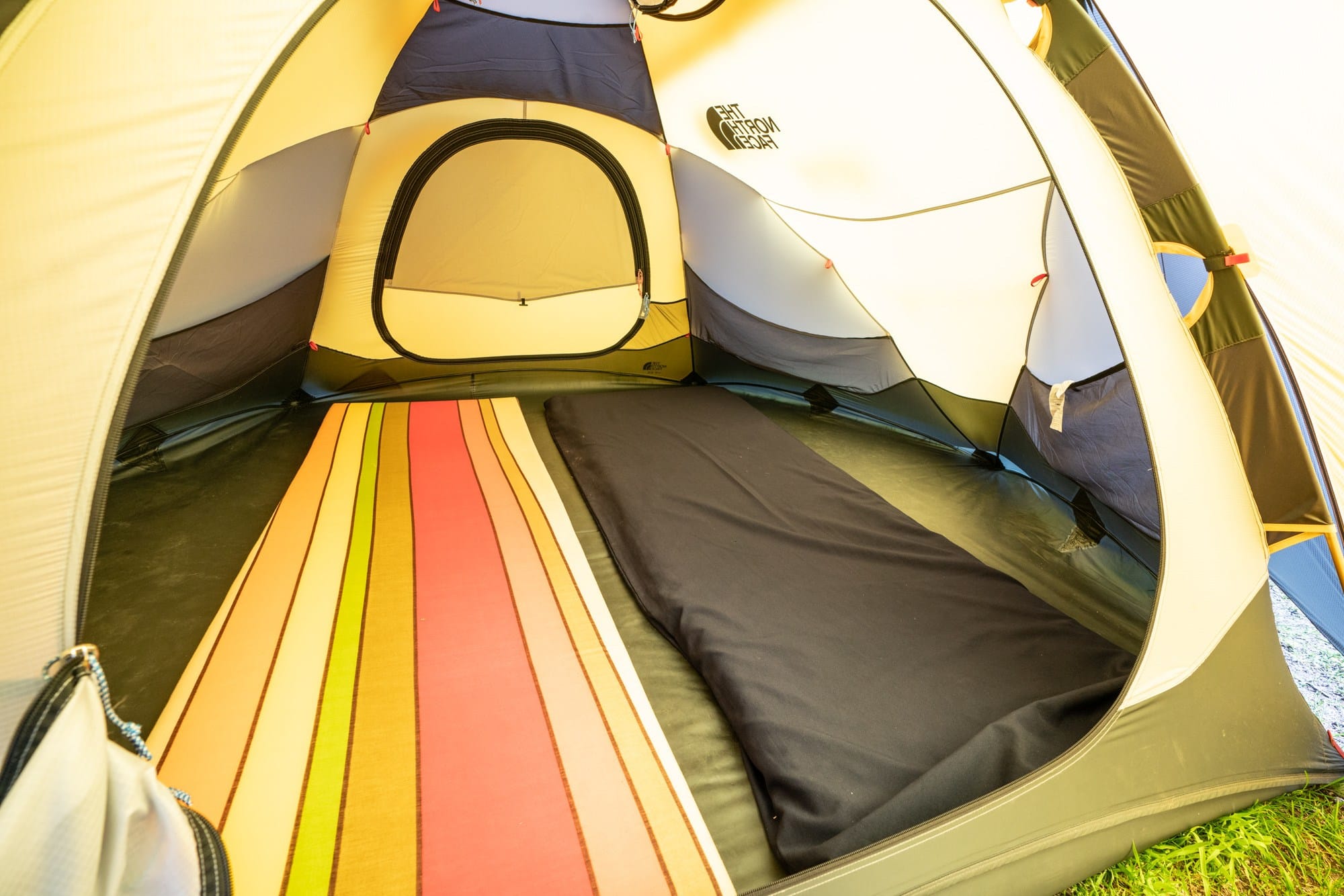
If you are hiking independently and need to carry all of your own gear, make sure you bring a backpacking pack that you’ve worn before. Since the summer season in Patagonia is known for the high winds, a rain cover might be ineffective in wet conditions, so in rainy condition, line your pack with a trash bag and then pack all of your stuff in that. Your tent also needs to be very solid and bring plenty of guy lines and stakes to secure your tent in high winds.
Aside from the windy conditions, it was hotter than I expected and I wish I had brought shorts. Pack layers with everything from warm to cold layers so you’re prepared for any kind of weather.
A half-buff is also helpful. A trick we learned from our guides is to use the buff as a headband over your hat so it prevents your hat from flying off in the wind.
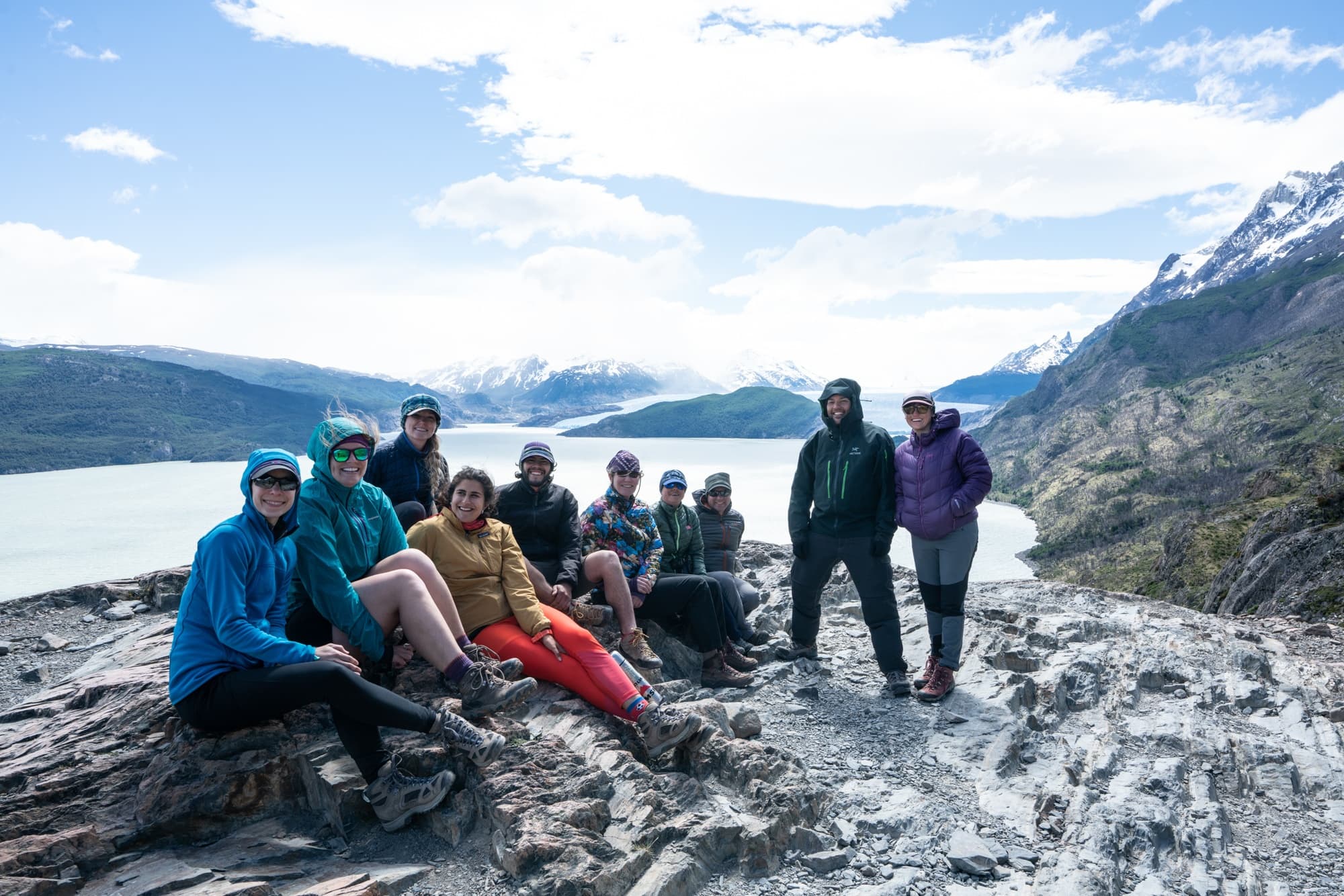
In addition to the clothing, I’d recommend bringing a portable water purifier, like a Steripen or a Grayl water bottle. I did drink unfiltered tap water and water right out of streams, but I’d bring a purifier just to be safe.
If you want to eliminate the need for heavier camping gear, the Refugios also offer rooms for rent.
My W Trek Itinerary
What direction should you hike the w trek.
On our trip, we hiked the W Trek a little out of order (roughly from East to West) which was due to the way G Adventures arranged for our bags to be transported. On Day One , we hiked out and back to the base of the Towers (the famous spiraling granite towers) so the bags could stay put. The second day , we took a ferry to Refugio Paine Grande, dropped our bags, and hiked another out and back to Gray Glacier.
On Day Three our bags were transported by boat, while we hiked from Refugio Paine Grande to the French Valley, ending at Refugio Los Cuernos.
On Day 4 , our bags were transported by horseback to our finish line back at the Base of the Towers trailhead.
Although we did hike the W Trek in a slightly different sequence, it seemed a little easier than the opposite direction. I liked that we hiked the busiest day first because every day after that got less and less busy. That said, there are many different ways to hike it, so get familiar with the map and different locations. If you go independently, it’s important to understand that your itinerary may be determined by campsite availability.

How many days do you need to hike the W Trek?
We hiked the W Trek in four days and three nights . The hike to the Towers and the French valley were pretty long days, but the other two were fairly mellow and I thought the days were planned well.
Some people take five days and take a boat out to Gray Glacier Refuge and start there. Taking 5 full days would also allow you to take a little more time and hike farther up into the French Valley.
Is it worth purchasing meals at the refugios on the W Trek?
Meals may seem expensive but remember that you are in the middle of nowhere and getting your meals through the refugios means you don’t have to carry four to five days worth of food on your back.
We were given lunch boxes each day by the refugios which consisted of a large chicken salad sandwich, cookies, fruit, trail mix and a piece of chocolate. Plenty of food to energize you for the day. Overall, I thought dinners at the refugio were better than the breakfasts which matters since you can purchase meals ala carte.
To give you an idea of prices independent travelers paid at the time of my hike:
- Refugio Paine Grande: $55 US for dinner, breakfast, and a boxed lunch (not including accomodations or camping)
- Refugio Los Cuernos: $80 US for dinner, breakfast and a boxed lunch / $115 US for a fully equipped campsite (with a tent, bag, and pad rental) and all meals
- Nash Patagonia Lodge: $29 for dinner / $112 for a fully equipped campsite and all meals
Note that Patagonia is very remote, lodging and food options are limited, and prices reflect that.
Day 1 – Hiking to the Base of the Towers (12 miles)
This is a very busy trail so be prepared for crowds and a steep uphill climb. At times the congestion made it feel like Disneyland, as a line formed hiking up the mountain. The lake was beautiful but this was honestly my least favorite day of the hike due to the crowds. We hiked on Sunday, so maybe it’s less busy mid-week?
Once you’re about 30 minutes from the trailhead, the trail starts climbing and doesn’t really quit. Make sure you pack plenty of water, as there isn’t a place to fill up until you reach a river crossing at Refugio y Camping El Chileno.
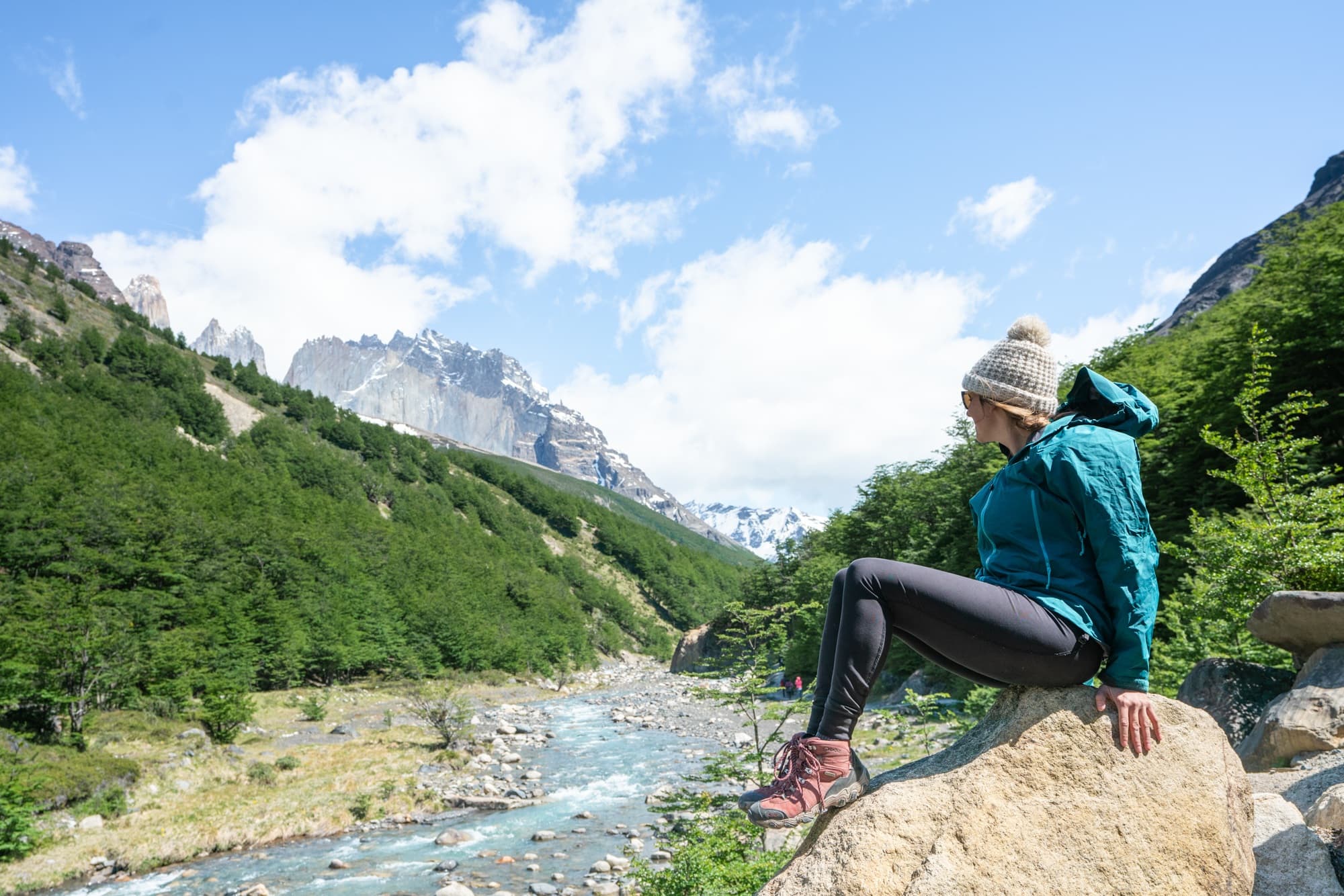
I will say that the lake is one of the prettiest lakes I’ve ever seen. Just set your expectations for crowds, or get a very early start to try and beat them. If you are doing the trek independently you could try to get a camping spot at the refugio which would allow you to hike to the base of the towers for sunrise.
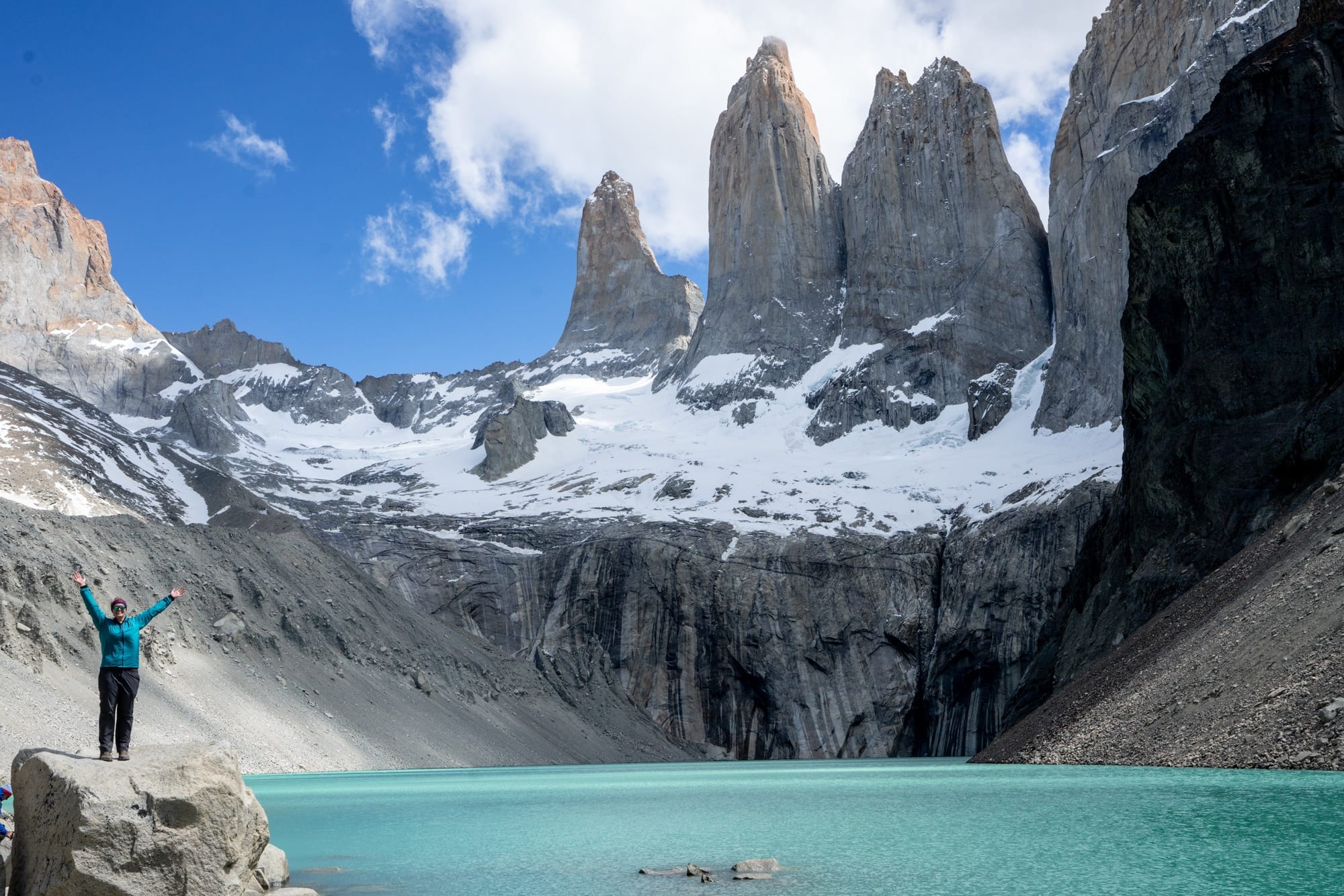
Camping Night 1
G Adventures booked out an entire campsite on the Serrano River called Nash Patagonia that we stayed on the first night. The campsite is just on the outskirts of the park with the friendliest staff of all of the refugios we stayed at. The drive to that campsite, while it may look long on the map, took only an hour and a half and was absolutely gorgeous. The drive was a way to get a feel for other parts of the park. The campground only had one other G Adventures group so it was very quiet with gorgeous views. We had a tasty group dinner with braised beef and vegetables.
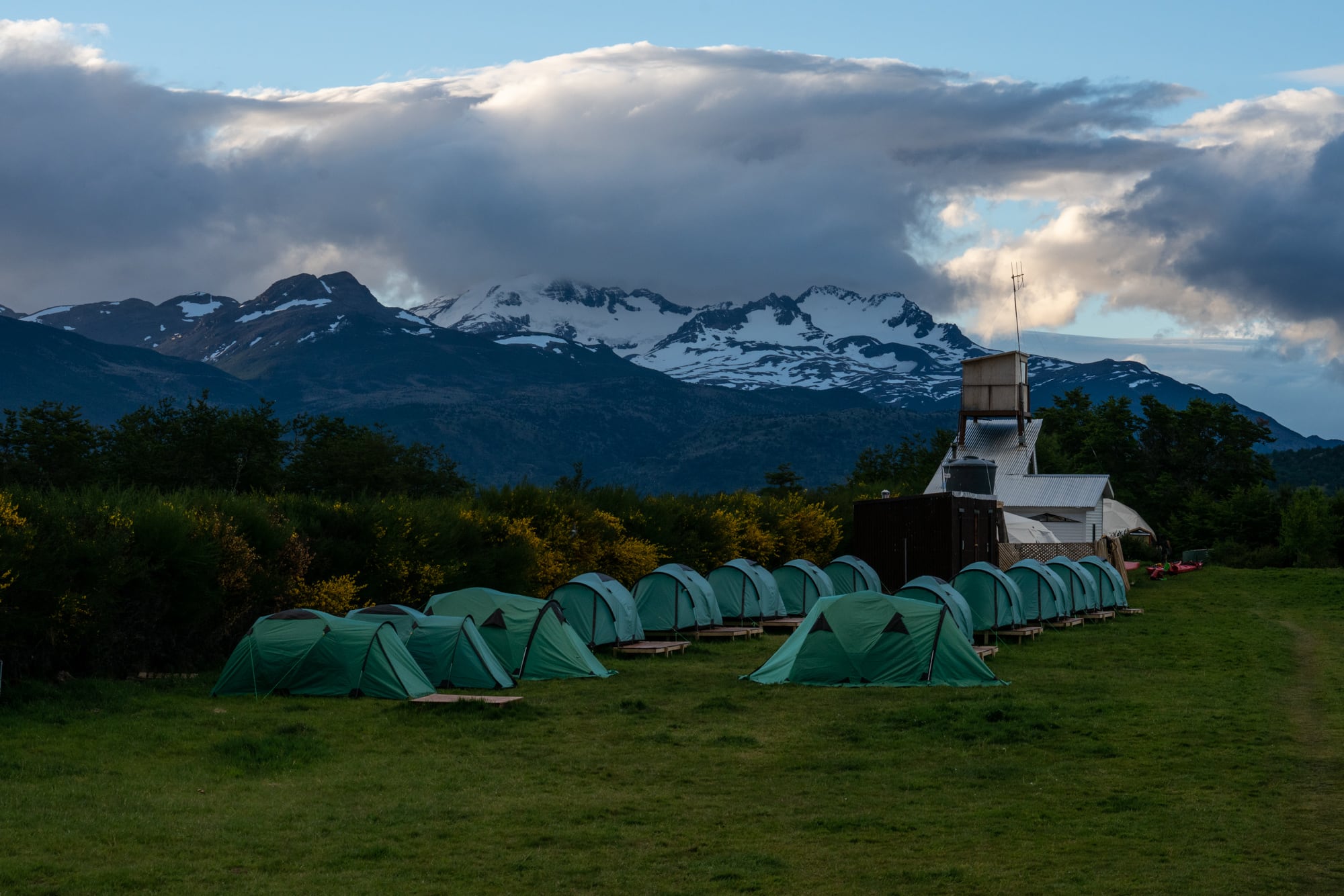
Day 2 – Refugio Paine Grande to Grey Glacier Overlook and back (7 miles)
The next morning we drove back into the park and took the 30-minute catamaran ferry across Lago Pehoe where we arrived at Refugio Paine Grande . On the G Adventures tour, our guide had reserved tents and sleeping pads that were already set up and waiting for us at each campsite. That way it was less for us to lug around on the hike.
Day 2 to the Grey Glacier was a much more mellow hike than Day 1 that takes you over a ridge, past a Laguna Los Patos), and around the shoreline of Lago Grey. Eventually, it reaches a lookout with beautiful views of the Gray Glacier. If you want to get closer, you can keep walking all the way to Refugio Gray, which ends up being 13 miles round trip from Refugio Paine Grande.
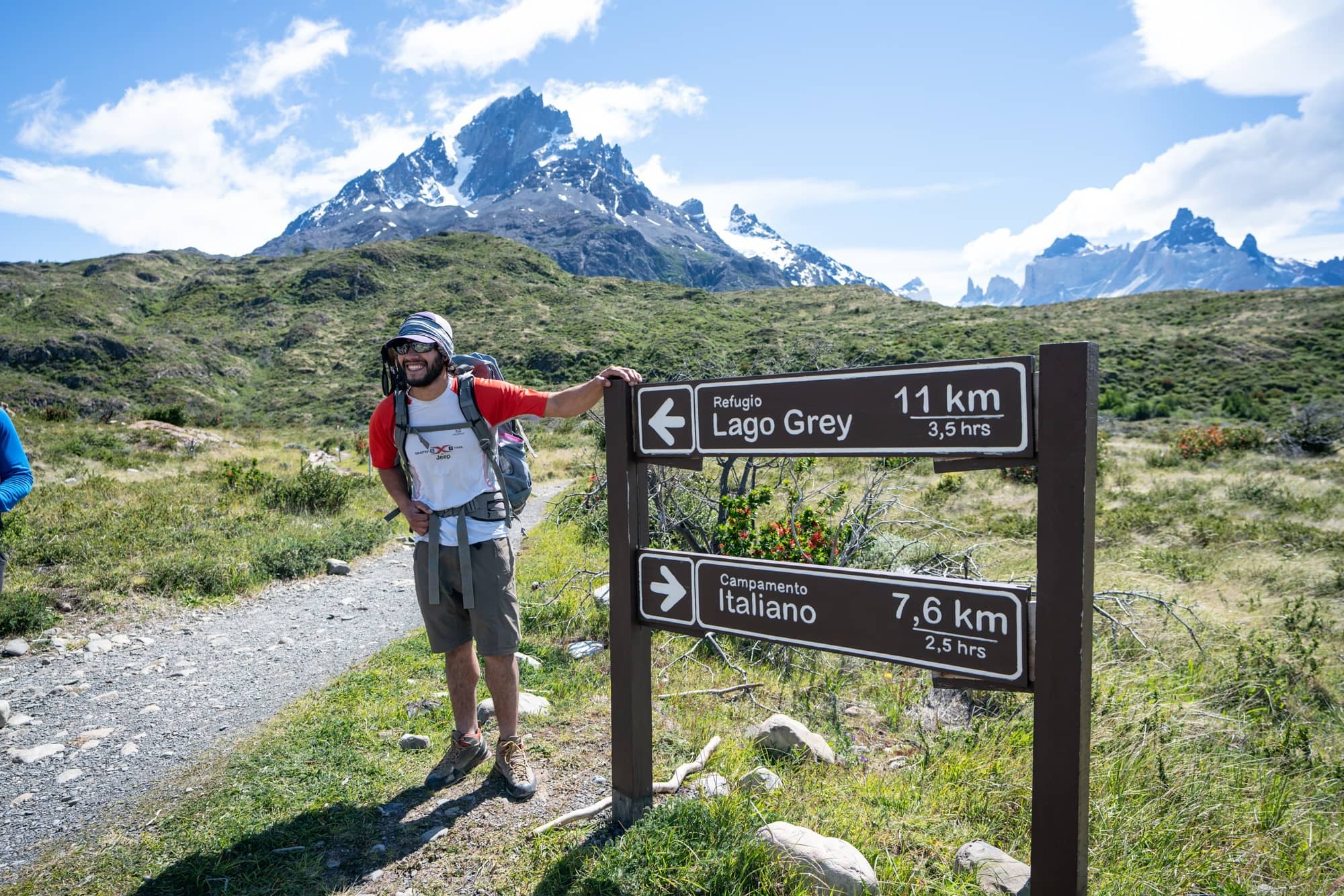
You’ll note from the map that on day two that we didn’t hike all the way to the Gray Glacier and only went to the lookout. I was satisfied, but I do think with a quicker pace, it would have been possible to hike all the way to the Gray Glacier and back. Alternatively, you can also arrange to take a boat to Refugio Gray and start your W Trek hike from there.
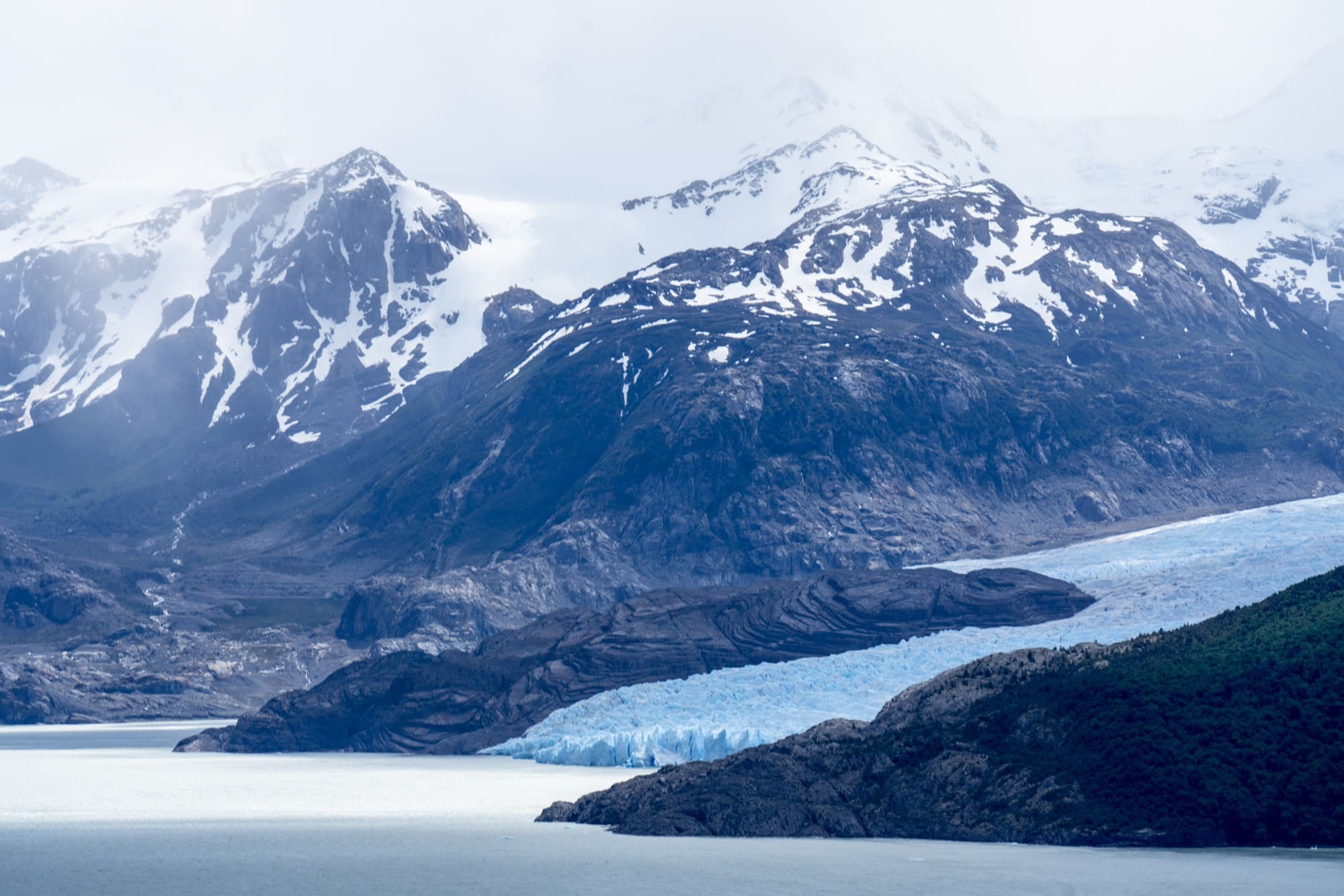
Camping Night 2
We stayed at the Refugio Paine Grande where there were hundreds of people camping and gorgeous views. Dinner is served cafeteria-style and was my least favorite food of the W Trek. Dinner times are assigned so you should get in line a little early. Good news is that you can cook your own food in a separate cabin if you want to bring your own food. There’s also a bar upstairs with beer and place to hang out. Hot showers were available at certain times of the evening.
Day 3 – Paine Grande to the French Valley to Refugio Los Cuernos (11.5 miles)
On our third day of hiking the W Trek, the views from the trail were non-stop. First, you pass Lake Skottsberg, and there are a few different rocky outcrops that make for a good snack break.
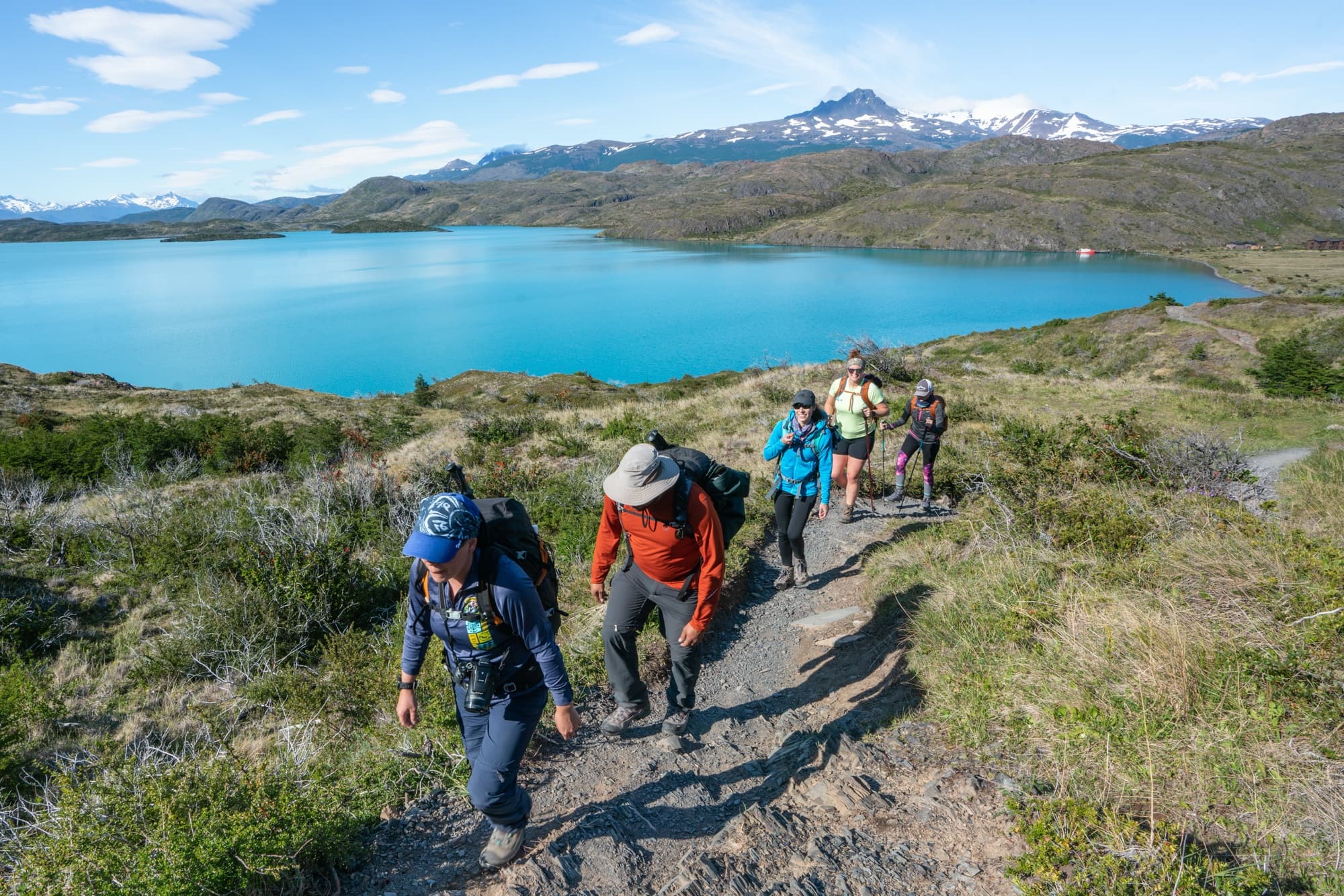
Next, you’ll hike through a burn area and eventually arrive at the Italiano campsite. Here you hang a left and start hiking up towards French valley. This is steep but didn’t feel as steep as the Base of the Towers hike and also had the bonus of way less people. The French Valley offered my favorite views from our entire time hiking the W Trek, and just past the main overlook, there is a nice lunch spot on the river where you can watch avalanches breaking off the glacier. You are also right under the Horn which is one of the famous peaks in Torres Del Paine.

On day 3, we only hiked to the French Valley (Mirador Frances) lookout but the trail continues quite a bit farther back to the Mirador Britanica. Our guides told us this was very difficult, and we still had 2 hours of hiking once we got back down to the Italiano campsite to reach Refugio Los Cuernos where we would be camping.
If you want to hike all the way to Mirador Britanica, you should consider starting or ending at the Italiano campsite and get a very early start. We heard this is one of the most beautiful and isolated areas of the park and would probably recommend five full days for the W Trek if you want to go to the very back of the valley.
Camping Night 3
This campsite was the Refugio Los Cuernos and also my favorite campsite. The refugio is located right underneath the Horn and had a beautiful beach with a great place to enjoy a beer from the bar. Luckily, there were clean, hot showers to boot. The dinner here was also my favorite spot. On the menu there was a hot soup, bread, braised beef with mashed potatoes, and a dessert.
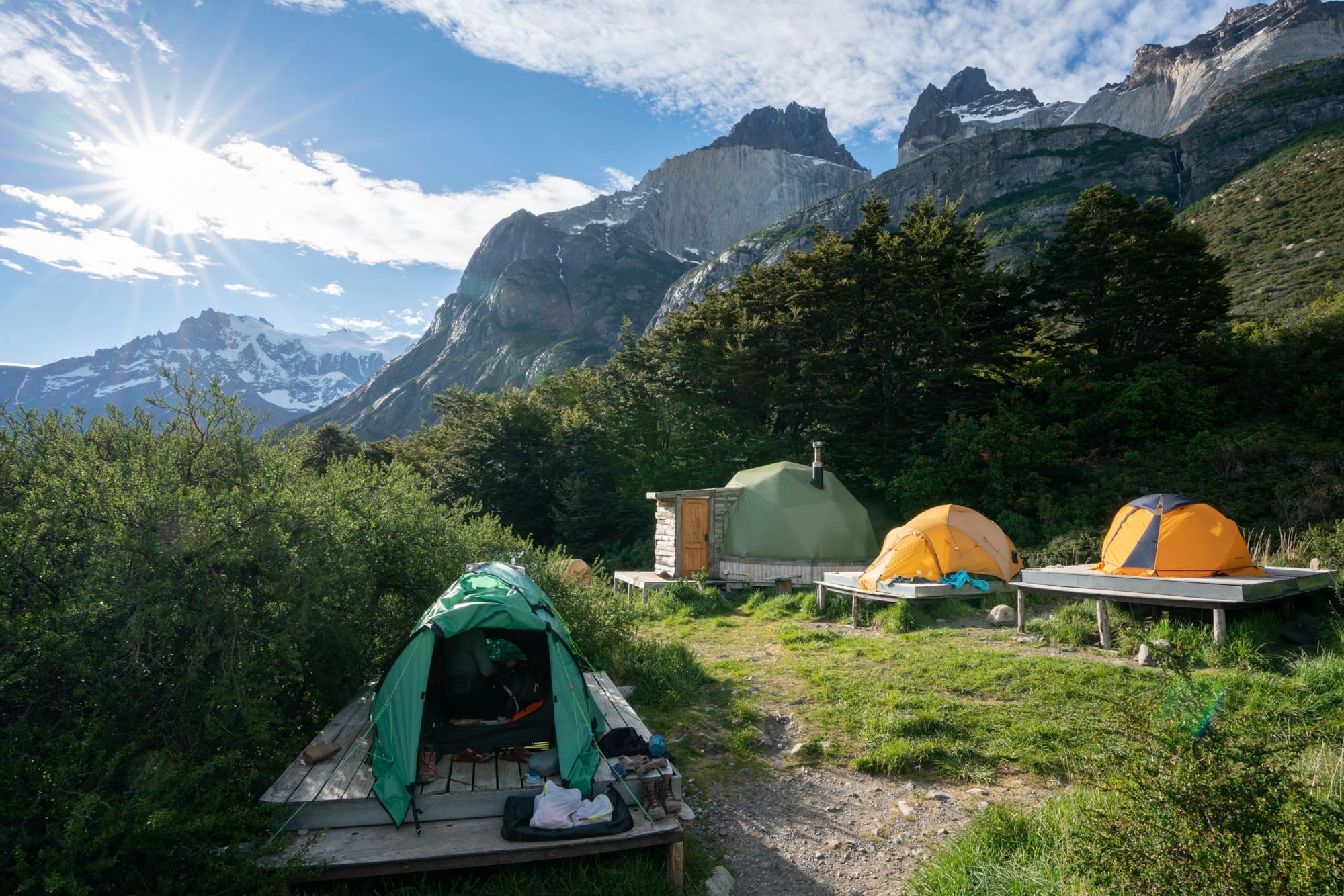
Day 4 – Refugio Los Cuernos to Hosteria Los Torres and back to Puerto Natales (7.5 miles)
This was a mellow morning and breakfast consisted of toast, eggs and coffee. Our day was fairly short so we were able to take our time and enjoy the scenery. There were lots of beautiful flowers in bloom and we hiked along Lake Nordernskjold the entire day so we had non-stop views. In total, it took us about four hours.

Since we had a shorter day on the trail, we stopped at the last spot with a view of the lake, where we enjoyed lunch and some mate tea.

When we got back to our Day 1 starting point, our driver was waiting for us at the end to take us back to Puerto Natales where we grabbed pizza with our guides at the basecamp.
What questions do you have about hiking the W Trek in Torres Del Paine? Leave us a comment below!

With two decades of hiking and seven years of van life under her belt, Kristen has dedicated her life to helping people experience the positive effects of nature. As a pioneer in the outdoor blogging space, she founded Bearfoot Theory in 2014 and has since authored more than 350 blog posts about outdoor travel, hiking, camping, and van life. Her work has been featured in National Geographic, Outside Magazine, and Backpacker, and when she’s not on the road, she lives in Park City, Utah with her partner Ryan, their son, and two adventure pups.
Leave a Reply Cancel reply
Your email address will not be published. Required fields are marked *
Save my name, email, and website in this browser for the next time I comment.
Awesome post. I appreciate your time and effort in your work. Keep posting..
Hi Kristen,
Thank you for your blog. I’m curious, when did you hike the W Trek? I have booked campsites for the second week in March and am hoping for some early Fall foliage on our visit.
Hi Rachel – Kristen hiked the W trek in November which is spring in Patagonia. I realize that you may have had to change your travel plans, but when you do make it to Patagonia, Fall begins in mid-late March so you just might catch some of that early Fall foliage you’re looking for if you go that time of year. Best of luck!
I’m looking for a guide to go with a small group in December 2021. Recommendations? Thanks!
There are a lot of great tour operators in Patagonia. Kristen’s group trip was with G-Adventures and she had a great experience. You can read more about it here: https://bearfoottheory.com/g-adventures-review-hiking-patagonia-in-depth/

- Best Hikes In The World
- Appalachian Trail
- European Hikes
- Nepal Hikes
- Patagonia Hikes
- See All Hikes
- Mount Kenya
- Mount Kilimanjaro
- Mount Toubkal
- See All Mountains
- South Africa
- New Zealand
- Switzerland
- United Kingdom
- Packing Lists
W Trek Patagonia – Guide To The Most Popular Hike In Torres Del Paine
Chile , Hikes , Patagonia , South & Central America
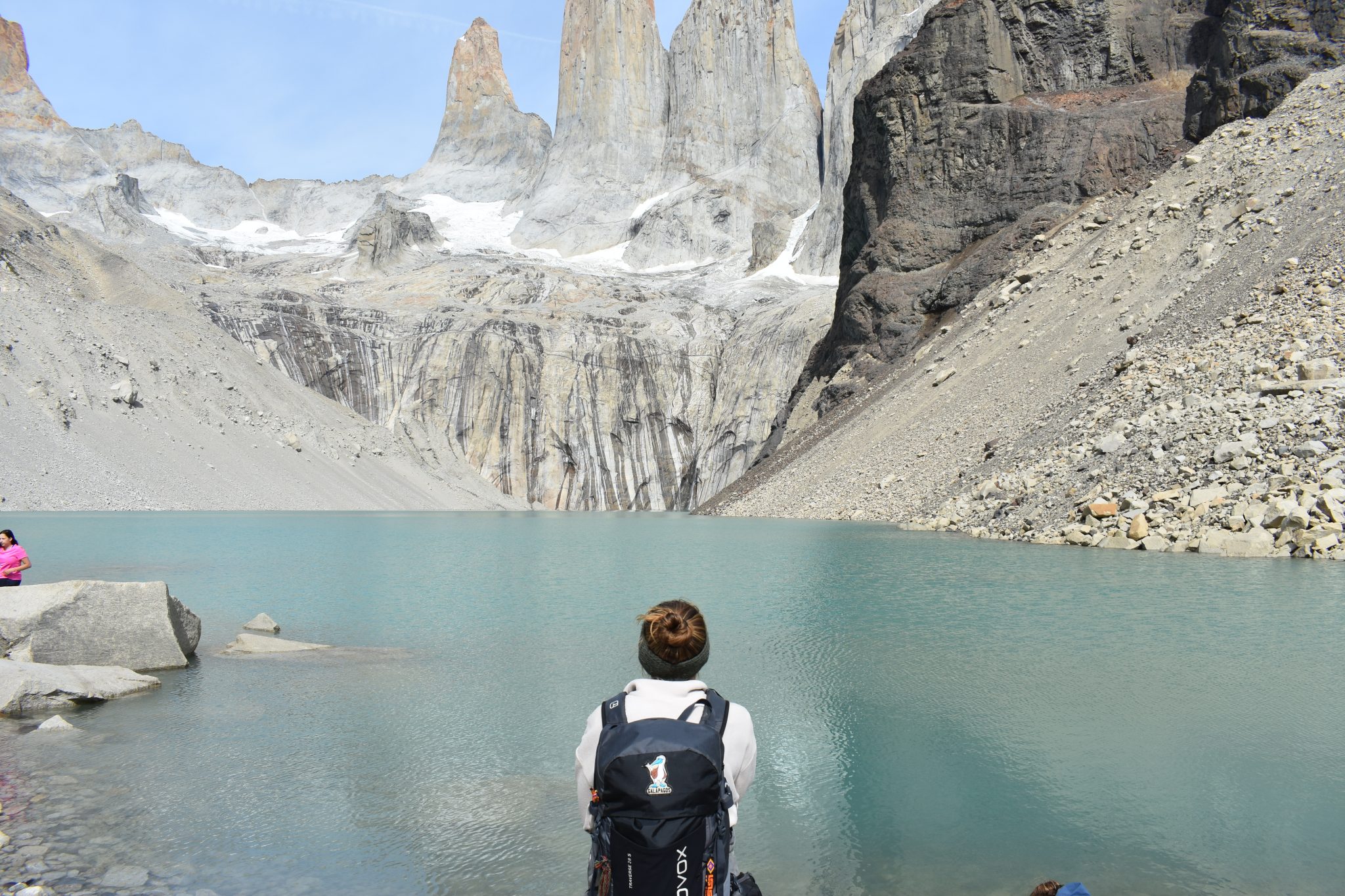
The Torres Del Paine W Trek in Patagonia is a 5-day, 100km adventure that brings you to some of the best features of Torres Del Paine. Visit Grey Glacier, the base of the Towers, the French Valley, and much more on this epic trek.
In this comprehensive guide, I'll go through everything you need to know about planning for and hiking this trail. I’ve also thrown in some up-to-date tips and links for booking campsites in Torres Del Paine.
Get ready to embark on the trail of a lifetime!
Why Hike The Patagonia W Trek?
See the highlights of torres del paine.
One of the main reasons why the W Trek in Patagonia is so popular is the stunning scenery that hikers encounter along the way. The route takes visitors past the park’s most popular features. See the granite spires of Torres del Paine, the turquoise waters of Grey Lake, and the vast glaciers that dominate the landscape.
An Accessible Trail If You Have Limited Time
Another reason why the W Trek in Patagonia is so popular is its accessibility. Unlike many other remote treks in Patagonia, the W Trek is relatively easy to reach and can be completed in a week or less. This is great if your Patagonian backpacking trip has a time limit.
Additionally, the W Trek offers several options for accommodations, from camping to refugios (mountain huts), making it accessible to a wide range of budgets and experience levels.
W Trek Patagonia- Know Before You Go
W trek in patagonia- location.
The Torres Del Paine W Trek is situated in Chile near the southern tip of South America. The park itself is located 112 km north of Puerto Natales and 312 km north of Punta Arenas.
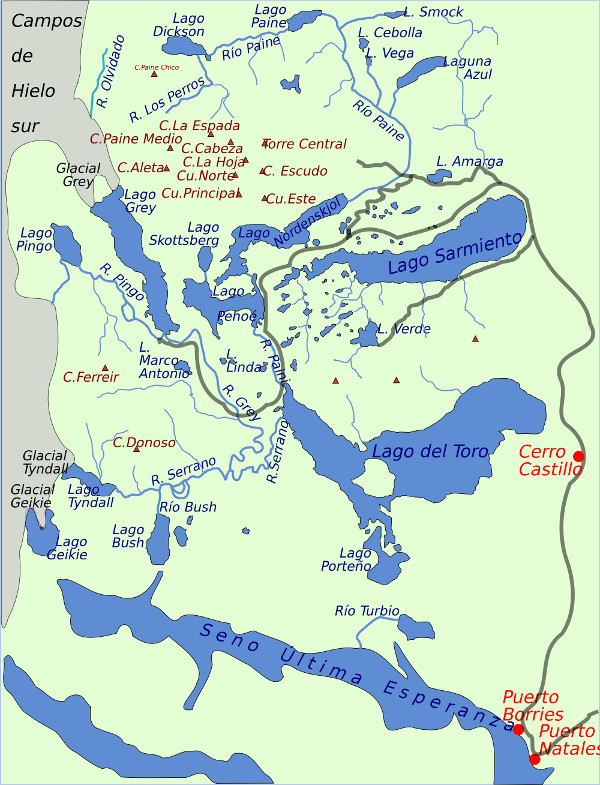
When is the best time to trek the W Hike Patagonia?
To highlight the pros and cons of each season, we have written a brief description of each below.
It’s worth also reading our articles on the best time to trek in Patagonia and, more specifically, when to hike in Torres Del Paine .
Spring - September to November
This is the perfect time of year to visit the park if you're wanting to experience warm, clear weather but without the huge crowds. Although not as warm as the summer months, the skies are often clear and you will get incredible views across the park. This is also the best season to see flowering flora in the region and witness the breeding season for wildlife.
Summer - December to March
This is the high season at Torres del Paine national park . Although the trails in Torres Del Paine are at their busiest, the weather is at its warmest. You'll get the maximum amount of clear days on your trek at this time of year. If you're the active type, then summer is also the period when you can horse ride, kayak, and mountain bike alongside your trek!
Fall - March to June
My favorite season without a doubt. The landscape becomes ablaze with color as the trails start to empty out and days become colder. The wind is often ferocious, but the spectacularly beautiful views are worth it!
Winter - June to August
Between May- September, self-guided hiking is not permitted in Torres Del Paine. Over this period, you can only hike Patagonia W Trek with a guide.
The major benefit of this season is that it is the quietest. There will be very few other visitors and you'll have many of the trails to yourself. This is the coldest period though and you will certainly experience cold nights and high, cold winds.
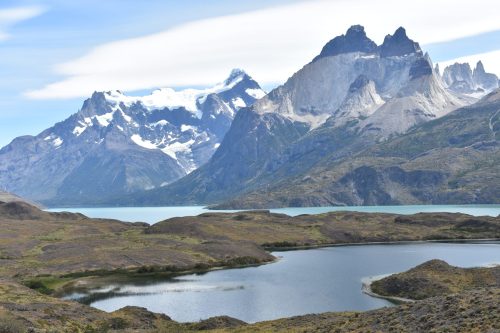
Torres Del Paine National Park
How Difficult Is Patagonia’s W Trek?
The Torres Del Paine W Trek is considered to be an easy multi-day trek as the elevation remains fairly steady throughout the hike. There is also the added benefit that the trek can be done over a longer or shorter period depending on your fitness levels.
Although regarded as easy, the trek still requires a solid level of fitness as you will be trekking a total of 100km/ 62 miles. This is 10-20km per day depending how many nights you camp out.
Hikers generally stay at the same elevation and certainly never go high enough for altitude sickness to become an issue.
The trails are well-defined and you’ll find signposts dotted along the trails at regular intervals. Water is available at all campsites, as is food. Ranger stations are dotted along the trail and you’ll most likely be among other trekkers (depending on when you trek).
Be careful though, storms are frequent in Patagonia and the wind can get extremely cold and strong. Always check weather forecasts before your day of trekking as the John Gardner Pass is often closed due to high winds.
Are Permits Required for The W Trek in Patagonia?
Yes, a permit is needed to enter the park. Permits cost $49 for more than three days. You need to book tickets online at least 24hrs before you visit.
You can print the permit or show it to officials on your phone. The park officials will need to see proof that you have booked your camping ground accommodation in advance.
Accommodation And Food On The W-Hike Patagonia
There are 11 campsites in the park which are run by three different companies. Currently, you can book campsites through Vertice Patagonia and Las Torres . Campsites cost between $10-$25 (Site only). Both companies also have the option to rent camping gear.
As well as tents, there is also options to stay in dormitories, cabins, and refugios. You can book these with the same companies mentioned above. I suggest using only one company to book your entire trek, for simplicity's sake.
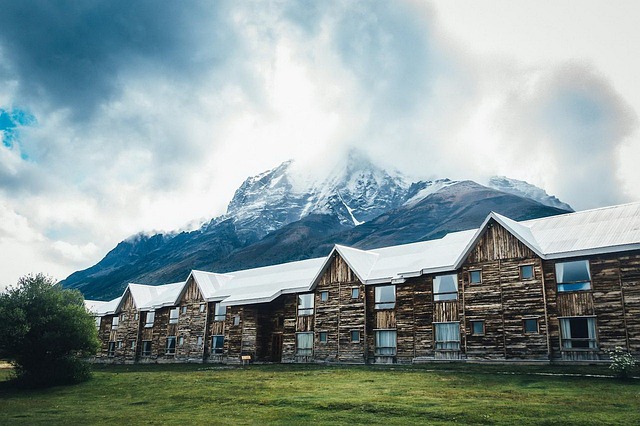
Hotel In Torres Del Paine National Park
At the camps, you will find bathrooms, shops, and even small restaurants. You may need to pre-order your meal so check beforehand.
Note: As of 2022/2023, the free CONAF campsites (El Paso and Italiano) are not available. It is unclear when and if these will re-open. It’s better to budget in paying for all your sites. If this has changed, please drop us a comment.
How Far In Advance Should You Book The W Trek, Patagonia?
Torres Del Paine treks are not something you can decide to do last minute. I’ve seen a friend break a sweat over finding campsites when she already had flights to Punta Arenas booked. This was a whole three months before her hike in November! To be safe, I’d say you should plan and book your trip at least six months in advance. Maybe even more if you plan on hiking the W Trek in the peak season (December-March)
Since 2016, the amount of people who can hike the W Trail is 80 persons per day. Visitors must reserve a place if trekking solo without an operator and you’ll need to take the trail in a counterclockwise direction.
How Do You Get To Torres Del Paine And The Start Of Patagonias W Trek?
Visitors can fly into Punta Arenas, Chile, or El Calafate, Argentina. From either of these towns. You can then take a bus to Puerto Natales.
The bus ride from Punta Arenas to Puerto Natales takes three hours and costs between $20-$30 dollars.
Buses between El Calafate and Puerto Natales are quite a bit longer (around 5 hours). Tickets cost between $30-$40.
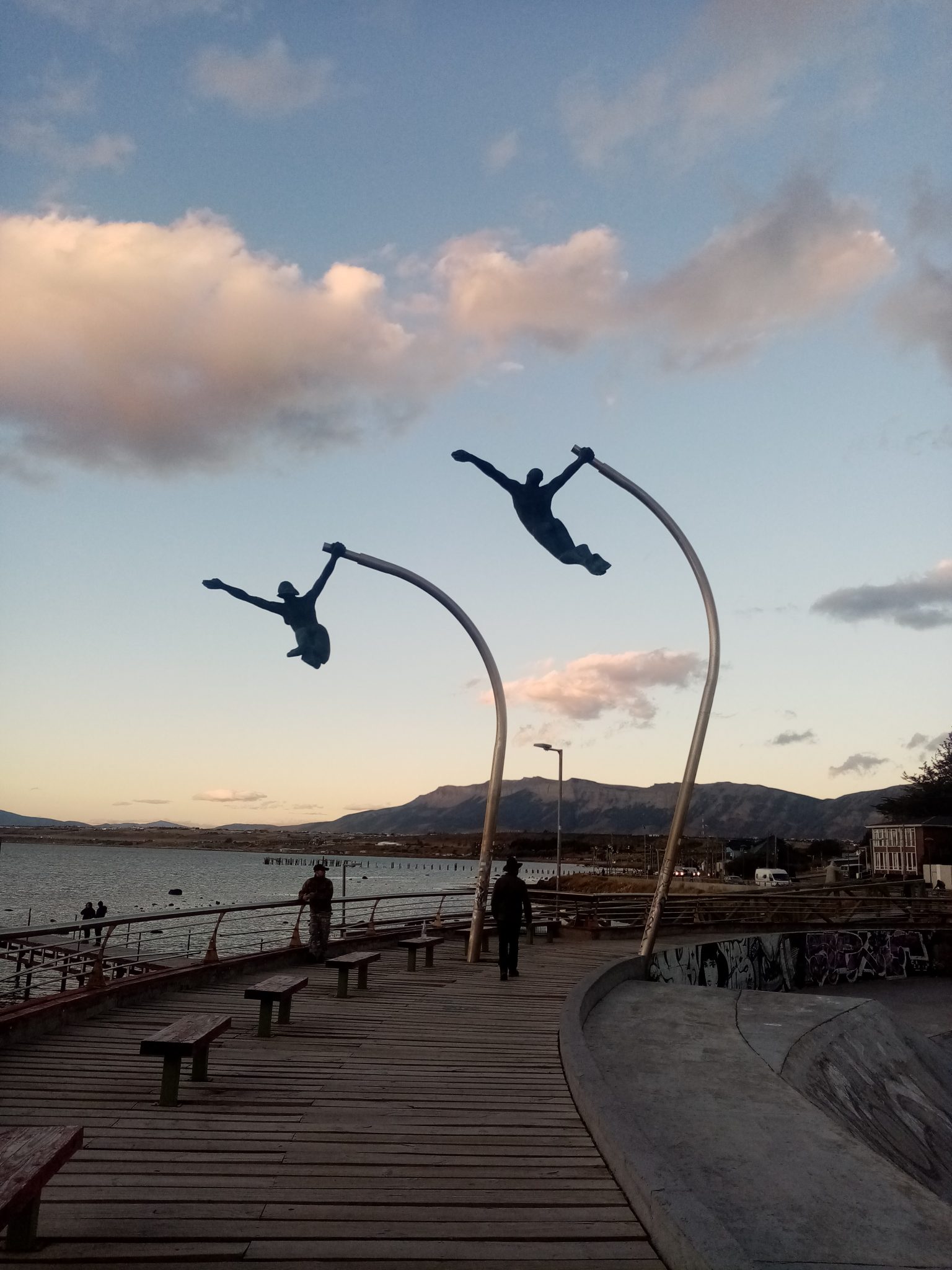
Its good to spend at least one night before the W Trek resting and exploring Puerto Natelensis
Daily buses run between the town of Puerto Natales to the entrance of Torres Del Paine. This ride will set you back $15-$15. If you have a higher budget, you could arrange a private transfer to the park and organize for the driver to pick you up after your trek.
How much does the W Trek Patagonia Cost?
The cost of a Torres Del Paine W Trek varies depending on when you book flights and when you trek (out-of-season tends to be a little cheaper). If you go with a trekking agency, local companies will be much cheaper than booking through an American or European operator. Trekking independently in Patagonia is always the most budget-friendly choice.
- Tour Agency: ~$500 for a cheap local agency to ~$2,000 for a pricey Western trekking agency
- Visa, Vaccinations, Insurance etc:~$300-$500
- Equipment (buying and hiring):~$500-$800 – camping gear can be rented at the park entrance for $200.
- Return flights to Punta Arenas: ~$1,500
- Tips: ~$10-20
- Misc (additional food, unplanned travel/hotels, etc): $50
Total costs with tour agency: $2,000 – $4,000 It is possible to plan an independent W trek for less than $300. This price includes food, park entrance, and camping (assuming you have your own equipment). Food can be purchased from refugios throughout the park, however, it is very expensive.
You may also like : Guide to Fitz Roy hikes
Hiking The W Trek Patagonia - Route Guide
The most popular trek in Patagonia , the Torres Del Paine W Trek is fast becoming one of the most well-respected short hikes in the world due to the trail's stunning scenery.
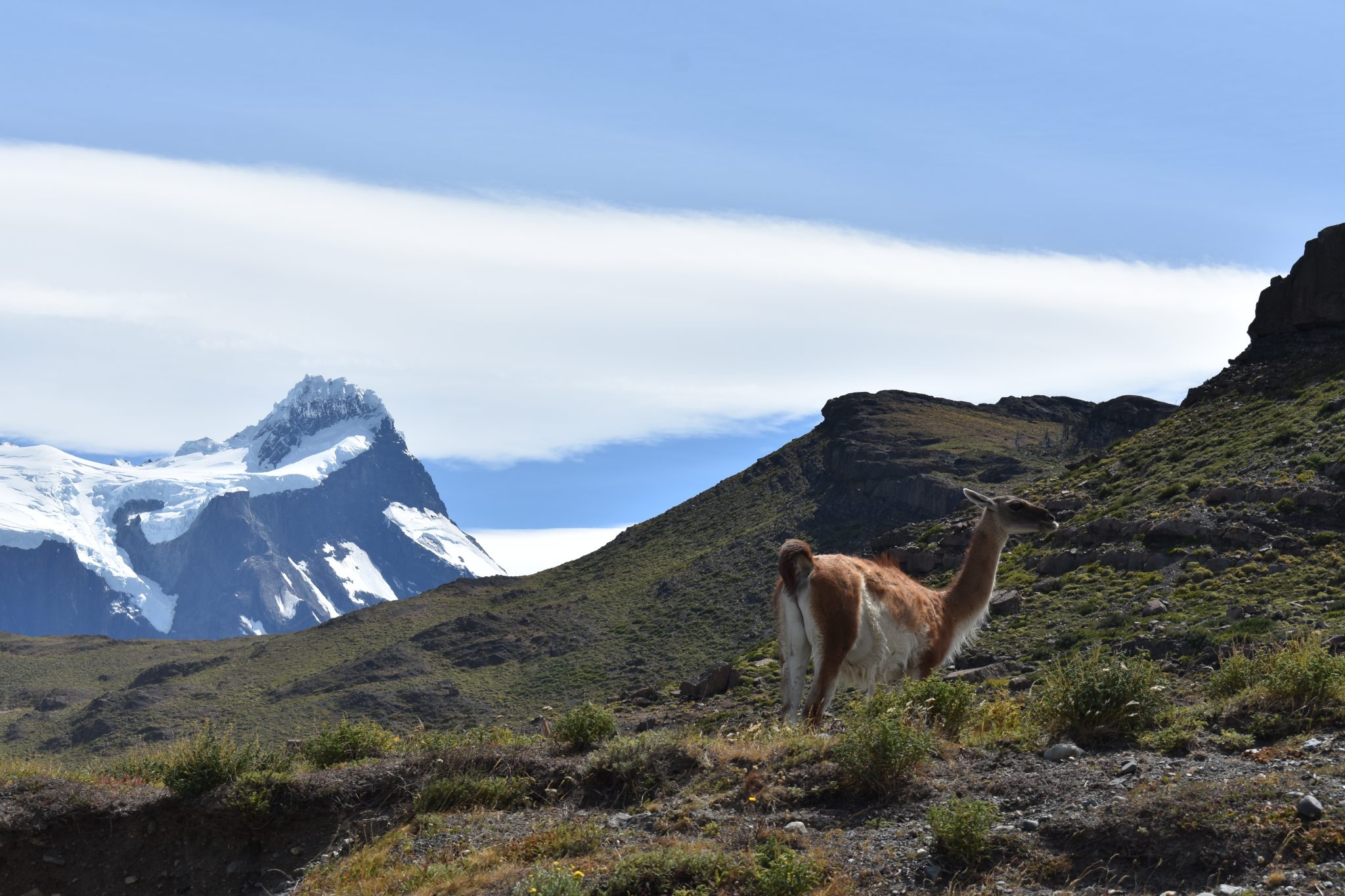
Guanaco in Torres Del Paine
Located in the amazing Torres del Paine National Park which was made a World Biosphere Reserve by UNESCO in 1978. The 100km trek generally takes around 5 days to complete. It takes visitors into the very heart of the park, through haunting forests, soaring mountains, and colossal glaciers.
Where does the W Hike Patagonia Start And End?
The trek begins with a lovely boat ride near the Grey Glacier and finishes with a magical sunrise at the famous Torres on the final morning. There is the option to do the longer full circuit O trek , however, most travelers opt for the shorter W Trek.
Patagonia W Trek - Day By Day Trail Information
Below is a standard, 5-day itinerary outline for your Torres Del Paine W Trek. This can vary depending on fitness levels, available camps, and routes. It should at least provide a good idea of what to expect. This is especially useful if you are trekking Patagonia independently .
Day 1: Puerto Natales to Refugio Grey (11km)
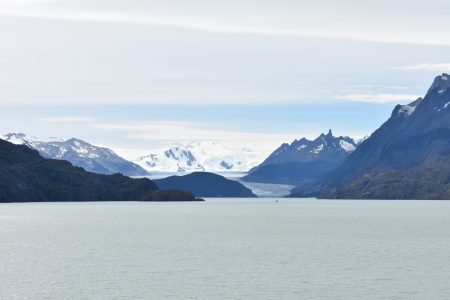
Grey Lake with Grey Glacier in the background, the start of the W Trek
Leave early from the town of Puerto Natales. Buses depart at 7:15, if you go with a tour or taxi, you will probably leave earlier.
Take your transportation Pudeto. This is the next stop after the park entrance.
If you have time, visit the local waterfall and take some pictures. You then take a lovely boat ride by catamaran to Paine Grande. After arriving you begin your trek in earnest with a 3-4 hour (uphill) hike along Lago Grey to Refugio Grey where you camp the night. If you have some energy after dinner, head down to the lake and feel the cold water!
Day 2: Grey Glacier to Paine Grande (19km)
Today you’ll be up early – around 8 am – to hike up to the former campsite of Paso. From the campsite, you take a small path to the lookout platform where you get stunning views across Grey Glacier.
After spending a little time appreciating the glacier, you have the option to continue the hike to Paso.
This is an uphill trek and will add extra mileage to your day. However, I’d recommend it as the trail is absolutely beautiful and gives incredible views all the way along the glacier.
After visiting Paso, return along the trail back down to where you camped the previous night.
After lunch, it is a 3-4 hour hike down to your next campsite at Paine Grande. If you can, find a campsite next to the hill so you’re not battered by the strong winds overnight.
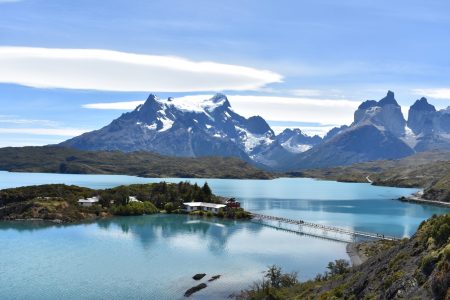
Refugio Paine Grande lies at the other side of Laguna Pehoe
Day 3: Valle del Frances to Los Cuernos (28km)
Today is a long one! Mentally prepare yourself for a full day of hiking. You begin your trek around 8am and hike for several hours until you reach camp.
At the camp, you should dump your large backpack at Campamento Italiano and head on up to Mirador Frances with your daypack. Take your lunch with you along with water and sunscreen.
The walk takes 2-3 hours and you should reach the Mirador around lunchtime.
After stopping to eat and explore the area, you’ll head back down to Campamento Italiano and retrieve your large backpack.
From there you head to your next campsite at Los Cuernos. This is roughly 2 hours walk away.
Day 4: Los Cuernos to Campamento Torres (20km)
This is the last full day of hiking on the circuit. After a leisurely breakfast, you should head off around 9 am towards Campamento Chileno.
Your trek begins on flat ground as you make your way along the Lago Nordernskjöld. After a few hours, you’ll come to a sign saying “shortcut to Chileno”.
Take the shortcut and walk for several hours until you reach the Refugio Chileno. Have lunch here before continuing on.
After lunch, you will walk uphill for an hour or so until you reach Campamento Torres. Leave your large backpacks here and head upwards for 45 minutes until you reach the Torres! Take a well-deserved break and soak in this iconic view.
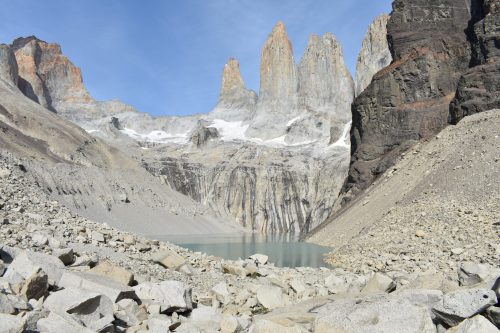
A steep climb up is rewarded with this view of the Iconic Las Torres granite spires
Back at the Refugio, make sure you hit the sack early. You’ll need to be up before sunrise the following day!
Day 5: Torres to Puerto Natales (10-15km)
Don’t sleep in on Day 5! You’ll want to rise early (around 5 am) to get the sunrise views at the mirador of the Towers. Sunrise happens around 6 am in summer and there is just a short walk to the viewing and picnic area. If you’re lucky with the weather, you’ll get an incredible view and witness one of the most beautiful sunrises on our planet! If it’s raining in camp, do not give up – the weather is frequently very different up near the viewing area and the weather can clear fast. It’s worth taking a chance. After your sunrise moment, head back down to camp and pack up all your gear. From camp, you will head down to the Hotel Las Torres. This walk takes roughly 3 hours. From the trail’s end, you can walk to the park entrance. The 7km/ 4.3 miles will take you around 1.5 - 2hrs. At this point, you will be exhausted and may prefer to take the 2 pm minibus to Laguna Amarga at the entrance. Its worth budgeting an extra $10 for this bus fee. The return bus to Puerto Natales leaves at 2:30 pm from the park entrance. Double-check bus times before you set off.
W Trek Patagonia Map
The best map I've found for the Torres Del Paine W Trek is the Torres del Paine Waterproof Trekking Map by Sergio Zagier. The map provides compressive satellite relief, contour lines, shelters, timed trails, camping, and inns.
Other W Trek FAQs
Is altitude sickness a risk on the w trek.
There is essentially zero risk of altitude sickness on the Torres Del Paine Full W Trek. The highest point reached is under 700 meters which is far too low to bring on altitude sickness. See our guide on altitude sickness .
What W Trek guidebook do you recommend?
The one guidebook that stands above all others is Trekking Torres del Paine: Chile’s Premier National Park and Argentina’s Los Glaciares National Park by Rudolf Abraham. The guidebook covers eight major trails within the park including the Full Circuit and the ‘W’ Trek. Maps, tips, and detailed information is provided for each trek and the book is a must for trekkers hiking solo.
What gear do you need for the W hike?
Trekking the W requires a certain amount of essential pieces of trekking clothing and equipment.
Many pieces of equipment including tents, sleeping bags, and mats, can be rented at the campsites. However, rental prices are high. We recommend bringing the most important pieces of gear with you.
To help you plan and prepare for your trek we have written a detailed hiking gear list .
About the author
Alison Macallister
With a degree in Nature Conservation and experience working with wildlife including the Big 5, Alison used to work as a guide for a 5-star safari reserve in South Africa. Today she is a full time traveller and editor for Mountain IQ. She has travelled and hiked extensively in South America, including many solo hikes in Patagonia, the Cusco region of Peru, Ecuador and Chile.
Leave a Reply
Your email address will not be published. Required fields are marked
We work with local guides to offer great value adventures at unbeatable prices

27 Things I Wish I Knew Before Doing The W Trek Self Guided Tour [2024]
If you plan on doing the W trek self guided, you’ve come to the right place!
While this multi-day hike in Torres Del Paine is one of the best hiking trails in the world, it’s also one that involves the most pre-planning – especially if you’re hiking the W without a tour.
If that’s the case, you’re probably wondering:
How do I book campsites? And what if there’s no availability?
What W Trek self guided itinerary should I follow?
Is it easier to book a tour instead?
I’ve answered all those questions (and a lot more) in this mega post on hiking the W Trek without a guide.
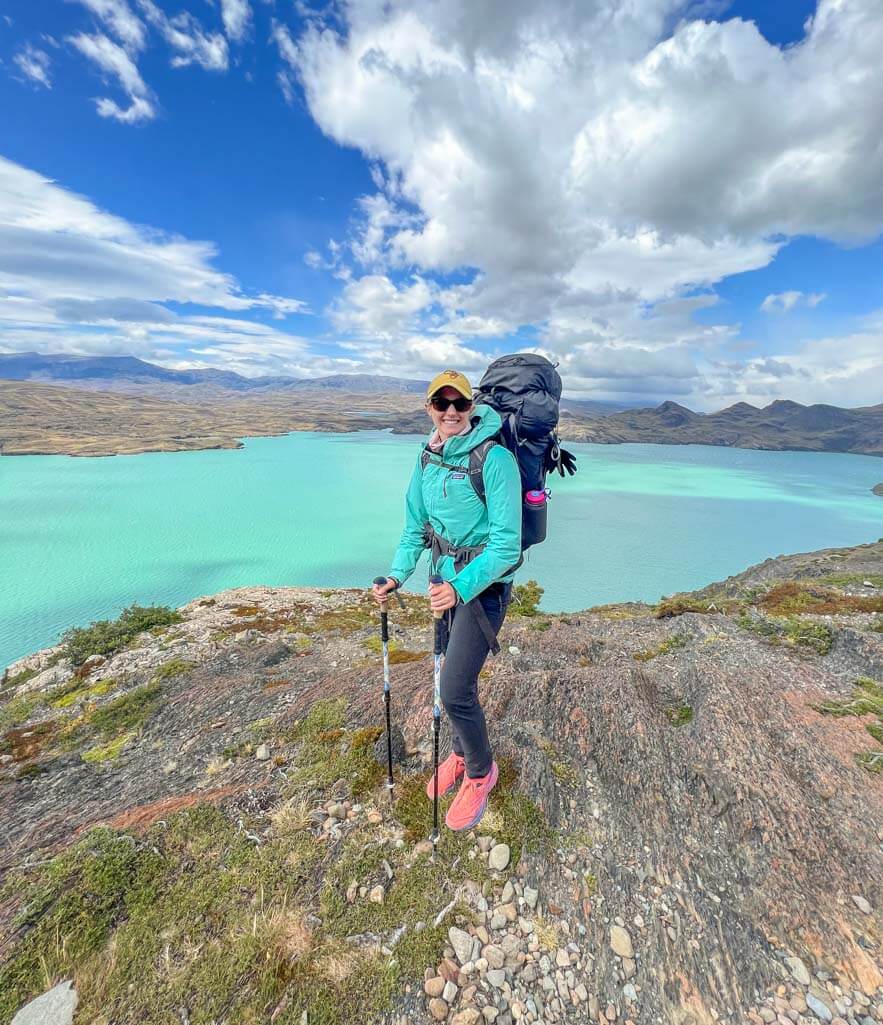
Torn Tackies contains affiliate links. If you make a purchase using one of these links, I may receive compensation at no extra cost to you. See my disclosure for more information.
Quick Navigation
Self Guided W Trek Summary
- Length: 80 km
- Duration: 4 nights / 5 days
- Difficulty: Moderate
- Highlights: Grey Glacier, Mirador Britanico, Mirador Las Torres
- National Park entrance fee: $49
- Best time: October to April (the only time you can do the W Trek without a guide)
You cannot do the W Trek without a guide in Winter
May to September are the winter months in Patagonia. During this time, there is snow and ice along the trail. This makes it more difficult and also a lot more dangerous.
While Torres Del Paine National Park is open during these winter months, doing the W Trek without a guide is forbidden.
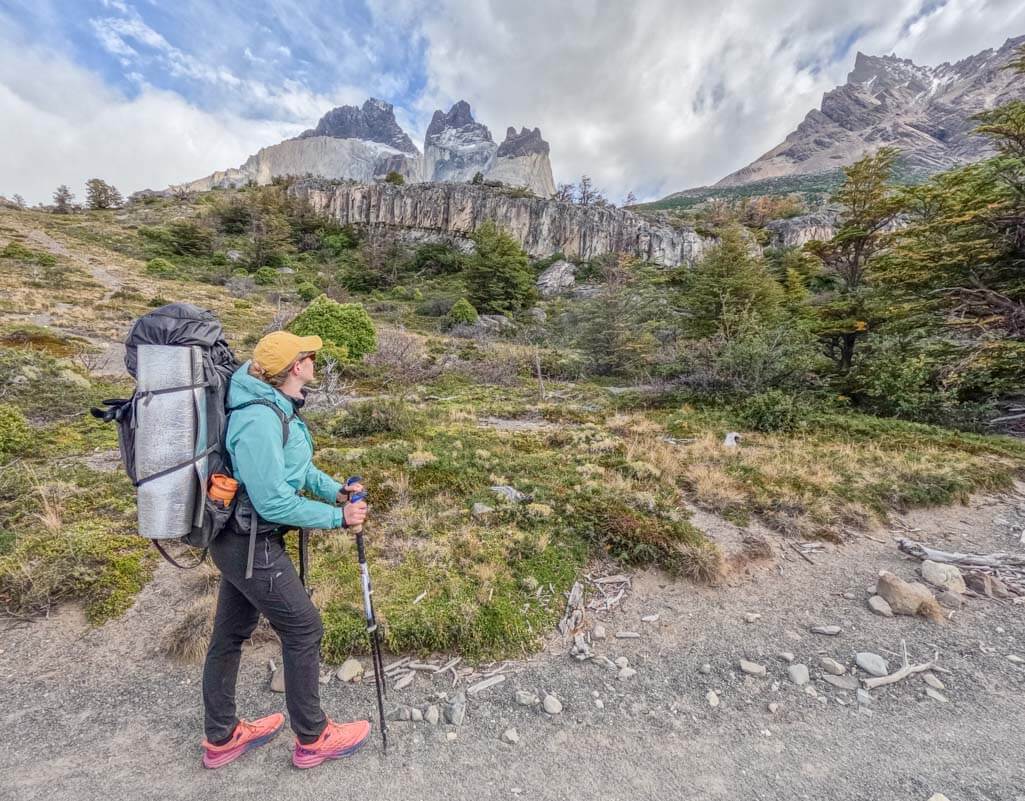
Do the W Trek self guided
Most people prefer to do the W Trek without a tour as it’s easy enough to coordinate yourself.
But it does involve quite a bit of pre-planning. You can’t free camp in the park, so you need a planned route as well as all the food and gear to get you through the five days.
Remember, you can only go hiking in Torres Del Paine without a guide between October and April.
Pre Book your bus ticket from Torres Del Paine to Puerto Natales
If you’re doing the W Trek self guided, this is the one thing you need to know.
I didn’t, and it’s my biggest regret!
You must take a 2-hour bus back to Puerto Natales after completing the W Trek.
There are buses that depart from Torres Del Paine to Puerto Natales at 11 am, 1:30 pm, and 8 pm (exact times may differ slightly).
Bus tickets can be booked in advance or on the day. Do yourself and favor and book in advance here.
Here’s why…
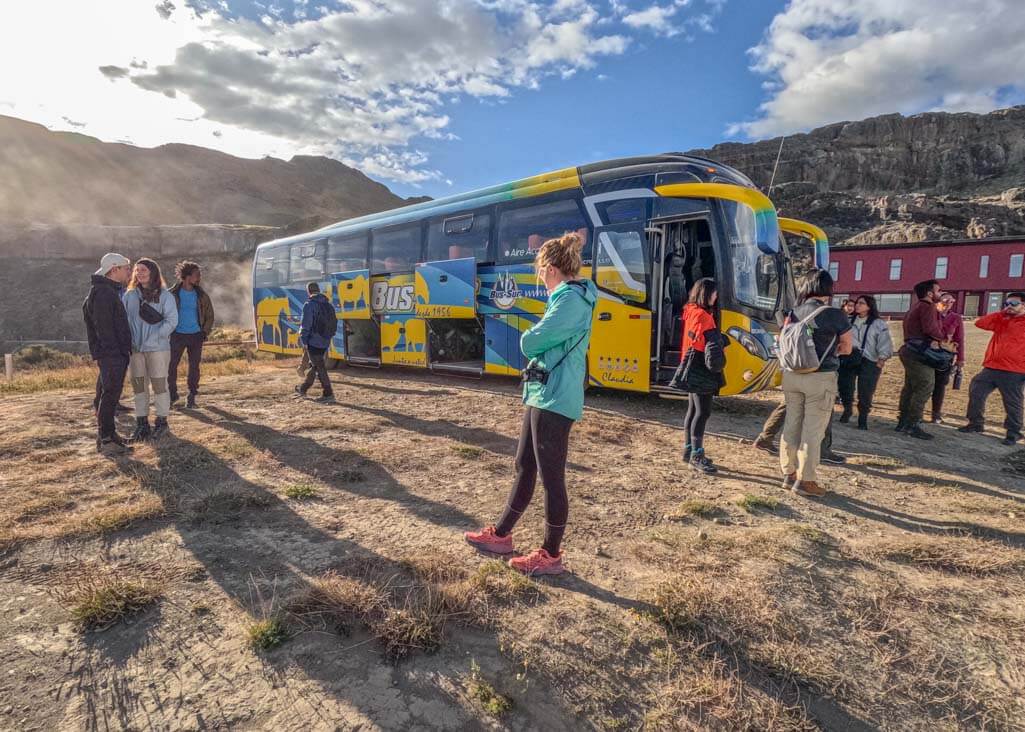
… availability on the earlier buses
The afternoon buses from Torres Del Paine to Puerto Natales sell out fast, which I didn’t realize!
I’m a backpacker and don’t usually book logistics in advance.
I wasn’t sure of the exact time that I would be finishing the W Trek and didn’t want to risk buying a ticket that I wouldn’t use (if I didn’t make it back in time.)
So I decided to buy my bus ticket from the Information Center at the end of the W Trek.
When I reached the ticket booth at 11 am, I assumed I’d get a seat on one of the three buses that departed before 3 pm.
I was very wrong!
The afternoon buses were all sold out, and the next available one was at 8 pm. This is an 8-hour wait.
So, buy that afternoon bus ticket here before you start the W Trek.
W Trek campsite bookings
If you’re doing the W Trek without a guide, you’ll need to organize your own accommodation. You can choose mountain huts or campsites, but the prices between the two differ substantially.
Bookings open in July every year, and it’s a scramble to get a spot.
Two companies manage the accommodation along the W Trek: Vertice and Fantastico Sur (also known as Las Torres).
Below are the campsites along the trail, and which company to book with.
- Paine Grande: Vertice
- Refugio Grey: Vertice
- Frances: Fantastico Sur
- Los Cuernos: Fantastico Sur
- Central Campsite: Fantastico Sur
- Chileno: Fantastico Sur
If you’re doing a self guided trek, here’s a complete packing list with everything I packed for the W Trek (and what I wish I left behind).
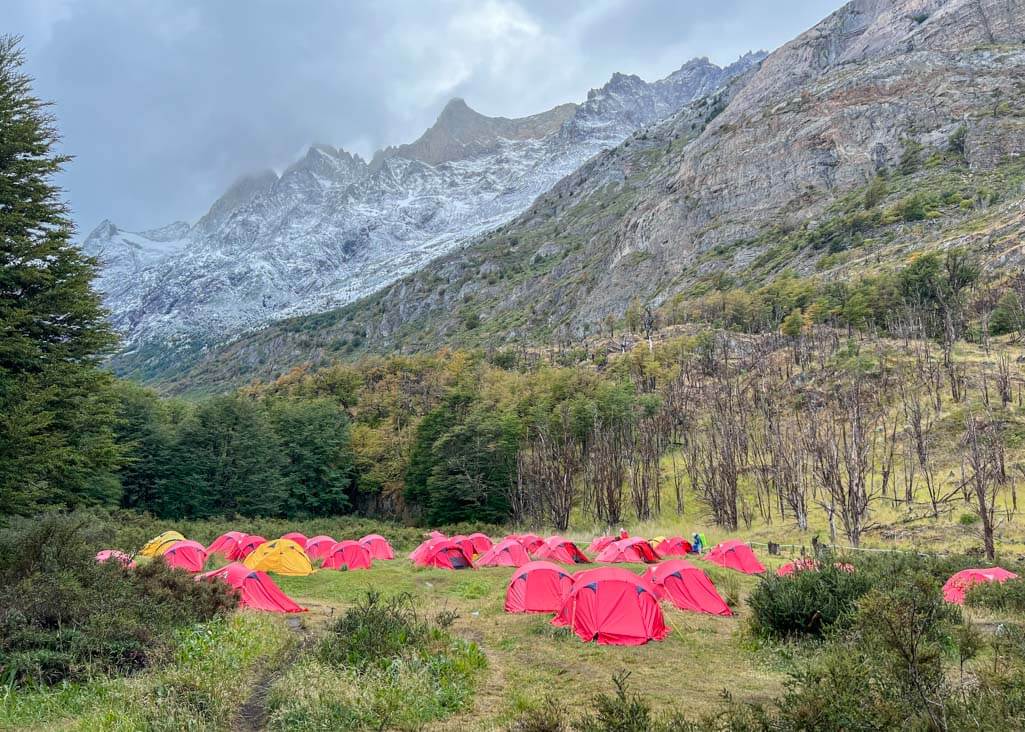
Campsite availability
Booking your accommodation for the W Trek is a serious mission and highly time-consuming. But it’s the only downside of doing the W Trek independently.
I was able to book all my campsites after people canceled their reservations, and you can do the same.
Vertice offers 45 days free cancellation, and Fantastico Sur is 90 days.
As a result, when the bookings open in July, many people book more dates and campsites than needed. This is likely because they’re finalizing their trip and want to keep their options open.
They then cancel before the free cancellation deadline. This means that spaces in campsites and lodges open up all the time.
But you need to be on the ball and check availability daily to book your spot.
This is what I did. When I started searching for W Trek campsites in September, everything was booked out. I had my preferred dates and route and checked availability numerous times a day for cancellations.
After a few weeks, I found an opening for one of the four nights. I booked it immediately and continued checking for the rest. By the beginning of December, I had all campsites secured for my January trip.
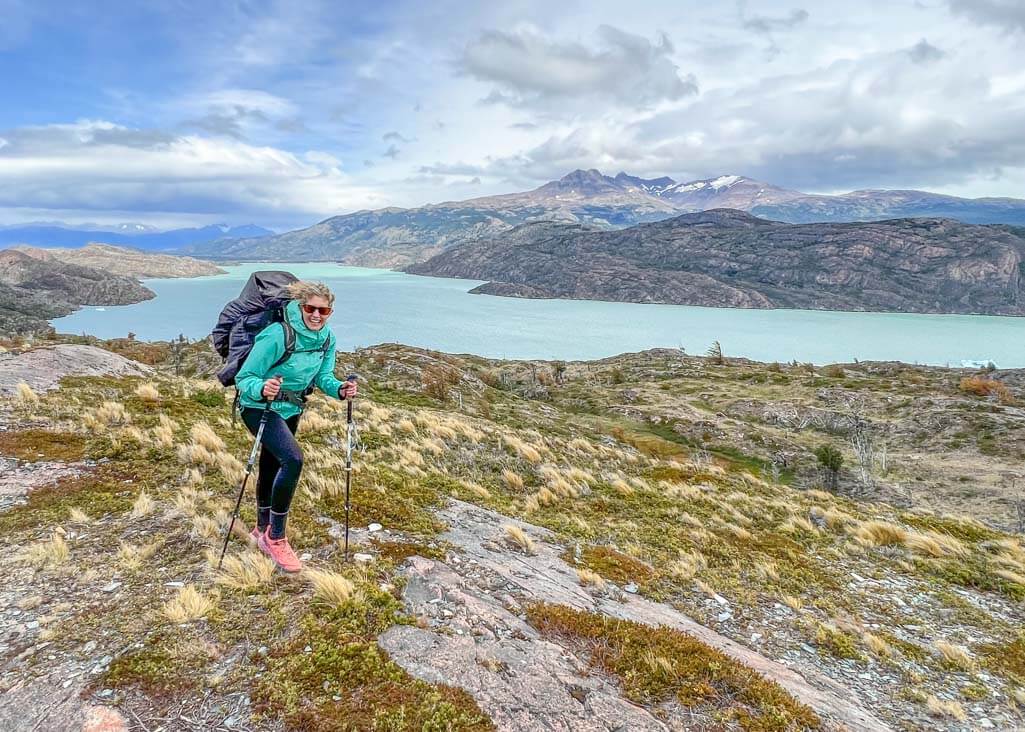
Book a site with a tent
You can do the W Trek without a guide the budget way. Or the luxurious way.
This means you can choose to carry everything from your tent, matt, and sleeping bag to your food and cooking equipment. Alternatively, you can arrive at the campsite with a tent already set up. Or better yet, you can book comfortable private rooms.
I chose the campsite option with a tent. This wasn’t my initial plan, as I wanted to carry all my own equipment. But it was the only choice I had due to availability.
In hindsight, I am so happy it worked out this way!
Because of the strenuous days and wild weather, I could not think of anything worse than setting up my tent in the rain, let alone carrying it in gale-force winds.
If you have the option, I recommend booking a campsite with a tent.
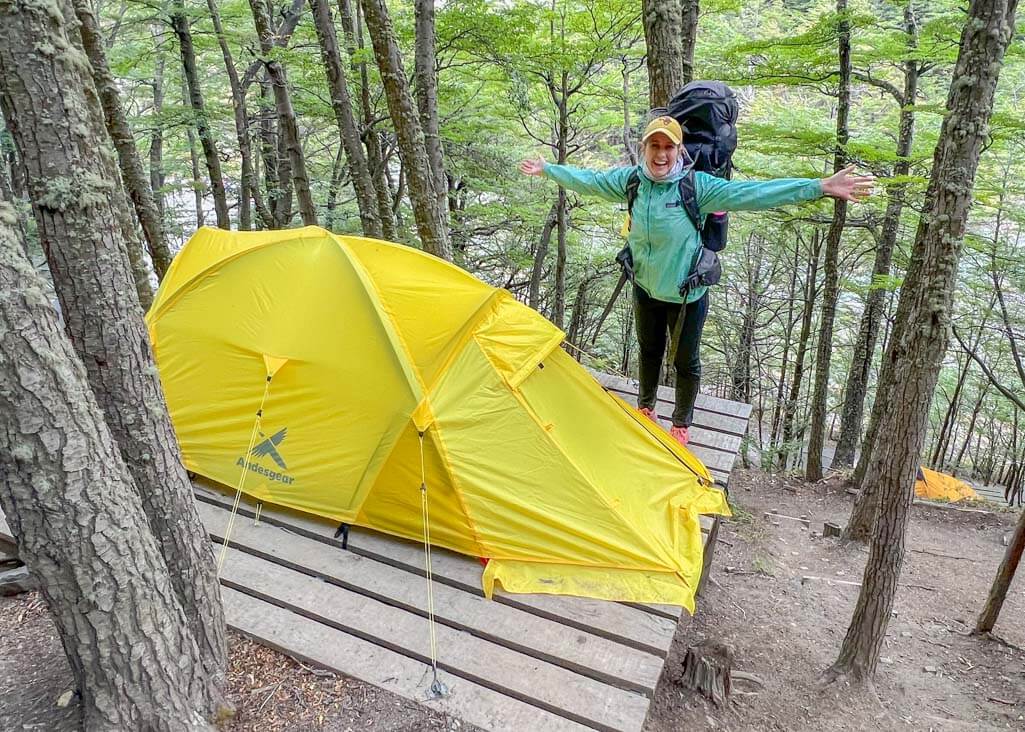
Stay at Chileno Campsite (not Central)
Chileno is the closest campsite to Mirador Las Torres, otherwise known as The Towers. From Chileno, it’s a 2-hour trek to The Towers.
But you’re lucky if you manage to find accommodation here.
The alternative option is Central Campsite. This is at the base of the mountain range, close to the Information Center and Las Torres Hotel. If you’re doing the W Trek from West to East, Central Campsite is a detour to get to.
It’s a steep and strenuous climb from Central to Chileno. Getting to The Towers from here also takes five or more hours.
So if you have the choice, stay at Chileno instead.
I booked Central Campsite as a backup as there was no availability at Chileno. Luckily someone canceled, and I managed to secure a camping site at Chileno.
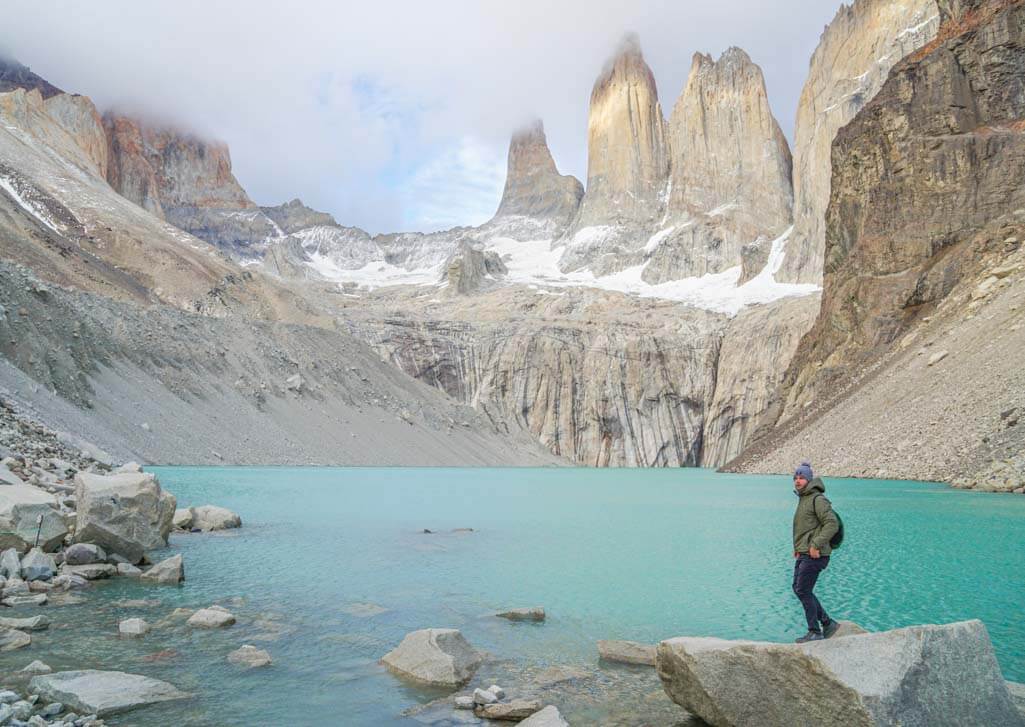
The unpredictable weather
Every W Trek blog post emphasizes the unpredictable weather in Patagonia.
Gale force winds. Four seasons in one day. Heavy rain. That kinda stuff.
I carefully planned my trip for January (which is the best time to do the W Trek) and naively thought the weather “wouldn’t be that bad.”
Oh boy, was I wrong!
Expect the worse. Hope for the best.
During my self guided W Trek, I experienced the most intense weather conditions.
Day 1 started with sunny skies, but a few hours later, it was raining.
Day 2 was the same, and then it started snowing as we approached Grey Glacier. Yes, snowing in January.
Day 3 was the most hectic hiking conditions I have ever experienced in my life!
I was blown over numerous times while walking through French Valley and had to get down on my haunches to catch my breath. It rained heavily throughout the day, non-stop. It was a tough day that only got worse.
And day 4? The weather was perfect – sunny skies and all!
But despite not having the spectacular views that most people witness as they walk through French Valley, day three was one of my highlights.
I got to experience Patagonia at its finest – the raw and harsh conditions were unlike anything I’ve experienced.
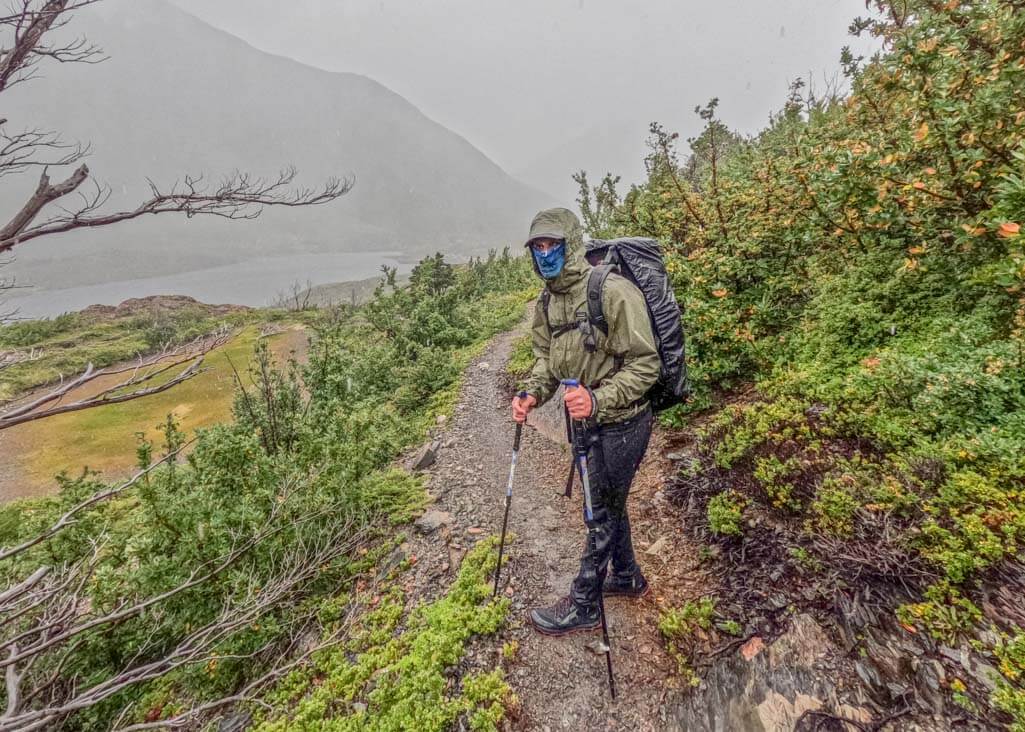
Bring cash for the ferry
Everyone doing the W Circuit must take a ferry at either the start or end of the trek, as there is no road access to Refugio Paine Grande.
It’s a stunning ferry ride and the perfect way to start your adventure.
The 30-minute journey costs 35 USD and doesn’t require any bookings in advance. You pay on arrival, and there is sufficient space for everyone.
W Trek self guided itinerary
The classic W Trek is from West to East. This is the route I followed, and I was very happy with my decision.
Here’s what the West to East itinerary looks like.
Day 1: Accommodation Refugio Grey. Take the ferry to Paine Grande and trek to Refugio Grey, your campsite for the night.
Day 2: Accommodation Paine Grande. Leave your bags at Refugio Grey and walk to Grey Glacier. Retrace your steps to Refugio Grey, collect your bags, and hike to Paine Grande.
Day 3: Accommodation Los Cuernos. Walk from Paine Grande to French Valley. Leave your bags at Refugio Italiano and hike to Mirador Britanico. Returning to Italiano, fetch your bags and continue to Los Cuernos.
Day 4: Accommodation Chileno. Trek from Los Cuernos to Chileno, which is the closest campsite to The Towers.
Day 5: Start your trek to Mirador Las Torres by 4:30 am. Head back to Chileno to fetch your bags and walk past Central campsite to the Information Center. Catch a bus back to Puerto Natales.
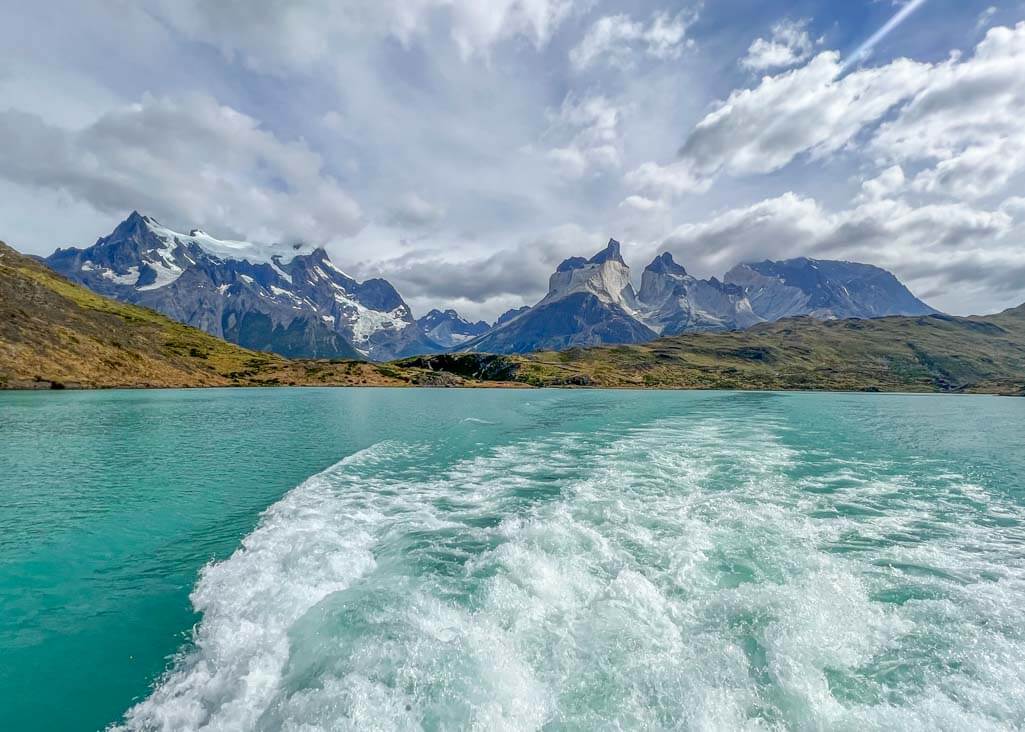
The W Trek route is clearly marked
Many people choose to do the W Trek with a guide because they’re worried about getting lost.
If you’re thinking the same, then there’s nothing to fear. The trail is well-marked with directional signage, making it extremely difficult to veer off the path.
Plus, it’s a busy trail; you’ll never be alone.
Stay in Puerto Natales
Puerto Natales is the gateway to Torres Del Paine National Park. It lies on the Chilean side of Patagonia.
The town itself was my least favorite town on my Patagonia travel itinerary.
There’s little to do, and it lacked character compared to El Calafate, El Chalten, and Bariloche, which are all on the Argentinian Patagonia side.
I recommend spending the night before and after your trek in Puerto Natales and moving on to your next destination.
I stayed at El Patagonico Hostel which is an amazing hostel in the heart of Puerto Natales. They offer private and dorm rooms as well as a big kitchen and lounge area. The price is hard to beat and they’ll store your bags for free while you do the W Trek.
You can check availability here.
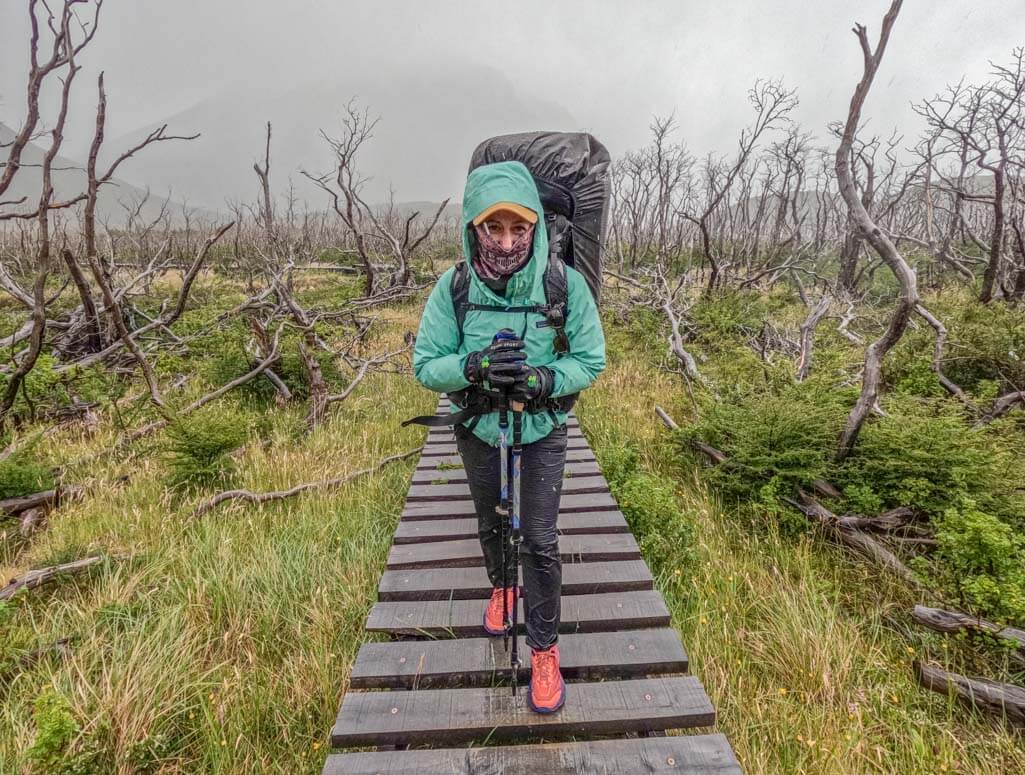
You can’t use gas along the W Trek
If you’re hiking Torres Del Paine without a guide, you’re most likely carry your own cooking equipment and gas canister.
You are only permitted to use this gas at the designated areas at the campsites and refugios.
This means you cannot stop for lunch along the trail and make yourself a warm cup of tea or cook your instant noodles. You’ll have to wait until you reach the campsite.
Lunch preparation
Your lunch options will be limited as you can’t use gas on the trail. I recommend bringing slices of ham, salami, cheese, crackers, nuts, and fruits.
I started each morning with a big bowl of oats and snacked on the above at lunchtime. This was more than enough to get me through the day.
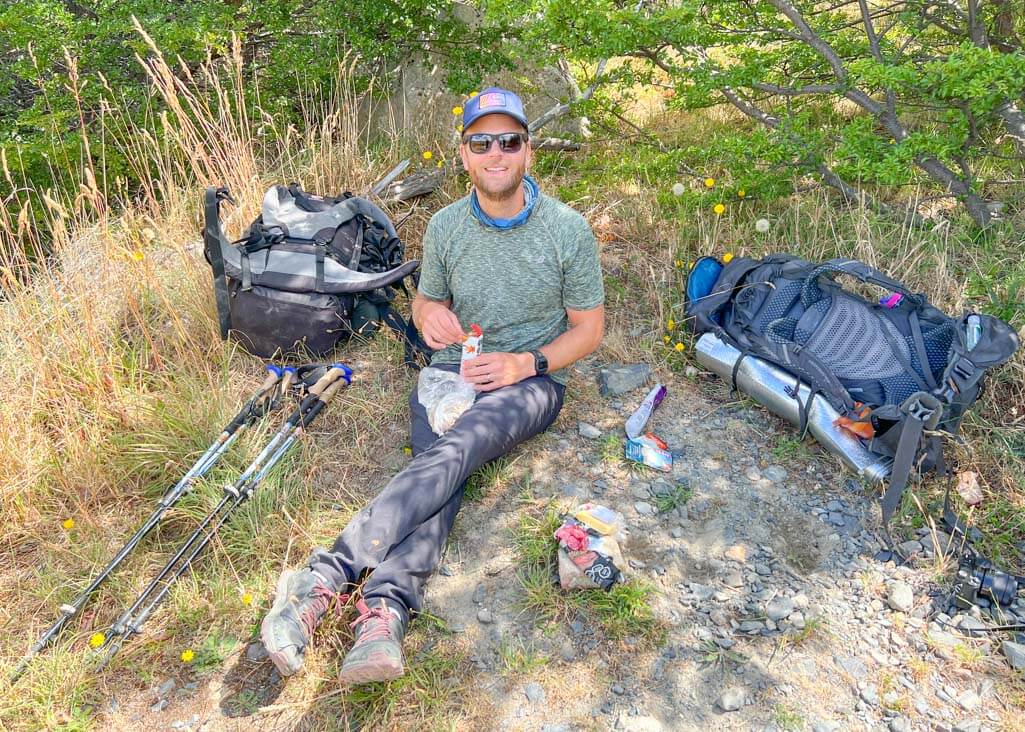
Book your Torres Del Paine National Park entry ticket online
To access Torres Del Paine National, you need to pay an entrance fee of 49 USD.
It’s best to book your ticket online before you arrive. You can purchase it here .
You will need to show this to the rangers when entering the park. Keep a downloaded version and the QR code on your phone, as there won’t be cell reception.
I read other blog posts that stated that this entrance ticket cannot be purchased at the park and needs to be done in advance. This was different from my experience in January 2023. People could pay in cash at the Torres Del Paine ticket office on the day of starting their trek.
However, to be safe, I recommend having your entry ticket sorted before arriving.
Bring a filter water bottle
The Grayl Geopress was the best purchase I made for the W Trek.
There are small rivers and streams throughout the trek, so getting water isn’t a problem. It’s getting clean, filtered water.
Instead of buying water every day and carrying 2l in my already heavy backpack, I would refill my bottle when needed.
The filter system on the Grayl is genius; it kills all bacteria and viruses and removes all sediments from the mountain water.
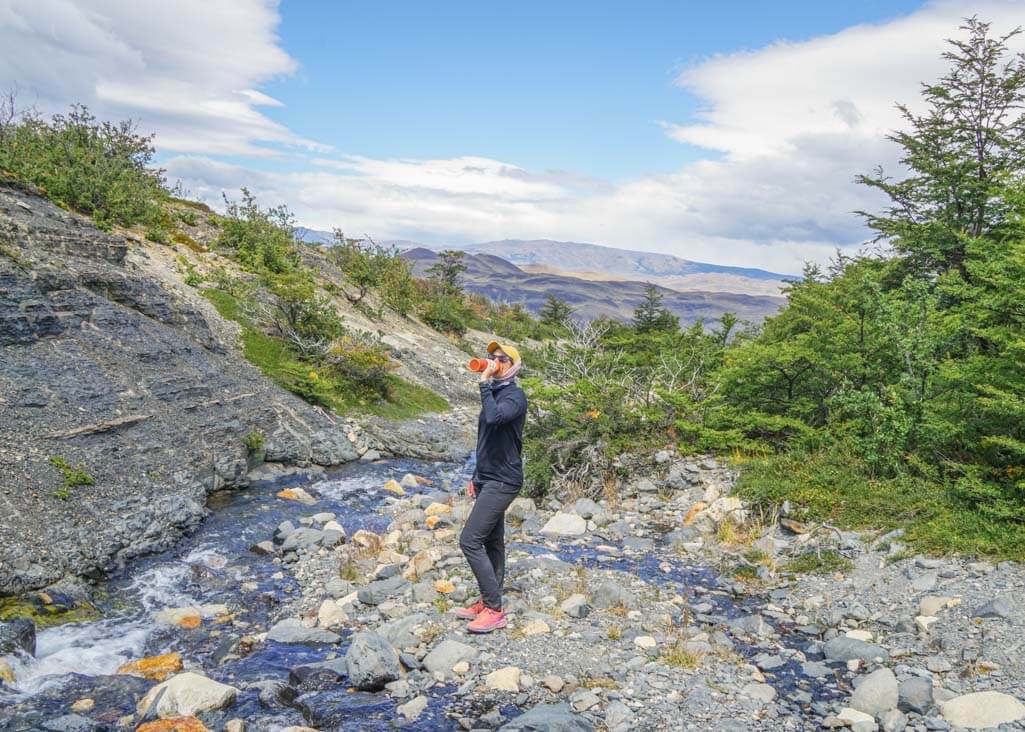
There are hot showers (for most people)
The campsites and refugios advertise that their bathroom facilities include hot showers. This luxury is not an additional cost.
I was lucky to have a hot shower every night. But people have mixed reviews on this one.
Some say the showers are lukewarm. Others say they had at least one cold shower over the five days.
Just like the weather, the temperature for the showers is unpredictable!
Rental gear can be heavy
If you’re doing a self guided W Trek, renting camping gear from Puerto Natales is easy. It’s the cheapest option, and many stores and hostels offer equipment rental at a reasonable price.
Unless you pay top dollar, do not expect this rental gear to be compact and lightweight.
My sleeping bag weighed over 2.5kg, and the cooking equipment, while light, took up a lot of space.
Keep this in mind when packing.
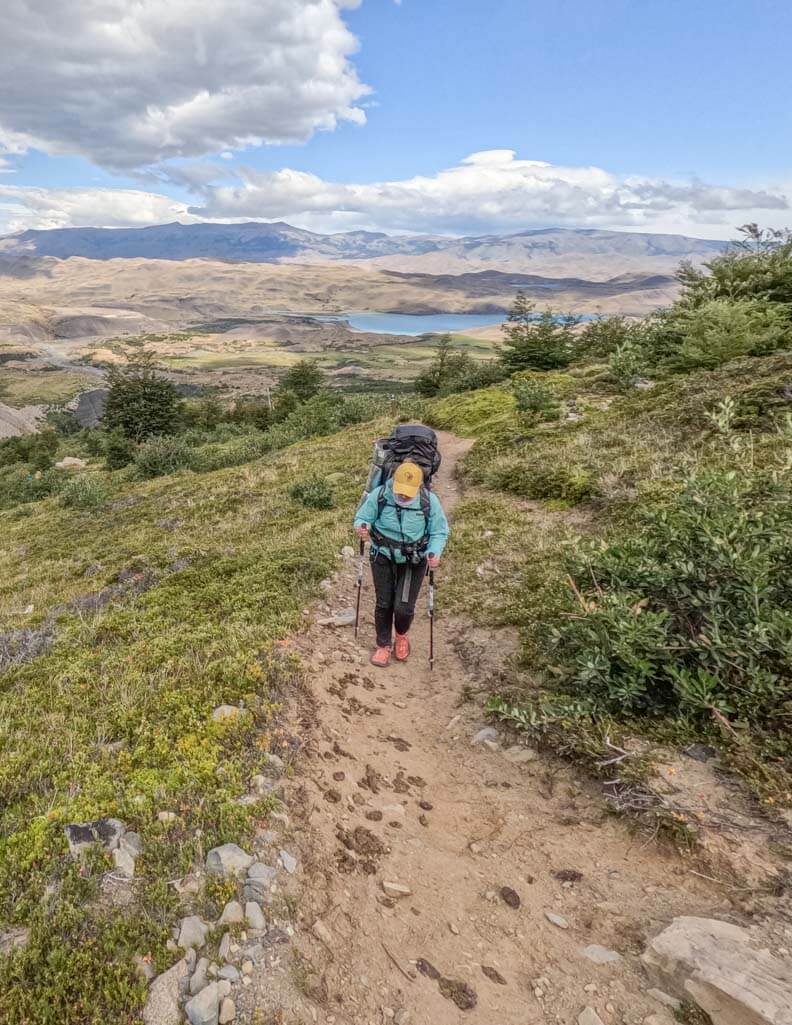
Consider doing the O Trek
The O Trek is one of the other hikes you can do in Torres Del Paine without a guide.
It’s the longer version of the W Circuit and covers parts of the national park that few tourists venture to.
I spoke to many people who had done the O Trek. They all agreed they preferred the O Trek section as it wasn’t as crowded.
While it’s more challenging than the W, doing the O Trek has a few pros that you should consider.
Because fewer hikers are doing the O Trek, people tend to make friends much easier. I noticed a strong bond between the O trekkers, who were often solo travelers.
So if you prefer hiking without the crowds and want a longer trek that still includes the W, consider the O Trek.
Bring some wine (but not too much)
Beer and wine are sold at the W Trek campsites but are expensive. If you’re on a budget, bring a small box of wine (no more than 500ml) to enjoy on the first day.
But don’t make the mistake I did by bringing too much!
After a few hours of carrying a heavy backpack with all my gear, I quickly realized that the 2l of box wine was the one thing I could get rid of to lighten the load.
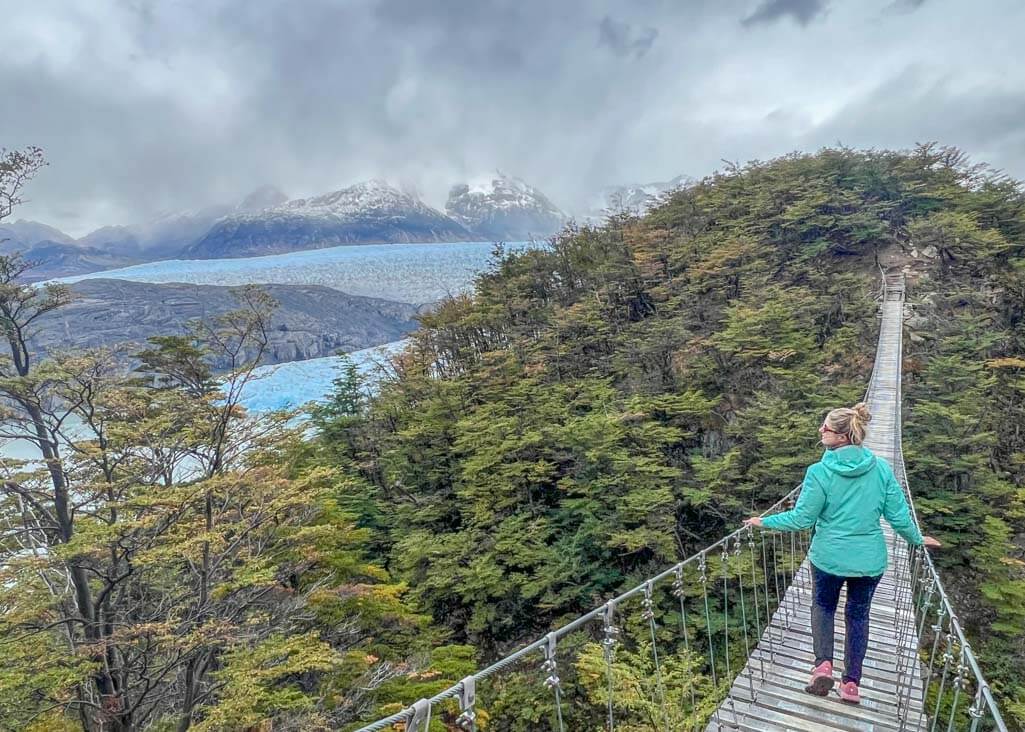
Do the extra hikes (if you have the choice)
Glacier Grey and Mirador Britanico are not exactly on the W Trek route. However, getting to these iconic locations are detours that are well worth the effort.
I’m so happy I plucked up the courage to go to Grey Glacier despite the freezing cold temperatures, snow, and gale-force winds!
Unfortunately, I can’t say the same for Mirador Britanico. The trail was closed by rangers due to the severe weather conditions, which made it a safety concern.
Top tip: If you thought Grey Glacier was impressive, I highly recommend visiting Perito Moreno Glacier in El Calafate. It’s in Argentinian Patagonia and the most impressive glacier I’ve ever seen.
Bring trekking poles
If you’re hiking Torres Del Paine without a guide, I highly recommend using trekking poles.
These were absolute lifesavers for trekking and keeping me on my feet when the wind was blowing me over!
You can rent trekking poles from Puerto Natales.
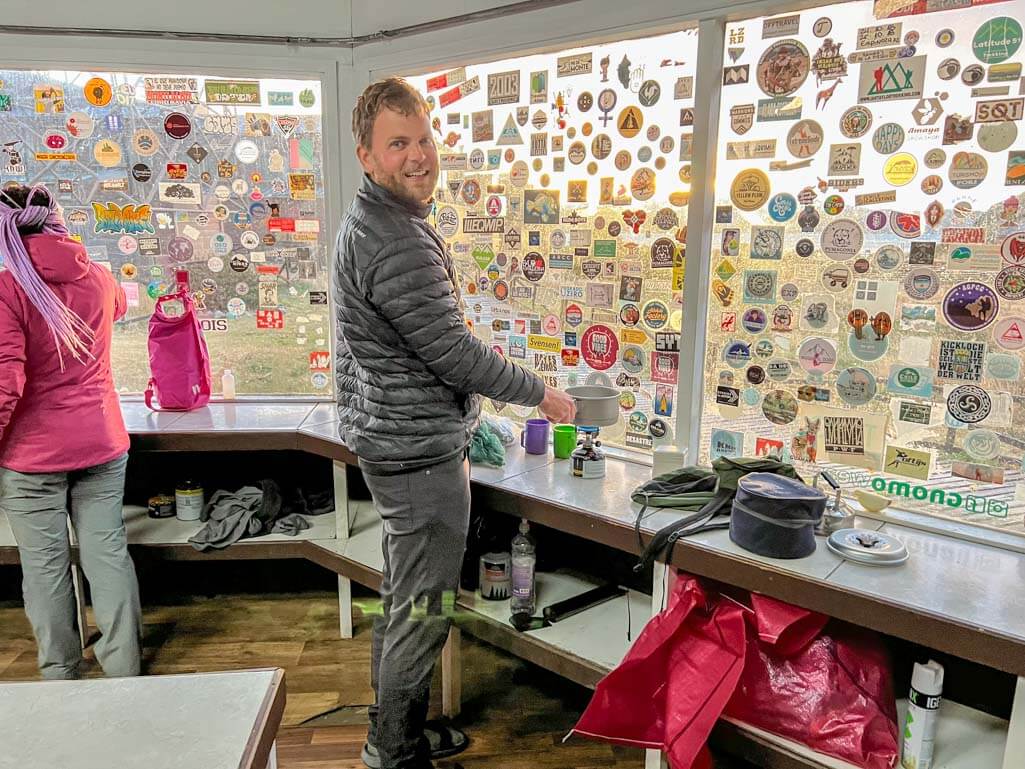
Keep your PDI safe
When you enter Chile by land or air, you’ll be given a small piece of paper from immigration. This is called a PDI and acts as your tourist visa.
Do not lose this, as you will need to hand it in when you leave the country.
Line your backpacks with black bags
Bring one or two big plastic bags with you to the W Trek. This is my top tip for keeping your things dry.
A waterproof backpack cover only goes so far if there are torrential downpours!
If you’re expecting rain, pop all your things in a plastic bag and put that bag inside your backpack (which should also have a waterproof cover).
Other tips for doing the W trek self guided
- Bring cash, as you can buy snacks, drinks, and food along the trail
- Take the first bus from Puerto Natales to Torres Del Paine National Park so that you start the W Trek early
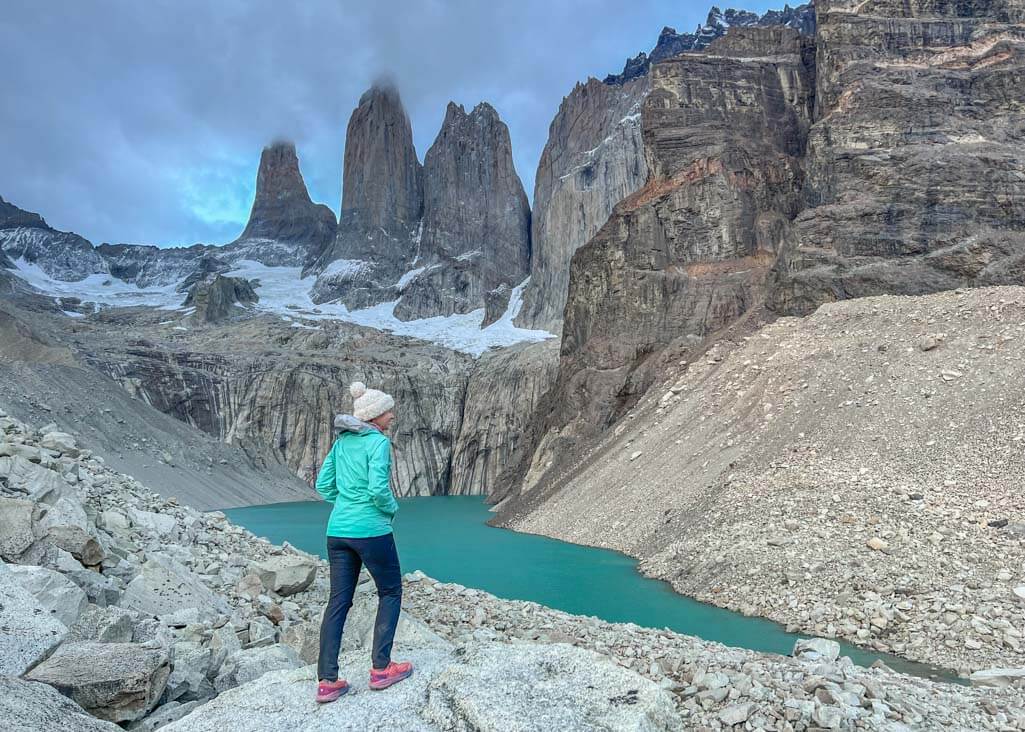
My W Trek Self Guided Experience
I had high expectations because of all the hype about Torres Del Paine National Park.
But the stress of finding campsites for the W Trek put a damper on the lead-up to my trip. I spent hours checking for availability, arguing with Fantastico Sur for refunds, and trying to justify paying for a more expensive camping option.
But the moment I arrived in Torres Del Paine, I knew it was all worth it. The W Trek is a fantastic adventure, and doing it self-guided is by far the best option.
The spectacular sunrise from the base of Las Torres was only one of the many highlights of the W Trek.
From cooking over a small camp stove in the refugios to sharing war stories with new friends who experienced the same hectic weather as we did. The memories I have of hiking the W Trek will last forever!
Like it? Pin it!
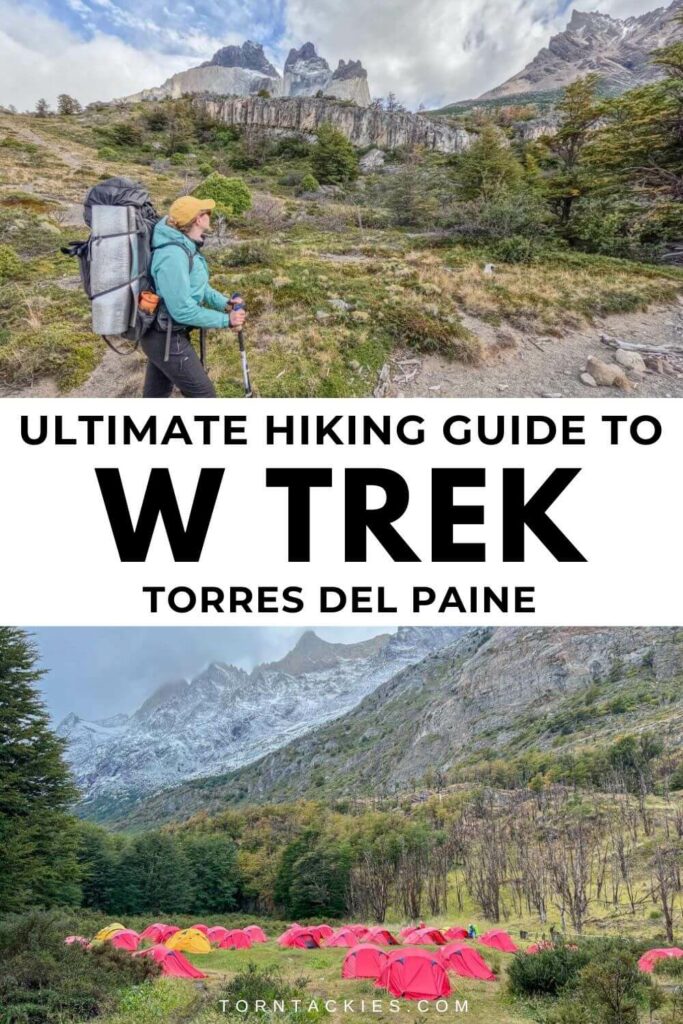
Do you have any questions about doing the W Trek self guided? Drop me a message in the comments section below!
Looking for more Patagonia travel inspiration? Check out my other posts!
- The Best Hikes in El Chalten
- The Ultimate Bariloche Itinerary
- Hiking Laguna De Los Tres: The Best Day Hike in Patagonia
- How to Hike to Laguna Torre in El Chalten
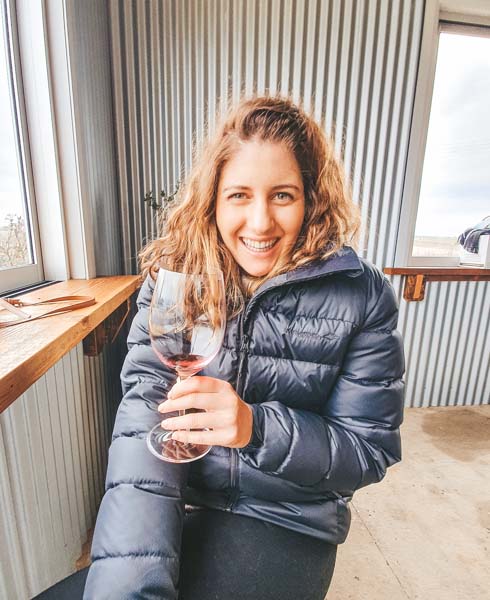
Hi, I'm Carryn. I’m an adventure travel blogger trying to figure out my way through life by traveling and exploring. Join me as I share my travel guides and tips for life abroad. Find out more about me here .
Huayna Potosi Climb: A Comprehensive Guide to the Summit
The perfect w trek packing list: 100+ things to pack (and not to), 4 thoughts on “27 things i wish i knew before doing the w trek self guided tour [2024]”.
Thanks for writing this up! So timely. We recently decided to plan a trip to Patagonia in late November and planning to do the W trek. Interested in self-guided but with camping gear setup for us.
We’re a couple in our late 30s/early 40s. In good shape (runners, gym enthusiasts) but live at sea level so we won’t get a lot of pre-trip hiking in aside from hill intervals on the treadmill. I’ve previously hiked the Salkantay pass on a guided tour and was grateful to have the guide.
All this to ask: would you recommend the self-guided option even for more moderate/novice hikers? And would the difficulty make sense you think?
Thanks for any advice!
Hi Michelle,
Thanks for your comment. If you’ve done the Salkantay Trek, the W Trek will be a walk in the park (That was my experience having done both, and I did the Salkantay Trek with a guide). The W is still tough, but nothing compared to the Salkantay Trek.
I really enjoyed doing the W Trek without a guide – it’s the option that most people choose. The trail is well marked and not very strenuous as it’s not a altitude hike. You’ll enjoy the freedom to walk at your own pace and stop where ever you wish. It’s also fun making your own food and meeting other people in the communal cooking and dining areas.
What makes the W Trek tough is the weight of your backpack. But if you’re planning on having camping gear set up for you, your backpack will be much lighter anyway. The weather will also play a factor and the wind can make it difficult, but I still don’t believe a guide is necessary.
The positives of booking with a tour operator is that they take care of all the campsite reservations. I found this to be the most tedious part of planning my trip as they are often sold out. But if you monitor the campsite availability daily, you should be able to find something. People often cancel before the free cancellation deadline and this is when sites open up.
Enjoy your trek!
Thank you so much for writing this post. I’m currently trying to book campsites and you weren’t lying about it being a real 🤕. I’m on the Vertice website under booking and they ask were you want to start the trek (Refugio grey or Paine Grande) and then where you want to stay after the trek. It then asks how many days you want to stay in the accommodation (I want to start at Refugio grey) but I will only stay there the first night. I’m not sure how to book my accommodation the 2nd, 3rd, 4th nights? I’m not one to usually ask for help as I’m a fairly experienced traveler but is there any chance you could help me book this? I’m sure with your help we could do it in 30 minutes and I’d be happy to Venmo you for your time & help. Let me know!! Thanks 🙂
I totally get your struggle for booking campsites! It took me hours and hours to do. In my case, there was no availability, and so I had to monitor Vertice and Fantastico Sur daily to check if there were any cancellations that I could find. If you’re booking for December or January, you may have a hard time finding space.
There are two companies that manage all the W Trek accommodation. Vertice and Fantastico Sur (Las Torres).
On the Vertice website, you can book your first 2 nights accommodation for the W Trek. Select “Grey” for day 1 and “Paine Grande” for day 2. You then pay and leave the Vertice site.
Next, go to the Fantastico Sur (Las Torres) website. Here you can book your accommodation for day 3 and 4.
This is my recommend route and the websites to book through.
Night 1: Refugio Grey (Vertice) Night 2: Refugio Paine Grande (Vertice) Night 3: Los Cuernos (Fantastico Sur). If there’s no availability, look at Frances which is nearby and also booked through Fantastico Sur. Night 4: Chileno (Fantastico Sur). If there’s no availability, look at Central Campsite which is nearby and also booked through Fantastico Sur.
I hope that helps.
Leave a Comment Cancel reply


19 Things to Know Before Hiking the W Trek in Patagonia’s Torres del Paine in 2024
So you’re interested in hiking the W Trek in Patagonia – one of South America’s most famous trails. The W Trek zigzags through the heart of Chile’s iconic Torres del Paine National Park , a land where the summits form stunning granite monolith towers and the lakes glisten a breathtaking turquoise blue. The trek is named after the W-shape it forms on a map, running along the base of the iconic mountains before doubling back into the Valle Francés (“French Valley”) at the very heart of the reserve.
This detailed guide will run through all the ins and outs of hiking the W Trek. It will cover the best time of year for hikers to visit this wild part of Chilean Patagonia, some challenges you can expect to encounter, top trip highlights, what gear you will need, how long you may spend in the wilderness, and much more. Happy exploring!
My experience hiking the W Trek
I’ve trekked extensively throughout the Andes, from the dizzying heights of Machu Picchu to the impressive glaciers of Argentine Patagonia, and have learned powerful life lessons from my adventures . However, I still remember the W Trek as one of the most amazing mountain adventures I have taken. There’s a reason why it’s the most famous hiking trail in Patagonia. T he scenery you’ll enjoy along the way is second to none – imagine jagged mountains that resemble massive shards of ice, milky mountain lakes, and the rolling Patagonian Steppe in the distance.
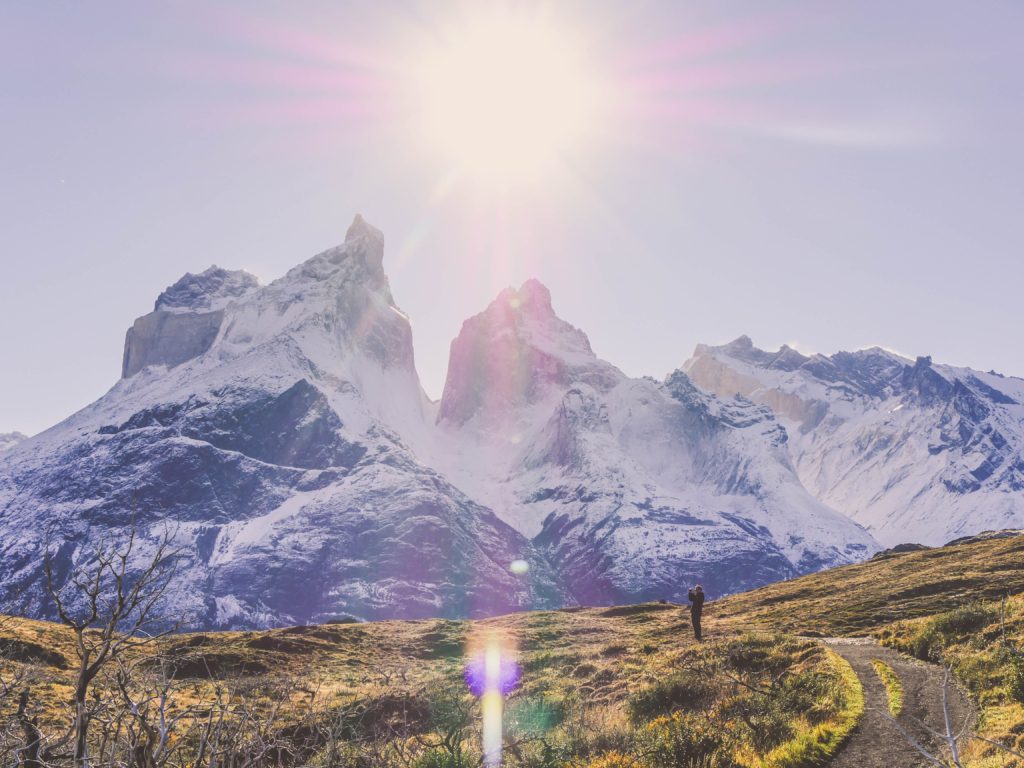
A personal highlight of the W Trek was the approach to Grey Glacier, which feels like one of the most untouched parts of Torres del Paine. The path to Grey Glacier along Grey Lake is stunningly beautiful and poses a nice challenge as you trek amongst chiseled sculpturesque mountains. Adding to the physical beauty of it all, the hiking route is fantastically well-organized with designated camp / hut sites that boast gorgeous views of the national park, the trekking season is long, and wonderful local guides are available. I highly recommend you experience hiking the W Trek for yourself .
What’s in this guide to the W Trek?
- An introduction to Chilean Patagonia
- Where is the W Trek?
- The history of the W Trek and the Torres del Paine National Park
- Highlights of the W Trek
- How long is the W Trek? How many days are needed?
- Elevation and terrain on the W Trek
- Is the W Trek difficult?
- Preparation for the W Trek
- When is the best time of year to go?
- What do I need to pack for the W Trek in Patagonia?
- Accommodations: Where to stay on the W Trek
- W Trek permits
- Getting to the start of the W Trek
- Sample W Trek itinerary
- The 5-Day W Trek Circuit
- W Trek Express
- Alternative routes to the W Trek (O Circuit vs Q Circuit)
- Where to go after the W Trek
- Visas for Chile
1. An introduction to Chilean Patagonia
Chilean Patagonia is one side of the greater region of Patagonia. Altogether, it encompasses a whopping 400,000 square miles (that’s over a million square kilometers!) of land at the southern end of South America. It’s a diverse place, rolling from seemingly endless steppes inhabited by unusual Welsh-speaking farming communities to the jagged tops of mountains like the Fitz Roy and the Torres del Paine.
Ever since the first Spanish conquistadors started coming here in the 1500s, Patagonia has been seen as a land of myth and majesty. Open and vast like nowhere in Europe, it wowed explorers with calving glaciers and penguin-spotted islands, mirror-like alpine lakes, and whale-filled oceans. Today, the awe-inspiring nature of the region is still very much intact and trekking here is seen as a bit of a rite of passage a la the Himalaya.
Chilean Patagonia begins roughly 500 miles (805 kilometers) south of Santiago, the capital, and then arcs around the whole of the edge of the continent before finishing at the icy channels of the Tierra del Fuego archipelago. It’s all pretty wonderful, but most agree that the zenith is the Torres del Paine National Park, which is where you’ll be doing the W Trek.
2. Where is the W Trek?
The W Trek leads you to the most famous part of Chilean Patagonia: The Torres del Paine. They’re a trio of incredible granite tower peaks that look like daggers shooting straight out of the earth. At their closest point, the three towers are just 12 miles (19 kilometers) from the Argentina border. The nearest main town is Puerto Natales, Chile. More generally speaking, the W Trek takes you down to the ice-capped, snow-dusted ends of the continent, less than 400 miles (645 kilometers) from Cape Horn . It’s truly a wild part of the planet you must see!
3. The history of the W Trek and the Torres del Paine National Park
Arguably the most famous corner of Chilean Patagonia, the serrated tops of the mighty Torres del Paine massif became the centrepiece of their own national park back in 1959. But you have to go back almost 80 years more to discover the moment when the region first entered the limelight.
Yep, Scottish travel-writing pioneer Lady Florence Dixie blazed a trail here during her South American travels in the late 1880s. Her prose recalls “three tall peaks of a reddish hue” stood before plains of ripe berry bushes and grazing guanacos.
Her descriptions piqued the interest of others. Finnish geologist Otto Nordenskjöld took a break from his polar explorations to visit the region in the 1900s. Then came the missionary-mountaineer Alberto María de Agostini en route to his epic crossing of the Southern Patagonian Ice Field.
It wasn’t until the end of the 1950s that the region was designated an official national park by the Chilean government. It was originally known as Grey Lake National Tourism Park but was subsequently given its modern name in the 1970s, the same decade it was dubbed a prestigious UNESCO World Biosphere Reserve.
It was also the 1970s that saw the formation of the famous trails. That was spearheaded by a team of local rangers in conjunction with British explorer John Garner (who now has a pass named after him in the range). They laid the foundations of the now-iconic circular route that encompasses the whole massif, including the W Trek section itself.
4. Highlights of the W Trek

If you’re looking to be wowed by the sheer majesty of hiking in Chilean Patagonia, then yes, the W Trek is most certainly worth it. This relatively low-altitude trek takes you through areas of the national park that are widely considered to be the most incredible places in Patagonia. In a region that’s beset by ice fields and soaring peaks, that’s really saying something!
The W Trek requires a commitment of about 4-5 days of hiking, on average. What’s great is that there is something special to see on every single day of the journey. Views abound from start to finish and there’s always another W Trek highlight to look forward to. The most impressive parts of the trek are:
- The French Valley & Cerro Paine Grande – See the spectacular summits of Cerro Paine Grande, the tallest peak of the Cordillera Paine mountain range in Torres del Paine National Park, up close as you trek into the French Valley. The French Valley is a hidden cleft in the Andes that’s topped by a hanging glacier and dashed with gnarled beech forests.
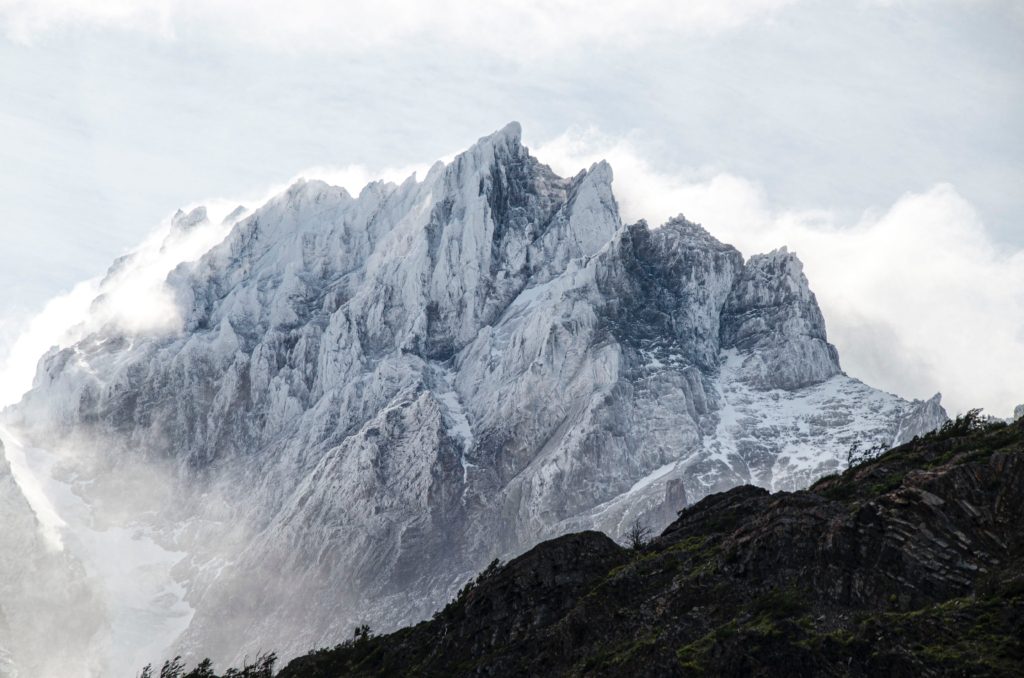
- The Base of the Towers – you will either finish or begin the trek at this stunning location with a turquoise lake set before the iconic Torres del Paine granite spires themselves. The lookout point encompasses three sheer mountains before a milky alpine lake. This is the scene that is the infamous image of the W Trek.

- Mirador Britanico – There are numerous lookout points within the French Valley, but we’d say the Mirador Britanico trumps the lot. Stand on this slab of rock to survey an amphitheater of cathedral-like mountains that descend into forests of Antarctic beech trees filled with finches and woodpeckers.
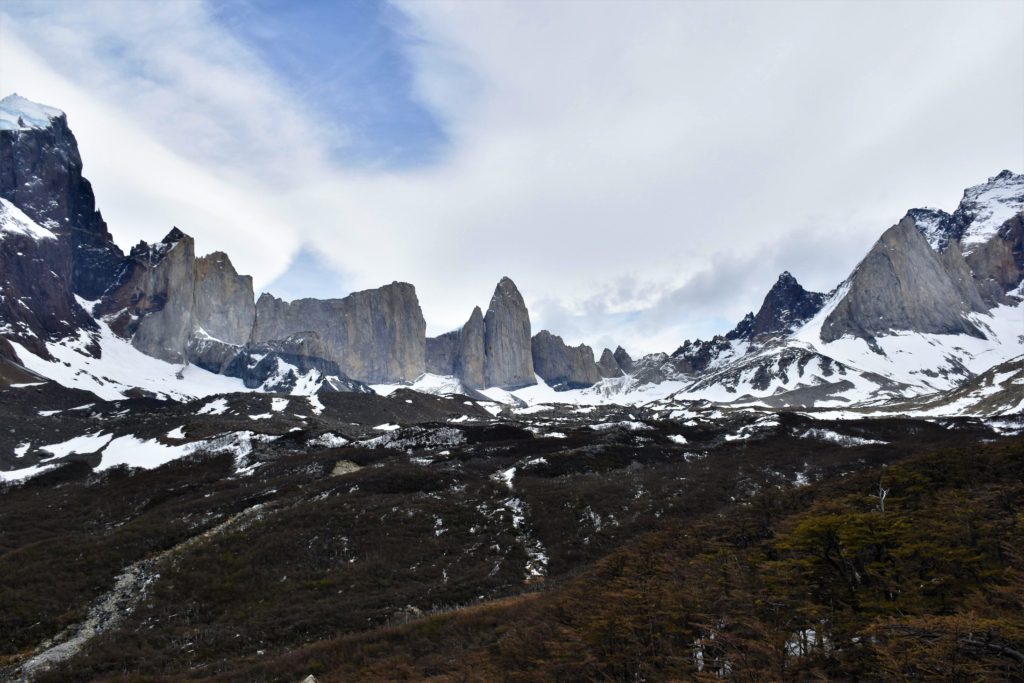
- Los Cuernos – A set of twisted mountains dominating the northern view for much of the hike. A colossal cirque of peaks all tangled together, the Los Cuernos form the very heart of the Torres del Paine massif. Look up to spy out summits named things like The Blade, The Sword, and the Shark’s Fin.
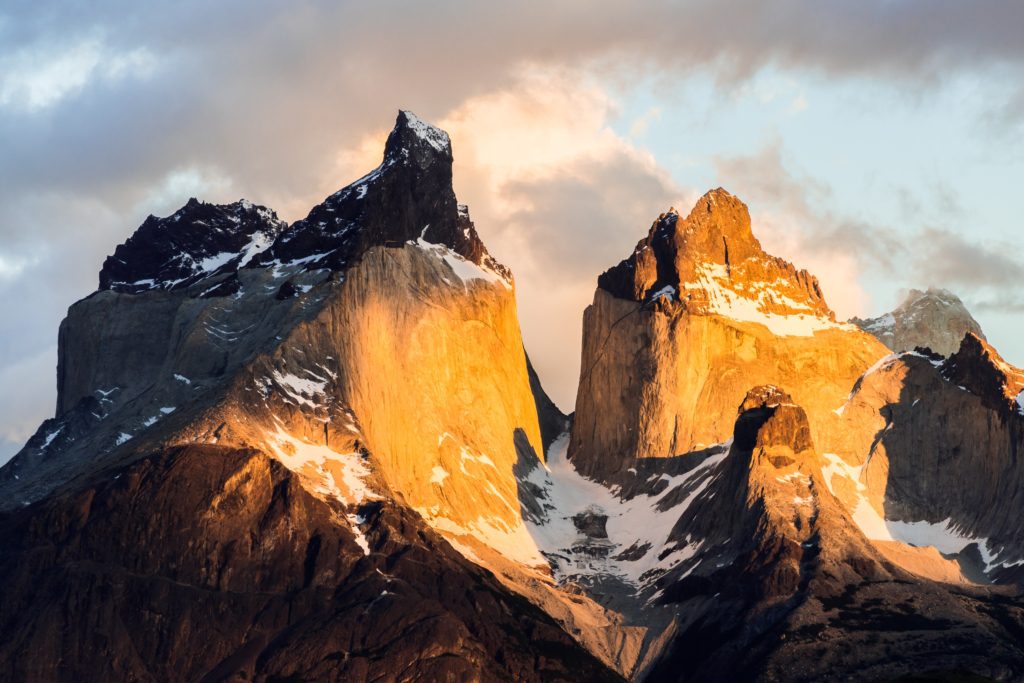
- Grey Glacier – This colossal ice field with calving sheets of frozen water could be one of the most awe-inspiring things you encounter on the W Trek. It is the largest glacier in the Torres del Paine National Park. Just one of the many tongues of frozen water that cascade down from the great Southern Patagonia Ice Field, Grey Glacier is either the grand finale or the starting point of the W Trek. It’s everything you imagine of a South American ice cap, sporting 98-foot high (30-meter) walls that rise suddenly from the turquoise waters of Lake Grey.
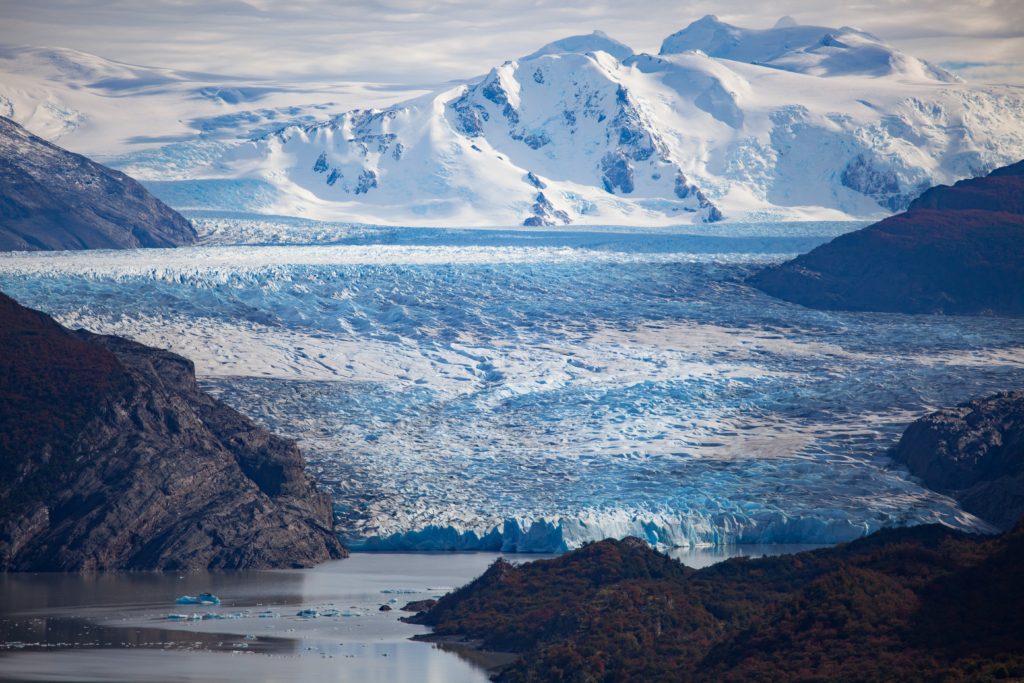
- Pehoé Lake – This many-armed body of water rolls out to the south of the W Trek path. You’ll see it on multiple days, but there’s one epic photo spot that frames the twisted Los Cuernos mountains above a mirror-like dash of water.
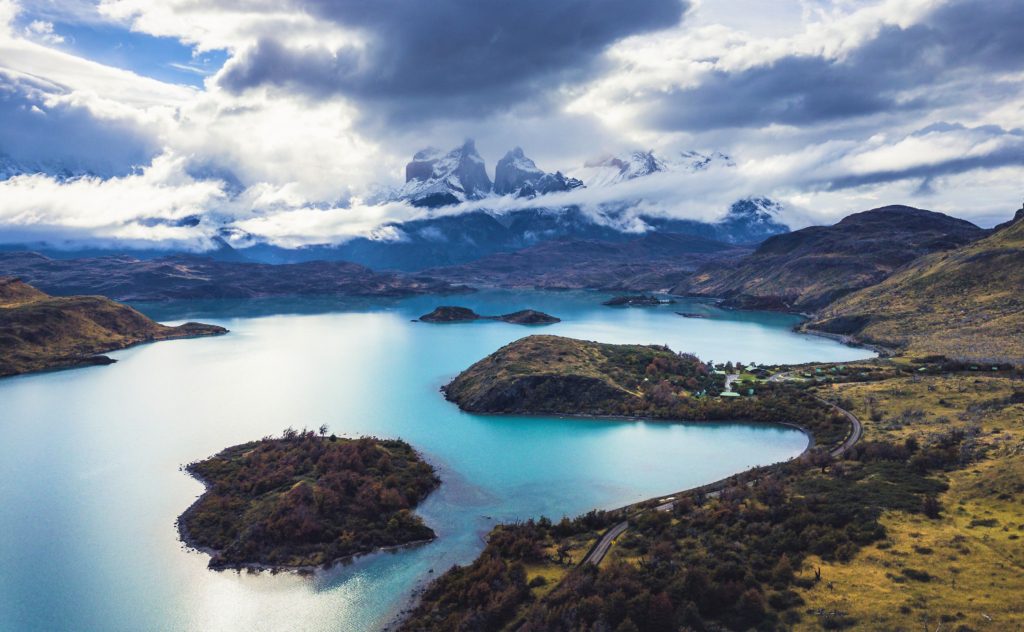
- The wildlife in Torres del Paine – Of course, you cannot forget the park’s incredible fauna! You will undoubtedly encounter a diverse range of wildlife on the W Trek. One of the most common mammals you will spot will be the ubiquitous guanacos, which are related to llamas and vicuñas. You may also see Magellanic woodpeckers, Patagonian gray foxes, Andean condors, or even caracaras (a unique-looking bird of prey). Even more elusive are the pumas and the endangered and rare Chilean Huemul, or South Andean deer.
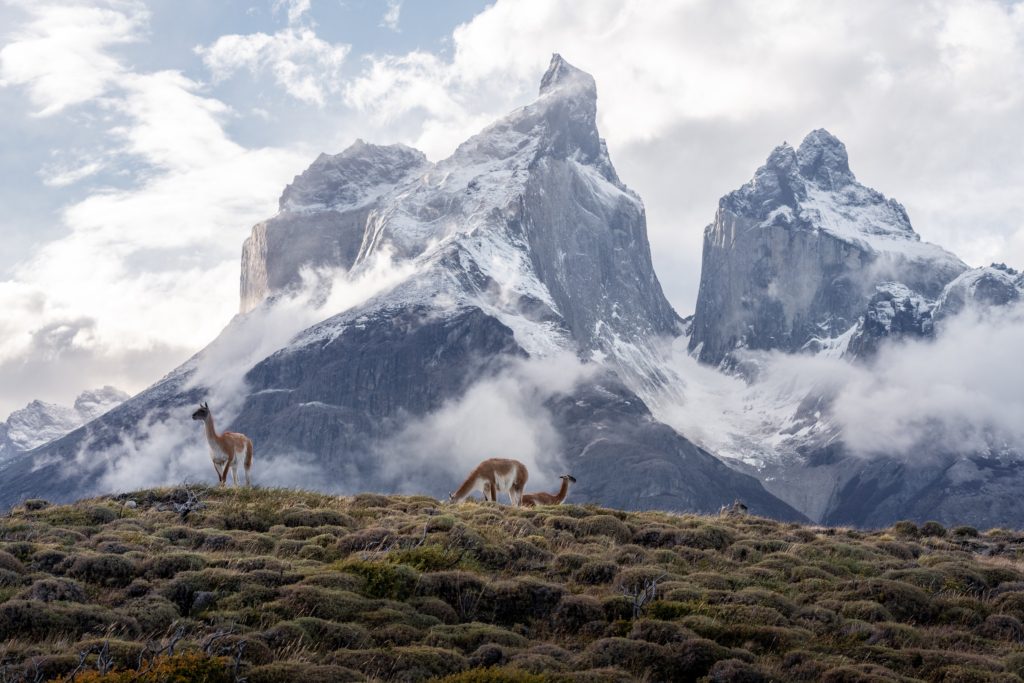
5. How long is the W Trek? How many days are needed?
The distance of the W Trek is approximately 55 miles (88.5 kilometers) long. One of the great things about this hiking route is just how versatile it can be. It’s easy to chop, change, and add to the W Trek itinerary so you’ll find everything from 4-day treks to 7-day ultimate treks on the menu.
There are many different distances reported by various sources for the W Trek. The below is what I have personally tracked via GPS while hiking the East to West route for 5 days.
Day 1 – Central Sector to Central Sector (Base Torres Hike)
- 13.5 miles / 22 kilometers
Day 2 – Central Sector to Francés Sector
- 11.5 miles / 18.5 kilometers
Day 3 – Francés Sector to Paine Grande (including Mirador Britannica Lookout)
- 15 miles / 24 kilometers
Day 4 – Paine Grande to Grey Mountain Refuge
- 7.5 miles / 12 kilometers
Day 5 – Grey Mountain Refuge to Paine Grande / Lake Pehoé
If you plan to do the W Trek in 4 days then your Day 4 (Paine Grande to Grey to Paine Grande) will be 15 miles (24 kilometers) in length.
You can do the trail in different directions. There are ways to skip one leg of the journey and add on extra excursions. So long as you follow the basic idea of a W-shaped route through the Torres del Paine park and include a trek into the stunning French Valley along the way, you can rest assured that you’ll see the Patagonian national park’s highlight attractions.
6. Elevation and terrain on the W Trek
The pinnacle of the W Trek reaches 2,788 feet (850 meters) above sea level. Now, that might sound positively low for veterans of Everest Base Camp, Mount Kilimanjaro, or the Inca Trail – and it is. However, where this trek gets tricky is in elevation gain and loss and the daily distances. Some sections of the W Trek see hikers clock up altitudes of over 2,000 feet (610 meters) in just a few hours, only to lose it all again that afternoon as they head to the rest site for the night. You’re likely to notice this most after the hike to the base of Las Torres, which is followed a few days later by the ascent into the French Valley.
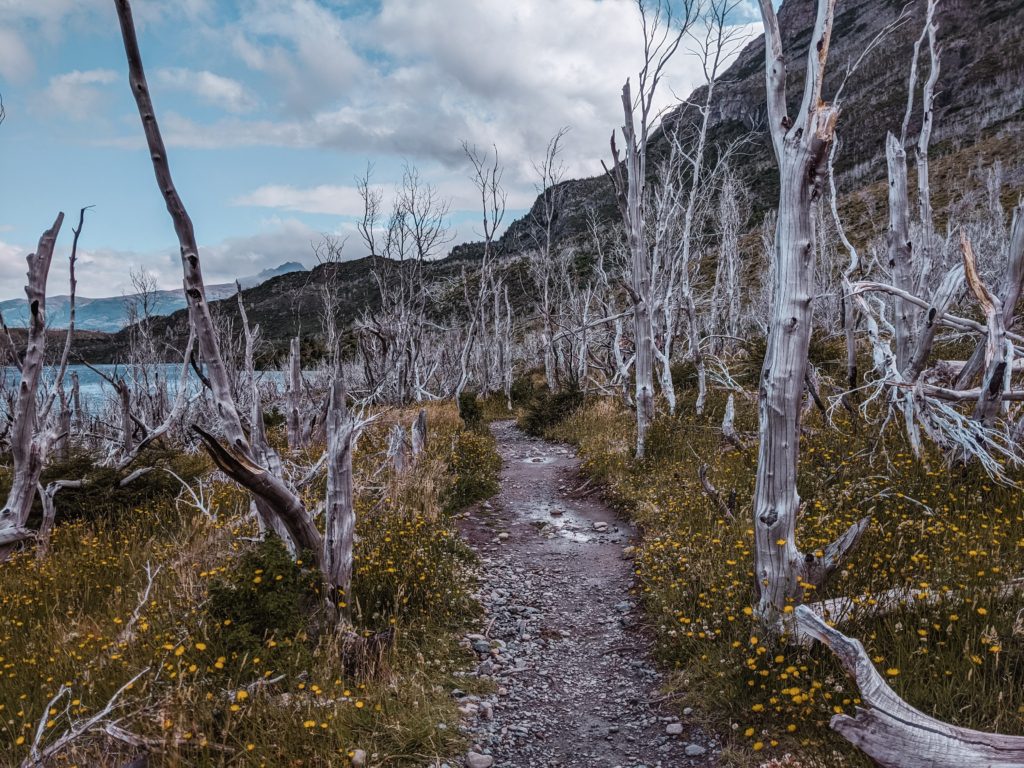
The good news is that there’s zero technical climbing on the W Trek. The trek is on a mix of well-maintained paths, packed mud, loose gravel, and stones. There are some parts where you may need to navigate wet rocks, low streams, and cable bridges, but there’s nothing overly challenging on the route itself in terms of terrain.
7. Is the W Trek difficult?
The W Trek multi-day hike isn’t a cinch, but it’s also not on the same level of difficulty as other world-famous hikes such as Mount Kilimanjaro or Everest Base Camp . So how hard is the W Trek in Patagonia’s Torres del Paine? Well, there’s no technical expertise needed and you don’t have to acclimatize. The trail is well-marked and maintained for a majority of the route. I’d say one of the the biggest challenges is the unpredictable weather, which can change from snow to heavy rain to blazing sun in just a matter of hours. In addition, Torres del Paine is known for its extreme winds which can reach speeds of up to 100 mph (161 kph).
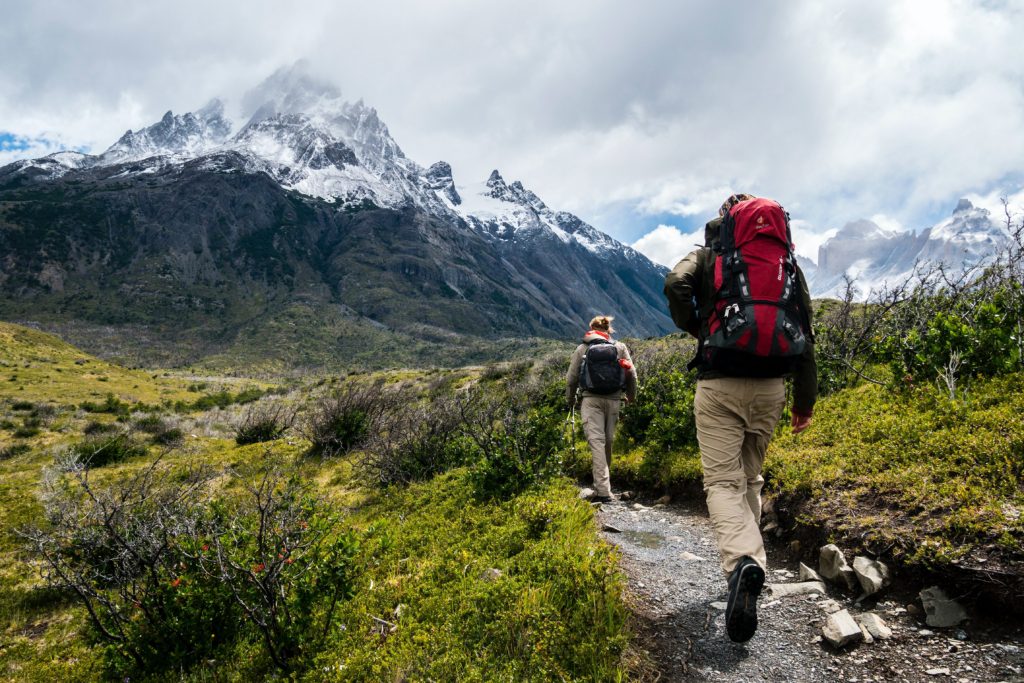
The W Trek also packs a lot of walking into single days. For comparison, you are asked to hike between 6-8 miles (9.7-12.9 kilometers) per day on average on an Inca Trail tour. However, on the W Trek, you can expect to hike between 7.5 miles (12 kilometers) and 15 miles (24 kilometers) per day depending on how your adventure is structured. I highly recommend a training plan that builds in long distances (over 10 miles / 16 kilometers per day) and consecutive day hikes.
8. Preparation for the W Trek
We’ve already mentioned how the W Trek isn’t up there with Kilimanjaro and other high-altitude expeditions. Most trekkers of decent fitness level should be able to complete it with a solid training schedule beforehand. That said, the days are long on this one – some pack in up to 10 hours of hiking across tough terrain that can get tougher when the weather changes.
For that reason, we’d say a good program of regular exercise starting around 12 weeks prior to the start of your hike is always a good idea. Begin with local walks of 2-3 hours and short runs of just a few miles each. By six weeks out, you should be able to up your runs to three miles and complete a hike of 7-9 continuous hours. With three weeks to go, try to double your number of runs and do weekly hikes of at least 7-9 hours each. I also recommend that you begin doing consecutive day hikes at this time and ensure you are wearing a pack with the same weight you will bring with you on the trek. Resistance training can also work wonders for muscle fatigue and recovery, something that’s often an issue with such long days on the W Trek.
9. When is the best time of year to do the W Trek?
The seasons can be very unpredictable this far south in Patagonia. As a general rule, summer (November to March) is better for trekking, making it the peak season for hiking the W Trek in Torres del Paine. That’s because it’s warmer, with midsummer temperatures typically between 43-63°F (6-17°C), and there’s less rain (average of just 4 millimeters each month).
However, it’s not totally clear cut that the summer season is the best time to hike the W Trek. It all depends on your preference and the type of experience you’re looking for. There are way more people hiking the trail so the W Trek lookout points are busier and the mountain huts more expensive. Additionally, high summer winds can spoil a hike in Patagonia so you’ll have to be ready to change plans if the gusts get up to over 80 mph (130 kph) or so.

Autumn (April is a good alternative to the main summer trekking season. The upsides include fewer hikers and beautiful colors on the Patagonian Steppe – think pale yellows, deep oranges, and muted browns rolling out from the base of the mountains. However, there is usually more rainfall and the temperatures at night get low. Keep in mind that the main W Trek route closes on April 30th each year.
Spring (September to November) is another popular time to hike the W Trek but this season can bring the risk of snowfall. This means you’ll need to pack extra thermals. The W Trek route typically opens in mid-September each year. However, a few of the huts are closed until October 1. So, if you want to do the Trek in September you will need to do an amended version.
Winter (May to August) a majority of the huts and campsites along the standard W Trek route are mainly closed due weather conditions and snowfall. However, it is possible to do three of the four segments of the W Trek as out and back hikes by staying in two of the refugios that are open during the Winter months. Also, please note that there are fixed group dates for these excursions and the treks are guided by a professional mountain guide which is required by the National Park for safety reasons.
We offer trips all year long on the W Trek. Click HERE to learn more.
10. What do I need to pack for the W Trek in Patagonia?
What you pack for your W Trek trip will depend on when you decide to visit Torres del Paine to hike the trail, but try packing as light as possible. Travelers in the high season (summer and autumn) won’t need as much thermal gear as those visiting in the low season (spring and winter), when there’s a bigger risk of snow and sub-zero temperatures. That said, every hiker on the W Trek should have a good thermal under-layer, a fleece, and waterproof outer layers for the upper and lower parts of your body . The weather can be pretty wild and unpredictable, even in the height of summer, so it’s a good idea to bring multiple layers to wear .
When it comes to trekking equipment, there are some must-haves: sturdy walking boots, a good set of trekking poles, a high-volume and lightweight water bottle and/or reservoir, sunscreen, and a reliable waterproof trekking backpack . Depending on how you choose to do the trek, you may also need camping equipment and a sleeping bag. Note: when booking with us, sleeping bags will be ready for you in both the mountain hut and/or tent at each sector. And depending on the trip package that you book, you may receive a ‘welcome kit’ containing a sleeping bag liner, microfiber towel, water bottle, and map.
Also, drinking water is not treated at huts/campsites along the trail. Many hikers feel comfortable drinking the water along the route (including from rivers or streams). But, if you prefer additional protection and peace of mind, you can certainly bring your own portable water filter (e.g. Katadyn BeFree, LifeStraw, Grayl, Sawyer Squeeze, etc.). Some of these systems only weigh a few ounces!
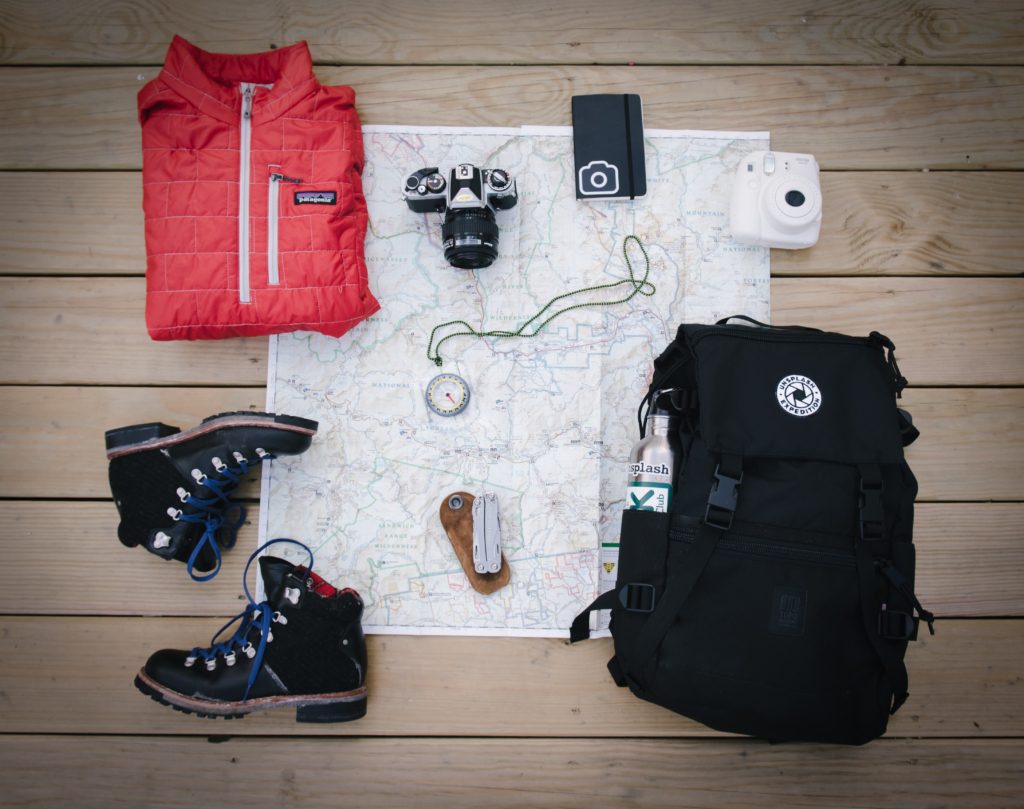
Some hikers will go for a porter service on their W Trek trip to help carry baggage and equipment. That’s an optional extra with most providers. A porter on the W Trek will typically carry 33 pounds (15 kilograms) of your clothing and gear. Keep in mind that if you do decide to get a porter, you won’t need one on the Base Towers hike as this day is an out and back trek. In addition, if you are doing the 4-day trek from East to West you also won’t need a porter for the last day as you can pay a small fee to leave your baggage at Paine Grande while you trek to Grey.
My team at The Explorer’s Passage makes it easy for trekkers who plan their travels with us. Because the requirements for the W Trek change with the seasons and the sort of trek you go for, we can provide our guests with a full packing list so they’re fully prepared – just ask us !
11. Accommodations: where to stay on the W Trek
There are a number of options when it comes to accommodations on the W Trek. Depending on the sector you are staying in, the options include standard camping, premium camping, cabanas, refugios / mountain huts, and hotels. I’m going to describe each of these options in greater detail below:
Standard Campsites
For the most part, the campsites on the W Trek are of very high quality, at least for true backcountry camps. They’re well equipped with all the things that trekkers might need, and even have extras that you could only dream of in the far-flung basecamps of other major trails. Take the site at Paine Grande, for instance: it has hot showers during designated times each day, bathrooms, access to the restaurant and bar at Refugio Paine Grande, and even pay-as-you-go Wi-Fi. At the various campsites, some of the tents are set up on the ground and others are set up on wooden platforms.
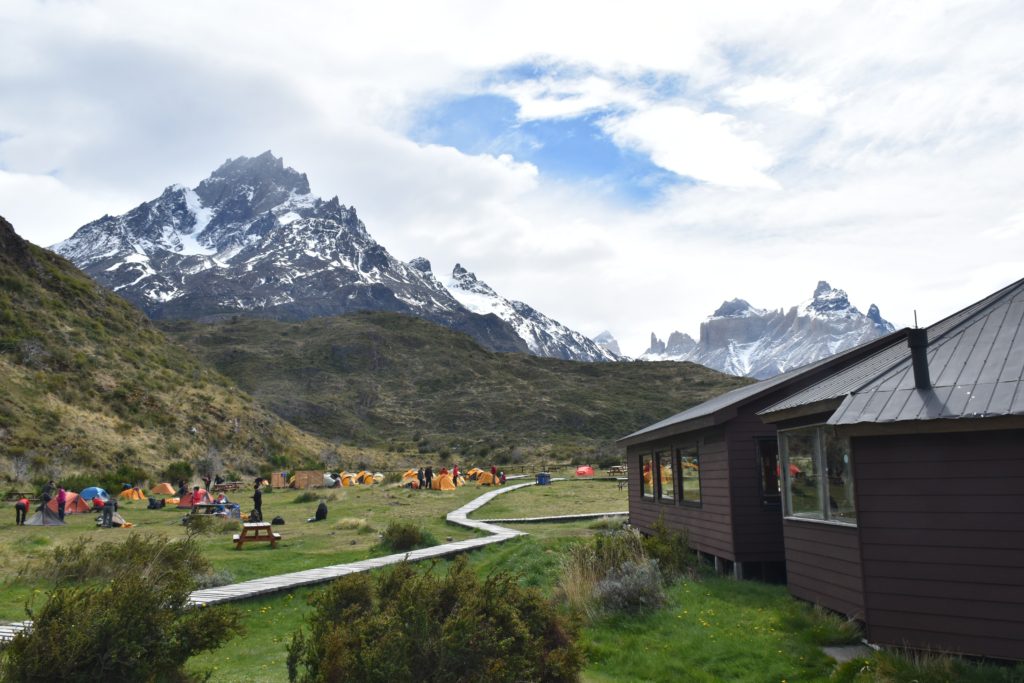
Premium Camping
A few of the campsites on the W Trek circuit have a newer concept known as premium camping, which consists of a raised tent approximately 6 feet (1.8 meters) off the ground and has a ladder for access. The tents in premium camping are larger and sturdier than in standard camping, and there is no need for mattress pads as the entire base floor of the tent consists of a ~3-inch (7.6-millimeter) comfortable pad. Currently, premium camping is currently available at Chileno and Francés Sectors but there are plans to bring this concept to more sectors (such as Central Sector) on the W Trek in the coming years.

Cabanas (cabins)
At Cuernos Sector there is a wonderful accommodation option known as cabanas (cabins). They are mini villas that dot the landscape around the main refugio building and are private accommodations that can fit 1-3 people. There are bathrooms and showers that are shared by all guests who are staying in the cabanas.
Most of our guests doing the East to West W Trek hike directly from Central Sector to Francés Sector on Day 2 of their hike, which is ~11.5 miles (18.5 kilometers). Chileno is located ~9.5 miles (15.3 kilometers) from Central Sector and is 2 miles (3.2 kilometers) short of Francés Sector. So, if you would like private indoor accommodations, then you can sleep in a cabana (cabin) at Cuernos for the evening. Just note that if you do choose to sleep at Cuernos on Day 2 of your trek then it will tack on ~2 miles (3.2 kilometers) to your trip on Day 3 of your hike.
Refugios / Mountain Huts
Refugio is the local name for a refuge or shelter that’s essentially a mountain hut or lodge that offers dorm-style (bunk beds) accommodations along the W Trek. Refugios are rustic but comfy, and typically have warm communal areas with dining halls where you can meet and mingle with other trekkers. The bathrooms and showers at the refugios are communal.
Some of the refugios have bar areas, like Central and Paine Grande sectors. Many of the refugios have small shops where you can purchase an assortment of goods such as water, soda, energy bars, eggs, noodles, toothpaste, toothbrush, and clothing. All of the main refugios on the W Circuit have Wi-Fi for an additional fee as well. Depending on which sector you are in, the number of people per room will differ. The room size on the W Circuit ranges from 4-8 people.
Hotels
On the standard W Trek route there is only one hotel option, Hotel Las Torres, which is located in the Central Sector. Hotel Las Torres is a very nice 4-star hotel located approximately 100 yards (nearly a meter) from the refugio and camping area at Central sector.
If you are doing the East to West Route, then you will most likely be spending two nights in the Central Sector as your first day of hiking is an out and back trek. We have many guests who stay at Hotel Las Torres for the first two nights of their journey, then do either camping or huts for the remainder of the trip.
Please note that EcoCamp is located in the Central Sector. While not a traditional hotel, EcoCamp consists of luxury domes of different sizes and amenities. We have many guests that stay in EcoCamp for a few nights as part of their W Trek journey.

If you would prefer to stay in a hotel every night while in Torres del Paine, there are six wonderful hotels that offer all-inclusive programs for their guests. Please note: If you stay in one of these hotels you won’t be able to do the full W Trek. However, you will be able to do some of the W Trek segment hikes as guided day trips with vehicle / boat support to the trail heads. At the all-inclusive hotels in Torres del Paine, you get to choose between a range of guided hikes and adventure activities, many of which are included as part of your package.
Below is a list of the main all-inclusive hotel properties in Torres del Paine:
Hotel Las Torres 4-Star Hotel Located in the Central Sector, 100 yards (~1 meter) from the Central refugio and camping
Hotel Lago Grey 4-Star Hotel Located in between the south shore of Grey Lake and Lake Pehoé
Explora Lodge 5-Star Hotel Located near the southern shores of Lake Pehoé
EcoCamp Patagonia 5-Star Domes Located on a hilltop overlooking the Central Sector
Tierra Patagonia Hotel & Spa 5-Star Hotel Located in on the Eastern shore of Lake Sarmiento de Gamboa
Awasi Patagonia 5+ Star Hotel with 14 private villas Located East of the Central Sector in a private reserve
The W Trek is punctuated with a host of rest areas and the conventional plan of the hike makes use of seven of these Sectors along the way. Let’s take a closer look at each rest site:
- Central Sector – The Central Sector is the base of operations on the eastern side of the W Trek. It’s often used as the starting point or ending point of the entire W Trek journey and is one of the most developed sites in Torres del Paine.
Accommodations at Central Sector include camping, two mountain huts/refugios (Central Refugio & Torre), EcoCamp Dome, and Hotel Las Torres. In the camping area, there is standard camping, which has hot showers, bathrooms, and designated picnic tables. It is expected that premium camping will be added in the near future in the Central Sector. The refugio in the Central Sector has a large common area that has a very fun and social atmosphere so you can meet people from all across the globe. It has 6-person hut rooms, communal bathrooms and showers, and a restaurant and bar area.
Hotel Las Torres is situated 100 yards (~1 meter) from the camping and refugio in the direction of the Las Torres Base Hike. The EcoCamp domes are situated on a hilltop overlooking the entire Central Sector.
- Chileno – Chileno is wedged into the narrow valley that runs north to the base of Las Torres themselves. It-s a pit stop before or after seeing arguably the greatest vista on the W Trek and the location is one to match – scenes of snow-capped peaks and cascading pine woods dominate on both sides. The site is much like the Central Sector, with standard camping and a refugio. The refugio has 6-person hut rooms. Chileno has premium camping as well. There are communal bathrooms, showers, and a small restaurant. It’s a quality lodge with a fantastic outdoor area by a roaring river.
- Los Cuernos – You’ll be greeted with sweeping 180-degree views of glimmering Lake Nordenskjöld when you enter Cuernos sector. It is set on a soft slope right under the twisted tops of Los Cuernos massif itself. In true Patagonia style, it’s well appointed with standard camping, a refugio, and a series of 20 private cabanas (cabins) that are situated in the beautiful terrain throughout the sector. The refugio has 6-person hut rooms. Cuernos has an onsite bar, restaurant, and a snack kiosk, as well as communal bathrooms and showers, and Wi-Fi.
- Francés – Remember when we said that the French Valley was one of our top highlights on the whole W Trek? Well…the Francés Sector is the gateway to it all. Just 2 miles (3.2 kilometers) to the west of Los Cuernos, it’s an alternative midway option for hikers wanting to enter that secret Shangri-La of the Andes. The site has standard camping, premium camping, and 8-person dome huts. It’s also just as comfy as the other sites listed here, complete with hot showers, bathrooms, a restaurant, shop, and wifi.
- Italiano – This campground on the main course of the W Trek is a free-to-camp alternative at the base of the French Valley. Because it’s free, don’t expect the same amenities and frills as in the sites on the W Circuit. The basics are all taken care of: Running water, toilets, and a cooking shelter. We rarely have guests stay at this site as it is very basic, but our trekkers primarily use it as a location to drop their bags off for the up-and-back excursion into the French Valley.
- Paine Grande – There’s a pretty slick lodge at the Paine Grande sector on the edge of Lake Pehoé that some trekkers use as the first point of call on the W Trek if doing the West to East Route. The site has a large standard camping site with space for over 200 campers and 4- or 6-person hut rooms. There are communal bathrooms, showers, a shop with an extensive assortment of items, and a large restaurant area. Don’t miss the onsite Paine Grande Bar here – it’s a chance for a pre- or post-trek drink overlooking the serrated Paine Grande Massif.
- Grey – Grey sector marks the western end of the W Trek and, as such, is an important starting point, not to mention connecting point for those looking to join with the larger O Trek. The lodge here is one of the best on the trail. It’s got 60 beds in 4- and 6-person rooms, and a cozy restaurant and bar area to enjoy after dark. The campground has room for 120 people in standard camping and offers a covered cooking space and shared toilets. There’s paid Wi-Fi if you need it as well.
One important item to note is that if your group size is below the minimum room s ize in the refugios, then other travelers will fill the empty spots on the rooms. Guests are not permitted to purchase the extra room spaces to create a private room.
Since the sectors are run by three different companies and itineraries often require a separate reservation, booking accommodations for the W Trek can be a chore. It doesn’t have to be, though! The Explorer’s Passage makes visiting Torres del Paine easy. Book your trip to Patagonia with us and let us take the stress out of planning so you can focus on hiking the W Trek. Also, with us, all meals are included from the start of the hike to the finish.
12. W Trek permits
In planning this journey, you may ask yourself “Do I need a permit for the W Trek?” Although you’ll need an entrance ticket to enter Torres del Paine National Park, there’s no official permit system for the W Trek as there is for the classic Inca Trail route to Machu Picchu. There are, however, capacity limitations on the number of trekkers that are permitted to stay in the park’s campsites, huts, cabanas (cabins), and hotels. That acts as a sort of de facto limit on the number of people who can do the trek, governed mainly by who was quick enough to book their accommodations.
My advice? Start planning early to avoid disappointment. The huts, campsites, and cabanas (cabins) go on sale in May and June each year for the upcoming trekking season which typically goes from September 8 to April 30. Spaces in Central, Chileno, Cuernos, and Francés Sectors are typically released in early to mid May. Spaces for Paine Grande and Grey sectors are typically released in early to mid June. I typically recommend that our guests try to get their bookings in before the first release dates to ensure they get their desired spots.
If you would like help with this process, you can plan to travel with us and our experienced team will take care of all the important details for you, including campsite, hut, cabana (cabin), and hotel bookings, meals, National Park permits, transfers, gear rentals, and much more.
13. Getting to the start of the W Trek
Most people start the W Trek hike with an organized bus transfer from the city of Puerto Natales to Torres del Paine National Park.
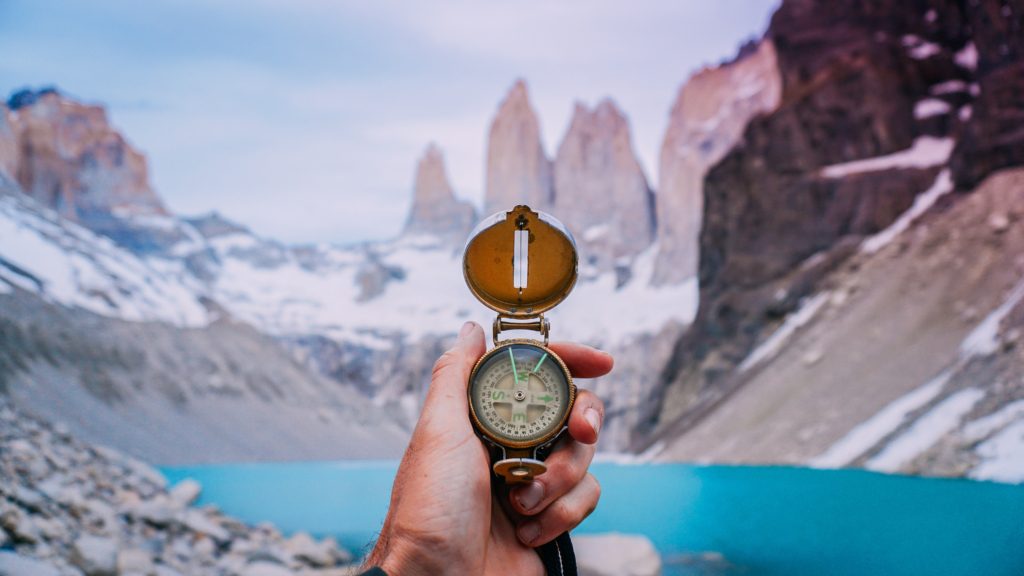
Your journey to the trailhead of the W Trek will depend on which direction you will be hiking it: either from East-to-West, or vice versa. At The Explorer’s Passage, we recommend East-to-West, primarily because you get the hardest day of hiking (to and from Las Torres Lookout Point) out of the way on the first full day, when your legs are still fresh. However, some prefer to save the view of these granite towers as a reward for the final day, so they start the journey in the West and head East. As with all adventures, there are pros and cons to each option!
- To hike the W Trek from East to West, you will get off the bus at the National Park office at Laguna Amarga, then take a connecting bus to the Welcome Center at Central Sector.
- To hike the W Trek from West to East, you can get off at the Pudeto stop and catch the catamaran across Lake Pehoé to the refugio at Paine Grande. There are boat departures throughout the day, but be sure to check the schedule before you depart because they can change at short notice.
All of the above trips can be done from Punta Arenas , but expect transfer times to the trailhead to be in the region of five to six hours, instead of a 2-3 hour bus ride from Puerto Natales.
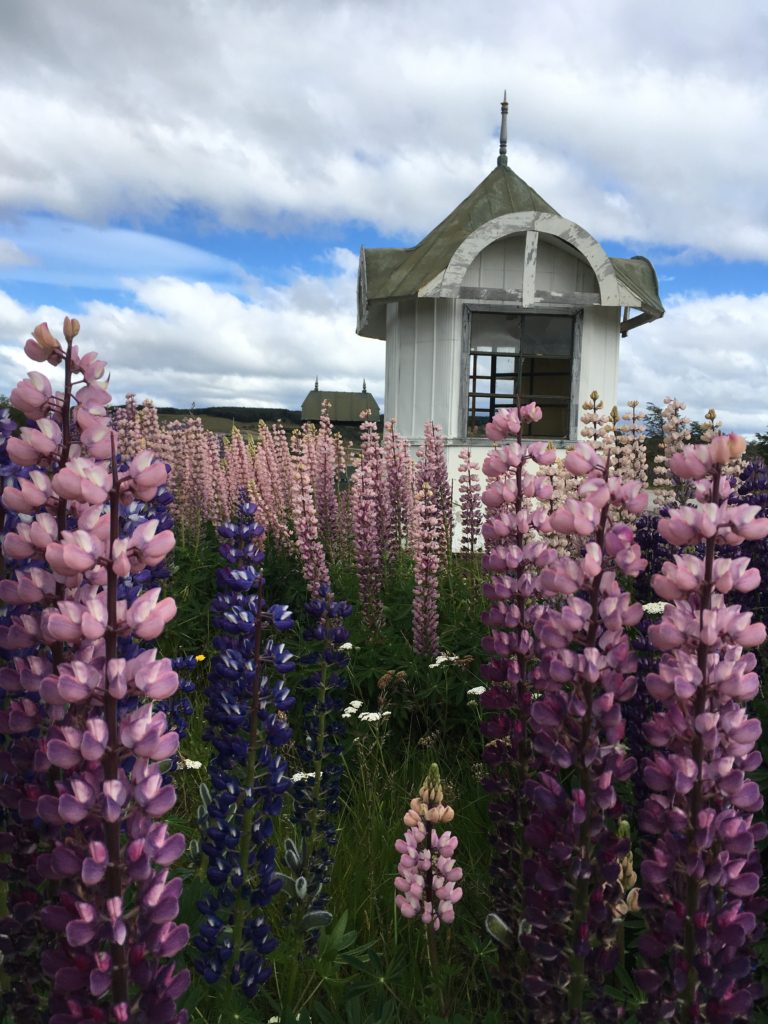
14. Sample W Trek 4-Day Hike itinerary
As noted in the prior section, at The Explorer’s Passage we recommend hiking the W Trek from East to West. Below you will find a sample itinerary for this option (visit our W Trek trip page to download a full detailed itinerary):
- Day 1: Puerto Natales to Torres del Paine National Park – After breakfast at your hotel in Puerto Natales, you will have the morning to explore the town a bit more. Later, you will travel by bus to Torres del Paine National Park. Enjoy dinner in the Central Sector as the excitement builds for the days ahead, where you will have the rare privilege of exploring one of the planet’s most striking national parks!
- Day 2: First Day of W Trek (Las Torres Lookout) – Today, you will start early and begin your hike of the W Trek – one of South America’s most famous trails. Today’s destination is the iconic Las Torres Lookout Point! During the first stretch, you will walk through the pampa, cross the Ascencio River, and then hike up to Los Vientos Mountain Pass, where you will enjoy amazing views of the valley and lakes. You will continue your journey to the Chileno Mountain Refuge, and then go deep into a lenga beech forest up to La Morrena, where the hardest part of the day’s hike begins. From there, you will follow a rock trail to the spectacular Las Torres Base Lookout Point. Later, you will return to the Central Sector to have dinner and rest.
- Day 3: Second Day of W Trek (Nordenskjöld Lake & Francés Sector) – Today is your 2nd full day of hiking the W Trek. You will walk along the shores of Nordenskjöld Lake, below the peaks of Almirante Nieto and the striking Cuernos del Paine. During the hike, you will enjoy magnificent views of Los Cuernos, hanging glaciers, lakes, and the abundant vegetation and wildlife. You will have dinner and sleep in the Francés Sector.
- Day 4: Third Day of W Trek (French Valley) – This day features one of the most memorable portions of the W Trek: the Valle Francés. You will start early with a light hike to the Italiano Campsite. From there, you will progress through the woods up the Francés River Valley. You will continue to the Francés Lookout Point, where you will enjoy one of the most breathtaking views of the trek: the view of the valley framed by the Paine Grande, Catedral, Hoja, Máscara, Espada, Aleta de Tiburón, and Cuerno del Norte mountains. The landscape will undoubtedly leave you speechless! Later, you will begin the descent to the Paine Grande Sector for the evening.
- Note: we can arrange optional add-on excursions in the Grey Glacier area if you are interested: kayaking (~3 hour activity) and/or ice hiking (~5 hour activity). These activities will require an additional day to your itinerary, as you would need to sleep in Grey Sector for the evening.
If you prefer to hike the W Trek from West to East, culminating with an up-close encounter with the iconic towers themselves, here is a sample itinerary:
- Day 1: Puerto Natales to Torres del Paine National Park – You wake up early in Puerto Natales for an early transfer to Torres del Paine National Park and then take a boat boat navigation across Lake Pehoe to the Paine Grande Sector. From there, you begin hiking North to Grey Sector. This is your first chance to catch a glimpse of the famous Torres massif, with a broadside of the twisted tops of the Cerro Paine Grande. Once you reach Grey Sector, you break for lunch and turnaround to hike back to Paine Grande Sector. The W Trek hike starts by skirting the milky waters of Grey Lake going southwards. This is right beneath the Cerro Paine Grande and the Paine Horns, which are some of the most famous mountain summits in South America. I’d recommend taking some time to visit the Mirador Glaciar Grey on both the walk to Grey Sector and again back to Paine Grande. This location has some of the best views of the entire W Trek. If you have time for 5 days of hiking in Torres del Paine, you can lengthen your itinerary and stay in Grey Sector (huts or camping) for one evening. This would also give you the ability to either participate in either or both the kayaking or ice trek activities.
- Day 2: Second Day of W Trek (Paine Grande to French Valley) – For many, this day is the highlight of the whole W Trek. The path bends eastwards and north from your second campsite, taking you deep into the heart of the Torres del Paine National Park. The first step is the trek along the south side of the massif to the Italiano campsite. You can leave your main bags there for the expedition into the French Valley. Then, take the north spur into that famous cleft in the Andes, which soon becomes a lush land of twisted pine trees and meadows beneath the hanging French Glacier. If the group is walking well, the aim will be the jaw-dropping Mirador Británico at the end of the valley, all before a return to the Frances Sector hut and campsite complex.
- Day 3: Third Day of W Trek (Nordenskjöld Lake and Francés Sector) – You’re now back to skirting the southern edge of the Torres del Paine. Head east from Frances Sector and join the path that circles Nordenskjöld Lake (Lago Nordenskjöld). It will take much of the day to link up to your next W Trek overnight spot (the Central Sector), but there are some fantastic lookouts along the way. They’ll put the high peaks of the Torres just behind and the rolling tundra of Chilean Patagonia in front, not to mention the placid waters of numerous alpine waters in the foreground.
- Day 4: Fourth Day of W Trek (Las Torres Lookout) – After an early morning start, you will begin a tough uphill ascent through the craggy easternmost valley of the Torres massif. It’s steep but opens the way to the Mirador Las Torres, which is surely one of the most unforgettable viewpoints on the planet! There, you’ll see the three jagged peaks that give this region its name and reputation, jutting straight up from pearly blue waters. You should finish with photos around mid-morning, because you’ll be descending back down to the Central Sector and then to Laguna Amarga (National Park Station) to board a bus back south to Puerto Natales.
These sample itineraries are just a start and the opportunities are endless. Regardless of whether you’re traveling solo or in a group of any size, our expert Adventure Consultants will craft extraordinary itineraries for your private travel needs. See how to get the ball rolling on your private travel dreams here .
15. The 5-Day W Trek Circuit
The W Trek circuit is often completed in four full days of trekking. However, approximately 50% of our travelers elect to do it in five days and spend a night at the Grey Mountain Refuge by Grey Glacier, staying in either camping or in huts.
With this 5-day hike option, the typical fourth day of the standard 4-Day route’s 15-mile (24-kilometer) hike is essentially split in half and shared between Days 4 and 5: from Paine Grande Sector to Grey Sector on the fourth day and then back to Paine Grande Sector the next day to catch the catamaran across Lake Pehoé.
Trekkers who select the 5-day option and spend a night in Grey Sector also have the opportunity to take an ice trekking excursion on Grey Glacier (with crampons and ice axes) or go kayaking in Grey Lake, with amazing views of the massive glacier. Both of these adventure activities are offered multiple times per day, and are a great way to complement a trek in Torres del Paine. In addition, if you stay at Grey Sector for one evening then you have an opportunity to explore the famous “Three Bridges” which are massive suspension bridges that begin approximately 1 mile north of Grey Sector.
16. W Trek Express
Most experts agree that the W Trek is the single most incredible trek in the whole of Patagonia, both on the Argentinian and Chilean sides of the border. However, not all travelers have the time to complete the entire adventure, which is why a more condensed version of the W Trek is offered.
Cue the W Trek Express route. This cuts down your travel time by one day but still ensures you get to see all the legendary parts. Your travel from Puerto Natales to Torres del Paine will take place in the morning on the same day that you begin trekking. It runs East to West, starting with the dramatic outlook over the Torres del Paine on an up-and-back route. Day two skirts the top end of Nordenskjöld Lake beneath the amazing Los Cuernos peaks. Day three is another there-and-back hike into the heart of the French Valley before a final day that whisks you across Lake Pehoé to be collected.
The whole Express W Trek can be self-guided or guided and done with hut accommodation or camping.
17. Alternative routes to the W Trek (O Circuit and Q Circuit)
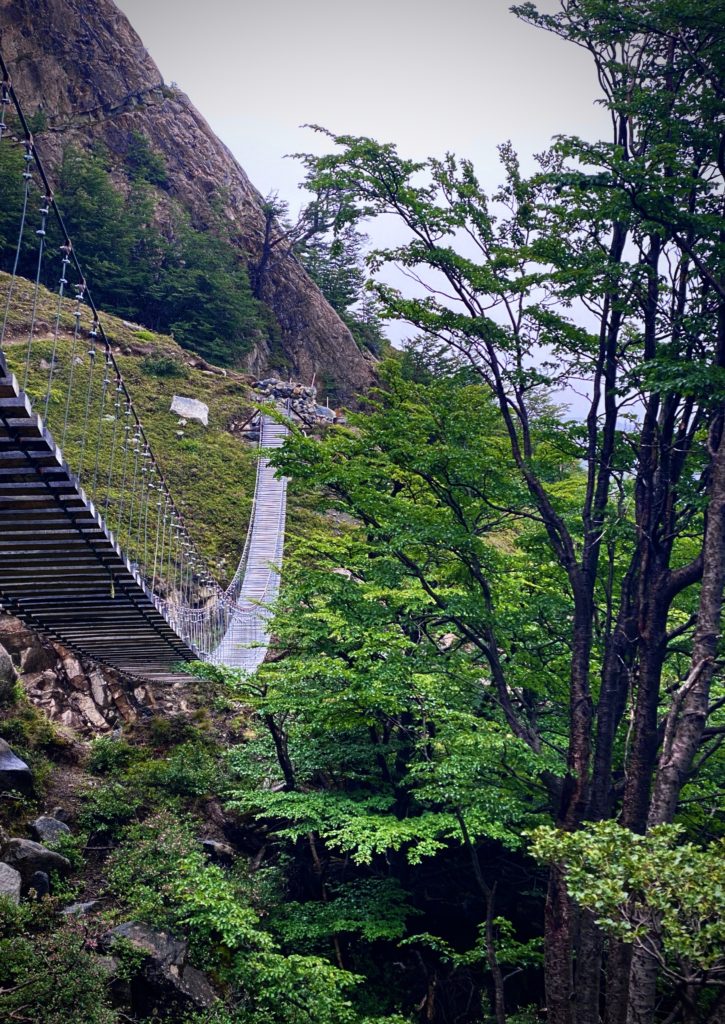
The W Trek may be the most popular trail in Torres del Paine but it certainly isn’t the only walking route that will let you experience this awesome corner of Chilean Patagonia. Usually open from November to April, there are also two route extensions that take you counterclockwise on the trail but promise to whisk you even higher into the clouds as you explore the mountains and glaciers. They are:
- The O Circuit (8-10 days) – Also known as the Paine Circuit, the O trek is the full circuit around the Cordillera del Paine mountains within the national park and includes the W route. It’s definitely a tougher and longer route, but its lesser traveled 74 miles (119 kilometers) of pure Patagonian wilderness will take you to the heights of the John Gardner Pass at about 4,000 feet (1,219 meters) above sea level. The O Circuit trail highlights you’ll see include the reflective Lago Paine, a mesmerizingly turquoise lake, and the mountains from the northern section of the park.
- The Q Circuit (9-11 days) – The Q Circuit is the longer version of the O Circuit. The Q route includes one extra day of trekking past Lake Pehoé. This one’s for the most dedicated of trekkers who have the most time (and money) to spare.
If you have more time to spare and are up for an extended trek, definitely try out one of the treks above.
18. Where to go after the W Trek
You’ve got a few options for onward travel once you’ve finished the W Trek. The most obvious and popular place that hikers return to is Puerto Natales. Many trek packages even include a drop-off back in that town, which has become a bit of a buzzy outdoors hub in recent years, touting craft beer emporiums and wine tasting establishments. Puerto Natales also happens to be the best base for launching boat trips through the stunning fjords of Chilean Patagonia, including to the far-flung Tierra del Fuego for penguin watching and the Serrano Glacier a little closer by.
You might also want to use this opportunity to cross over into Argentinian Patagonia. The W Trek takes you very close to the border and there are regular buses that make the trip up to El Calafate (6 hours) or you could do a private transfer to El Chaltén (6 hours) from Puerto Natales. Both locations are top options for continuing your adventures through the Andes, opening up hikes under the Fitz Roy (arguably the most famous mountain in Argentina) and visits to the Perito Moreno Glacier (a UNESCO site that showcases huge chunks of ice peeling off a glacier tongue).

19. Visas for Chile
There’s a long list of 90 countries that get visa-free access to Chile, including virtually all of the European Union, the United Kingdom, and the United States. That means administrative work at the border or prior to departure shouldn’t be too much of an issue if you’ve got your heart set on the W Trek. Notable exceptions include Australian citizens, who are no longer charged a hefty reciprocity fee when they enter but do need to go through the process of pre-applying for a single- or multiple-entry visa. All travelers should have at least six months’ validity left on their passport before traveling.
So there you have it, a comprehensive guide to 19 things you should know before hiking the W Trek in Chilean Patagonia! I hope this post has provided you with the necessary information to help you begin planning a truly memorable adventure tour to Chile. If you feel inspired, here are the other best places to visit in Chile .

This guide has covered a lot, but you may have more questions on hiking the W Trek in Torres del Paine. If so, my experienced team here at The Explorer’s Passage would love to hear from you so please contact us and let’s chat .
We have been running trips and treks to Chile for 10 years. We pride ourselves on delivering extraordinary tours based on travelers’ needs and are humbled by our guests’ testimonials . In fact, our dedication has earned us a 5-star rating on Tripadvisor , and awards by Travel+Leisure Magazine and Newsweek. Check us out and discover why so many travelers worldwide choose us . My team and I would love for you to join us on the W Trek or any of our other adventures !
I hope to go exploring with you soon!
Jeff Bonaldi Founder & CEO The Explorer’s Passage
About Jeff Bonaldi
Jeff Bonaldi is the Founder and CEO of The Explorer’s Passage, a premier adventure travel company. His mission is to provide travelers with the opportunity to transform their lives and the planet through the power of adventure.
Learn more about Jeff’s story and his company HERE .
Share This Amazing Location!
Related posts.
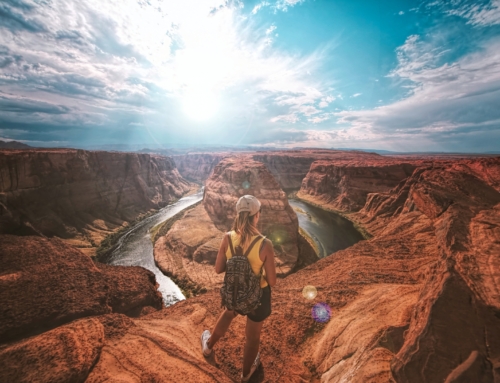
Expert Guide to Solo Travel & Top Destinations in 2024

Everest Base Camp Trek – 13 Things to Know for Your Trip in 2024
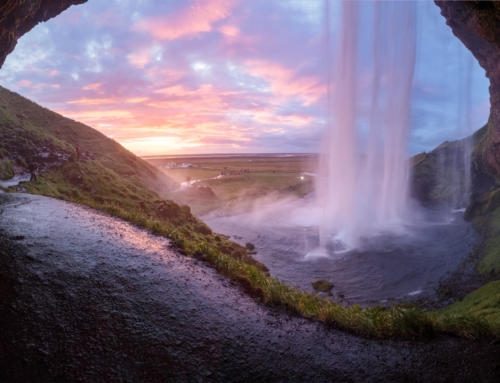
14 Best Places to Visit in Iceland in 2024

14 Things to Know Before You Climb Mount Kilimanjaro in 2024

The Ultimate Guide to Inca Trail Permits for 2024
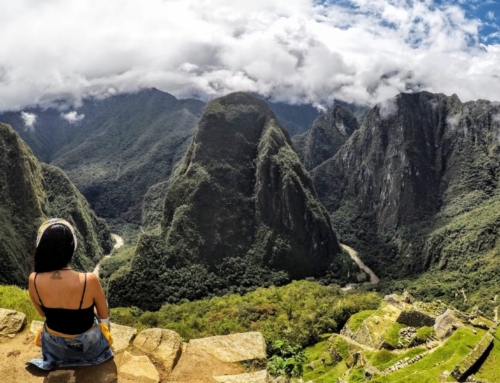
The Classic Inca Trail Route: A Day by Day Guide

- Standard Domes
- Superior Domes
- Suite Domes
- Suite Dome Loft
- Yoga & Wellness
- 7 Day W Trek
- 7 Day W Trek - Brush Variant
- 5 Day W Trek
- Wildlife Safari
- Epic Patagonia
- Puma Tracking
- 9 Day Paine Circuit
- Green Ethos
- Social Commitment
- Cultural Preservation
- Torres del Paine
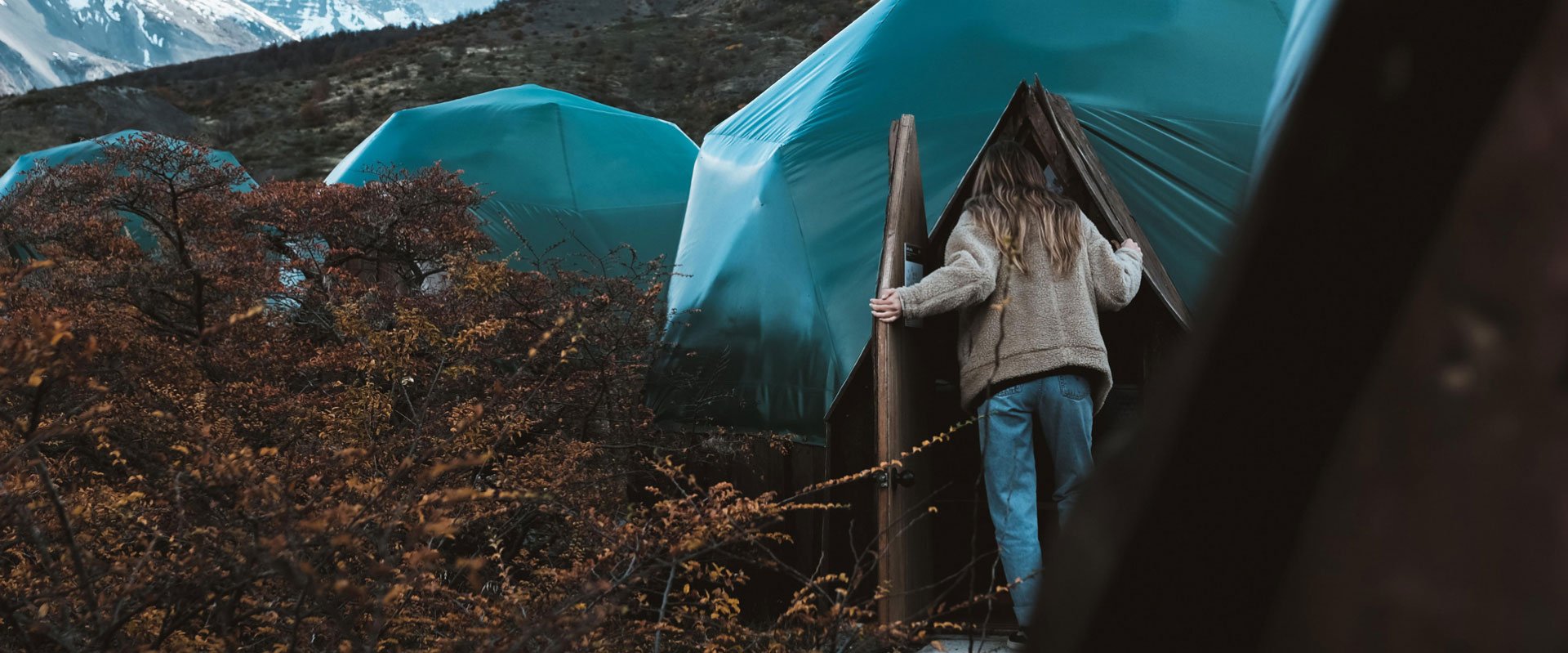
8 Reasons Why Winter is the Most Epic Time to hike
Those who hiked the W Trek in high season should know what I’m talking about. Whenever you’re lucky with the weather, you can experience pretty high temperatures and hike some of the world’s most beautiful trails if you visit Patagonia in summertime (December to February). Yet you may meet hundreds of fellow hikers, experience (very) strong windgusts and struggle to get your space in one of the refuges / campsites (booking with anticipation is strongly advised).
Winter (May to August) is another story. It may be colder than other months, yet you will be able to experience the real wild Patagonia and a unique feeling of quietness at the feet of snow-covered mountains. And if you’re still not convinced, here’s why we believe Winter is simply the most epic time to come and do the W Trek .
1. The Trails are Quiet
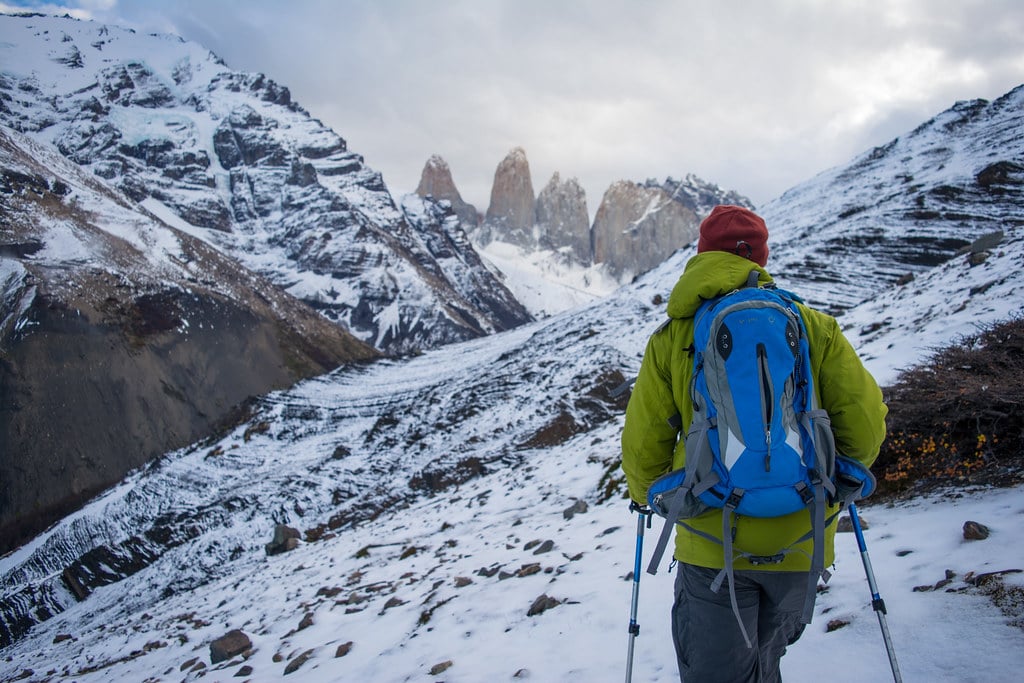
With about 250.000 people visiting Torres Del Paine every year, this incredible National Park became so famous some trails like the towers’ base and the Frenchman's Valley may be truly crowded in Peak season (especially January and February). Yet you can’t imagine how different it is in Winter. It gives you space, time, no stress and believe me: the viewpoints look even more beautiful with less people.
2. There is More Wildlife
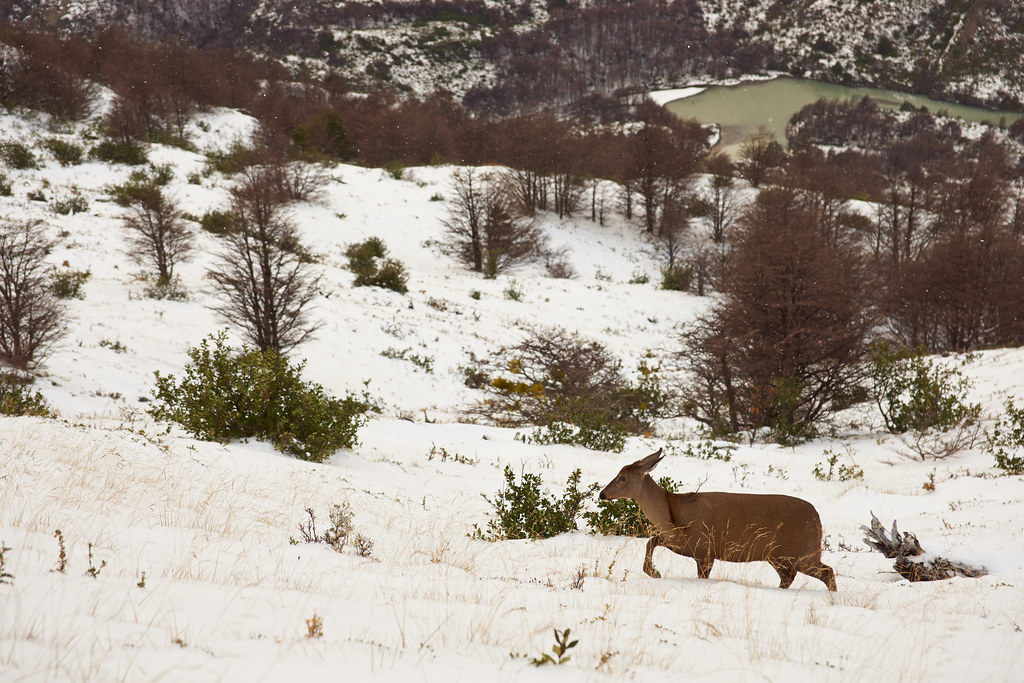
For some reasons winter months attract lots of Wildlife photographers and it is easy to understand why. With less people on the roads, pumas come closer and are way easier to spot. Same thing on the trails: you are not guaranteed to see rare animals, yet your chances to see a Huemul (an endangered local deer) or a Puma are much higher.
3. Mountains Look More Impressive
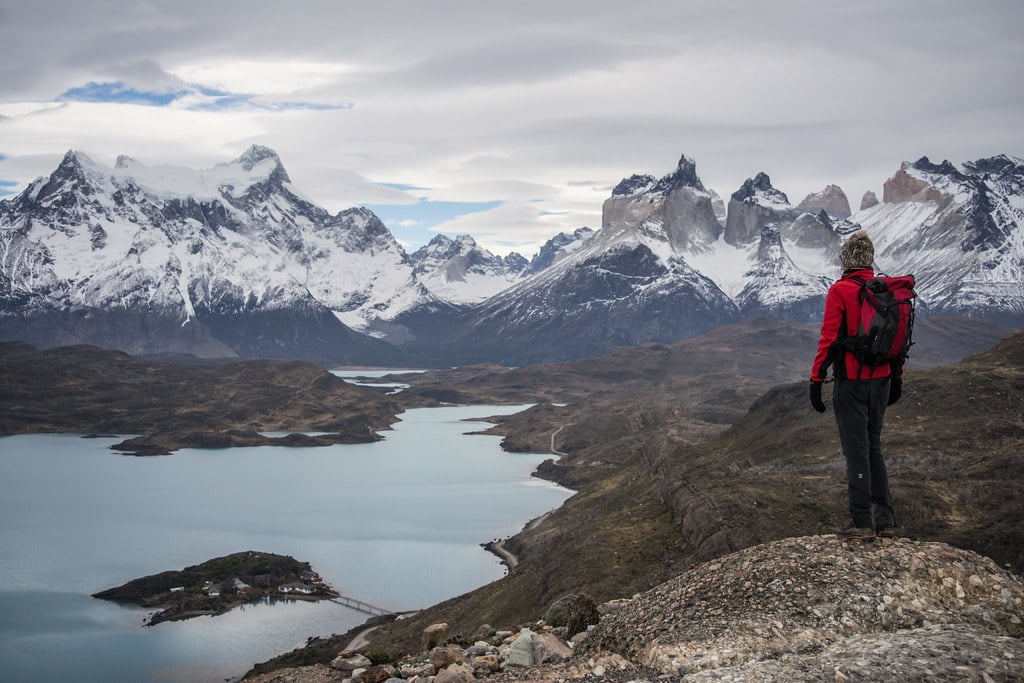
Those who love the mountains know that: mountains look always more dramatic when there is snow on the top. If you’re lucky, you might experience the biggest avalanches of the season, just like in this video shot in July (no worries, no risk to get stuck in an avalanche on the trails). Glaciers look bigger, making the granite peaks of Torres del Paine look like giants emerging from the ice.
4. Campsites and Refuges are More Accessible
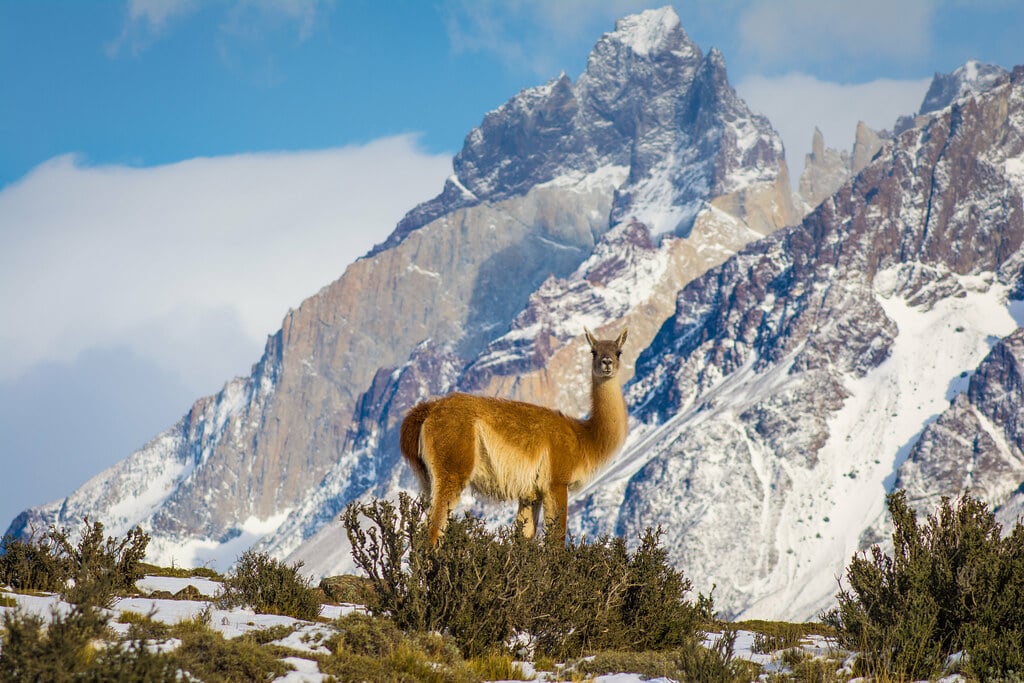
Hiking the W Trek or Torres del Paine Circuit in Peak Season can quickly become painful if you haven’t done the reservation with anticipation. Campsites may be full and getting space for your tent (or a bed in a refuge) is not as easy as it was years ago. In Winter, you won’t lose time struggling for a place to stay. You should even get a warm bed in a cozy dormitory which will make you incredibly happy to have come during that period.
5. Winter is the Best Time for Photography
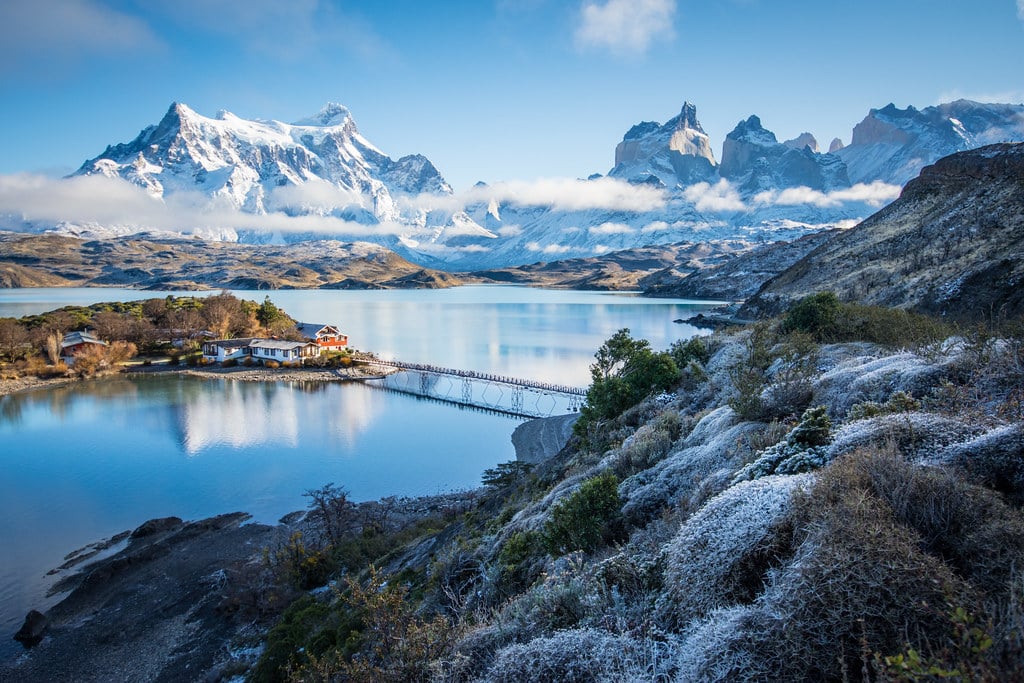
If you want to get dramatic shots of snowcapped mountains, foggy hills and incredible reflections, come in Winter (Fall is also a good option). Landscapes are way more photogenic with less wind and less people, and the changing weather makes it for epic shots. Even though you may get some rain / snow, photographers know the best time to immortalize the mountains is right after the storm.
6. You Will See Otherworldly Sunrises…
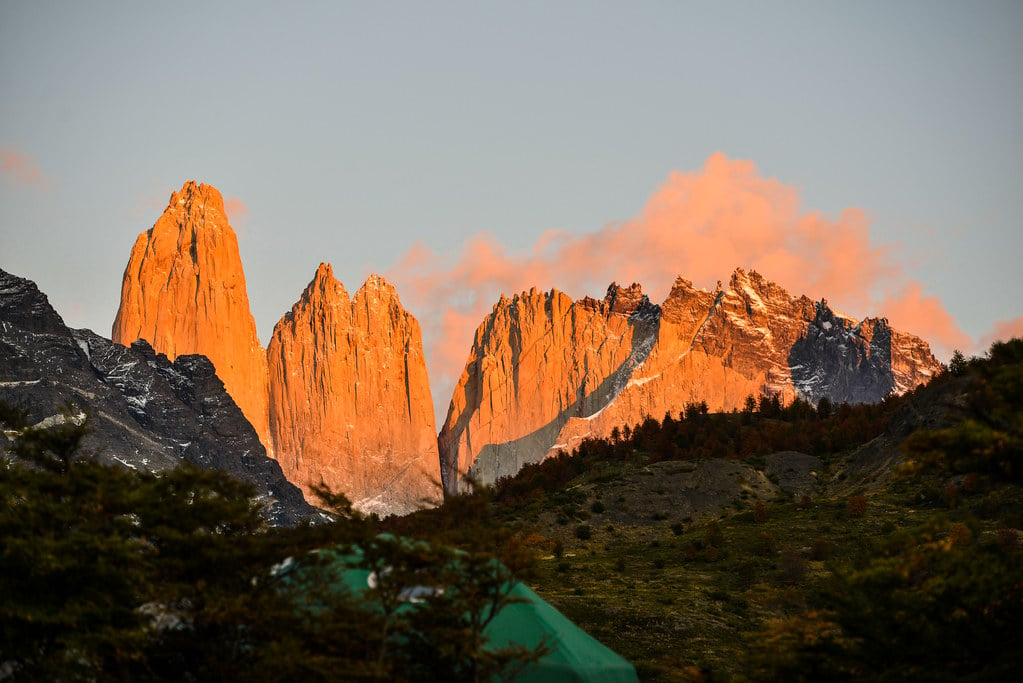
…and sunsets. With less than 7 hours of daylight a day, you may have to walk in the darkness if you want to reach the National Park’s best viewpoints with the sun at its peak. However you may see the mountains painted in red every day (depending on climatic conditions) thanks to the position of the sun at that time of the year and unlike during Summer months, you won’t have to wake up at 1am to see epic sunrises.
7. You Will Experience a Real Adventure
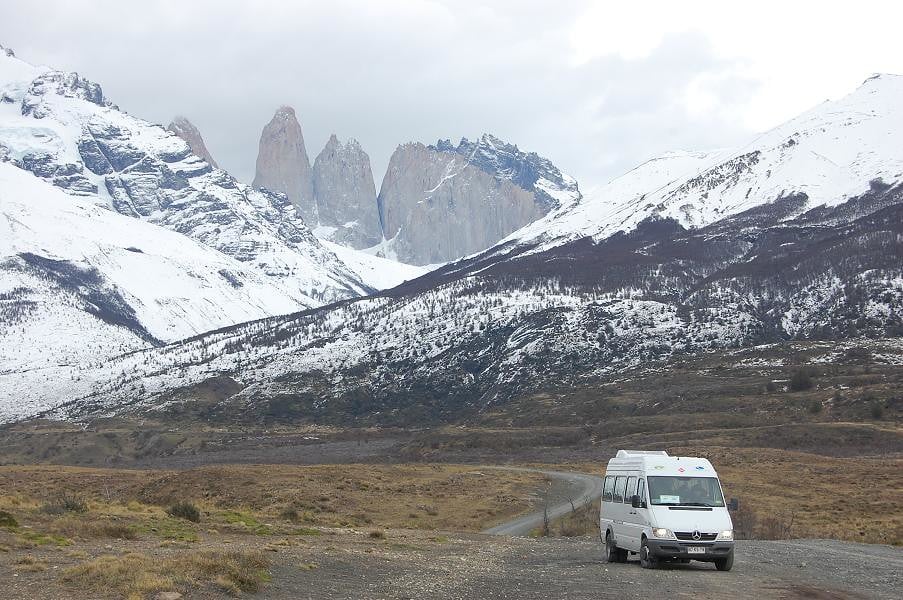
If you’re looking for a once-in-a-lifetime experience, come in Winter. You may have to walk slower due to the snow on the trails, have less flexibility due to the lack of operations in the area and experience low temperatures. Yet you will experience emotions few people ever experience while hiking through a true pristine wilderness. Unlike other months, Winter requires to step out one’s comfort zone and that’s actually something great.
8. The Towers’ Base Lagoon is Frozen
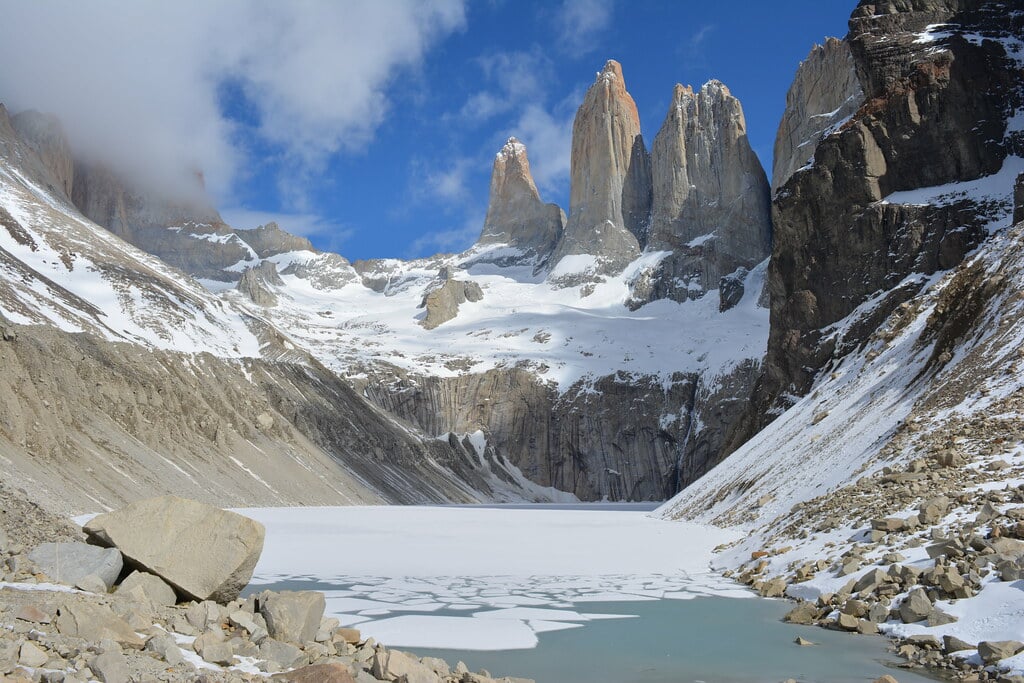
This worldwide famous viewpoint is totally different in Winter. The towers are covered by snow and most importantly the lagoon at their base completely freezes, making it for a breathtaking landscape you can normally experience from June to August.
Do you want more information? Visit cascada.travel and learn about our programs
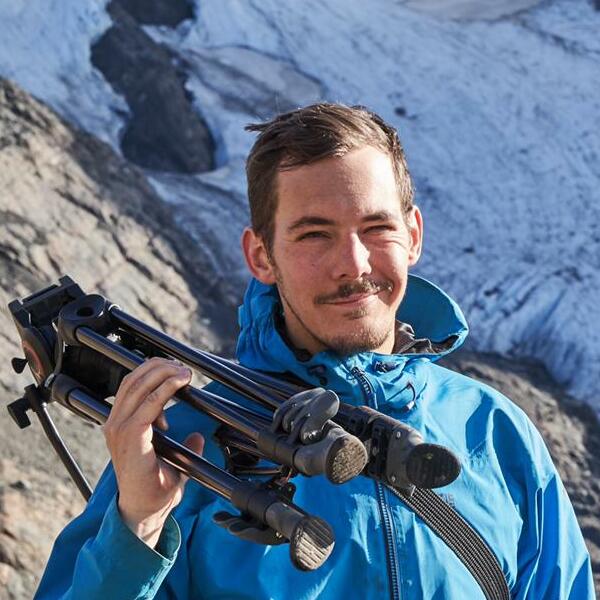
Written by Timothy Dhalleine
Driven by an insatiable wanderlust, I have left my native Hesdin in the north of France in a bid to uncover the tales the soaring peaks of Patagonia and the immensity of the Chilean desert have to tell. I am currently exploring the magic of Torres del Paine National Park while reaffirming my idea of a more sustainable world and my passion for nature as Guest Engagement Manager of Ecocamp Patagonia.
Subscribe to our newsletter
- Related posts -
Tracking pumas in a puma's paradise : torres del paine national park, the best easy excursions in torres del paine national park, take an epic adventure to the base of the paine towers.
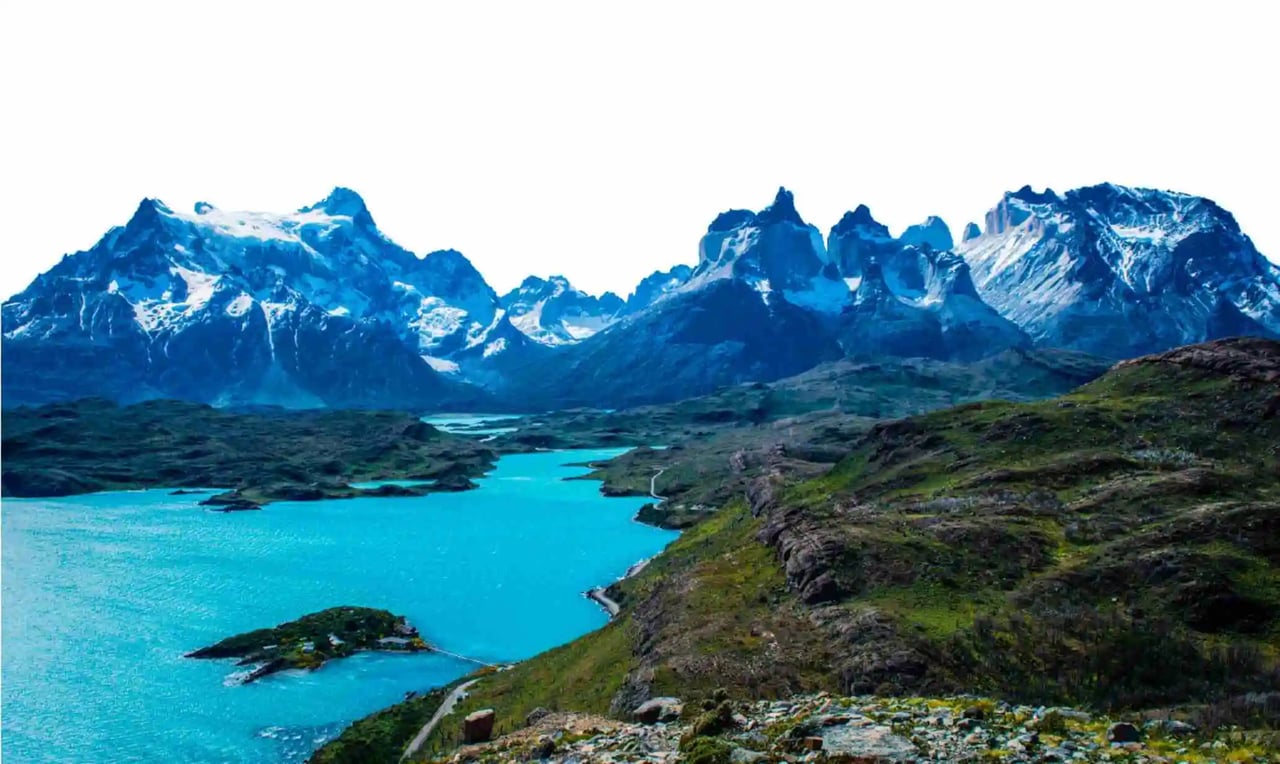
The Patagonia Way
Insider's guide: When to visit Patagonia

- Sustainability
- Photo Gallery
- Privacy Policy
- Work with us
Choose your date :
July 4, 2024, july 25, 2024, less than 4 people, 4 - 8 people.
As we aim to accommodate everyone's needs, we offer different pricing options for the Winter W Trek :
- Single Traveler: Approximate cost is $3,101.38 USD.
- Group of 2 People: Total cost is approximately $3,866.02 USD, breaking down to $1,938 USD per person.
- Group of 3 People: Total cost is approximately $4,321.75 USD, making it $1,440 USD per person.

The famous W Trek in Winter !

Best season
Accommodation, meeting point, presentation, 📣urgent winter 2024 update: conaf's new rules mandatory professional guide & full-board huts for all w trek expeditions ⛺️🚫 ➡️ 🛌✅.
Ever dreamt of beholding the stunning vistas of Patagonia blanketed in pristine white? 🏔️
If the call of nature and unique adventures quickens your pulse, pack your warmest gear and join us for a winter exploration like no other!
Venturing into Torres del Paine National Park during winter offers an unparalleled experience. The park, usually brimming with eager explorers, morphs into your personal playground. Our professional mountain guide, Roberto, Claire or Felipe accompanies you throughout this journey, ensuring a secure and memorable experience. 🥾
Our key offering, the W trek in winter , is an exhilarating blend of adventure and awe-inspiring landscapes . Brace yourself for the unique opportunity to leave your footprints on the untouched snowy trails of one of the world's southernmost regions.
Take note, though, that park authorities now mandate the presence of a guide for winter explorations, and prohibit camping within the park during the winter season. Instead, travelers are now required to lodge in full-board huts, providing you with cozy shelter against the winter chill.
However, the Frances and Cuernos sectors of the W Trek are exceptions where 'autonomous camping' is allowed. This term implies that no park services, like prepared campsites or facilities, are available. These changes haven't diminished our commitment to offer a hassle-free and unforgettable journey. Our experienced guide, Roberto, Claire and Felipe have swiftly adapted to these new regulations , leading several clients through the W Trek under these revised rules.
So, are you ready for a winter adventure that rivals any other? Our authentic travel options offer a selection of immersive experiences, all within an ethos of sustainable tourism. This winter, let's embrace the cold and venture into the icy heart of Patagonia together!
**Remember: In winter, entering the national park with a guide is MANDATORY ⚠️
🗓️ This trek is only open from the end of April to September 1st.
About the price :

Content Summary :
🏕️ experience the w trek in winter:.
Join us for an unforgettable adventure through the snow-covered landscape of Torres del Paine National Park! Our five-day itinerary covers all the highlights of the famous W Trek in Winter .
🏕️ DAY 1: Base Torres 🏔️
22km - Central Tower Refuge
An early morning transfer will pick you up from your accommodation in Puerto Natales. Our journey to the eastern entrance of Torres del Paine National Park marks the beginning of our Winter W Trek adventure. Here, we'll head towards the Central Tower Refuge, the starting point of the challenging 22km trek to the base of the towers. With a steep ascent and descent, it's a long, tough day, but the view at the top will be worth every drop of sweat. After a long hike and a warm meal, you'll sleep soundly at the refuge.
Included: Accommodation at Central Tower Refuge, meals (dinner), bilingual guide, transportation, and box lunch.
🏔️ DAY 2: French Campsite 🏕️
18km - Tent Camping
Day two will see us breaking camp early to head towards the French Campsite. Equipped with your own gear, supplies, and a sense of adventure, you'll experience self-sufficient camping in the heart of Patagonia, as there are no refuge services, showers, or bathrooms available.
Included: Meals, bilingual guide.

Rise and shine to break camp in the early morning for a hike towards the French Valley. With heavy backpacks on our shoulders and hiking poles in hand, we'll tackle the 17km Cuernos trail, which consists of rolling hills. We'll circumvent Almirante Nieto mountain and the Cuernos to reach Campamento Italiano at the base of the French Valley in the late afternoon. Setting up camp again, beware of mice! Don't leave any food in your tents...
🏞️ DAY 3: French Valley and Paine Grande 🏕️
24km - Paine Grande Refuge

We'll make our way to the awe-inspiring French Valley. After a stop at the Italian sector to prepare for the day, we continue our journey to Paine Grande Refuge where a warm meal and comfortable bed await us.
Included: Meals (dinner, next day's breakfast, next day's box lunch), accommodation at Paine Grande Refuge, bilingual guide.
🌬️ DAY 4: Grey Refuge 🏕️
22km - Paine Grande Refuge

On the fourth day of our Winter W Trek , we'll visit the majestic Grey Refuge area. Leaving our heavy gear at Paine Grande, we'll journey with only a daypack, returning to Paine Grande Refuge for the night.
Included: Meals (dinner, breakfast, box lunch), accommodation at Paine Grande Refuge, bilingual guide.
🏔️ DAY 5: Carretas to Puerto Natales 🚶♂️
13km - Return to Puerto Natales

Our adventure concludes with an early departure from Paine Grande. The Carretas trail will lead us to the park's main administration building, where our vehicle will be waiting to transport us back to Puerto Natales.
Included: Meals (breakfast, box lunch), bilingual guide, transportation to place of stay.
To make the most of your Winter W Trek experience, don't forget to check out our comprehensive article on how to plan and prepare for the W Trek in winter . It's packed with useful tips and advice to help you navigate Torres del Paine National Park.
Remember, any equipment you need can be rented upon arrival in Puerto Natales. We can meet with you the day before the trek to review the itinerary and discuss where to rent gear.
Some Highlights of the W Trek in Winter
- Changing Colors of Lake Pehoé: ❄️🌅🎨 During the winter season, the changing colors of Lake Pehoé are an absolute treat for the eyes! As the sun rises and sets, the lake transforms from stunning shades of blue to magical hues of pink, orange, and purple. It's a natural spectacle that visitors will cherish for a lifetime! The stark contrast between the snow-covered mountains and the vibrant colors of the lake creates a breathtaking and otherworldly landscape that will leave visitors awestruck.
- Snow-Covered Landscapes: ⛄🏔️❄️ The winter season transforms the W Trek into a true winter wonderland, with the trails, mountains, and forests covered in a blanket of snow. Visitors can enjoy the crisp air, snow-capped peaks, and pristine white snow as they trek through the national park. The unique winter scenery creates an immersive experience that can only be enjoyed during the winter season, making it a truly special and unforgettable adventure for nature lovers!
- Dramatic Views of the Grey Glacier: 🏔️❄️🌬️ The Grey Glacier is one of the most iconic sights of the W Trek, and in winter, the views of the glacier are even more breathtaking and dramatic. The glacier stands out against the snow-covered mountains, creating a striking contrast that is not to be missed. Visitors can witness the glacier's slow and steady movement, hear the crackling of the ice, and marvel at the unique formations and colors of the glacier. It's a thrilling experience that visitors will remember for a lifetime!
- Accommodation for two nights at Paine Grande (including breakfast, lunch, dinner, and stay inside the refuge)
- Accommodation for one night in a tent (including three meals)
- Accommodation for one night at Torre Norte Refuge (including three meals)
- Round trip transportation to and from the park
- Bilingual guide (Spanish-English)
Not included :
- Park entrance tickets
- International flights
- Personal equipment (sleeping bags, tents)
- Porter services
- Insurance (our guests are highly suggested to hire an accident insurance suitable for this trip)
- Tipping (we suggest our guests to bring cash for optional tipping)
YOUR ECOLODGE

Claire was born in France but was raised (almost) in all continents, from Italy and Ethiopia to the United States. Claire also enjoys getting to know people from all over the world and sharing her passion for hiking and her love for nature. Moving to Patagonia and working as a guide hiking everyday is a dream come true for her!
While working in Torres del Paine National Park, Felipe and Claire saw the flow of tourists grow and soon saturate the famous W trek.
Why all go to the same place when the entire region has so much more to offer?
Just in the park alone, there are many trails not often hiked which offer equally as beautiful if not more beautiful and pristine views!

Felipe is a geologist and experienced guide. He's worked in Torres del Paine National Park for the past six years. Before that, he used to guide near his hometown, in the Lakes District of Chile, hiking up and down volcanoes. He also spent two years guiding, kayaking, and ice climbing in Norway.
Claire and Felipe met through their passion for nature, and they wish to continue their professional journey practicing what they love.
Together, they strive to deliver an authentic, off-the-beaten-track, and unforgettable experience to all their guests . Come meet them!
Felipe and Madre Roca are la raja!
My wife and I spent a week at Ecocamp Patagonia and had the great fortune to have Felipe as our guide exploring the Grey Glacier and Lazo Weber. Not only did we go on some of the best hikes and see some of the most extraordinary nature we've ever experienced, but we learned so much about Chilean culture, history and politics, and the geology of Torres del Paine (Felipe is a geologist by training). We were able to practice our Spanish with Felipe for hours on end and Felipe taught us many Chilenismos that made us feel like locals in no time. Felipe is "la raja" (if you don't know what that means you'll have to book a trip with Felipe) and we couldn't imagine a better introduction to Patagonia.

Winter 2021 in Torres del Paine
Today was one of those magical days!! It’s winter in Patagonia and I had one of the most beautiful days in Torres del Paine. Felipe it’s an amazing guide, very kind and respectful for the environment, 5 stars service!!
Adélaïde Pacton
Choose madre roca.
I traveled to Torres del Paine National Park from New York to spend a week hiking. Claire was an exceptional guide with a sharp sense of humour and thorough knowledge of the park. She guided me along the W trek as well as along numerous hidden beauties of the park -- away from the main trails. Claire has a truly beautiful soul. She made my experience unforgettable and I will forever cherish the memories.
Do you want more ?
Why travel with us , designed by locals, immersive travel, responsible community.

How to Hike the Torres del Paine W Trek
- Chile / Hiking / Outdoors / Patagonia / South America
The Torres del Paine W Trek was one of our favorite hikes to date.
Our guide, Roberto, was wide-eyed and frantically waved us over. We quietly tiptoed towards him as he pointed across the river to an Andean Deer. Moments after, we realized there was another just a few yards up stream. Our cameras fired off as we watched them cross the river and through our path.
After getting back from our Patagonia Winter hike, we can’t stop thinking about how amazing the experience was. Shortly after our encounter with the Andean Deer, we learned that they are endangered and extremely rare to encounter. Our guide has hiked the trail over 200 times and saw them only one other time.
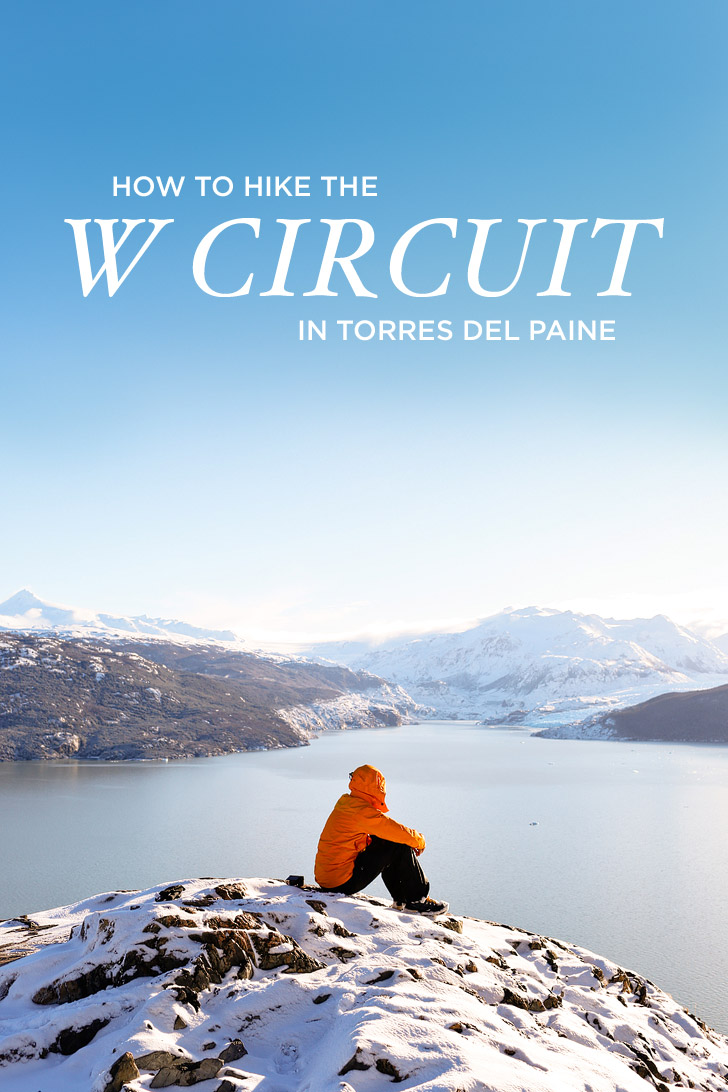
This post may contain affiliate links, where we receive a small commission on sales of the products that are linked at no additional cost to you. All opinions are always our own. Read our full disclosure for more info. Thank you for supporting the brands that make Local Adventurer possible.
Last Updated: Jan 20, 2020. First Published: August 15, 2017
The busy season is October through April (their summer), with December to February being the most popular time. The slow season is May to September (their winter).
It’s easy to see why summer is popular. Warm temperatures and long daylight hours make hiking easier. Of the 252,000 visitors, 80-90% visit during the warmer months. Winter is when the guides fall in love with the park again. It becomes a true wilderness experience again. The hike up to the Granite Towers will typically have anywhere between 800-1000 hikers during the busy season, but when we were on the trail, we only ran into 1 other hiker.
After our experience, we highly recommend going in the winter ! The downside is that the days are shorter, so you have to hike at a faster pace. We were worried about the cold, but it wasn’t as bad as we anticipated, and it was worth it to have the whole park to ourselves.
Map of the Torres Del Paine W Trek and O Trek
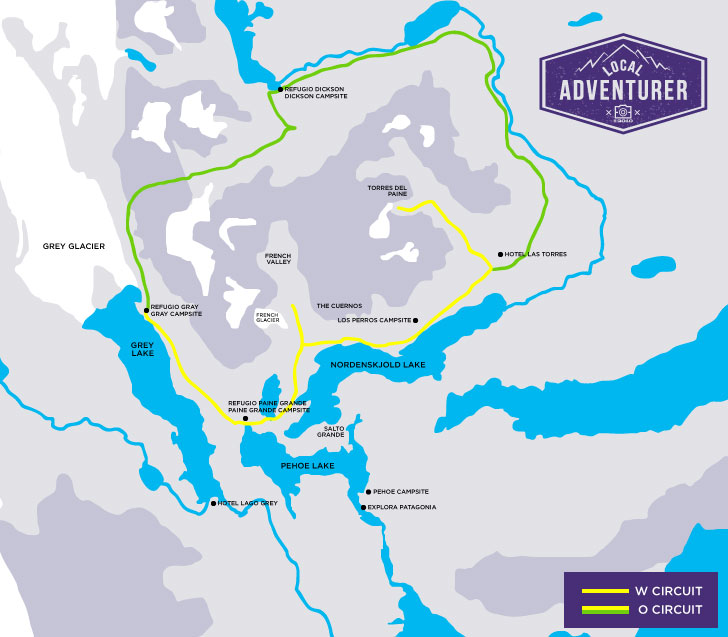
HOW TO GET HERE - BEFORE THE HIKE
There are multiple ways to get to Torres del Paine National Park, which you can check out here . Almost all of them require a few flights, a bus ride, and car ride. With OneSeed as your guide (use LOCAL10 when booking for 10% off), you are responsible for getting to Punta Arenas. Once you arrive, a guide meets you at the airport and they take care of everything else.
When we landed in Punta Arenas, our guide Roberto was waiting for us with snacks in hand. We munched on them as he gave us an overview of the next 5 days we’d be spending together. Then we hopped onto a 3-hour bus ride to Puerto Natales and checked in to a hostel. We enjoyed dinner on our own at the restaurant attached to the hostel then got a good nights rest.
In the morning, you can leave anything you don’t need on the trail at the hostel and claim it after you return from the 4-day hike. Since it was winter, we did a modified version of the W hike that gets you to all the landmarks.
Total Hike in 4 Days: 50 miles (80 km) Max Elevation on W Circuit: 2,870 ft (875 m)
DAY 1 - TORRES DEL PAINE W TREK ITINERARY / THE GRANITE TOWERS DAY HIKE
Distance: 13.77 miles / 22km Estimated time: 8-10 hours Maximum altitude: 2,870 feet / 875 m What You See: Torres del Paine (Granite Towers), Refugio Chileno, Hotel Las Torres
The first day is a long one but all you need is a day pack! Everything else can stay in the van that you arrived in. You get an early start because it is still a 1.5-hour ride from Puerta Natales to the national park. After stopping at the entrance to register, you drive another 15-20 minutes to the trailhead. We started our hike before the sun came up. It is the toughest day in terms of elevation gain. After the halfway mark, you start to really gain elevation. There is some scrambling and as you get higher up, snow on the ground gets thicker. By the time we were near the towers, there were portions of the trail where snow reached our thigh or waists.
It took us roughly 5 hours to reach the top and another 4 before we made it back to the van. We saw Andean Deer, tons of birds, and a puma in the distance. After getting back to the van, you drive another 45 minutes to the Serrano River Valley to stay the night.
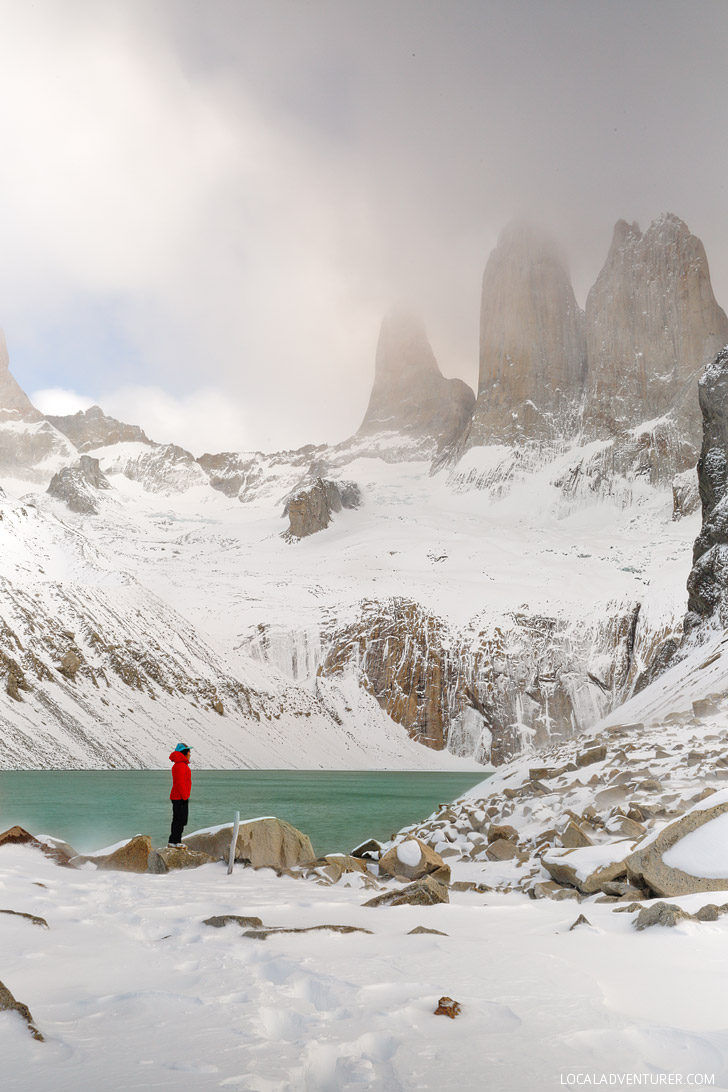
DAY 2 - TORRES DEL PAINE W TREK / HIKE TO REFUGIO PAINE GRANDE
Distance: 10.67 miles / 17km Estimated time: 6 – 7 hours Maximum Altitude: 361 / 110 m What you see: Serrano River Valley, Pehoe Lake
The second day is the toughest in weight. It is the only day you have to carry a full pack. The van drops you off shortly after the entrance and you hike along a relatively flat trail. 70-80% of the trail is flat with hills filling the rest of the trail. The two largest hills come right at the end. This was the windiest day for us and you are most exposed to the sun with little tree cover.
After arriving at Paine Grande, you get settled and rested before dinner in the main area.
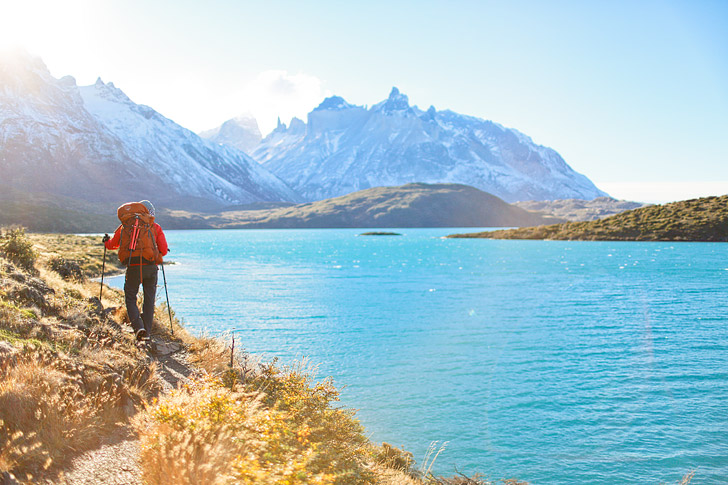
DAY 3 - TORRES DEL PAINE W TREK / FRENCH VALLEY DAY HIKE
Distance: 10.67 miles / 17km Estimated time : 7-8 hours Maximum altitude: 623 feet / 190 m What you see: Cuernos del Paine (The Horns), Campamento Italiano, French Valley, French Glacier
We experienced the expertise of our guide on Day 3. It was an incredibly overcast day so he called an audible. After arriving at Campamento Italiano, rather than continuing up the French Valley, we changed our route to the French Glacier instead. Since it was a shorter hiking day, we had a lot of time to enjoy the views of the glacier before heading back to the Refugio.
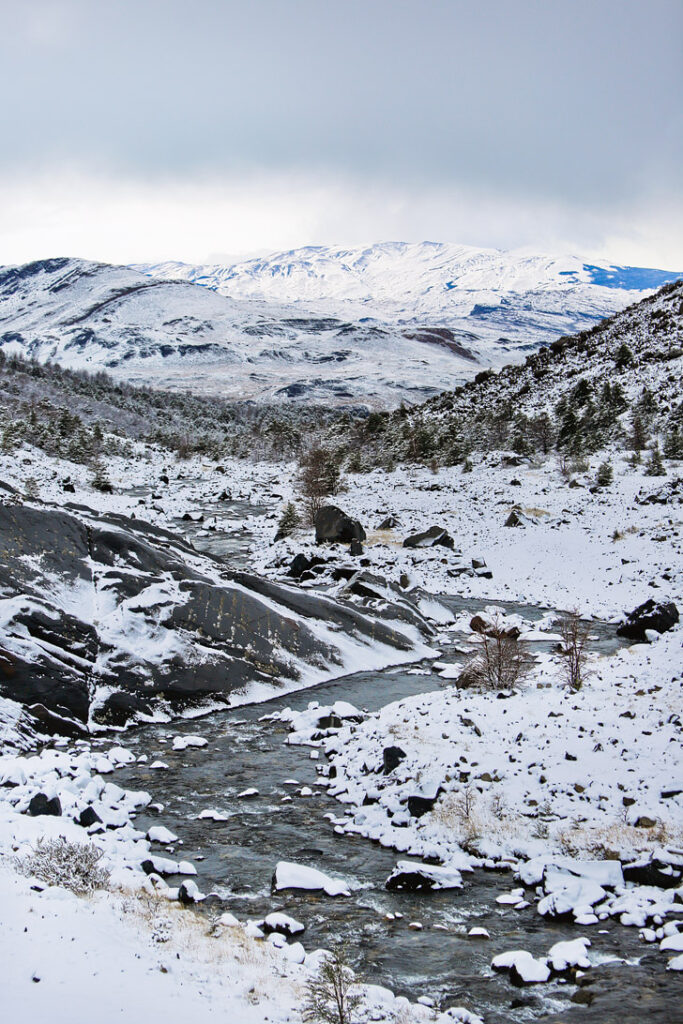
DAY 4 - TORRES DEL PAINE W TREK / GREY GLACIER DAY HIKE
Distance: 14.92 miles / 24km Estimated time: 8-10 hours Maximum altitude: 820 feet / 250 m What you see: Grey Glacier, Grey Lake, Refugio Grey
The last day is a long day and your body is fatigued. There is a viewpoint about half way where you can decide to turn back, but we wanted to make it all the way to the end.
At the start of the hike, there are soooo many puma tracks. It’s a popular spot for them to hunt for hare so tracks follow the trail almost to the first viewpoint. Once you reach the first viewpoint, the trail declines very steeply to Refugio Grey.
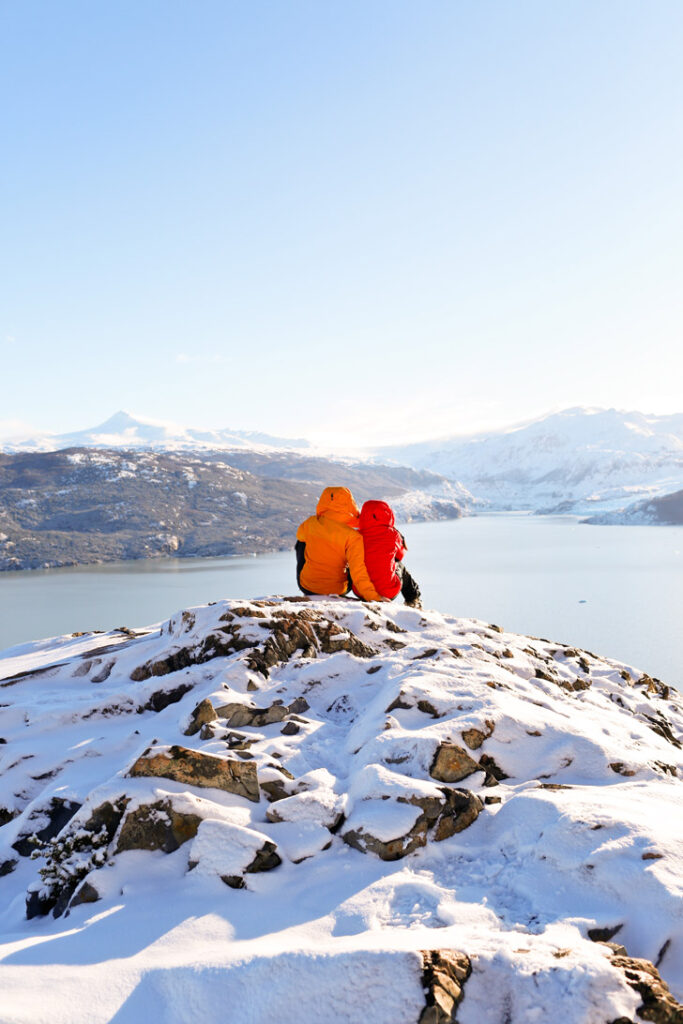
AFTER THE HIKE
After the last day of hiking, we spent one more night at Paine Grande. The next morning, we took the Catamaran across the lake where our driver picked us up. We made a few stops for photos, then headed back to Puerto Natales. After cleaning up and resting, we had a final dinner with the guide before calling it a night.
The next morning, Roberto came back to take us to the bus station. He then rode with us to Punta Arenas and made sure we got checked into our flight okay before saying our final goodbyes.
Address, map
Local Tip / Pro Tip / Note: dsfsdfsd
More: 11 Incredible Things to Do in Grand Teton National Park
COMPARE PRICES ON AMAZON AND ___
BACK TO TOP
Essential Tips for Your 4 Day Hike on the W Circuit
- Porters: Most likely you won’t be using porters, so come prepared to carry everything you have. The good thing is that you only need a day pack for 3 out of the 4 days. It’s possible to get a porter, but it costs $120 a day, and in the winter they need to be booked for the entire trip, which would make it $600 extra.
- Guide: $6-8 per day
- Assistant Guide: $2-5 per day
- Cook/Mulero/Camp Assistant: $1-3 per day
- Altitude Sickness: Since the entire hike is under 3,000 feet, you don’t have to worry about altitude sickness.
- Warm Showers: Showers are available throughout the trip, but they won’t always be warm. During our stay at the Serrano River Valley, warm water ran out before everyone showered. At Refugio Paine Grande, the water is heated by propane, so the last night we were left with cold showers as well.
- Water: You can drink from the tap since it is all sourced by the glaciers. We carried 1-2 L per day and there are streams where you can fill up along the way.
- Checking in Bags at Puerto Natales: Anything you don’t need on the trail can be left at the hostel in Puerto Natales. After finishing your hike, you will have one more day there before leaving.
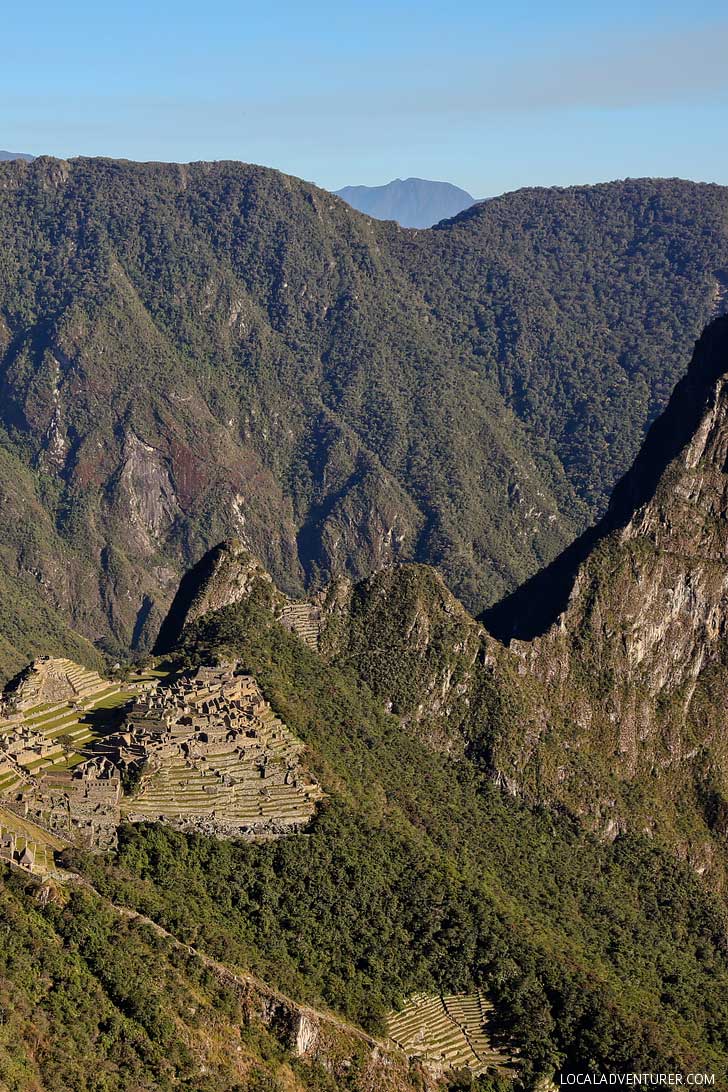
For more photos and information about Torres Del Paine National Park , check out our ultimate guide .
What to Pack for the W Trek
Find out everything you need on our Patagonia Winter Packing Guide and Summer Packing Guide .
Best Places to Stay
Are you planning on doing the Torres del Paine W Trek? Would you pick winter or summer?
Did you enjoy this post? Pin it for later
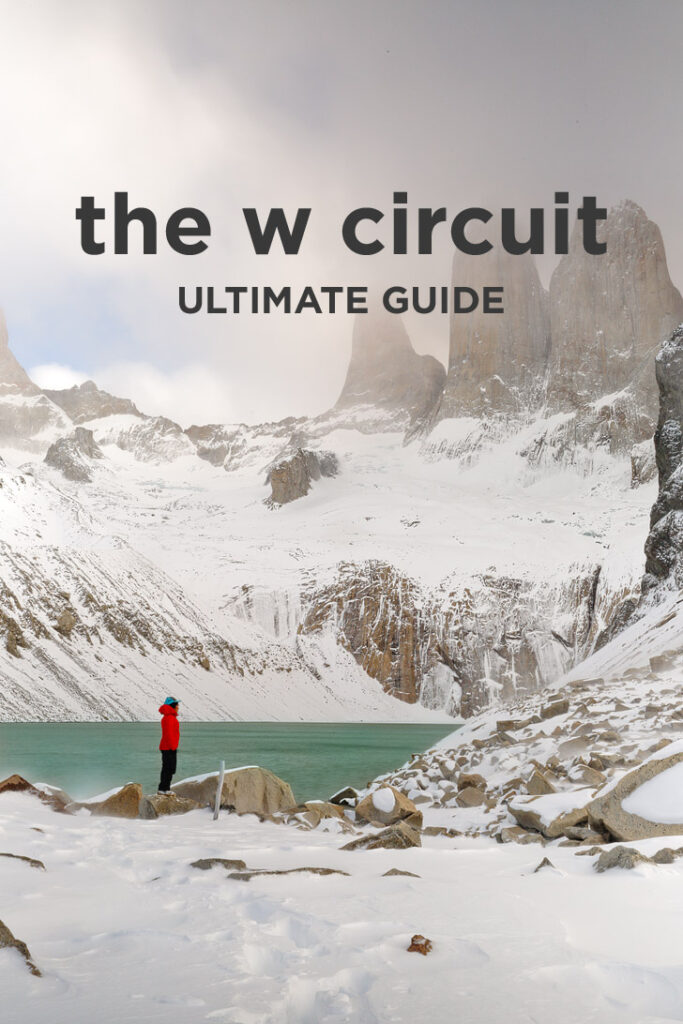
SEE MORE NATIONAL PARK GUIDES
JOSHUA TREE
CRATER LAKE
GRAND TETON
BRYCE CANYON
BLACK CANYON GUNNISON
GREAT BASIN
GREAT SAND DUNES
SEQUOIA + KINGS CANYON
“Discovery consists not of seeking new lands but in seeing with new eyes ” – M. Proust

Esther + Jacob
Esther and Jacob are the founders of Local Adventurer, which is one of the top 5 travel blogs in the US. They believe that adventure can be found both near and far and hope to inspire others to explore locally. They explore a new city in depth every year and currently base themselves in Portland Oregon.
You might also love
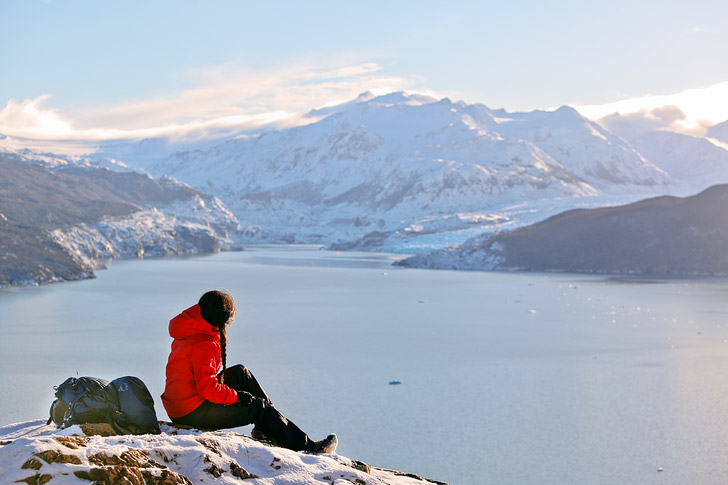
Torres del Paine Patagonia Packing List

Ultimate Guide to Torres Del Paine National Park Chile

Essential Guide on What to Pack for Patagonia W Hike
This post has 6 comments.
I was curious if a guide is necessary? Thanks!
It’s not necessary if you’re hiking any other time of year, but unless they changed their policy, you can’t hike without a guide in the winter. You might be able to sneak in without one and get away with it, but even if you do with the snow, you can’t see the trail half the time. Unless you’ve done the hike a few times before, I wouldn’t recommend trying it alone in the winter. In the summer, I hear there’s so many people, it’s hard to get lost.
Hi Jacob, during what month did you hike the W? Me and my boyfriend are going to be there at the end of June 2018 so we’re wondering if the snow will be as deep as what you guys experienced! Also, do you think we could do this trek on our own instead of paying for a guide, is the trail well marked? Thanks a lot!
Hi Sylvie. We hiked it in mid-July, but as far as how deep the snow is.. it really depends on how much snowfall they get and each year will be different. Trails are really difficult to follow especially when they’re covered in snow, but you also don’t have the option to go without a guide since the park doesn’t allow it. If you want to go without a guide, you may have to hike it in the summer instead.
Hey guys, We’ll be doing the W trek in winter this year, starting on the 29th April. We just found out hikers are now required to have a guide during the winter months. We were hoping this wouldn’t apply to us because we were starting before May, and ending on the 3rd May – however, it seems we’ll need to find a local guide. I’ve heard they’re super expensive (like, $110 AUD a day!), and our budget wasn’t really allowing for this. Do you have any advice on whether or not we should be worried about that, or how to find a good guide (that won’t cost us an outrageous amount?) Thanks heaps! Milly
Hi Milly. Unfortunately, I’m not sure on how strict they will be since you’re hiking right on the cutoff. I would call the ranger station and see what they say. As for finding a local guide, when we went the park was so empty, so we didn’t really meet anyone else. We only have experience with our guide, who was with OneSeed. We did a full package including food and lodging, but you can contact them at [email protected] if you can hire just the guide and what that pricing might be.
Leave a Reply Cancel reply
This site uses Akismet to reduce spam. Learn how your comment data is processed .

Your Guide to Solo Backpacking and Travel
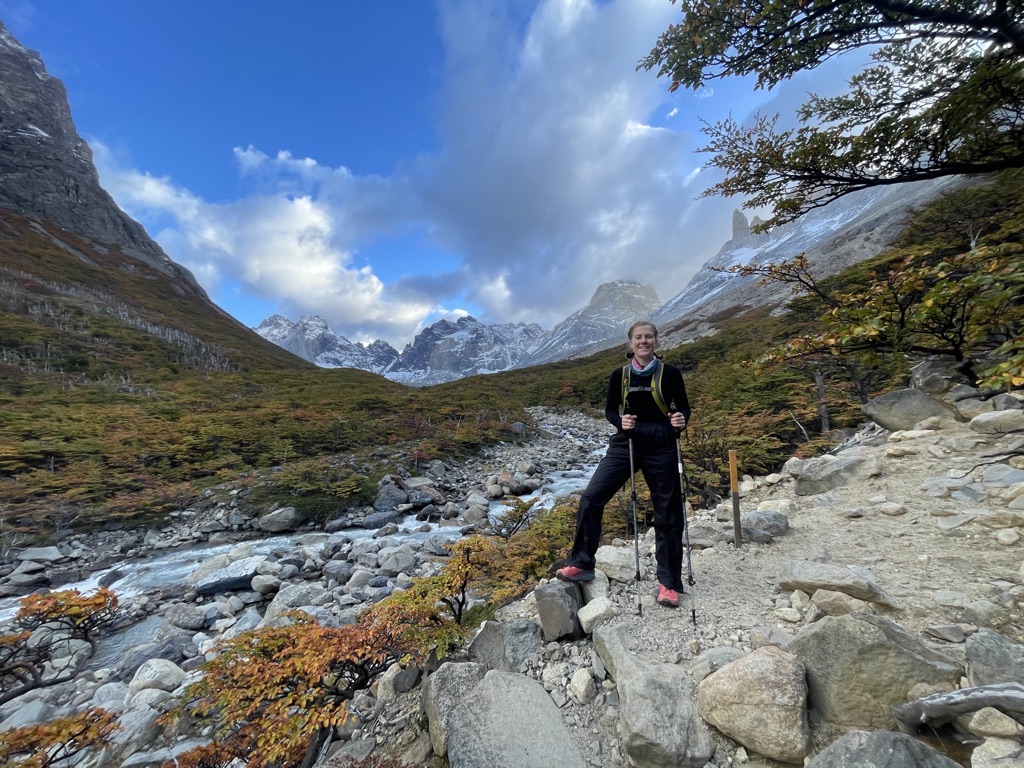
Hiking the W Trek — Everything you need to know
The W trek is roughly a 50 mile (80 km) multi-day hiking route located in Torres del Paine National Park, Chile.
The trek is popular because it goes past many of the highlights of the park, requires only a moderate level of fitness, and has a good infrastructure in place which allows hikers to self-guide their own trek.
Along the W trek you will find yourself stunned by the natural beauty found at the viewpoints such as Las Torres, Lago Nordenskojld, Cuernos del Paine, Británico, and Grey Glacier.
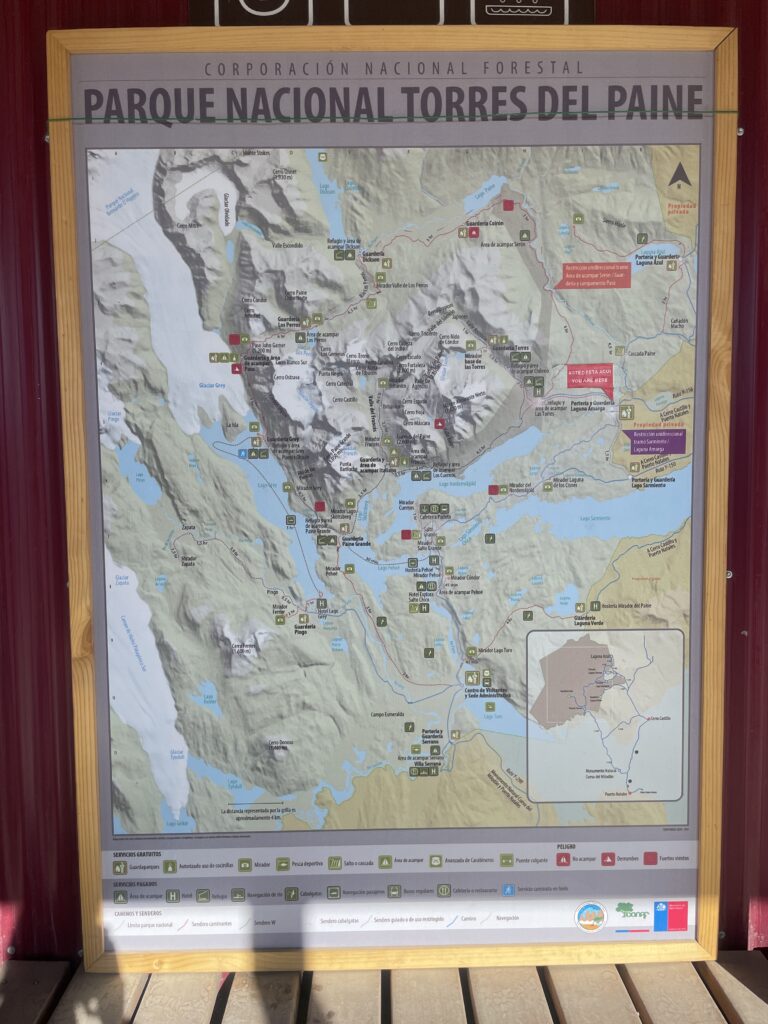
When can you hike the W trek?
The park is open year-round, however, for self-guided trekking, you can only hike between October and the end of April.
If you want to hike during the winter months (May through September), you’ll need to arrange a guide.
The W trek in Torres del Paine National Park is a moderately challenging hike. If you’re able to walk up to 18 kilometers (11 miles) per day (and feel like you would be able to do that over multiple days), then you will find this hike perfectly doable.
Links you’ll need:
First, decide on how long you want to take to see/complete the W trek. It can be hiked in 5 days / 4 nights , or 4 days / 3 nights (one day of longer hiking), or you can see all of it in ~4 days without camping (you will have to take transportation within the park).
Booking where you will stay
- Free Campsites: CONAF is a non-profit that offers free camping. These sites have no frills (bathrooms, water spouts, minimarkets, etc…) but its a place to stay! Make sure to book ahead of time with them with their online booking.
- Fantasticosur
Buying tickets into Torres Del Paine:
- We bought ours online and we found that in order to do so, we had to enter in our itinerary (i.e., how many days we planned to be in the park and where we planned to spend each night). I will add that other than our entrance ticket begin checked when we entered the park, our itinerary was never confirmed by anyone.
- You can also buy your entrance ticket with credit or debit card at the bus station in Puerto Natales (Avda. España 1455, 1st Floor)
- Lastly, your tickets can also be purchased in the Park but only in cash (they cannot process card payments).
Getting to and from Torres Del Paine from Puerto Natales
- Book your bus (it will take ~2 hours) on Budbud . I recommend booking with Bur Sur as they are reliable and you can exchange your tickets with other days/times if necessary.
Hiking the W Trek
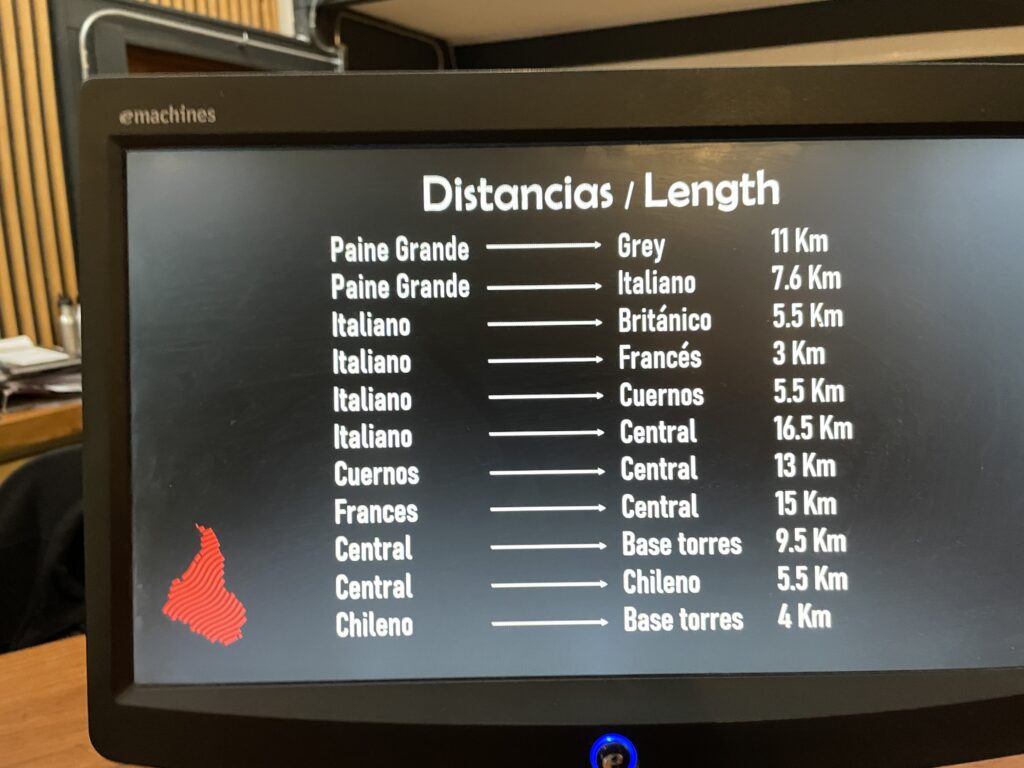
The W Trek has something for everyone, whether you enjoy camping, or you want to stay in a nice hotel with heating, a comfy bed, and gorgeous views. There are two main hotels along the W Trek located at Central and Paine Grande. The majority of this post covers how to they-hike the W Trek, but if you are interested in seeing all highlights of the W Trek while staying in these hotels and only taking day hikes, click here to skip down to my instructions on how to do that.
I suggest hiking it East to West but if you want to, you can always reverse the order of my suggestions. Since it is more popular to hike West to East, by going in reverse you will encounter less crowds, knock off the hardest (and most iconic) hike first, and then your hikes will just get easier from there.
How to hike the W Trek in 5 days/4 nights
( alternative 4 day plan ), day 1: puerto natales to torres del paine.
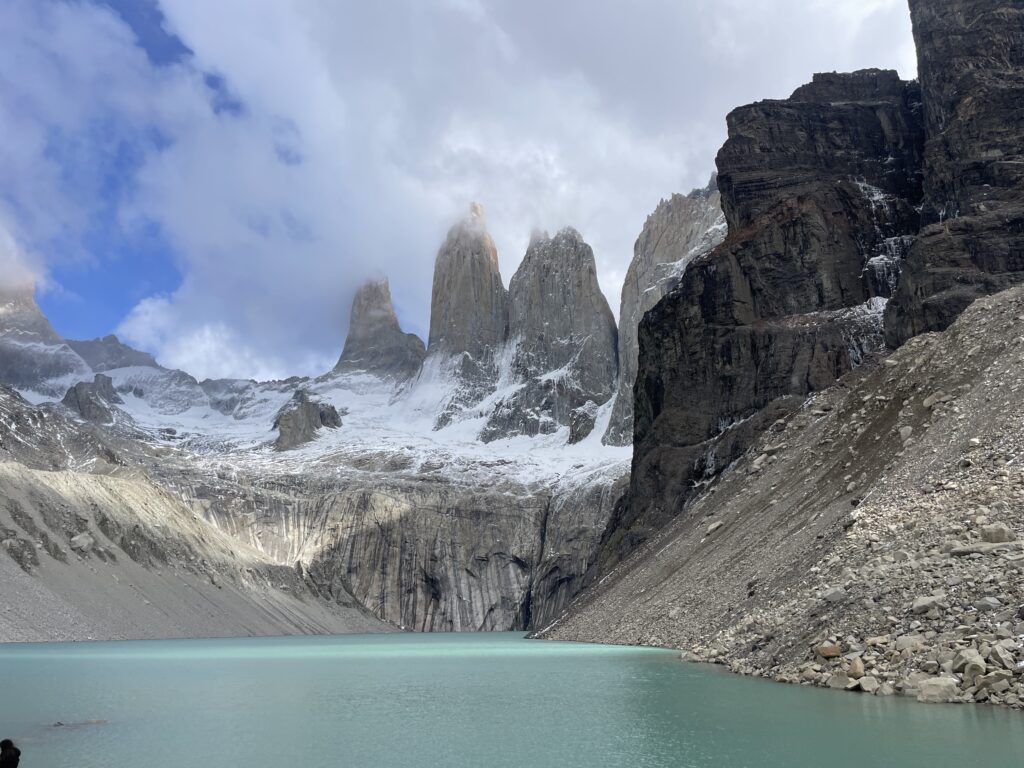
Where you stay Night 1: Central
Hike: Round trip to The Towers
Length: 12.5 mi (20.12 km)
Time: 8.5 hrs
Total Ascent & Descent: 3,251 ft (990 m)
Difficulty: Hardest hike of the trek, but 100% worth pushing through
- The bus is ~2 hrs. Make sure you have your park tickets on hand.
- You will be dropped off at the Ranger Station, Laguna Amarga
- From here you can catch a shuttle ($3,000 Chilean pesos) to the Welcome Center right outside Central
- Leave your main bags at Central and bring a day pack for the rest of the day
- Follow the signs to hike up to The Towers
- You’ll pass Refugio Chileno on the way where you can stop for lunch (they sell food and drink)
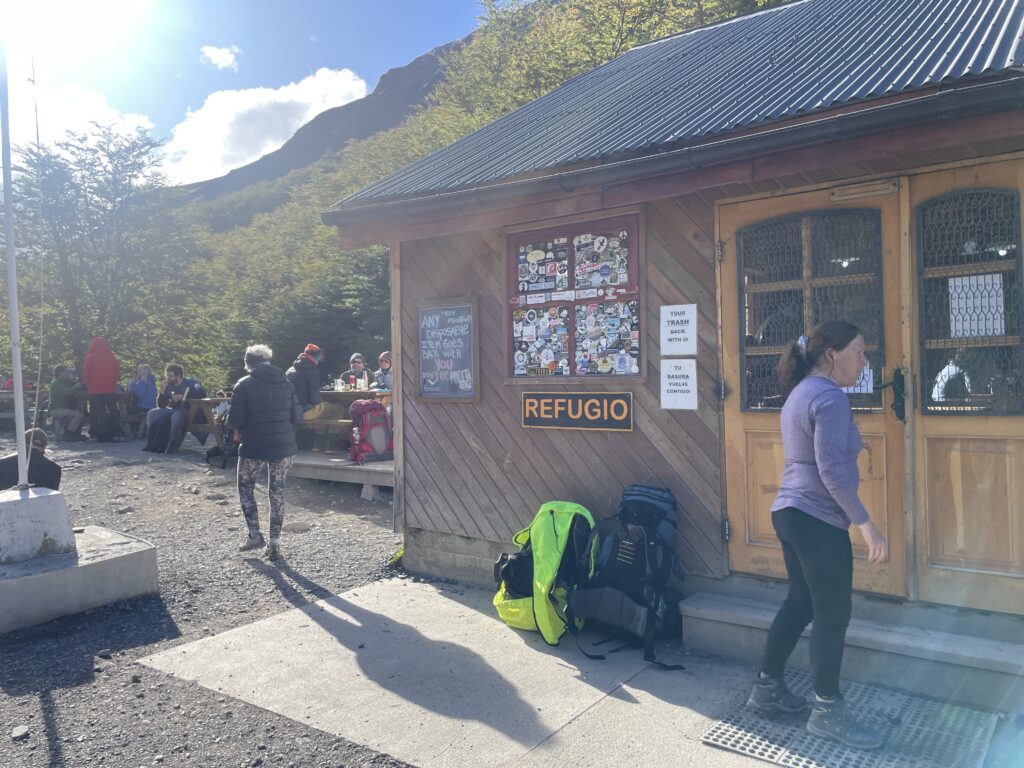
*if you want to stay at Chileno you will have to hike with all your stuff up to the Refugio. We did this and regretted lugging our heavy bags up half the mountain
- At Refugio Chileno you can then either stay inside in the dorms or on raised platforms for tents
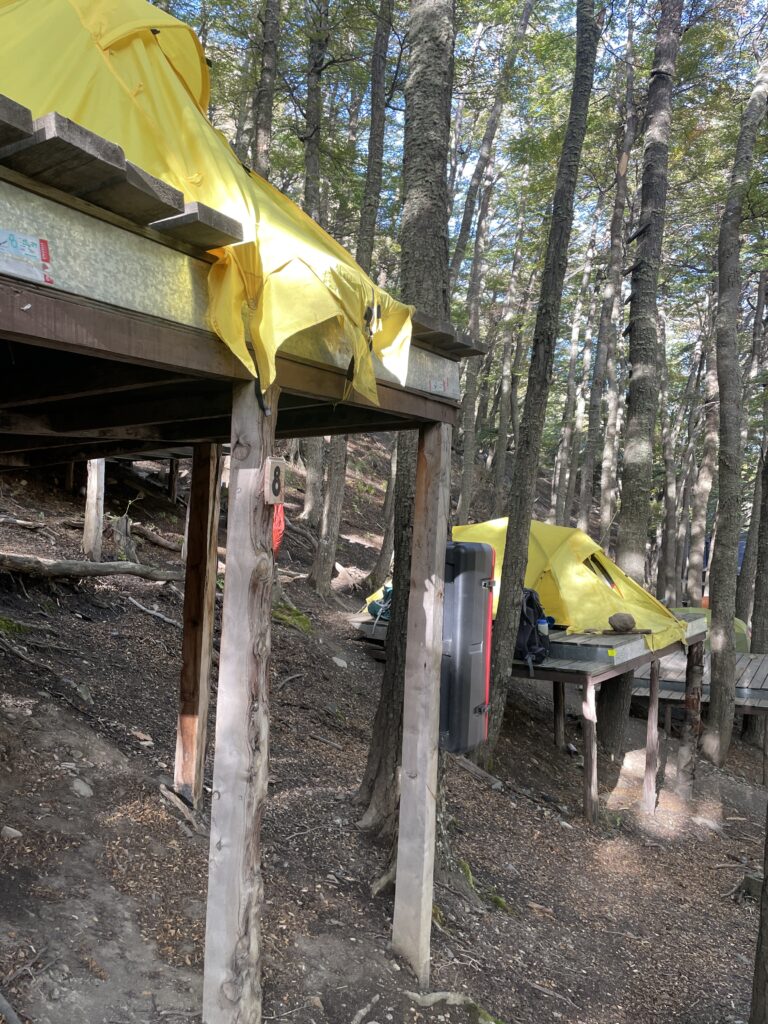
- From Refugio Chileno it takes ~1.5 hours to get up to Mirador Torres
- Budget 30min-1hr up at Las Torres for Photos (or to wait out bad weather)
- Stay the night at Central
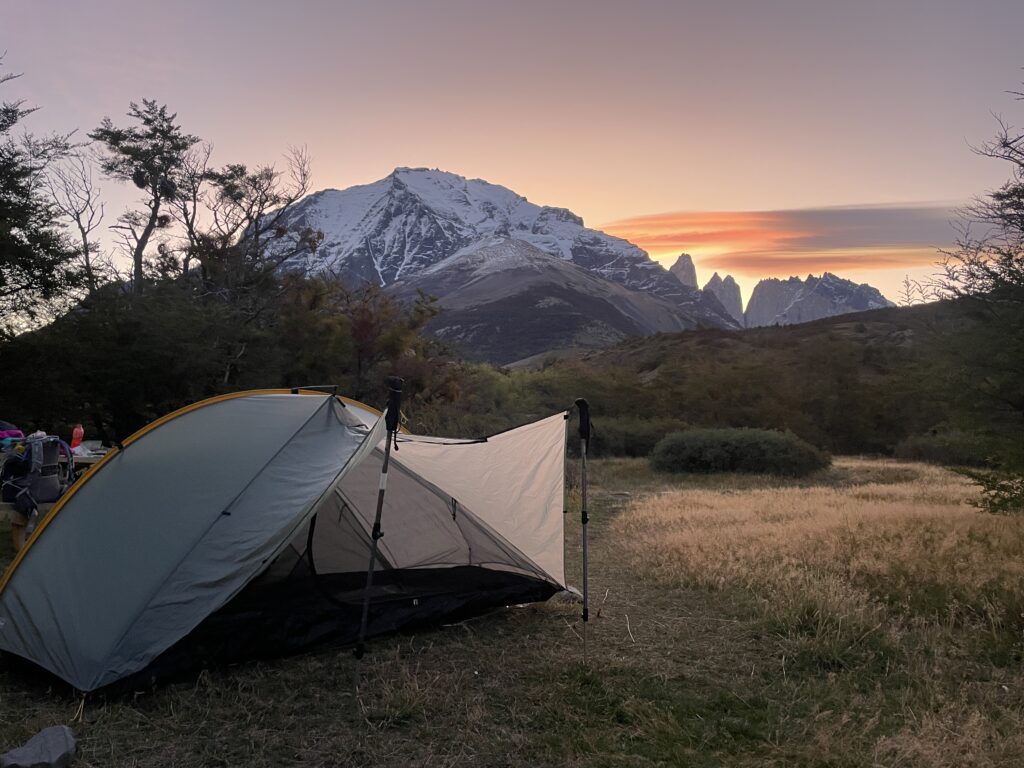
*Central was my favorite camping spot because we were actually separated from other tents and had a little bit of privacy. You will not get this at any of the other camping refugios
Day 2: Central to Frances
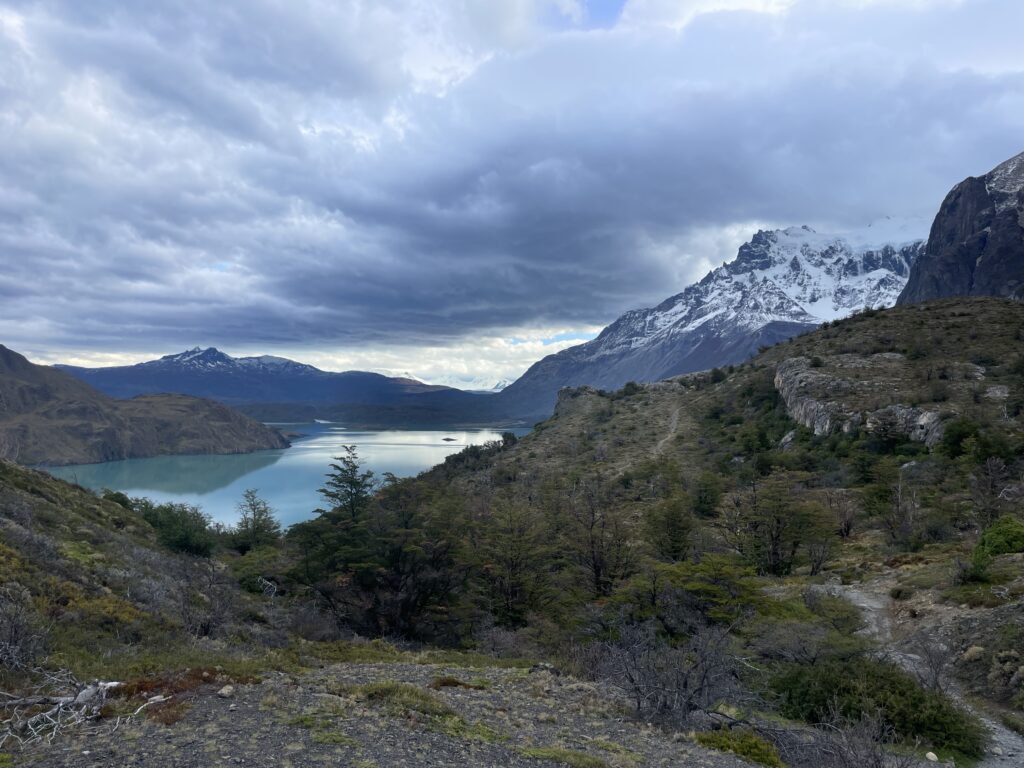
Where you’ll stay Night 2: Refugio Frances
Length: 10.7 mi (17.22 km)
Time: 5.5 hours
Total Ascent: 1,688 ft (514 m)
Total Descent: 1,635 ft (498 m)
Net Elevation Change: 53 ft (16 m)
Difficulty: Easy
- This day you’ll see gorgeous views as you hike along Lago (Lake) Nordernskjöld, past the mountains of Monte Alimirante Nieto and Cuernos Del Paine
- You do have the option of staying at Refugio Cuernos rather than Frances.
- Cuernos is a really nice Refugio and you may be tempted because it is ~1.5 hours closer than Frances, however, the next Day is a long day, and hiking the extra distance to Frances sets you up to arrive at Mirador Británico before the crowds
Day 3: Frances to Paine Grande

Where you’ll stay Night 3: Paine Grande
Hike/Mirador: Frances and Británico
Length: 12 mi (19.31 km)
Time: 8 hrs
Total Ascent: 2,346 ft (715 m)
Total Descent: 2,713 ft (827 m)
Net Elevation Change: -367 ft (-112 m)
Difficulty: Medium
- If you’re up for it, I recommend you wake up early this day in order to get to Británico before the majority of people. On this day, when we hiked the W Trek, we started hiking at 7 AM.
- Hike from Frances to Italiano (~1 hour) and leave your mainbags here (recommend you pack a day pack for your hike up to Británico).
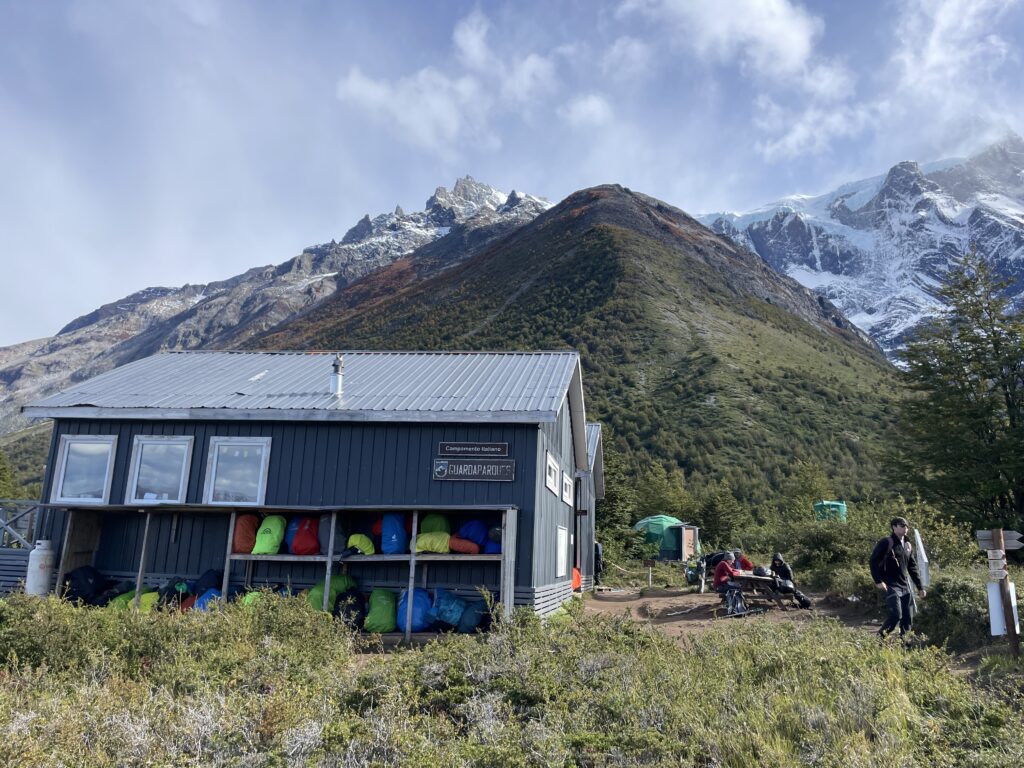
- There are 2 main viewpoints along this hike: Mirador Frances and Británico.
- Frances is on the way to Británico and you will reach it in ~1hr from when you start.

Mirador Frances
- It is roughly a 1 hour hike past Mirador Frances to reach Mirador Británico.
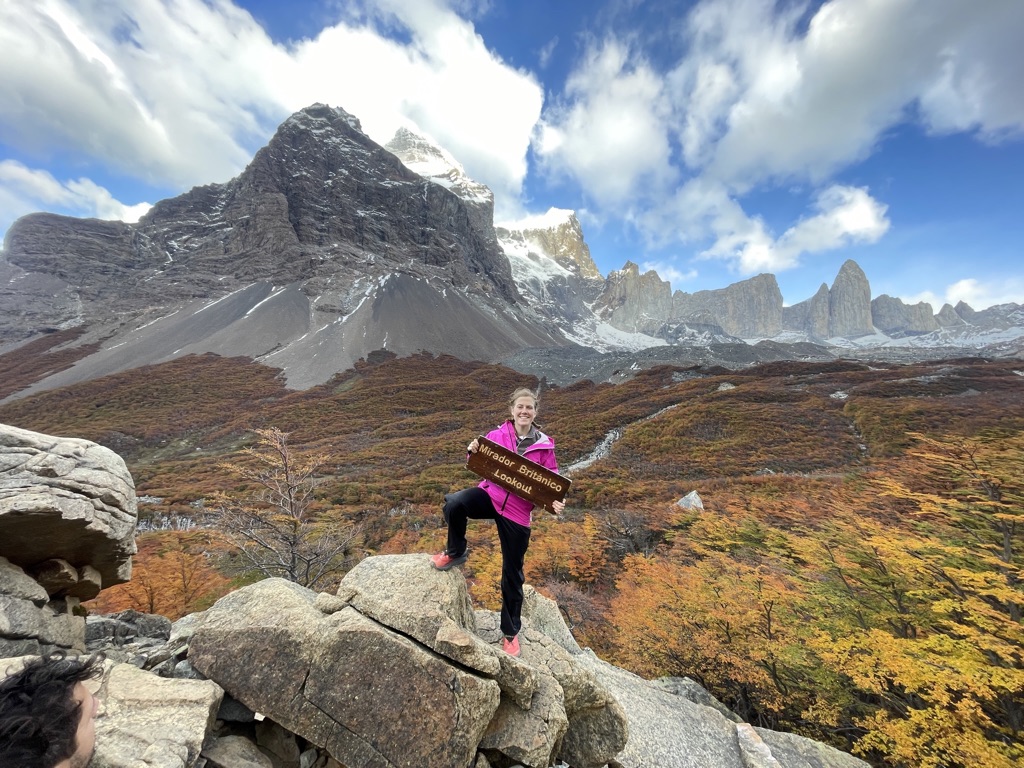
Mirador Británico
*note: Británico is GORGEOUS, but it was recommended to us that if the weather is terrible then it’s not worth it to hike all the way to Británico and you can just hike to Mirador Frances and turn around
- After returning from Británico, grab your bags from Italiano and make your way to Paine Grande. The hike from Italiano to Paine Grande is an easy 2 hour, relatively flat, hike
- At Paine Grande you’ll find a lodge where you can stay, a restaurant that offers buffet meals, and a bar with food and drink
- Tents are set up right outside the Lodge
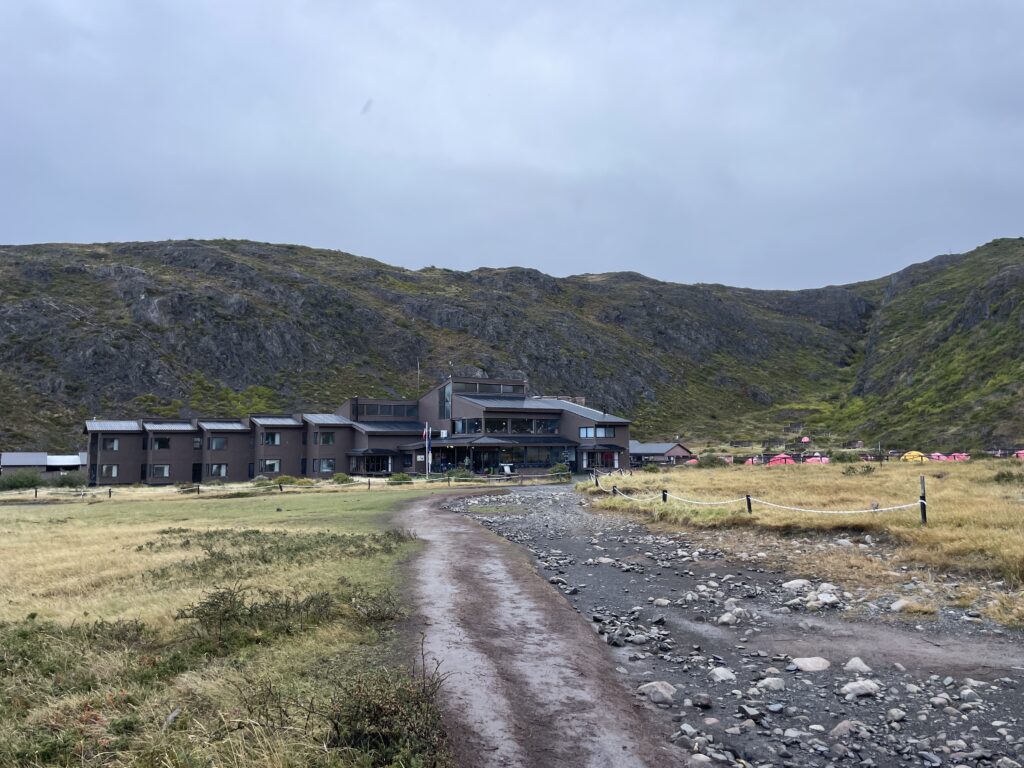
Day 4: Paine Grande to Grey
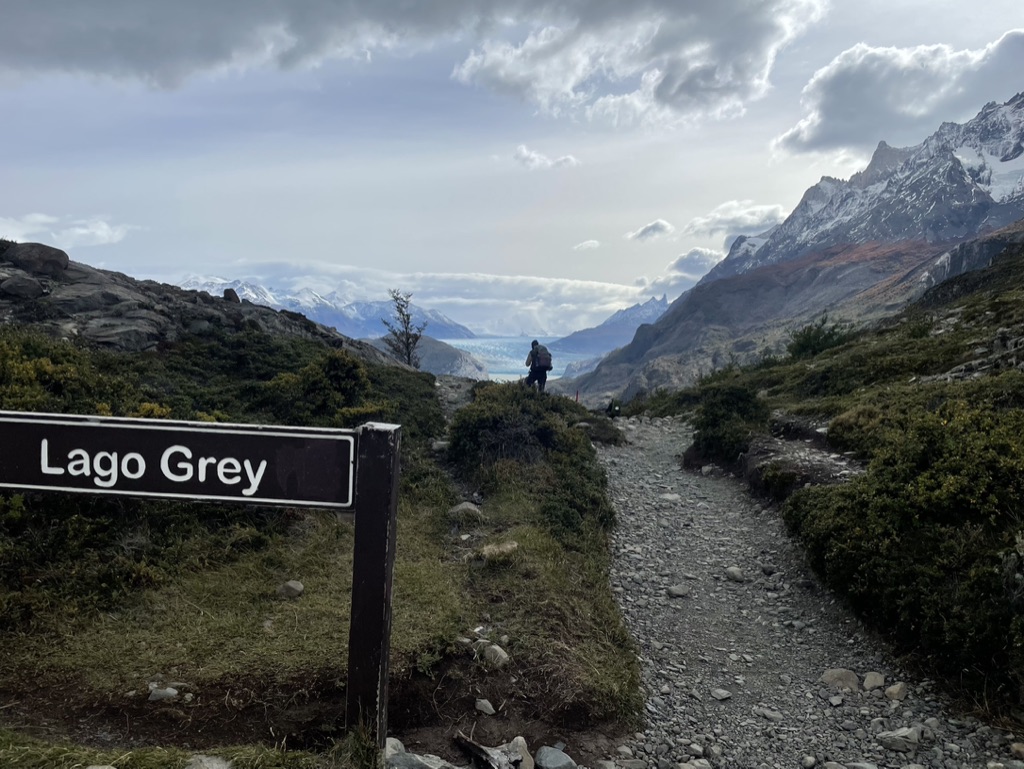
Where you’ll stay Night 4: Grey
Hike/Mirador: Grey Glacier
Length: 6.7 mi (10.78 km)
Time: 4 hours (signs say 3.5 but for us it took 4)
Total Ascent: 1,289 ft (393 m)
Total Descent: 1,177 ft (359 m)
Net Elevation Change: 112 ft (34 m)
- Heads up, this hike is often very windy but it is relatively easy compared to days you have had prior.
- You will arrive to Refugio Grey first. Drop off your bags and hike 10 extra minutes to see Grey Glacier.
- Spend the night at the Grey Refugio
Day 5: Refugio Grey to Puerto Natales
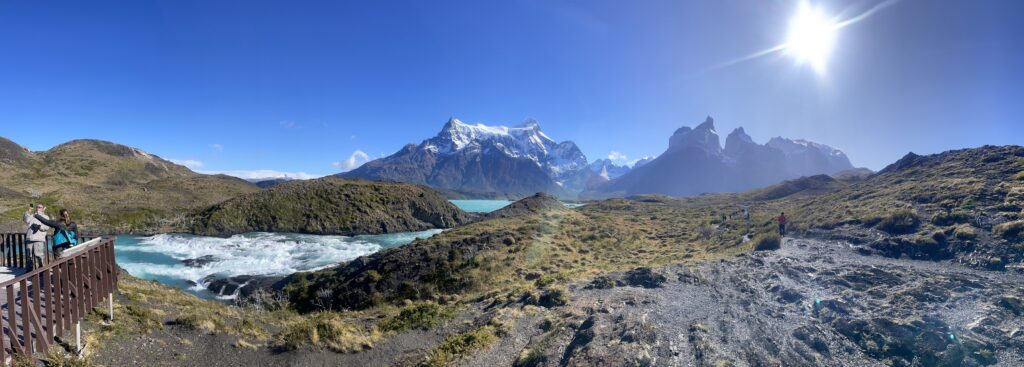
Time: 3.5 hours (it took us less time to return to Paine Grande)
Total Ascent: 1,177 ft (359 m)
Total Descent: 1,289 ft (393 m)
Net Elevation Change: -112 ft (34 m)
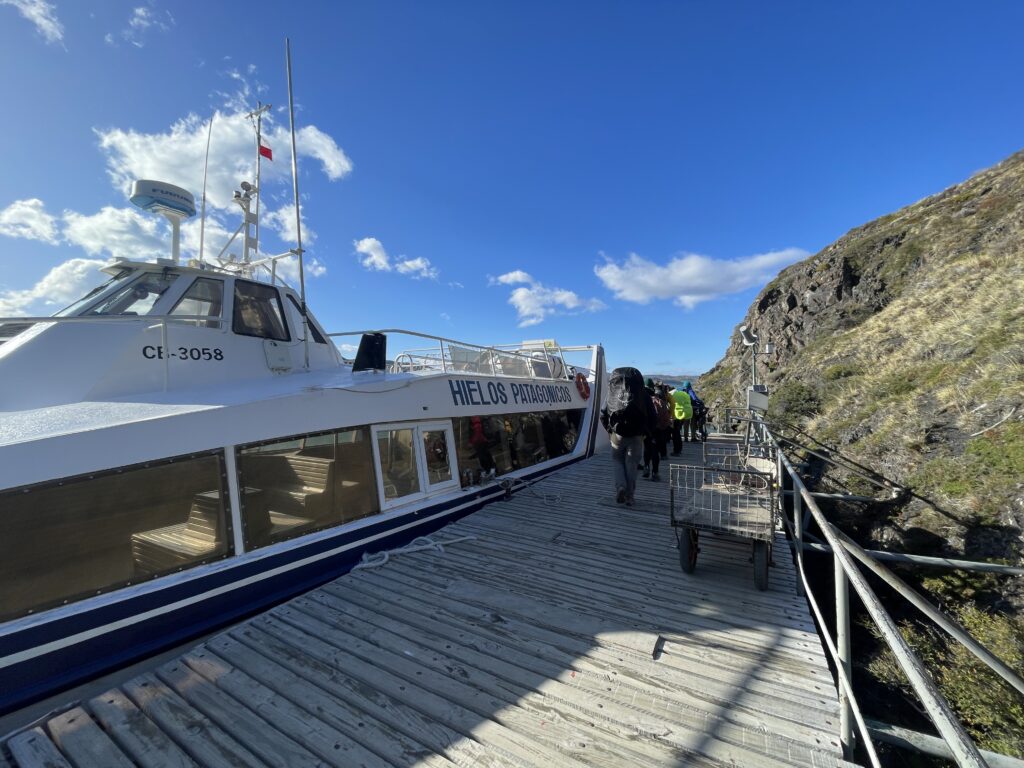
- Todays main priority is getting yourself out of the park and back to Puerto Natales.
- The amount of boats between Paine Grande and Pudeto change based on the month (popularity with tourists). Here’s a photo I took although there is a glare. Make sure you time your bus with your catamaran. Also recommend double checking with the front desk at Paine Grande to ensure the boat is coming at the time you expect. You have to buy the catamaran boat tickets at the boat itself. Tickets are 25,000 Chilean pesos each and must be in cash. During high season (Summer which is Dec-March) they will take USD.
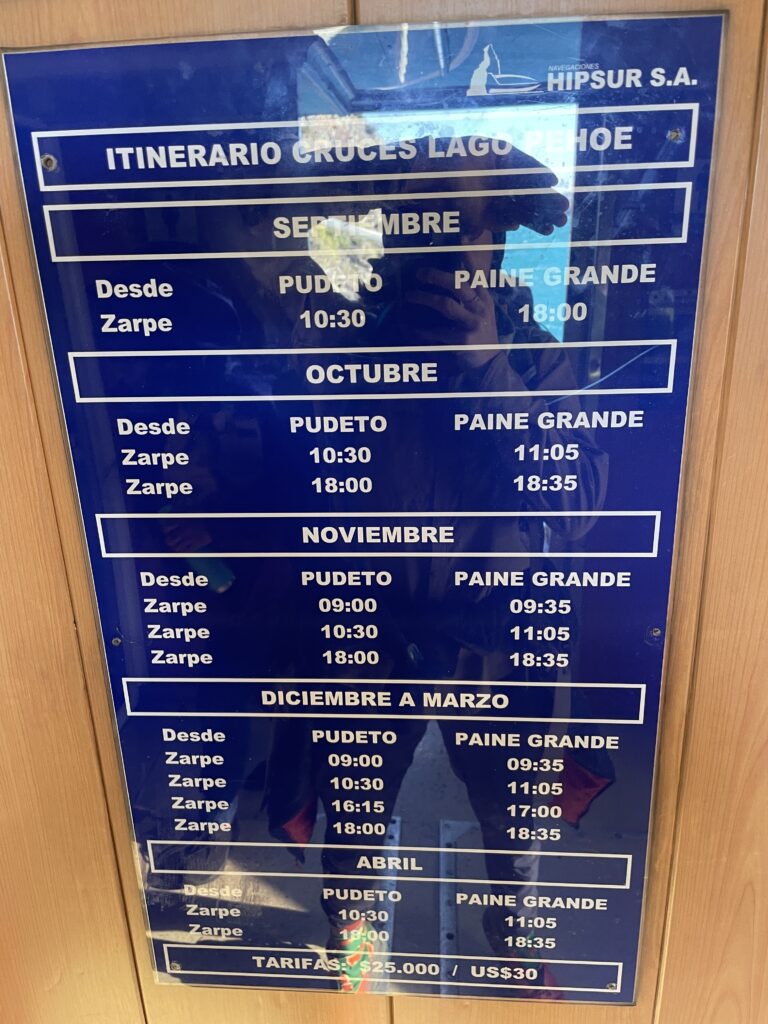
*Optional hike while you wait for the bus: Salto Grande Waterfall and Mirador Cuernos where you can view the W trek.
Salto Grande Waterfall and W Trek Viewpoint
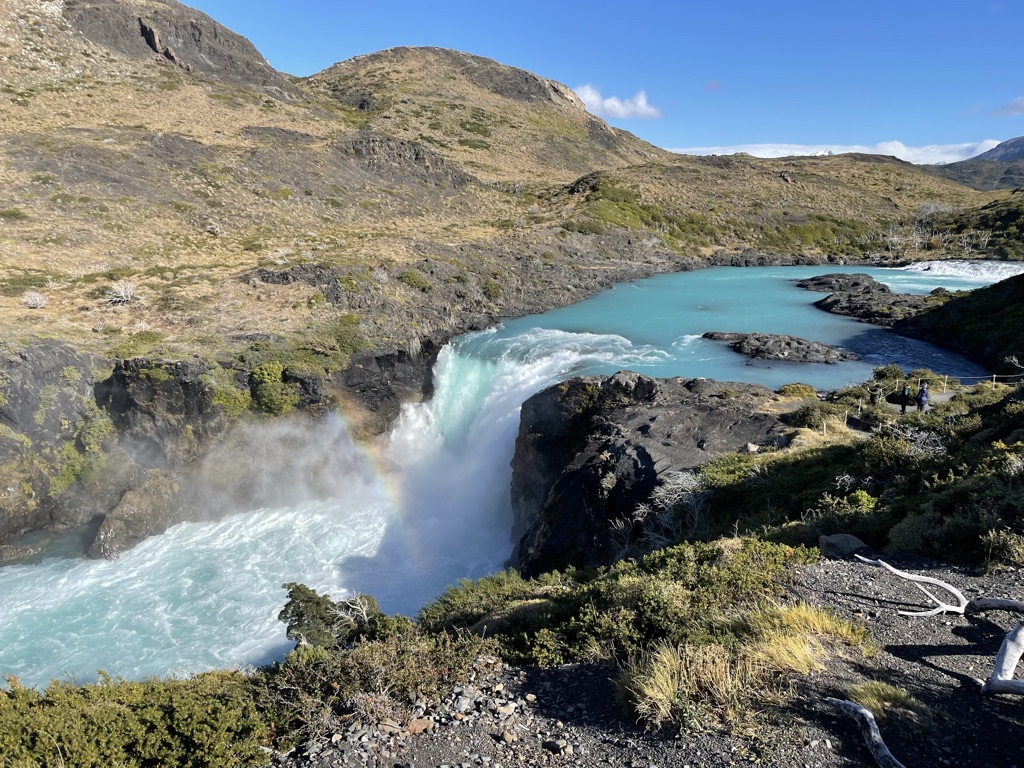
- The views you’ll see along this short hike
- Give yourself 1.5hrs to do this
- ⚠️ Warning: this hike has some of the highest winds in the whole park
Alternative 4 day, 3 night plan:
- On day 4 hike round trip from Paine Grande to Grey and back in time to catch the boat. Make sure to book your bus to Puerto Natales ahead of time to ensure that you will have a smooth transition out of the park.
How to see all highlights of the W trek w/ only day hikes
- Day hike to Las Torres
- Spend the night in Central
- Shuttle to Laguna Amarga, then to Cafeteria Pudeto where you can catch the catamaran to Paine Grande
- Book Paine Grande for the rest of your time in the park.
- This will be a long, all day hike. Pack food
- Stay the night at Painé Grande
- If you’re determined, you can do this hike in time to come back and catch the late afternoon catamaran (link to bottom of post with image of catamaran times) to then make your way out of the park this night, but it will be a long day. Alternatively, spend night 4 at Paine Grande, catch the catamaran the following morning and then hike to Salto Grande before catching the bus out of the park to Puerto Natales.
General tips
- Fly into Puerto Natales. If you cannot get a flight from where you are coming from, another option is to fly to El Calafate and take a bus to puerto Natales, but this way is much longer and roundabout so I don’t recommend it
- Free: Download Maps.me, and offline download South Chile so you can track where you are even while in the park.
- Paid: Download Far Out and purchase the O Trek (you must buy the O Trek in order to get the W trek). While this is paid, it can give you valuable insight as to the distance you’ll hike, accessible water on the trail, and the elevation gain along trail.
- Tap water in the park is potable
- Bring trekking poles
- Have a Rain Jacket, Rain Pants, and a rain cover for your backpack
- Bring good shoes, at least one extra pair of socks, and moleskin/bandaids in case you get a blister
- At least one extra throw away bag because you need to carry your trash out
- UV rays here are SUPER extreme. Bring sunscreen or cover up. Better yet, do both! Skin cancer is not your friend!
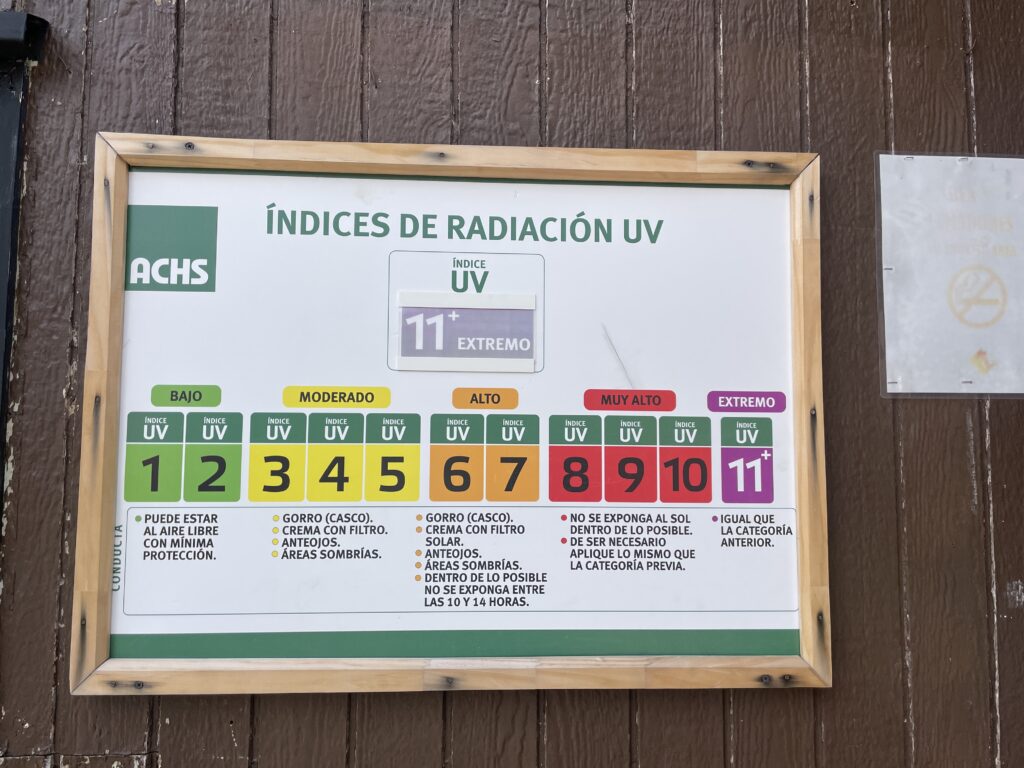
- *Bus Sur allows you to exchange bus times & day with ease.
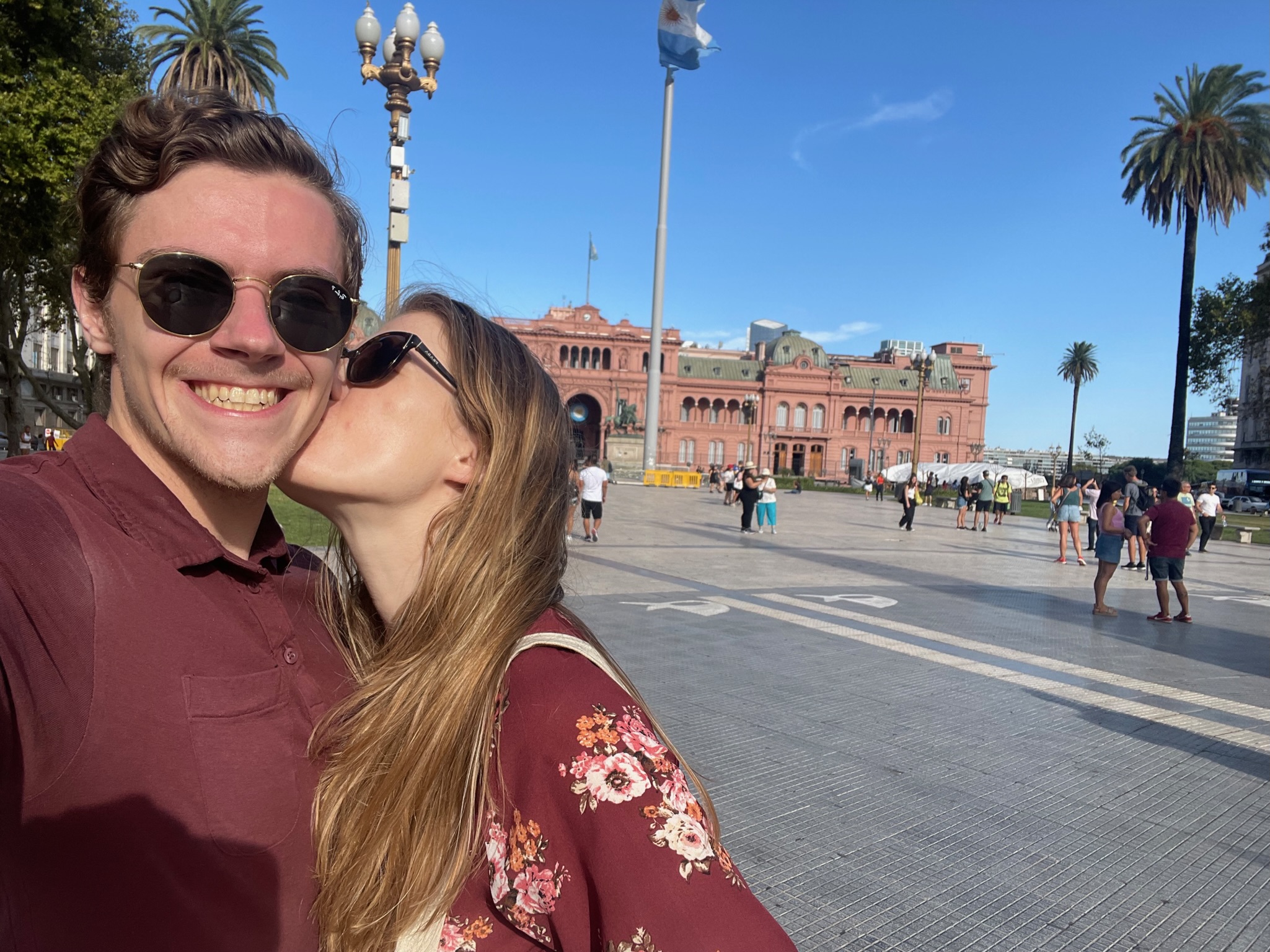
One Comment
These pictures are gorgeous…. I love how you help others prepare for a trip like yours and help them know what to expect. Well done!!!!
Leave a Reply Cancel reply
Your email address will not be published. Required fields are marked *
Save my name, email, and website in this browser for the next time I comment.
Notify me of follow-up comments by email.
Notify me of new posts by email.
- USA/Canada 1-888-232-3813
- Walking & Hiking
- Wildlife and Nature
- Multiactivity
- Photo Safari
- Excepcional Journey
- Water Adventures
- Food & Wine
- City Escapes
- Winter Adventures
- EcoCamp Patagonia
- Argentine Patagonia
- Chilean Patagonia
- Atacama Desert
- Santiago and Central Valley
- Easter Island
- Lake District
- Multidestination
- Northwest Argentina
- Uyuni Salt Flats, Bolivia
- For Families
- For Couples
- For Friends
- For Solo Travelers
- Central Valley
- Wildlife & Nature
- News & Awards
- Sustainability
- Outdoor Sports
- Yoga & Wellness

- Torres del Paine
The best of the W Trek, now in Winter. Ready for a trek of a lifetime?
See a different side of the iconic W Trek in Torres del Paine as few have ever seen or experienced it before. Trek into the heart of a Patagonian winter wonderland on this ultimate 6-day experience that takes you to the park’s iconic highlights such as the base of the Towers, French Valley and Grey Glacier. It’s a snowy trip (the use of crampons is highly recommend in some areas) made for true adventurers and those ready to explore Patagonia in a wild and rustic way! Departures available every Thursday from May to August.
- Famous W Trek in Torres del Paine.
- Unique fauna and flora.
- Magnificent winter scenery.
- Grey Lookout, French Valley, Nordenskjöld Lake, Base of the Towers and more.
- Recommended trek for experienced hikers.
Day 1: The Patagonian adventure starts.
In the morning, you will be picked-up from the Punta Arenas Airport and head towards your hotel in Puerto Natales, a lively town on the shores of Last Hope Sound (Ultima Esperanza). Here you'll have some time to relax, have lunch or dinner with your guide and get ready for the adventure to come!.
Overnight at Hotel Big Sur.
Day 2: The Towers Base Trek.
The adventure starts with a long day of hiking! After a refreshing night sleep, we’ll get in the van for a 2 hour ride and head to the trailhead of the Tower Base hike.
We’ll head up through the Ascencio Valley, located on the Towers' eastern face. Mountain ridges, nothofagus forests and small rivers line the scenic walk towards the valley. Our big challenge comes in the form of a steep moraine, a huge mass of boulders which will lead us to that iconic base-view of the Towers - three gigantic granite monoliths, the remains of a great cirque sheared away by the forces of glacial ice. After a tough uphill climb, the Towers eventually come into full view, rising majestically before us with the glacial lake visible below. Is there any better place in the world to have lunch? After feasting on the view and our picnic, we backtrack along the same trail through Ascencio Valley to finally head towards Grey Hotel to have dinner and spend the night.
Hiking Distance: 22 km./14 mi.
Hiking Time: 9 hrs.
Max. Altitude: 914 m./3000 ft.
Elevation gain: 1148 m. / 3766 ft.
Overnight at Hotel Lago Grey, Standard Room.
Day 3: Grey Navigation and Trek to Paine Grande
Today we will take the 9 AM navigation into Grey Lake, before reaching the face of the glacier, we will be dropped off at Refugio Grey, from where we will hike toward a lookout to take in the views of the immense Grey Glacier and then we’ll walk along the shores of Grey Lake to the northern side of Lake Pehoe. The day's trek will end with a soft climb through an undulating terrain of mixed grassland and light forest to Paine Grande´s Campsite.
Hiking Distance: 11 km./7 mi.
Hiking Time: 4 hrs.
Max. Altitude: 244 m./800 ft.
Elevation gain: 271 m. / 889 ft.
*During winter, the boat trip to Glacier Grey may be canceled due to weather conditions or low occupation of the navigation, if this is the case, we will hike the Las Carretas Trail (17Km. / 10.5 Mi.).
Overnight at Refugio Paine Grande (Shared dormitories).
Day 4: The Heart of the Paine Massif: French Valley.
After breakfast at Refugio Paine Grande, we will begin the challenging trek into the French Valley along a steep trail that leads to the very heart of the Paine Massif. How far we'll go depends on our trekking rhythm. A swifter walk will lead us to the hanging bridge over the French River, located at the foot of the south-east face of the Massif where we will be treated to fantastic views of the valley. We continue to ascend the upper section of the valley where we will be able to marvel at the extensive mass of the valley's geological formations. After our upward trek, we will pause for a picnic and relax for a while. This day's trek will end as we descend through the same trail back to Refugio Paine Grande.
Hiking Distance: 20 Km. / 12.4 Mi. (If you are hiking until Mirador Británico, that's an additional 4 Km. / 2.4 Mi.).
Hiking Time: 10 hrs.
Max. Altitude: 686 m./2250 ft.
Elevation gain: 820 m. / 2690 ft.
Day 5: Las Carretas Trail.
We will start walking from Refugio Paine Grande into the Las Carretas Trail, which is located close to the facilities of this Refugio, in direction to the south and into the Serrano Sector. We will leave the horns behind to make our return to the Serrano area. Once we reach the Serrano area, our transport will be waiting for us to take us to Puerto Natales.
Total hiking distance: 17 Km. / 10.5 Mi.
Hiking Time: 7 hrs.
Max. Altitude: 94 m./308 ft.
Elevation gain: 59 m. / 194 ft.
Day 6: Adiós Patagonia!
Today it is time to board the transfer back to the Puerto Natales Airport and take the flight to Santiago, in time to head back home or your next winter destination.
Please have in mind that there are flights departing from Puerto Natales but with fewer frequency than Punta Arenas (SKY Airlines has flights departing from PNT/Puerto Natales to Santiago each Tuesday during winter season) .
If you need to arrange transportation to Punta Arenas, please ask for advice to your Travel Experience Designer.
Accommodation
Hotel big sur (2 nights)..
Located in Puerto Natales, Hotel Big Sur has concierge services, non-smoking rooms, a terrace, free WiFi throughout the property and a bar. This 3-star hotel offers room service and a 24-hour front desk. At the hotel rooms include a private bathroom and bed linen. Guests at Hotel Big Sur can enjoy an American breakfast.
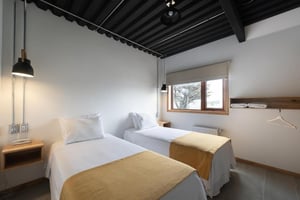
Hotel Lago Grey (1 night).
Located in Torres del Paine, Hotel Lago Grey offers free WiFi access. Rooms here are all fitted with heating, private bathroom and satellite television. At Hotel Lago Grey guests will find an ample complimentary buffet breakfast. There is an on-site restaurant and a bar.

Lodge Paine Grande (2 nights).
Located on the shores of Pehoé Lake, with beautiful views of the Paine Horns and the Paine Grande Hill. It is the starting point of the route to the French Valley and the path to the Grey Glacier.
Accommodation in Paine Grande will be in bunk beds and mixed shared rooms, including a mattress cover, pillow, sheets and comforter.

- All ground transport as indicated in the itinerary.
- National Park Entry Fee.
- One expert English/Spanish speaking trekking guide.
- 2-night accommodation in Lodge Paine Grande (Including mattress cover, sheets, pillow with pillow case and cover).
- 2-night accommodation at Hotel Big Sur.
- 1-night accommodation at Hotel Lago Grey, Standard Room.
- Day 1: Lunch or dinner (depends on your arrival time).
- Day 2: Breakfast, box lunch and dinner.
- Day 3: Breakfast, box lunch and dinner.
- Day 4: Breakfast, box lunch and dinner.
- Day 5: Breakfast, box lunch and dinner.
- Day 6: Breakfast and box lunch.
Important notes:
- Dinner is NOT included on day 6.
- For this trip, you’ll have to carry your own backpack. Please make sure you can fit all necessary equipment in a medium size backpack (we recommend a bag that is at least 60 liters) so you can fit all your items and walk comfortably. You can leave the rest of your luggage at our office in Puerto Natales while on the trek.
- During winter, light hours are few so we recommend bringing a headlamp fully charged and some extra batteries.
Not included
- Flight tickets.
- Insurance. (it is mandatory that you purchase appropriate insurance for this trip).
- Voluntary tipping of guides and staff.
- Items of a personal nature.
Starting/finishing point
This trip starts at Punta Arenas Airport and ends at Puerto Natales (airports or hotels).
* Please make sure your flight to Punta Arenas arrives prior to mid-day on Day 1.
Important Note: This trip departs ONLY on Thursdays due to operational considerations regarding the navigations inside the Park.
Fixed Departures are available on Thursdays from May to August, subject to availability of the accommodations involved on the program.
>> Do you want a private departure for this trip? We can do it, just send us an email.
Las Carretas Trail
This hike is the alternative for when either the Grey Navigation or the Pehoé Navigation are cancelled, allowing you to reach the next destination in the Park to continue the W Trek itinerary.
Departing from Grey:
Once we are all set, the excursion begins with a short drive from Grey Lake to the Serrano entrance point of the park, allowing some time to enjoy the beautiful winter views. Once we arrive at the Serrano entrance point, we’ll set off on a 7 hour (17 Km. / 10.5 Mi.) hike into the Park with the Paine Horns on the horizon until we reach our destination for the night, the Refugio Paine Grande which lies on the shores of Lake Pehoe at the base of the mighty Paine Massif.
Departing from Paine Grande:
In Torres del Paine and throughout Patagonia, transport is in minivans that normally seat up to 8 & 14 people.
The Patagonian Andes is very exposed to winds that circle the Antarctic landmass. In addition, the strong marine influence and the effect of the Southern Patagonia Icefield make the weather hard to predict.
Winter’s temperature range is between -2ºC/28ºF and 6ºC/43ºF. June, July, and August are the wettest months in Torres del Paine and sub-zero temperatures are common. Nevertheless, the winds are relatively mild in winter.
Group size guiding staff
- Maximum number of clients: 8.
- Guide to passenger ratio: 1:4.
Children policy
- Youngsters who are 16 years of age or older are welcome and are considered adults.
- This trip doesn’t offer a special discount for children.
What you need to bring
Essential equipment includes:
- Backpack. (minimum 60 liters)
- Sleeping bag.
- Trekking Poles.
- Waterproof trekking or hiking boots. (ankle supported)
- Extra shoes for evenings or in case others get wet.
- Warm waterproof jacket.
- 4 pairs of wool socks. (we recommend merino wool)
- Fleece jacket or sweater.
- Waterproof trekking pants.
- Comfortable loose pants.
- Sun protection. (glasses, hat, lip balm, and sunscreen).
- Polyester underwear for the upper and lower body.
- Quick dry towel.
Please Note: This list is just to give you an idea of what you will need. We will send you a more detailed list prior to the departure date of the program.
Itinerary modifications
The weather in Patagonia can be difficult to plan around at times. We reserve the right to change the order of the days in any itinerary as well as modify, change, or eliminate parts of the itinerary at the discretion of the trip guide based upon operational considerations.
Searching Availability...
Destinations | Chile
You may also like, hike the snowy andes in winter.
{{item.destinos_text}}
Glaciers Winter Experience
Skiing the chilean andes in valle nevado, awards & certifications.

- TERMS & CONDITIONS
- PRIVACY POLICY
Destination
- Multi Destination
- Salta Argentina
Experiences
- Multi-activity
- Exceptional Journeys
SOCIAL NETWORKS

Updated October 4th, 2022
Dear Traveler,
We are very happy to announce that there are currently no travel restrictions in Chile. Together with the above mentioned, it is mandatory to comply with the following requirements:
- You only have to present the vaccination certificate issued in your country when boarding to Chile. Those who do not have their vaccinations must present a negative result in a PCR test dated less than 48 hours from departure to enter Chile. Those who are under 18 years of age do not have any requirements to enter Chile
- A negative PCR upon arrival is not compulsory any more but diagnostic tests will be carried out randomly at the entry point to Chile. Confirmed cases shall be isolated according to the general health regulations.
- Medical insurance covering any expenses caused by COVID-19 is not compulsory any more
- The use of a face mask is voluntary
In case you have any questions, we will be happy to help you!
The Team at Cascada Expediciones & EcoCamp Patagonia
+1 206-892-8877

Send Us a Message
A guide to packing for the w trek in patagonia: expert tips and essentials.
The W Trek is a popular multi-day trek in Torres del Paine National Park, Chile. The trek is known for its stunning scenery, including glaciers, lakes, and mountains. However, the W Trek is also known for its unpredictable weather, which can change in a matter of minutes.
That's why it's important to be prepared for anything when you're packing for the W Trek. In this blog post, I'll share my ultimate guide to packing for the W Trek, including a detailed list of the essential items to pack, packing tips, and advice on packing for different seasons, fitness levels, and budgets.

Planning for the W Trek:
1. research and plan.
Before diving into the packing list, extensive research and meticulous planning are essential. Understand the W Trek's trail conditions, difficulty level, and weather patterns for the specific time of year you plan to visit. Torres del Paine experiences distinct seasons, each with its unique challenges. Summer (December to February) brings milder weather but larger crowds, while autumn (March to May) boasts beautiful foliage and fewer visitors but colder temperatures. Winter (June to August) is incredibly challenging due to heavy snow and limited services, while spring (September to November) offers a delicate balance between blooming landscapes and some snow-covered trails.
2. Clothing for Layering
Patagonia's weather is notorious for its unpredictability, even within a single day. Layering is key to staying comfortable and adapting to changing conditions. Start with a moisture-wicking base layer to keep sweat away from your skin. A lightweight and quick-drying t-shirt or long-sleeve top works well. Add an insulating layer like a fleece or down jacket to retain body heat. For the outer shell, a waterproof and windproof jacket and pants are crucial to protect against rain, strong winds, and potential snow. Invest in quality gear that can withstand harsh elements and ensure your comfort during the trek.
3. Hiking Footwear
Choosing the right footwear is paramount for the W Trek. Sturdy, waterproof hiking boots with ankle support are a must. Your footwear should be well-broken in before the trek to prevent blisters and discomfort. Additionally, bring a pair of lightweight camp shoes or sandals for relaxing at the end of each day and allowing your hiking boots to dry out.
4. Backpack
Selecting the appropriate backpack is vital, as it will carry all your essentials throughout the journey. Opt for a comfortable and durable backpack with a capacity of 50 to 70 liters (self supported) OR (35-50 liters - if you are choosing the Self Guided package program where your camping gear is setup on arrival each night -and you carry only your personal belongings - or you are choosing accommodation in the mountain huts/refugios where all the bedding and meals are provided.), depending on your personal needs and preferences. Ensure it has padded shoulder straps and a hip belt to distribute the weight evenly and reduce strain on your back.
5. Camping Gear
If you plan to camp along the W Trek, you'll need essential camping gear. A lightweight and compact tent is essential, as well as a warm sleeping bag rated for the season you're hiking in. Additionally, a sleeping pad will provide insulation from the cold ground and add extra comfort during your rest. When booking the he package self guided program you dont carry any of the camping gear as it is supplied and setup each night on your arrival to camp. Meals are also provided in these programs.
6. Food and Snacks
While there are some refugios (shelters) along the W Trek where you can purchase meals, it's essential to carry some food and snacks with you, especially for longer stretches between refugios. Lightweight and calorie-dense options like energy bars, nuts, dried fruits, and instant meals are excellent choices. Don't forget to pack a portable stove and cooking utensils if you plan to prepare your meals. (when booking the self guided package all meals are cooked and provided each night, you will only want to carry some snacks, however these can also be purchased in the refugios).
7. Water and Hydration
Access to clean water is abundant along the W Trek, as you can refill your water bottles at streams and rivers. However, to ensure your safety, carry a reliable water filter or purification tablets to eliminate any potential contaminants. Staying hydrated is crucial, especially during physical exertion at high altitudes, so make sure to drink plenty of water throughout the trek.
8. Essential Toiletries and First Aid
Maintaining personal hygiene is essential during extended hikes. Pack biodegradable soap, a quick-drying towel, and eco-friendly toiletries to minimize your impact on the environment. A comprehensive first-aid kit should include bandages, antiseptic ointment, pain relievers, blister pads, and any personal medications you may require.
9. Navigation Tools
While the W Trek is well-marked, carrying navigation tools is a wise precaution. A detailed map, compass, or GPS device will help you stay on course, especially in adverse weather conditions or low visibility. Familiarize yourself with the trail map and landmarks beforehand to boost your confidence on the hike. ( In the Self guided package trips a trip briefing is scheduled the day prior to your trip departure to familiarize yourself with the trails and the professionals staff can answer any questions ahead of time).
10. Miscellaneous Items
Apart from the essentials mentioned above, a few additional items can enhance your experience. A lightweight and compact camera will allow you to capture the breathtaking vistas and abundant wildlife. A portable charger or solar power bank will keep your electronic devices charged throughout the journey. Additionally, pack a headlamp, a multi-tool, and extra zip-lock bags for organizing and protecting your belongings.
ELECTRICAL & WIFI ACCESS
Power outlets in refugios are mainly found in common areas, with Refugio Grey being the exception, offering them in dorm rooms. Bring a portable charger, and utilize power strips at front desks. Activate airplane mode to save energy. Wi-Fi is available at all refugios for $10, providing 8 hours of access. Basic online tasks are feasible, excluding streaming.
11. Leave No Trace Principles
As you embark on this unforgettable adventure in Patagonia, remember the Leave No Trace principles. Respect the pristine wilderness, wildlife, and local communities by minimizing your impact. Dispose of waste responsibly, adhere to designated campsites, and avoid disturbing the flora and fauna. By adopting these principles, you contribute to preserving this natural wonder for future generations of trekkers.
The W Trek in Patagonia's Torres del Paine National Park promises an extraordinary and life-changing journey for those willing to embrace its challenges and marvel at its splendor. By researching, planning, and packing carefully, you'll set yourself up for a successful and gratifying experience. Remember to be flexible and adapt to the ever-changing conditions of Patagonia, and above all, immerse yourself fully in the raw beauty of this magnificent region. Happy trekking!

Packing Tips:
- Pack light and efficiently. You'll be carrying your backpack on your back for several days, so it's important to pack light as possible. Only pack the essentials and leave anything non-essential at home.
- Prepare your clothing for the unpredictable weather. Patagonia is known for its unpredictable weather, so it's important to pack clothing that can handle a variety of conditions. Pack layers so that you can add or remove layers as needed.
- Pack for different seasons. The climate in Patagonia can vary depending on the time of year. If you're hiking in the summer, you'll need to pack lighter clothing. If you're hiking in the winter, you'll need to pack warmer clothing.
- Pack for emergencies. It's always a good idea to pack for emergencies when you're hiking in the wilderness. Pack a first-aid kit, a headlamp, and a survival blanket.
What weather can be expected on the W Trail?
Patagonia's weather is notoriously unpredictable and can vary greatly depending on the season and location within the region. The W Trek in Torres del Paine National Park , being located in southern Chilean Patagonia, experiences distinct weather patterns throughout the year. Here's an overview of what weather you can generally expect during different seasons:

Summer (December to February):
Summer is considered the best time for trekking in Patagonia due to milder temperatures. However, it can still be quite variable. Daytime temperatures typically range from 10°C to 20°C (50°F to 68°F), but they can occasionally reach higher. Nights can get colder, dropping to around 5°C to 10°C (41°F to 50°F). During this time, you might experience more extended daylight hours, making it ideal for longer hikes. Be prepared for occasional rain showers, strong winds, and even some snowfall at higher elevations.
Autumn (March to May):
Autumn in Patagonia is characterized by stunning foliage as the forests turn shades of orange and red. The temperatures begin to drop, with daytime highs ranging from 5°C to 15°C (41°F to 59°F) and nighttime lows hovering around 0°C to 5°C (32°F to 41°F). While the crowds thin out compared to the summer months, you should be prepared for colder weather and increased chances of rain and wind.
Winter (June to August):
Winter in Patagonia is harsh and inhospitable for most hikers. The W Trek is generally not recommended during this time due to heavy snow, extreme cold, and limited services. Daytime temperatures can hover around 0°C to 5°C (32°F to 41°F), and nighttime temperatures often drop below freezing. Trails can be inaccessible or dangerous due to snow and ice, and many refugios and facilities may be closed. If you plan to visit during winter, be prepared for extreme conditions and consider alternative activities such as snowshoeing or skiing.
Spring (September to November):
Spring is a transitional season when the landscape starts to come alive again after the winter freeze. Daytime temperatures range from 5°C to 15°C (41°F to 59°F), and nights are still chilly, with temperatures around 0°C to 5°C (32°F to 41°F). Spring can be windy and prone to rain, but it also offers opportunities to witness blooming flora and newborn wildlife. Be prepared for varying weather conditions and potential trail closures due to melting snow and high rivers.
Regardless of the season, it's crucial to be prepared for sudden weather changes in Patagonia. Always carry proper rain gear, warm layers, and clothing suitable for different conditions. Check weather forecasts before your trip and be ready to adapt your plans if needed to ensure a safe and enjoyable trekking experience.

How difficult is the W Trek in Patagonia?
The W Trek in Patagonia is considered to be of moderate to challenging difficulty, depending on your hiking experience, physical fitness, and the weather conditions during your trip. The trek covers a total distance of approximately 70 kilometers (43 miles) and usually takes 4 to 5 days to complete. The difficulty level can be attributed to several factors:
The trail consists of varied terrain, including steep ascents and descents, rocky paths, and muddy sections, especially after rain. Some parts of the trail involve traversing over boulder fields and river crossings, which can be challenging, especially in adverse weather.
Patagonia's weather is highly unpredictable and can change rapidly. Hikers should be prepared for strong winds, rain, and potentially even snow, regardless of the season. These weather conditions can add to the difficulty of the trek and require appropriate gear and clothing.
Length of Hiking Days:
Each day of the W Trek involves hiking for several hours, often with long stretches of continuous walking. This can be physically demanding, especially if you're not accustomed to long-distance hiking.
Weight of Backpack:
If you choose the self-supported option and carry your camping gear and supplies, your backpack's weight can significantly impact the difficulty of the trek. Properly packing and distributing weight in your backpack is crucial to prevent strain and discomfort.
While the W Trek doesn't involve extreme altitudes, the trail does reach elevations of up to 1,200 meters (3,937 feet) at certain points. Some hikers may experience mild altitude-related effects, such as shortness of breath, especially if they're not acclimated to higher elevations.
Despite these challenges, the W Trek is accessible to individuals with a moderate level of physical fitness and hiking experience. With proper preparation, training, and the right equipment, many adventurers of various skill levels successfully complete the trek and are rewarded with breathtaking views of Patagonia's stunning landscapes.
It's crucial to be well-prepared before attempting the W Trek. Prioritize physical fitness by engaging in regular exercise and hiking activities to build endurance and strength. Familiarize yourself with the trail, research weather conditions, and pack appropriate clothing and gear. Consider hiring a local guide or joining a guided tour if you're unsure about navigating the trail independently. By taking these precautions, you'll be better equipped to handle the challenges and fully enjoy the unforgettable experience of trekking through Patagonia's majestic wilderness.
Feel free to print this checklist and use it as a handy reference while preparing for your W Trek adventure in Torres del Paine National Park. Safe travels and enjoy your journey!
Your Printable W Trek Packing List:
Clothing Checklist:
- ▢ Base Layer (1): Versatile for sleeping and relaxation.
- ▢ Trekking Pants (1-2 pairs): Comfortable and durable for extended hikes.
- ▢ Trekking Shorts (1 pair): For warmer weather and post hiking
- ▢ Socks (2-5 pairs): Merino wool for odor resistance; wear one for daytime and air it out, use the other for nighttime comfort.
- ▢ Moisture-Wicking Base Layers (top and bottom) (1, long-sleeve): Merino wool for odor control; consider an extra top layer and hiking base layer pants for colder weather.
- ▢ Rain Pant (1) and Rain Jacket (1): Waterproof essentials for unexpected rain.
- ▢ Synthetic Lightweight Jacket (1): Versatile for mild temperature drops.
- ▢ Down Jacket (1): Added warmth for chilly evenings.
- ▢ Footwear (1 pair of Sandals or Crocs): Versatile, suitable for wearing with socks in cooler weather.
- ▢ Towel (1): Compact and multifunctional for various uses.
- ▢ Underwear (5 pairs): Ensure freshness and comfort with a supply of five pairs.
- ▢ Sports Bras (2): Two for added comfort and support.
- ▢ Gloves (insulated and waterproof)
- ▢ Hats (1 sun hat + 1 beanie): Sun protection during the day and warmth at night.
- ▢ Buff/Facemask (1): Multifunctional; can double as an eye mask for better sleep.
- ▢ Sunglasses with Croakies (sunglasses straps): Secure your sunglasses and prevent loss during your trek.
- ▢ Hiking Boots
- ▢ Gaiters (optional)
Toiletries Checklist:
- ▢ Shampoo and Soap - Eco Friendly
- ▢ Small Toothpaste: Compact for travel
- ▢ Deodorant: Stay fresh and odor-free
- ▢ Sunscreen & Lotion
- ▢ Toothbrush: Compact
- ▢ Comb: Maintain well-groomed hair on your trek
- ▢ Hand Sanitizer
- ▢ Lip balm with sun protection
Miscellaneous:
- ▢ Small First Aid Kit
- ▢ Head lamp and batteries
- ▢ Water bottle (1 liter) or Bladder
- ▢ Maps and Small GPS
- ▢ Insect Repellent
- ▢ External Battery Pack: Essential for charging your camera and phone on the go.
- ▢ Phone: Loaded with videos, podcasts, and books to help you unwind on restless nights.
- ▢ Cash: for small purchases in the refugios on the trail ie. snacks, beer, wine…
Permits and Documentation:
- ▢ Park Permits (included in the self guided & guided packages)
- ▢ Identification (copy of passport, driver's license, etc.)
Gear and Equipment:
- ▢ Trekking Poles: Enhance stability and reduce leg strain during the trek.
- ▢ Backpack 30-50L for supported trips Larger for self supported trips where you carry all camping gear, food and cooking supplies.
- ▢ Rain Cover for Backpack
- ▢ Sunglasses Polarized
*The following (gear & food suggestions) are ONLY needed for self supported trips, we recommend booking a supported guided or self guided trip where all of the meals, transportation, permits, accommodation refugios (mountain huts) or camping is included. If Camping, all of the gear (tent, sleeping pad, sleeping bag..etc) is provided and set up each night for you on arrival to camp. If in Refugios all of the bedding is provided, rooms sleep 4-6 people in single bunk beds.
- ▢ Sleeping Bag (cold weather rated)
- ▢ Tent (if camping)
- ▢ Cooking Equipment (stove, cookware, utensils, if camping)
- ▢ Please note: Water Filtration System (purifier or tablets) - not necessary as all the streams in the park have potable water and drinking water can also be obtained at the refugios.
Food and Hydration:
- ▢ Dehydrated Meals
- ▢ Snacks (energy bars, nuts, dried fruits)
- ▢ Water Bottles (multiple)
- ▢ Hydration Reservoir (optional)
Final Tips:
- ▢ Check the weather forecast before your trip
- ▢ Test your gear to ensure it's in working order
- ▢ Respect Leave No Trace principles
Map of Torres del Paine and the Trails:

Is a guide necessary for the W trek?
No, the trails are well marked the there are many people on the trails, so you wont get lost. The need for a guide on the W Trek in Patagonia depends on individual preferences and experience. Trekking with a guide offers expertise, safety, and logistics support, but it can be costly and less flexible. Trekking independently is budget-friendly and allows for more flexibility, but navigation challenges and limited local knowledge may arise. Whether with a guide or not, prioritize safety, respect the environment, and follow the Leave No Trace principles. We recommended most people arrange a self guided package in camping or refugios . These packages take out the logistical nightmare of trying to arrange everything independently. These self guided packages include all of the transportation from Puerto Natales to the park, the permits, and other necessary tickets, all meals, a trip briefing with maps, all the bedding for the mountain refugios - and if choosing camping we setup all the gear each night in your arrival, so no need to carry a tent, sleeping bag or mat.

Additional Tips:
- Research the weather forecast for the time of year you'll be hiking. This will help you pack the right clothing and gear.
- Pack a variety of snacks and food. This will help you stay energized on the trail.
- Bring plenty of water. It's important to stay hydrated, especially in hot weather.
- Let someone know where you're going and when you expect to be back. This is a safety precaution in case something happens.
- Enjoy the hike! The W Trek is a beautiful and challenging hike. Make sure to take your time and enjoy the scenery.
Packing for the W Trek can be a daunting task, but it doesn't have to be. By following these tips, you can be sure to be prepared for anything that the W Trek throws your way.
Looking for a custom trip, or would you like to talk with a local travel expert about Patagonia? Please contact us here - or Call/WhatsApp us +1 206-892-8877.
Related trips, subscribe to our newsletter.
Stay up to date on whats new, and exclusive deals!


The W Trek Route Itinerary and Complete Guide to Torres Del Paine National Park: 5 Days 4 Nights
The W Trek Route Schedule and Complete Guide to Torres Del Paine National Park: 5 Days 4 Nights- An itinerary for the W Trek Hike in Torres Del Paine in the Patagonia region of Chile. The guide will answer all your questions on how to book, where to stay, what to pack, how difficult and what to expect and see along the W Trek. Deciding if you should camp or stay in refugios along the W Trek? This guide will answer what we did and why.

What is the W Trek?
The W Trek is a 74 to 80 kilometer hike in the Torres Del Paine National Park in the Patagonia region. Torres Del Paine National Park is located in both Chile and Argentina. The W Trek is in the region of the park that is in Chile. It is called the W Trek because the trail takes you in the shape of the letter W. This trek takes you to many iconic views in the Torres Del Paine National Park, blue lakes, mountains, rivers, glaciers, waterfalls and more!
The hike is a through hike, being that you start and end at different points. The W Trek hike can be completed many different ways, but a huge appeal to many (and me) is that food and accommodation is set up along the trail. So it is optional to carry your own shelter and food.
Can You Go Without A Guide?
Yes! It is quite easy to go without a guide. The trail is very clearly marked and very easy to navigate. Some people decide for a guide to help inform them about the park and help set a hiking pace. In the winter months it is actually required to have a guide. But if you are planning for spring, summer or fall no guide is needed.
When To Go?
December to March is the prime season to go for the warmest weather. But with that great weather is crazy winds, so be prepared for any type of weather wherever you go. December and January may be the most crowded months as many people have time off for the holidays, and it is considered Patagonia’s summer months. We went in December and never felt like it was overly crowded. Only for the first day as many people just hike to The Three Towers as a day hike. April will be fall, and might make a spectacular view with warm colors as that is the peak of their fall season.
What To Pack?
We went in December, which is considered their summer. I listed everything we packed and their uses in my What To Pack For The W Trek post. If going in the winter, I would check out this W Trek Winter Packing List as well. Now my list is for using their accommodation and meals, if not using their services sleeping gear and cooking tools are needed as well.

Do I Need To Bring My Own Food?
Again, they do provide this for you at a price. The price seems high but to me I believed it was very worth it as I did not only have to carry my own meals for 5 days but the heavy cooking gear that goes with that. I covered a lot of prices about food on my W Trek Tips and Tricks page. We did bring our own favorite granola bars, jerky sticks and snacks, but besides that that is all we brought. We used their services for breakfast, lunch and dinner, all booked through Chile Nativo .
I did enjoy that you could buy adult beverages and other snacks at the refugios, it was nice to have a cool drink overlooking the mountains and glaciers at the end of a long hiking day.
If I didn’t answer your questions yet I cover a lot of basic W Trek questions in my post FAQS, Tips and Tricks About The W Trek Hike . I have tons more of information there about general questions, how to train, what the food was like, the beds in the refugios, price of drinks and more.
How To Book Accommodations?
Booking the W Trek accommodation is one of the hardest parts of the trail. There are different companies for refugios and campsites, so booking them might mean going to different sites during different times to get your route booked completely. I listed which refugios and their websites in which we stayed below throughout my itinerary.
Refugio and Camping Companies
- Fantastico Sur
Camping and bringing your own food will be the cheapest route but do keep in mind that if you don’t want to camp or bring your own food that the price of food and stay reflects the remote and sought after location. Know that the convenience of not having to carry a tent, bedding food, and cooking equipment comes with a cost.
**You will mostly likely need to book accommodations for before and after the W Trek, most stay in that closest town, Puerto Natales. We wished to stay at the same place in Puerto Natales before and after the hike, but that didn’t work out for us. But we did stay in two great places before and after the W Trek. I would highly recommend both of these!
Hotel Vendaval (great restaurant next door, we ate there twice!)
Factoria Patagonia
Why Book With Chile Nativo?
We traveled over the Christmas and New Years holidays to South America. This is a popular travel time as many people get extra days off work and it is also the peak of the Patagonia summer. This makes booking refugios and camping spots more competitive. Pay attention to when each company opens up their availability if wanting to book, we thought we were on top of it but we missed out. Chile Nativo came to our rescue, we first thought this would be a lot more money booking with a tour company, but when we totaled it out it was a very good deal compared to what we planned on spending. They took care of everything, which made the trip a whole lot easier, less stressful and more enjoyable.
Chile Nativo had everything taken care of. We met with them the day before our hike, where they gave us all of our tickets, all of the transportation, park tickets, refugio, cabin, bunk, and meal tickets. All in order of when we would need them. They gave us times, addresses for transportation and even went through the trek with us giving us some tips of how long it should take, difficulty in certain sections and more.
If you are hesitant and confused on booking the trek yourself definitely reach out to Chile Nativo !
The night before we had a 20 minutes briefing with Chile Nativo, going through our tickets, routes and tips. They also gave us a bagged lunch for the next day’s hike. Suggested that we request an early breakfast from our hotel the next morning as we had a super early start. And was even kind enough to store our luggage to be taken to our hotel when we came back. It could not have been easier.

Our Itinerary for 5 Days 4 Nights
Schedule overview.
Here is a short layout of our trek, read below for more details of the hike.
- Bus Transfer from Puerto Natales to Torres del Paine (2 hour drive)
- Drop your backpacks off at Central Refugio
- Hike 22km round trip to Three towers base and back to Central Refugio to stay the night.
- Hike 4 to 5 hours to Refugio Los Cuernos .
- Hike 5 km to camp Italiano Ranger Station, leave bags
- 1.5 hours to the French Valley lookout, the Britanico Lookout and, then back to Italiano ranger station ( 3-4 hours total)
- Hike with bags to Refugio Paine Grande , 7.5km
- Hike 11 Km with bags to Refugio Grey
- Leave bags, and hike to Glacier Lagoon and the two Hanging Bridges (2-3 hours)
Hike back to stay for the night at Refugio Grey
- Hike back to Refugio Paine Grande , 11 km
- Get on boat, then bus to head back to Puerto Natales
Detailed Schedule
Day 1: three towers, transportation.
Our first day started with our transportation from Puerto Natales to the Torres Del Paine National Park. So getting up early we walked to the Rodoviario Puerto Natales Bus Station to get on our pre booked bus. The bus ride to the park was about 1.5 hours.
Entering Torres Del Paine National Park
There are three steps before you can enter the park. First, is watching a short video on the history, conservation, rules and tips of the park. Second, you will need to sign a waiver. And last, you will need to show them your ticket (already booked with Chile Nativo for us). After that you can take a park bus for about a 15 minutes to get to the official entrance.
This bus ride will drop you off in your last checkpoint. Here you will need to either show them that you have a day pass or show that you have reservations to stay in the park.
Drop Bags Off
The Hike to The Three Towers
Route: Entrance, to the Three Towers, back to Central Refugio
Distance: 22 kilometers round trip (13.7 miles)
Time: 6-7hrs (add in additional time at the top, we took about an hour extra)
Where To Stay
We stayed at Torres Central Refugio .
They also have campsites for tents there. Another close option would be EcoCamp Patagonia or if looking for a more plush option this is the only area with a hotel, Hotel Las Torres . If wanting not as long as a hike for day one you can stay and camp at Chileno Refugio , although the Refugio Torres Central has much nicer accommodations.
The trail will start down a small path and will quickly go straight up. The first part of this trail was probably the most frustrating. It started to incline immediately through a very rocky area. Because this is the most popular part of the hike it was very crowded, lots of tour groups on day trips. This made it very hard to pass on this part of the trail. Once past this section all was good.
The first very scenic section of this hike in the Windy Pass. This area will overlook a river valley. Lots of greenery, flowing river and mountain tops while you go on the trail along the mountain edge.
Chileno Campsite/Refugio
Next pass will be across the river and right by the Chileno Refugio and campsite. This area does have spigots if you need a refill on water, restaurants and restrooms.
Back On The Trail
The next long section will be through some wooded areas. Using bridges to pass over streams. And one last overlook, with restrooms and rest areas before the last final accent.
The Three Towers
One of the hardest parts of the trail is the final accent to The Three Towers, Mirador Las Torres. This takes most people 45 minutes to an hour for this uphill climb. It is very rocky and sometimes even sandy. We hit it at a very sunny part of the day, requiring some water stops and a sunscreen stop.
At last, the final and most famous site in the park. The Three Towers (Mirador Base Las Torres), we spent about an 1- 1.5 hours at the top. Resting our legs, eating our packed lunch, some photos and taking in the view. This place is majestic, I would suggest hiking a little bit more to the side to avoid the crowd and getting close to the water.
The hike back to the refugio is the same on the way up. This is an out and back hike.
It took us about 3.5 hours to hike up, an hour at the top and 3 hours to hike down.
Back at the refugio we showerd, changed our clothes and got a pre dinner drink before a time slot for dinner at Central Refugio. They also had some board and card games we played with new friends after dinner.

Day 2: To Los Cuernos
Route: From Central Refugio to Los Cuernos Cabins/Refugio
Distance: 13 kilometers one-way hike (8 miles)
Time: 4-5 hours
We stayed at Los Cuernos . Stay in cabins if you can they are absolutely so much fun, and peaceful. A nice change from the bunk beds in the refugios. But they are more expensive, so if not wanting to they do have standard refugios bunk beds as well.
They also have camping there. Another close option would be Camping Francés or Camping Italiano , both camping only.
After breakfast we picked up our bags and got on to the trail. Today most of the day will be walking around lake Lago Nordenskjold. It is a pretty mellow trail along the lake. Lake on one side and mountains on the other. This is one of the shorter hikes along the route. Which found itself very nice after one of the hardest days that day before.
You will pass some streams coming off of the mountains, some with bridges and some without.
My favorite part of the hike was nearing the end. It was overcast most of the day but the sun came out and the blue waters really started to shine and be vibrant. And we also spotted our coolest stay of the hike, our cabins nestled in the mountain side.
Los Cuernos
If you can stay here I advise to spend the extra money to stay in these cabins. They were connected to a refugio, so we still got to use the showers, bar and meals as the rest of the hike. After dinner we brought our beers back and watched the sun go down from our little porch. I also heard there is a hot tub for cabin guests but never saw one or looked too much for it.

Day 3: The French Valley
Route: From Los Cuernos to French Vallery (additional hike to Britanico), to Refugio Paine Grande
Distance: 18 kilometers (11.2 miles)
Time: 8-9 hours
We stayed at Refugio Paine Grande .
They also have camping, and you are able to rent tents there. There are not many other refugios or camping options in this area.
Italiano Ranger Station
We tried to get another early start after breakfast this day as we had another long day ahead of us. This day was both mine and my husband’s favorite day of the W Trek. It starts along the lake Lago Nordenskjold, with more magnificent views of the mountains on the other side. Eventually you will cut up through the wood to the ranger station.
You definitely want to leave your large packs when you can, makes hiking sooo much easier.
French Valley
From the Ranger Station the next major stop will be to the French Valley viewpoint. This is a stunning area. But to get here will be a walk along the river weaving in and out the wooded areas. Many stay here for lunch as it is a spectacular view. A 360 degree view of lakes, mountains, rivers and glaciers. This section of the trail should take you 45-60 minutes.
Britanico Lookout
Britanico Lookout is an optional add-on for the W Trek. We decided to take it, because we were there and why not? It will add on a few additional kilometers, or about 40-60 minutes to your hike. But well worth it. And not a very hard hike as well. After passing French Valley you will again walk along some rushing streams and wooded areas. Then through some rocky widespread area where you will be completely surrounded by the famous mountains in Patagonia, you can even spot the back of The Three Towers from here. Another jot through the woods and up to Britanico Lookout. We chose to eat lunch here before it started sprinkling and we headed back down. The return route to the same back to The Italiano Ranger Station to pick up our bags.
To Refugio Paine Grande
The next leg of this hike is 7.5 kilometers to our stay at Refugio Paine Grande for the night. Here we passed some very windy areas along Lake Skottsberg. The wind was so strong it was picking up the wave off of the lake. Take some time along this route to look back at the mountains and scenery, they were some of my favorites views. Eventually the hike will level out and you will see Lago Pehoe super blue lake in the distance will be Paine Grande nestled right next to the lake. Stunning views from this refugio.

Day 4: Glacier Grey
Route: Refugio Paine Grande to to Refugio Grey (additional hike to Hanging Bridges)
Distance: 11 kilometers (6.8 mile), plus optional route to hanging bridges round trip
Time: 4 hours, plus 2-3 hours for hanging bridges
Where to Stay
We stayed at Refugio Grey
They also have camping spots and tents to rent there. No other refugio and camping options along this route.
Route: Refugio Grey to Refugio Paine Grande
Distance: 11 kilometers (6.8 miles)
Time: 4 hours
Today we hiked to our last refugio to stay along the W Trek, Refugio Grey. This refugio is named after the glacier it sits by, Glacier Grey. One of the most massive glaciers that I have seen in my life. We saw a lot in Norway and Iceland too! But this one went as far as we could see.
To get there you will first walk through some meadow areas out of Paine Grande Refugio. This hike will eventually spit you out to complete the rest of the hike mostly on rocky paths along Lake Grey to the glacier.
As you get closer you will see blue glacier pieces floating on the lake, one that have broken off of the glacier.
This hike was fairly easy, we took is kind of slow being our last day. The hardest part of this trail it as you get closer to the glacier one of the section is rocky and runs through a small stream. Use good footing and take it slow and all should be fine to get through it.
Refugio Grey
At last you will arrive at this charming build, Refugio Grey. This is the only stay we did stay in a tent. We were pleased to see that the tents are all ready set up, we just needed to check in and get out bedding. They let you choose your tent, add a tag to it. So we picked ours our set our bags down and went to my favorite part of today’s hike
Glacier Lagoon
This is a very short and easy walk from the refugio, so if anything I highly suggest hiking here. We brought our lunch to enjoy here. Absolutely gorgeous.
Hanging Bridges
The hike to the two hanging bridges should take you 2-3 hours. There are two hanging bridges, I suggest going to the second one and it has much better views over the glacier. Even walking a tad past the second bridge from some designated overlook platforms.
We hurried back to shower and change before dinner. Today was our last day on the trail, so we made sure we got a few drinks overlooking the mountains, played some games and chatted with new friends. Definitely a great last night on the trail.

Day 5: Hike to Paine Grande and Transfer Back
The hike today is just taking the 11 kilometer hike that you took the day before. You will be going back to Paine Grande to get on the bus back to town. This day it took a lot shorter amount of time than the day before, as it seemed more downhill. And we also didn’t stop for pictures and viewpoints as we saw them the day before. We arrived early to Paine Grande and just missed the first boat option, so we got some drinks and played some card games until the next one.
The Transport Back to Puerto Natales
At Paine Grande you can either take the boat back to catamaran dock station or walk to the dock. This route will add on many more kilometers. Most hikers take the boat.
During the summer the boat runs 4 times a day. When we were there it ran at 9:35, 11:35, 17:00 and 18:35. You will pay on board or show your ticket (which Chile Navito provided for us) and it is on a first come first served. So once we saw a line forming we got it in. The boat was a beautiful ride, taking us along the blue waters and getting some last final views of the Torres Del Paine mountains.
The Bus to the Entrance
The boat will drop you off at the catamaran dock. Here you will need to hop on the bus back to the main entrance of the park. This is only a 15 minute drive bus ride.
The Bus to Puerto Natales
From the main entrance we waited until our pre paid bus came to bring up back into Puerto Natales
Where To Stay in Puerto Natales

You May Also Be Interested In These Articles:
FAQs, Tips and Tricks About the W Trek in Patagonia
What To Pack For The W Trek
Hiking Monte Fitz Roy in El Chalten
Visiting the Perito Moreno Glacier in Argentina
3 Days in Mendoza, Argentina
24 Hours in Santiago, Chile

Related posts:
3 thoughts on “ the w trek route itinerary and complete guide to torres del paine national park: 5 days 4 nights ”.
- Pingback: 3 Weeks in South America: Chile And Argentina - aliciamarietravels
- Pingback: what is a dissertation
- Pingback: tadalafil pulmonary arterial hypertension
Leave a Reply Cancel reply
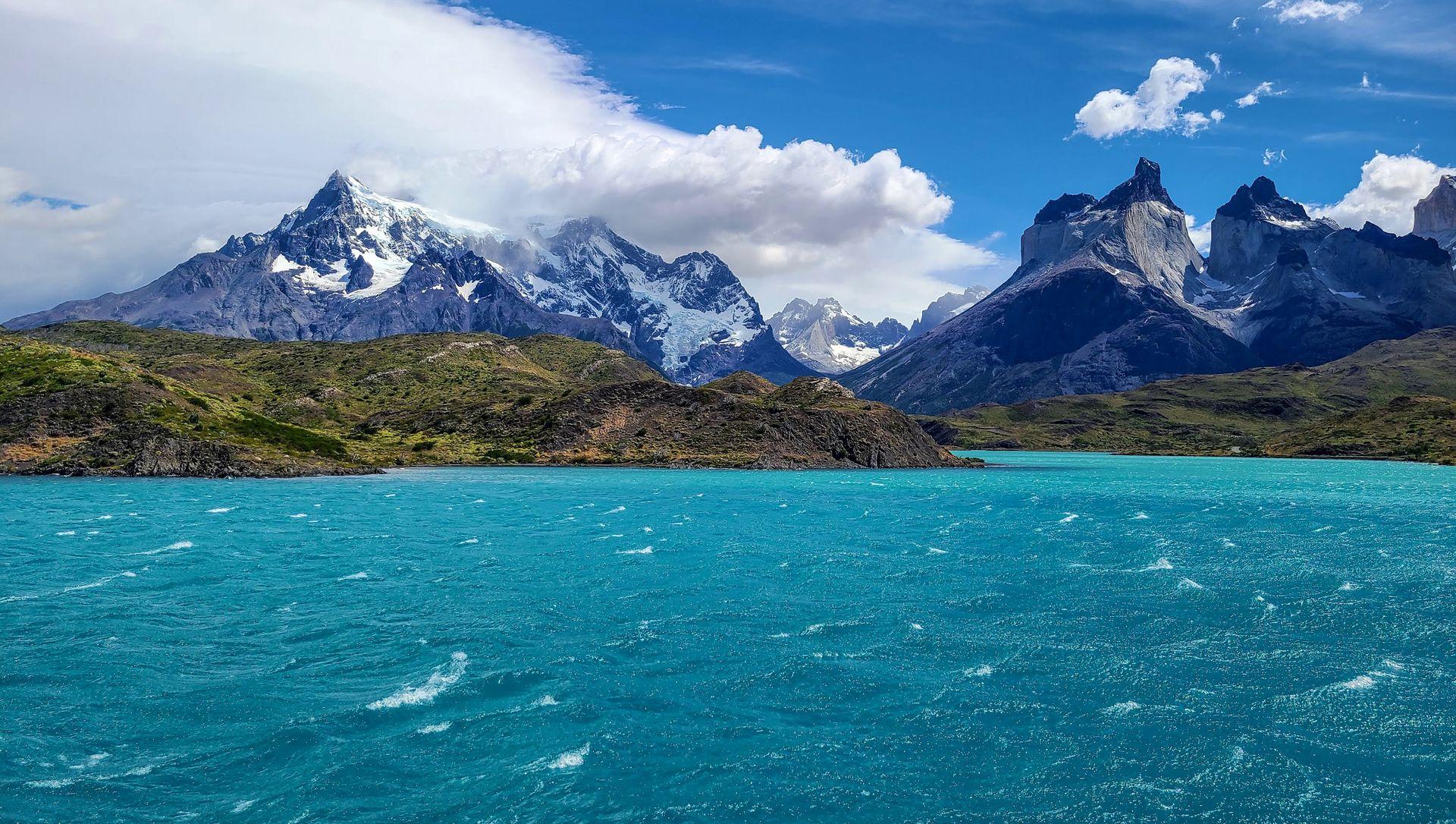
The Ultimate Guide to Hiking the W Trek in Patagonia: Full Itinerary, How to Self Book, Cost Breakdown & More!
March 28, 2023.
Hiking the W Trek in Torres Del Paine National Park is an incredible experience that will reward you with endless views and memories that will last a lifetime. You will see jagged mountain peaks, aqua blue lakes, waterfalls, glaciers and more as you take the journey. If you’re lucky, you’ll also see giant condor birds and make new friends as you stay at the inns along the way.
I found the W Trek to be incredibly rewarding and definitely worth the effort, planning and costs. The trek is also perfect for those who are newer to backpacking but are experienced day hikers. Trekking during the day with inns to stay overnight is the perfect combination!
This blog includes a W Trek itinerary and covers everything you need to know to book the W Trek self guided, pack for the W Trek and be prepared. This is based on my experience visiting over New Year’s in December 2022 and January 2023.
Table of Contents
Overview of the w trek, when to hike the w trek, hiking the w trek self guided vs with a guide, how to book the lodging for the w trek, booking an entry ticket to torres del paine national park, booking transportation between puerto natales and torres del paine national park, w trek planning checklist (for self booking), tips and important things to know before hiking the w trek, day one of the w trek, day two of the w trek, day three of the w trek, day four of the w trek, how should you end the w trek, ways to save money on the w trek, what to pack for the w trek, other ways to see torres del paine national park, faqs about the w trek, final thoughts.
- Located in Torres Del Paine National Park, Chile
- 50 miles/80 km
- Typically done in 4 Nights, 5 Days
- The highest elevation is at the Base of Towers, 2,788 feet above sea level
The W Trek refers to a multi-day hike that is shaped like the letter W. This area is unique because there are several inns along the trek where you can spend the night. You can choose between hostel-style lodging, have them provide you a tent at the campgrounds or bring your own tent. Each inn serves food, has restrooms and showers and even offers wifi for an additional fee.
The W Trek is about 50 miles and is typically done in 5 days and 4 nights. There are very few technically challenging sections of the trail, but there are long days with steep climbs. If you have experience hiking 10+ miles in a day in mountainous areas and feel that you can do that for a few days in a row, then you will be set up for success.
Because of the amenities offered, this is a great trip to do if you’re new to backpacking or if you just prefer to stay in a bed instead of a tent. If you stay in the refugios and purchase their full room and board package, you will not have to carry all of your food, water and sleeping equipment. The lighter you can pack for the trek, the more comfortable you’ll be.
While the hike itself is not overly difficult, dealing with the unpredictable weather is the toughest part. I experienced really high winds during my trek. Bad wind is common and it’s not uncommon to experience heavy rain, fog or even snow. You’ll want to make sure you’re prepared with the good layers and keep your expectations low in case it’s too foggy to see some of the best views along the trail.
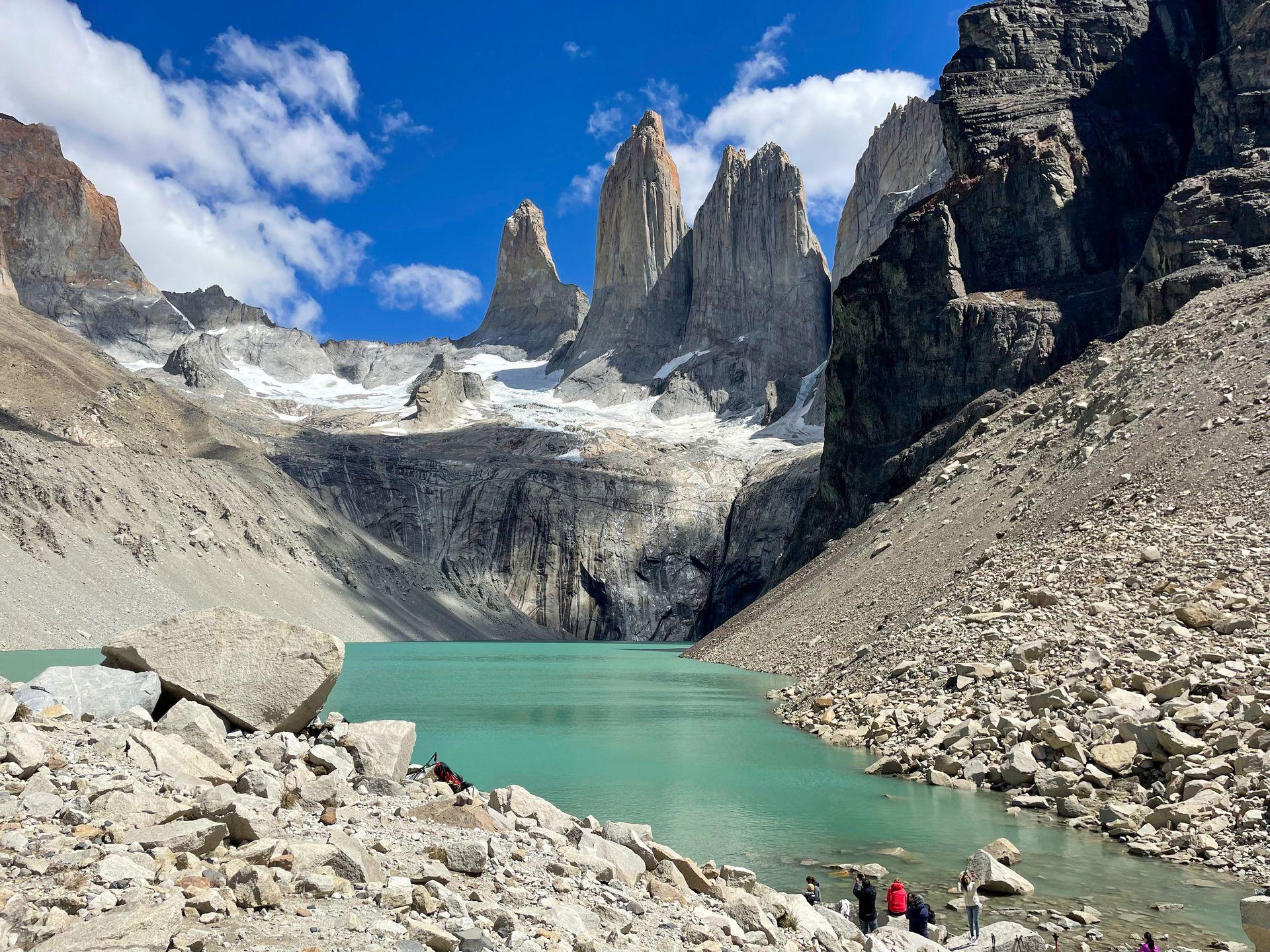
For a shorter version of this blog, check out my top 30 tips for hiking the W trek!
You will most likely hike the W Trek in the summertime for the Southern Hemisphere (winter in the Northern Hemisphere). The W Trek is typically open to hiking self-guided from October to the end of April, and you’ll likely have the best weather from November to March. I hiked the trek over New Years (December and January), which was really special!
If you would like to hike in the park during the winter months, you can do so with a guide.
There are several companies that offer guides if you’re not comfortable hiking the W Trek on your own. This can be a great option for some!
However, I think a guide is unnecessary, as the trail is well marked and easy to follow. It all depends on your comfort level, abilities and budget.
If you are looking for a guide, some companies that offer services include Swoop Patagonia, Tangol Tours, Chile Nativo and many more.
How to Self Book the W Trek
Many people assume you have to go through a third party company to book the W Trek. A third party would certainly be a little bit easier, but if you prefer to do it all yourself, I’m going to tell you exactly how!
Two separate companies own the various lodges in Torres Del Paine National Park: Vertice Travel and Las Torres Patagonia (previously called Fantastico Sur).
For this itinerary, you will book with Las Torres Patagonia for the first two nights at Los Cuernos and El Chileno, and Vertice Travel for the second two nights at Paine Grande and Refugio Grey.
You can book directly with each company on their websites.
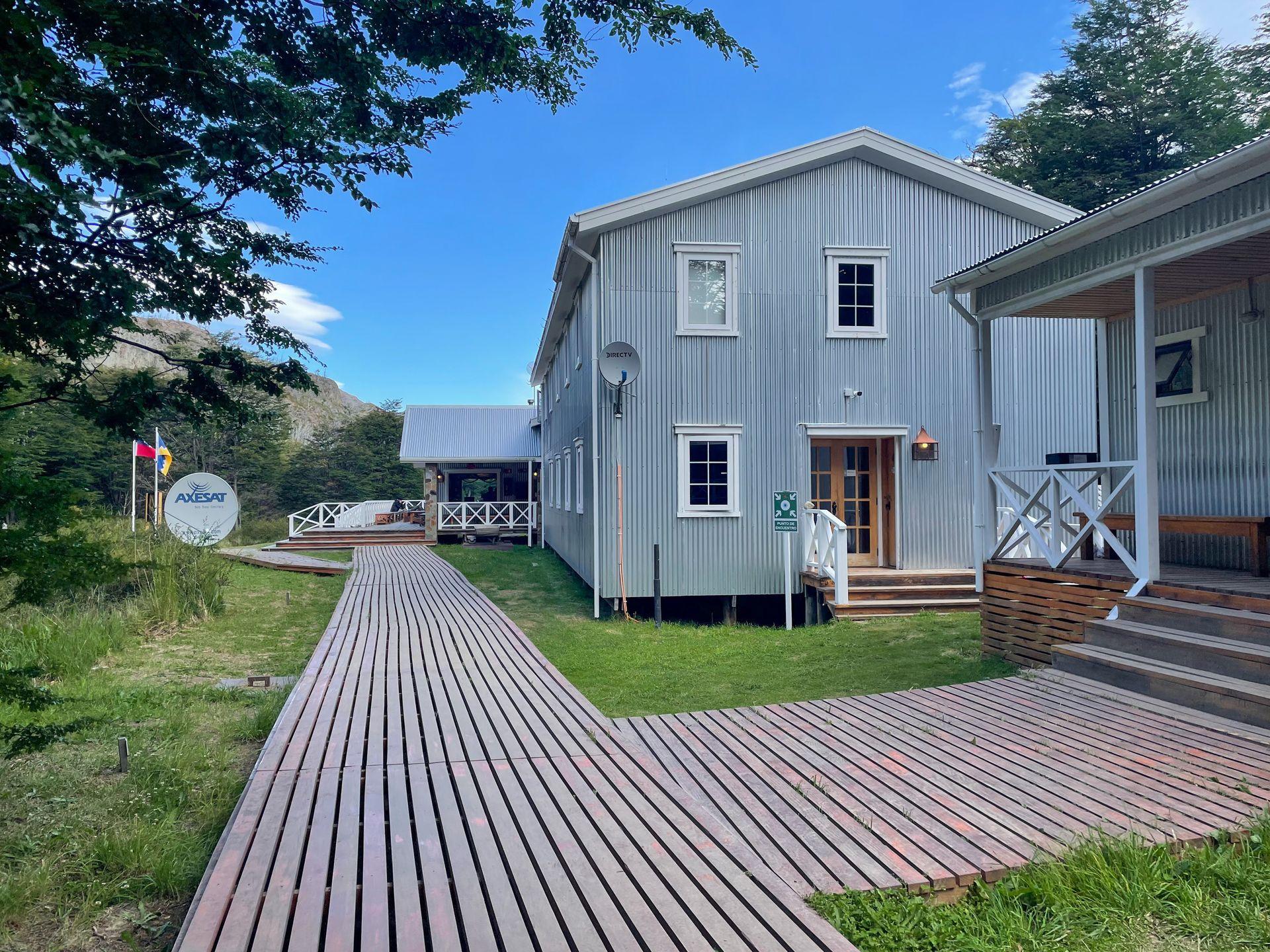
To book El Chileno and Los Cuernos, start on the Las Torres website . Choose to book the ‘shelters’ and then make reservations at the Central Refuge and the Chilean Refuge. Upon booking, you can select to add on full room and board (breakfast, packed lunch and dinner) or any combination of only dinners, only breakfast, etc.
To book Paine Grande and Refuio Gray, start on the Vertice Travel website. Under accommodations, make reservations at ‘Refuge & Camping Paine Grande’ and ‘Shelter & Camping Gray.’ When you book, you will select that you’re doing the W Circuit and be able to book both lodges at once, along with the full room and board.
If you have any dietary restrictions, be sure to request that when booking. If you don’t see the option, send an email to their customer service to confirm. I am a vegetarian and all of the inns were very accommodating!
I booked my trip for December/January in May and June. In 2022, the reservations for Las Torres went on sale well before the reservations for Vertice Travel. So, I booked half of the trek and then waited until the Vertice released their openings. Keep an eye on their social media platforms and/or send an email to their customer service to stay up to date.
After your lodging and transportation is squared away, it is very important to book an entry ticket into the national park. I did this a week or two ahead of time.
To buy your ticket, go to aspticket.cl and select ‘buy or reserve.’ You will then select the correct park, which is listed as ‘Parque Nacional Torres del Paine (Venta)’ in Spanish. From there, you will input your entry and exit dates in and out of the park.
You will then need to fill out a variety of information, such as your birthdate and passport number, where you are staying each night of the trek, if you are traveling with a guide and more.
When you complete the form, you will pay the fee ($49 USD per person at this writing) and receive an email with a QR code. Make sure you have this QR code saved offline (and/or printed) for when you arrive at the park! The rangers will scan it upon arrival and there is not reliable cell reception.
The cheapest and easiest way to get between Puerto Natales and Torres Del Paine National Park is by bus! There are a few different bus companies that run multiple daily trips between the city and the park.
I booked my tickets a week or two in advance with Bus-Sur, and I used busbud.com for easy booking. For the beginning of the trek, I recommend leaving Puerto Natales as early as you can (mine left at 6:45AM).
Keep in mind that you will be starting and ending at different places inside the national park.
For the beginning of the W Trek, book a ticket from Puerto Natales (Rodoviario) to Terminal Laguna Amarga . For the ending of the W Trek, book a ticket from Pudeto (Catamaran Paine Grande) to Puerto Natales (Rodoviario). I recommend an afternoon or evening time for the end of the trek, my bus left Pudeto at 2PM.
The bus rides will take about two hours and there are some great views along the way. Be sure to print out your bus tickets ahead of time and arrive a little early.
If you’re booking everything yourself, here is a quick checklist to make sure you have everything you need before setting out!
- Los Cuernos
- Paine Grande
- Refugio Grey
- National Park Entrance Ticket
- A morning ride from Puerto Natales to Laguna Amarga to start the trek
- An afternoon or evening ride from Pudeto to Puerto Natales to end the trek
- (Optional) A glacier trek or glacier kayaking from Refugio Grey (book with Bigfoot Patagonia)
- (Optional) The catamaran ride on Grey Lake
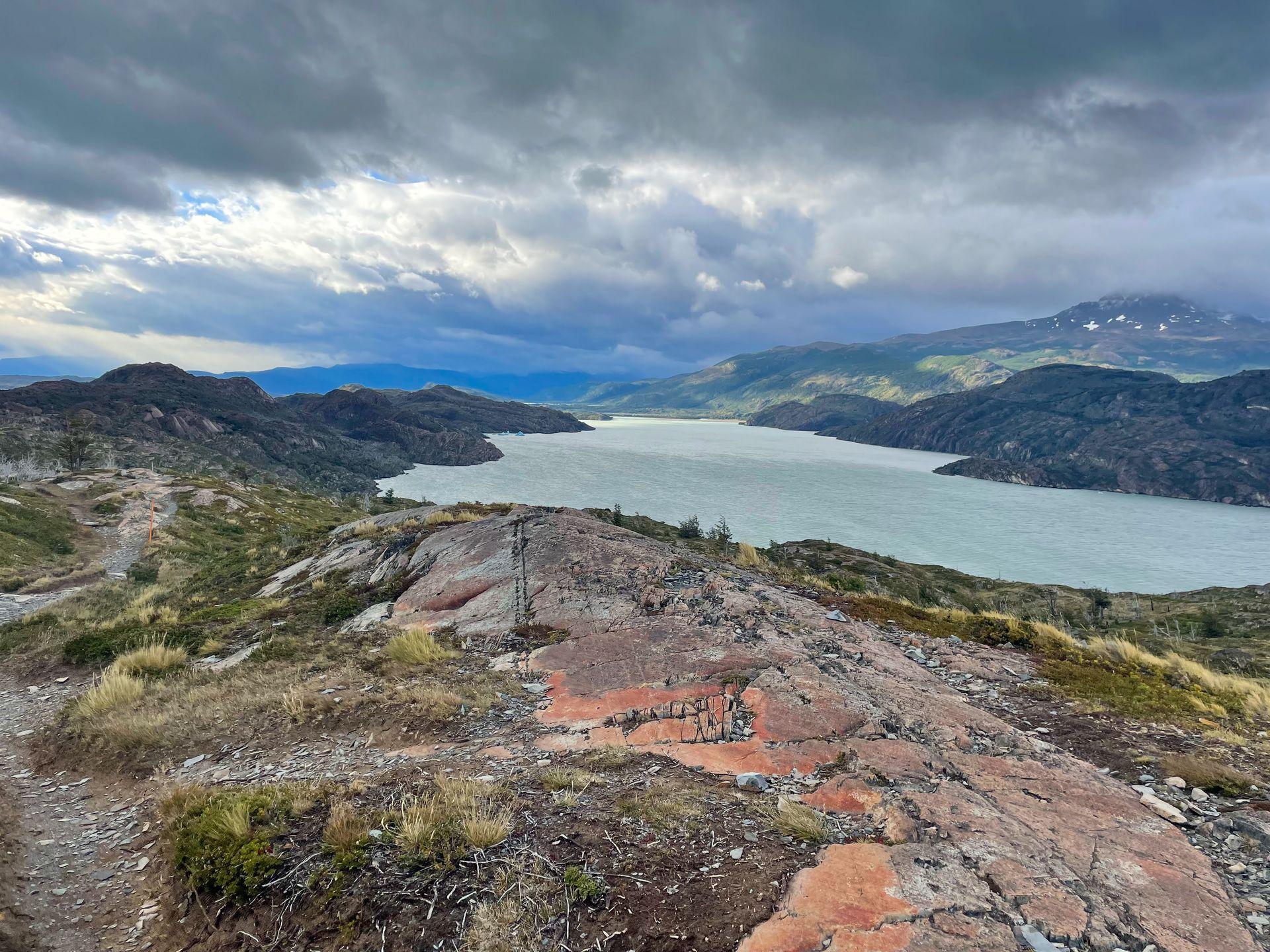
- Expect all kinds of weather, especially high winds. Wind is very common in the area and can be really intense. Also know that it’s possible fog will sock in some of the most epic views. Keep your expectations low just in case.
- You can drop off your heaviest gear at parts of the trail! Bring a day pack and drop your packs at El Chileno and Camp Italiano before ascending up the most difficult parts of the trail.
- The towers will be crowded but the rest of the trails won't be. But overall, the W trek is not the best for solitude and you will often see other people around. It’s a good social hike because you can meet people every night at the inns.
- The elevation of this region is relatively low (2,788 feet is the highest point on the W Trek), so you shouldn’t have an issue adjusting to the altitude.
- Each inn on the trek has drinking water, food and alcohol for sale, plus wifi for purchase and more. You will not exactly be roughing it on this journey! That being said, you should bring a water filter just in case you’re sensitive to the water or want to make sure you can fill up at streams on the way.
- Download the map of the trail on All Trails to follow along with your progress throughout the trail.
For a full list of tips for hiking the W Trek, check out my top 30 W Trek tips !
W Trek Itinerary: East to West
I hiked the W Trek from East to West. You can also hike it in the opposite direction, but hiking it east to west tends to be more common. I liked hiking it from east to west because I got the most difficult portions out of the way early. It was also fun to end the trek with a gorgeous catamaran ride across Lake Pehoe!
Below is my full itinerary for hiking the W Circuit! I hiked 50 miles over 4 nights and 5 days total.
- Take the bus from Puerto Natales, hike to the Base of the Towers, stay at El Chileno
- 9.9 miles, 3,000 feet of elevation gain
The best way to get to Torres Del Paine National Park is by taking a bus from Puerto Natales. The bus ride will take about 2 hours to reach the main entrance of the park (Laguna Amarga), which is where you’ll be exiting the bus for this itinerary.
When you arrive, you will need to exit the bus and have a ranger scan your entry ticket. You should have your ticket saved offline ahead of time and ready to show from your phone.
There was a bit of a language barrier for us here, as none of the instructions were given in English. How it worked was that everyone got off to get their ticket scanned here, whether you were getting off here or not. After they scanned our tickets, we went back to the bus to collect our backpacks.
From there, you will take a smaller shuttle bus to get to the start of the W Trek. This bus costs an extra fee of 4000 Chilean pesos per person in cash. It was a quick, 10 minute bus ride to reach the Torres Del Paine Welcome Center, where you will officially begin your trek! The welcome center has packed lunches, hiking poles and other items if you have forgotten something.
I calculated the day one milage to be 9.9 miles with just over 3000 feet of elevation gain. In terms of steepness, it was definitely the hardest day of the trek for me.
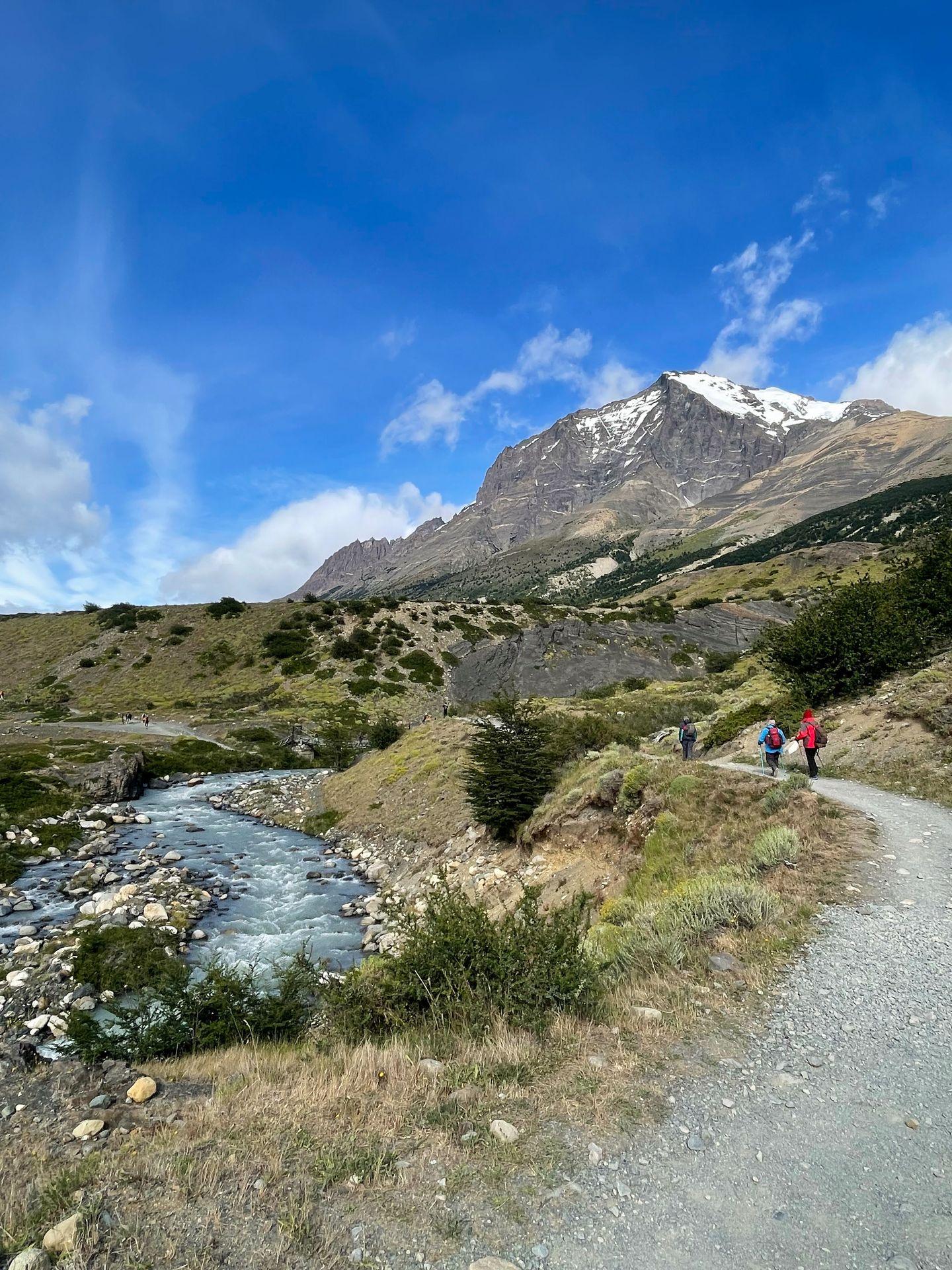
As you begin the trail, you’ll start with a short and flat walk back to Hotel Las Torres Patagonia. This is where most people stay to do a day hike up the Towers, and some people stay here for the first night of the W trek. It’s an option, but I definitely recommend staying in El Chileno instead if possible!
The trail is flat at first but you will quickly begin to gain elevation. A little under 2 miles from Hotel Las Torres, you’ll come to the first fork in the trail. Stay to the right as you continue up into the Windy Pass.
This portion of the trail gets a bit steep and there is a chance you’ll experience high winds. Luckily, there are some amazing views whenever you stop to take a break. Two miles from the hotel, you’ll reach a high point and then need to descend to reach El Chileno. El Chileno is located right next to the river and the perfect place to stop for lunch.
You can use the cubbies inside of El Chileno to drop off your heaviest gear before continuing up to the Towers. Depending on the time of day, I don’t recommend spending too long on a break at El Chileno. At some point in the afternoon, the park rangers will stop letting anyone hike up to the Towers, so be sure to stay on schedule.
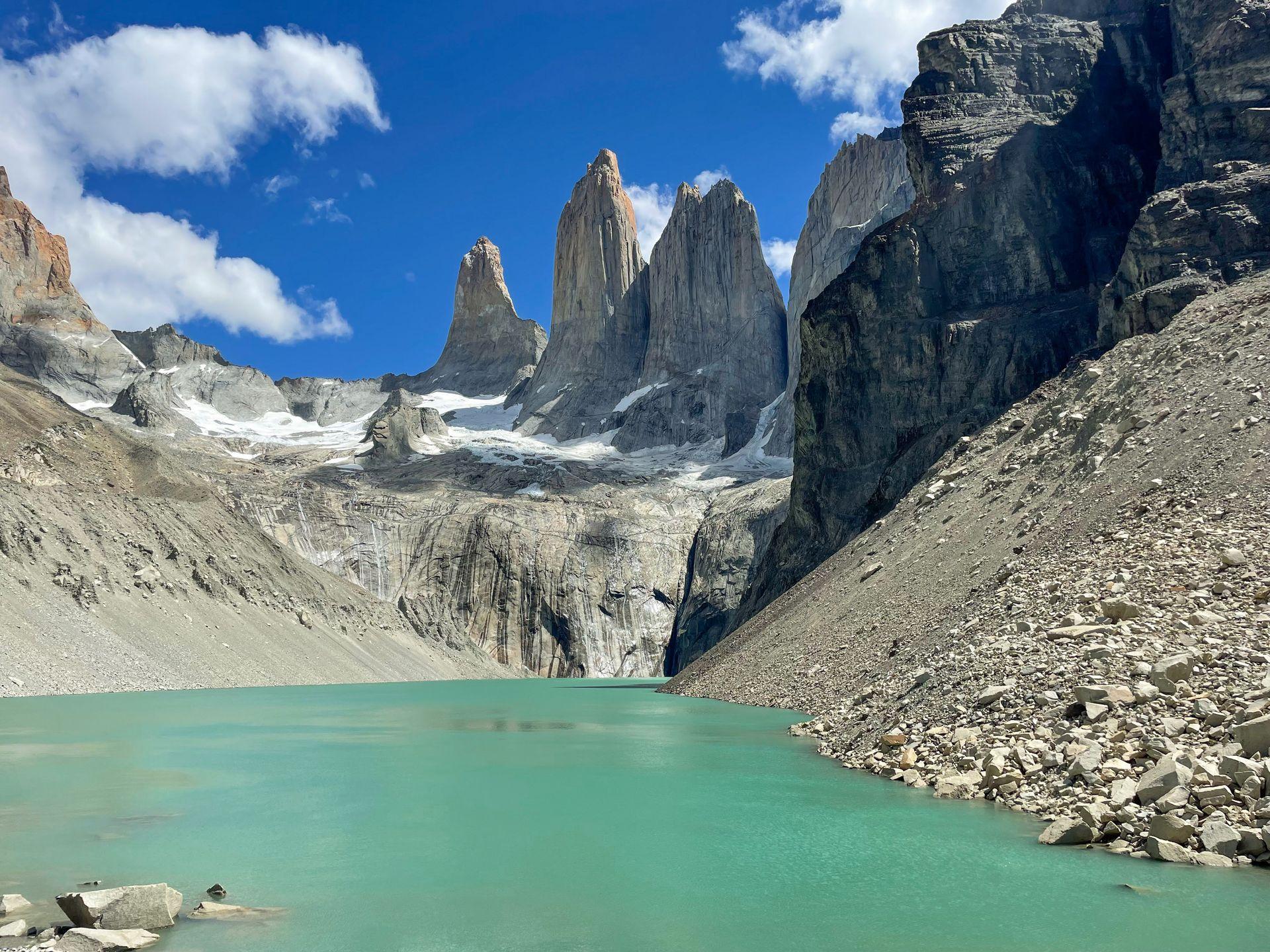
Since you will be staying at El Chileno tonight, go ahead and check in when you pass through. Your room will probably not be ready, but you can let them know you're there and be assigned a time for dinner.
The hike to the Towers gets quite steep for the last 0.7 miles. There is a bit of rock scrambling and a lot of dusty areas if conditions are dry. Be sure to watch your step and take your time. This is also a popular day hike so you’ll likely encounter crowds and need to spend a lot of time stepping aside for other hikers.
But the crowds and steep scrambling are worth it. At the top, you’ll be rewarded with an incredible view face to face with Lago Torres and the three Towers. The towers; Torres d'Agostini, Torres Central and Torres Monzino, are the most iconic sight in Torres Del Paine National Park, and certainly could be considered among the best views in the world. On a clear day, the towers stand tall as a backdrop to the bright turquoise lake below.
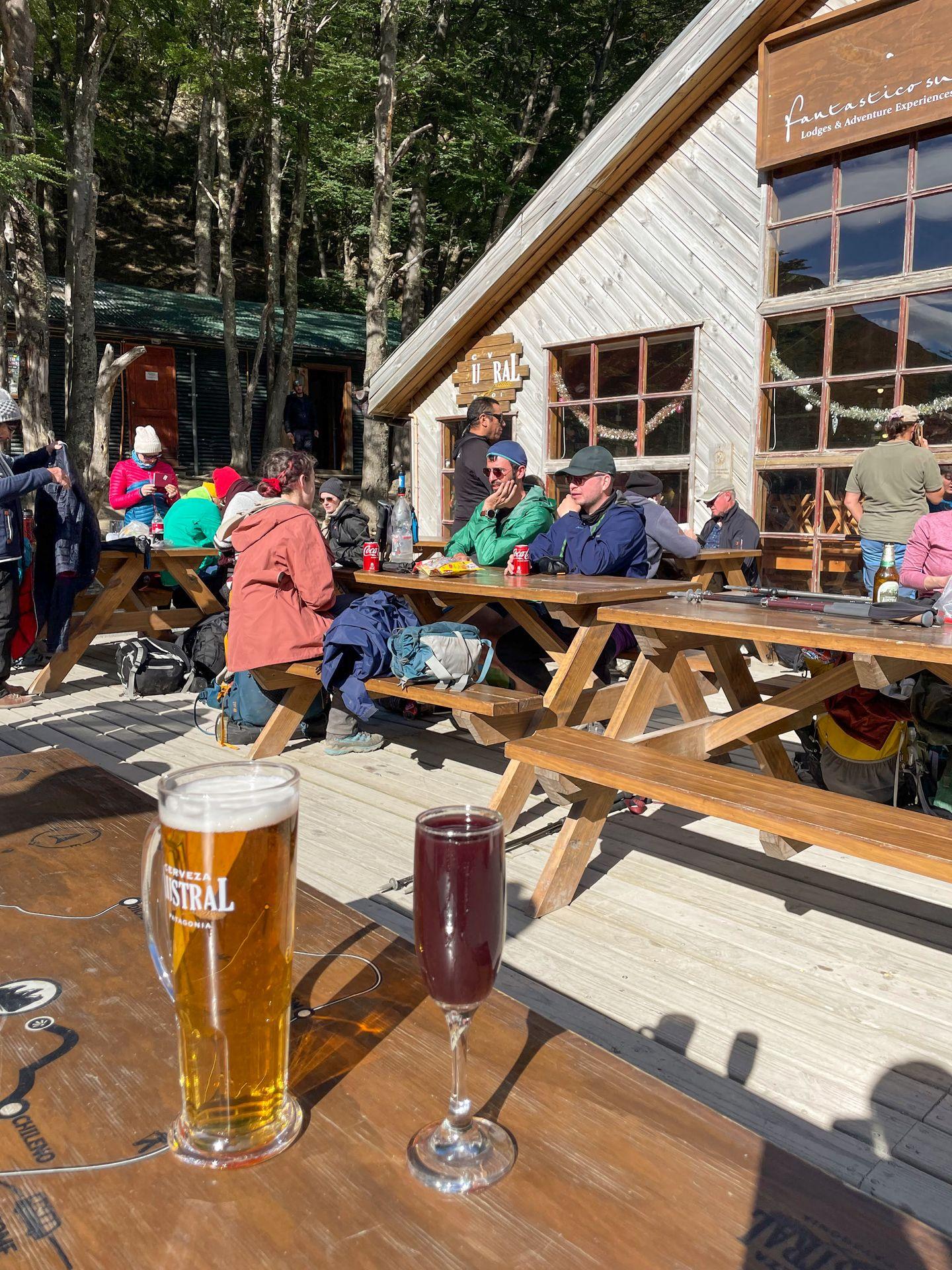
After enjoying the towers, make your way down to El Chileno for your first dinner of the trek. While El Chileno had my least favorite food of the W trek inns, I loved the atmosphere. Before or after dinner, you can hang out outside where there are picnic tables overlooking the river. Dinner at El Chileno is served at long tables and offers a great chance to get to know fellow hikers.
The rooms inside El Chileno were pretty basic. My room slept 6 people over 3 bunk beds (but there were only 4 of us for this night). There were shared bathrooms divided by gender down the hall. Overall, El Chileno is nothing fancy but I had no complaints.
- Hike from El Chileno to Los Cuernos
- 8.2 miles, 1,174 feet of elevation gain
On day two of the W trek, you’ll hike from El Chileno to Los Cuernos. In this itinerary, this day is tied for the easiest. The day will begin uphill as you hike out of the valley where El Chileno sits, but then it will be mostly downhill the rest of the day.
This trail includes many fantastic views of Nordenskjöld Lake. The lake is a brilliant aqua green color and there are some beautiful viewpoints.
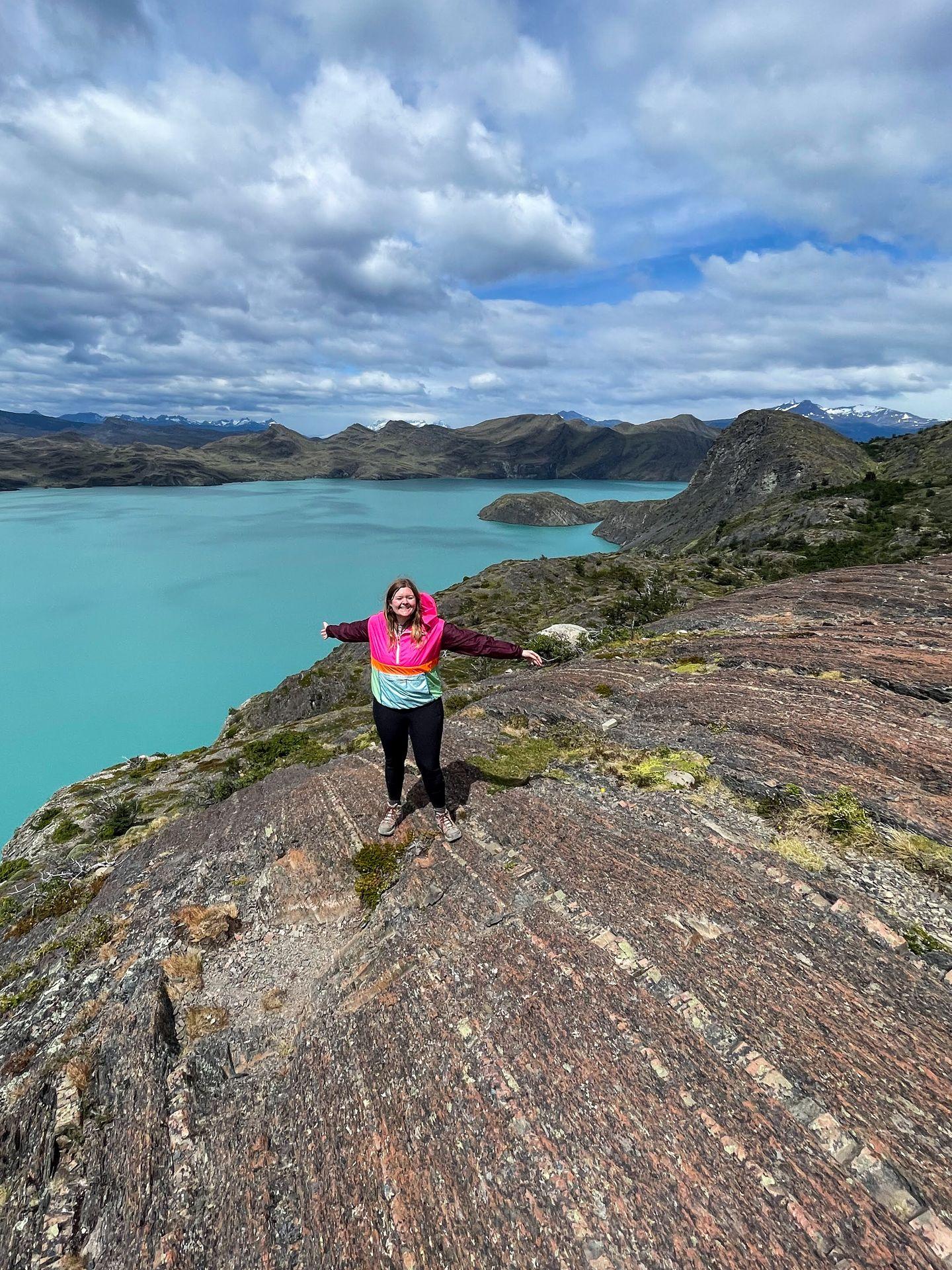
This is the day where I saw a large hoard of condor birds flying up above and sitting on nearby cliffs. Condor birds are the largest flying birds in the world and they’re fascinating to watch!
Los Cuernos is owned by the same company as El Chileno and has a similar vibe. I actually was here on New Year’s Eve, so we were served a special meal. They also threw a NYE party for the staff (that we were invited to as well). I’m not sure what it’s like on other nights, but the atmosphere was lively and celebratory. This meant it was loud and hard to sleep, so you may want to bring along ear plugs.
Los Cuernos also offers private cabins that sleep 2 people, so try to book one of these if you prefer things a bit quieter.
- Hike from Los Cuernos to Paine Grande and into the French Valley on the way
- 16.4 miles, 3,102 feet of elevation gain
Day three is the longest day of the W Trek. You will hike up into the French Valley, the center of the ‘W,’ to reach Mirador Britannica. Then you will continue onto the third inn of the trip, Paine Grande.
If you do the entire trail, it will be about 16.4 miles and 3,102 feet of elevation gain. I turned back early due to high winds and fog on this day, so I only went about 13 miles.
The trail starts out relatively flat and easy until you reach Camp Italiano. If you have a very windy day like I did, watch out for the beach areas. The beaches are very exposed and the wind almost knocked us over at one point.
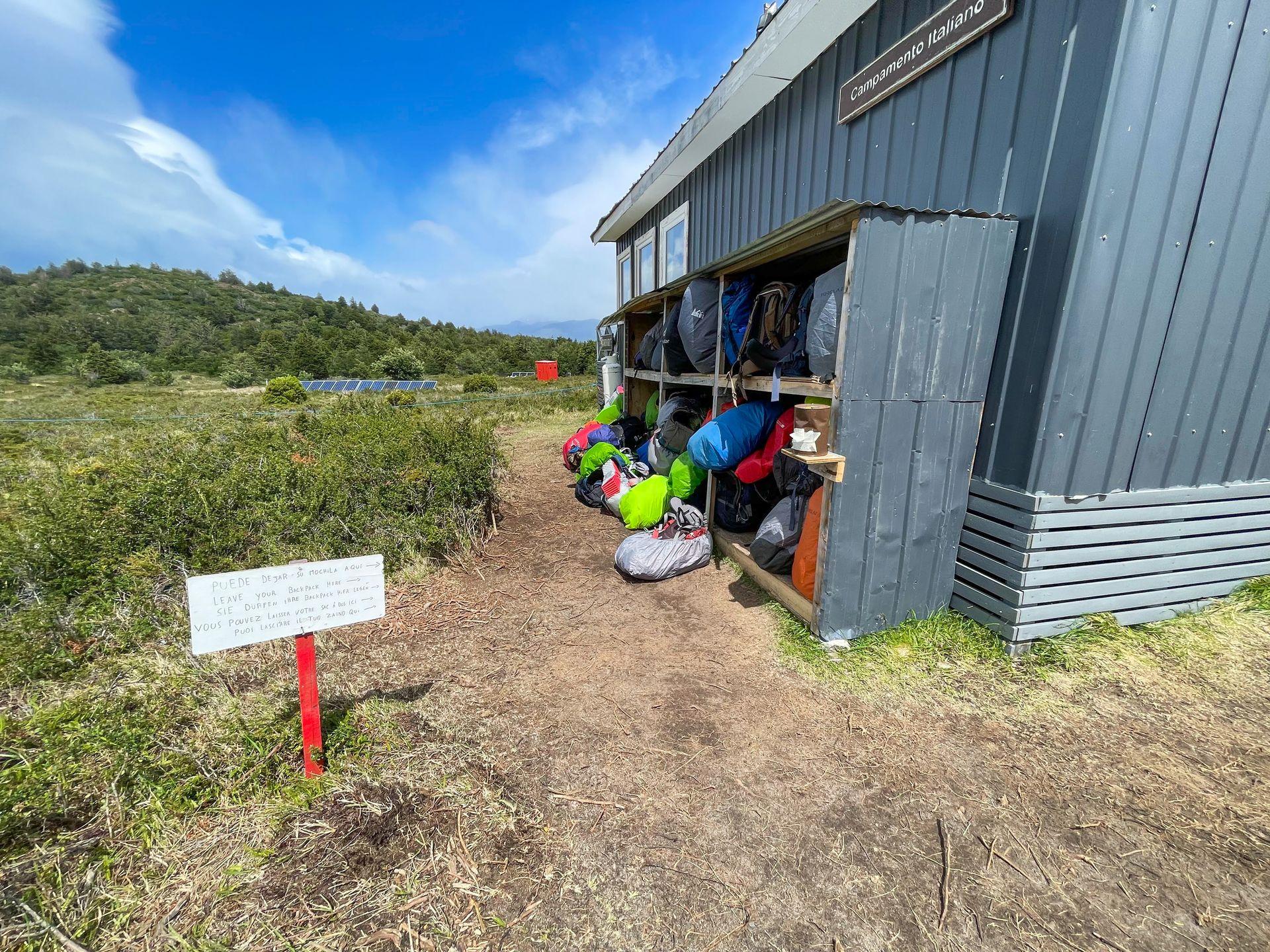
When you reach Camp Italiano, there are some outdoor shelves where you can drop off your heaviest gear. There was also a whiteboard here that had information on what time the viewpoints would close for the day and a warning about the high winds.
The hike up into the French Valley is steep at times, but felt more gradual than the hike to the Towers. You will go in and out of forest areas and viewpoints. Even if you just go part of the way, there are some fantastic views where you can admire the surrounding mountains and look for waterfalls, avalanches and glaciers in the distance.
There are four main viewpoints along the way. When I reached the second one, Mirador Valle de Frances, the wind was extremely strong, so many people turned around here. We went a little bit further, but decided to turn around before making it to the third.
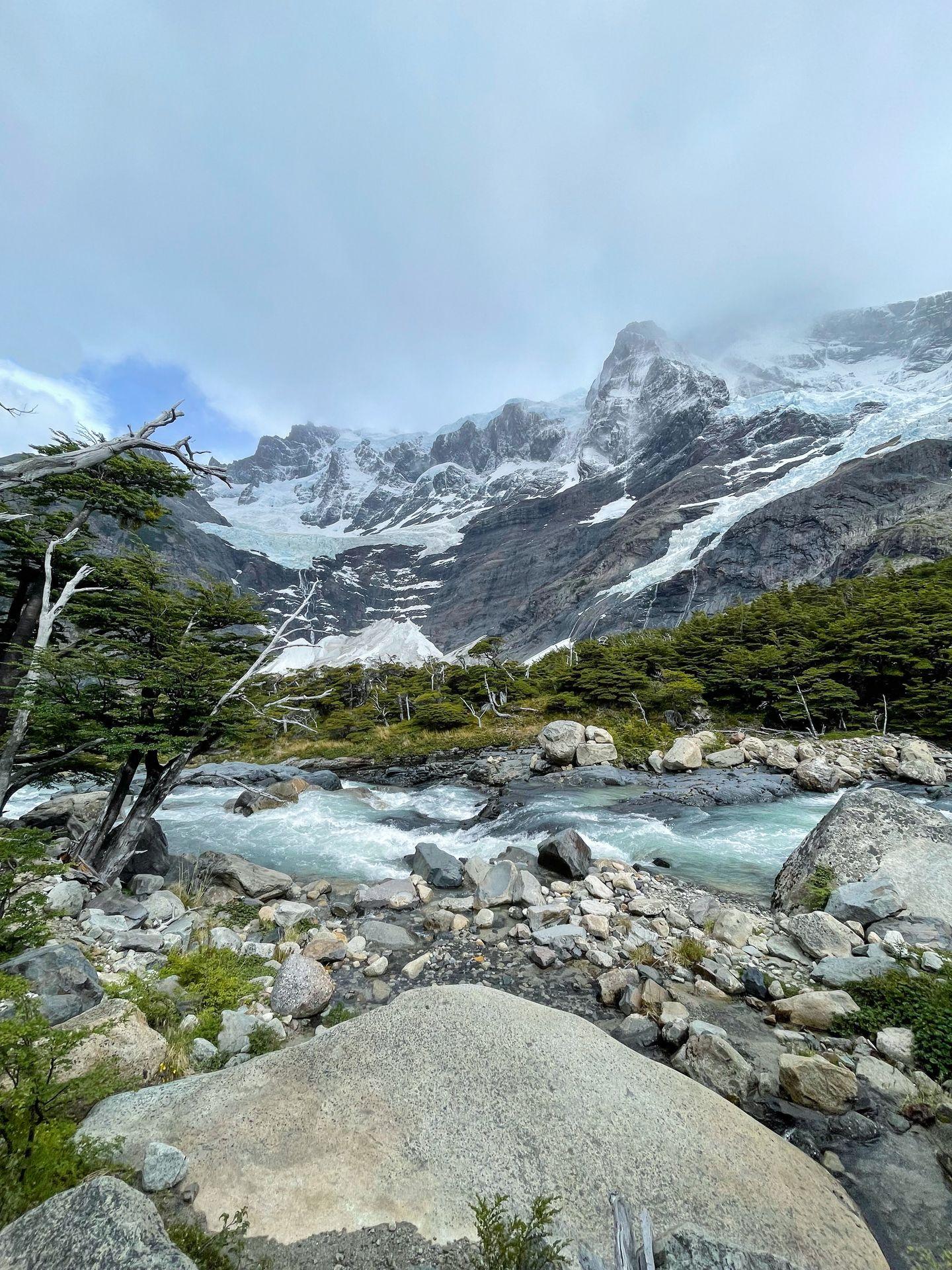
After returning to Camp Italiano to pick up your gear, it will be about 5 more miles to reach your inn for the night. It’s mostly downhill and relatively easy. However, the wind was very intense for me and made the miles feel quite long.
There was one suspension bridge crossing that felt particularly daunting, as the wind was shaking the bridge all over the place while we crossed over a river canyon.
You will also pass an area of wildfire damage. Unfortunately, there have been multiple cases of fires started from the mistake of tourists in the park, so please make sure to follow the rules. Open fires are strictly prohibited and camp stoves are only allowed to be used in designated areas.
After this long day, it’s a great feeling to reach Paine Grande. This inn feels nicer than the first two inns, as it’s newer and larger. However, what you gain in newness means that there is less of the great community feeling you get from the smaller inns.
The rooms here are equipped with two bunk beds and more comfortable bedding than Los Cuernos and El Chileno. They also have real lockers if you want to lock up any valuables. Dinner is served buffet style and there is a bar upstairs as well.
- Hike from Paine Grande to Refugio Grey. Optionally, hike up to the suspension bridges and a view of Grey Glacier.
- 6.9 miles, 1,319 feet of elevation gain
- Second hike is 5 miles with 1,014 feet of elevation gain
On day four, you’ll hike to the final inn of the trip, Refugio Grey. You also have the option to hike an additional few miles to see some suspension bridges and close up views of the Grey Glacier, which I highly recommend doing.
The first trail between the two inns is 6.9 miles with 1,319 feet of elevation gain. While it isn’t difficult, this was the windiest area of my trek. The wind made it difficult to move forward at times and definitely slowed us down.
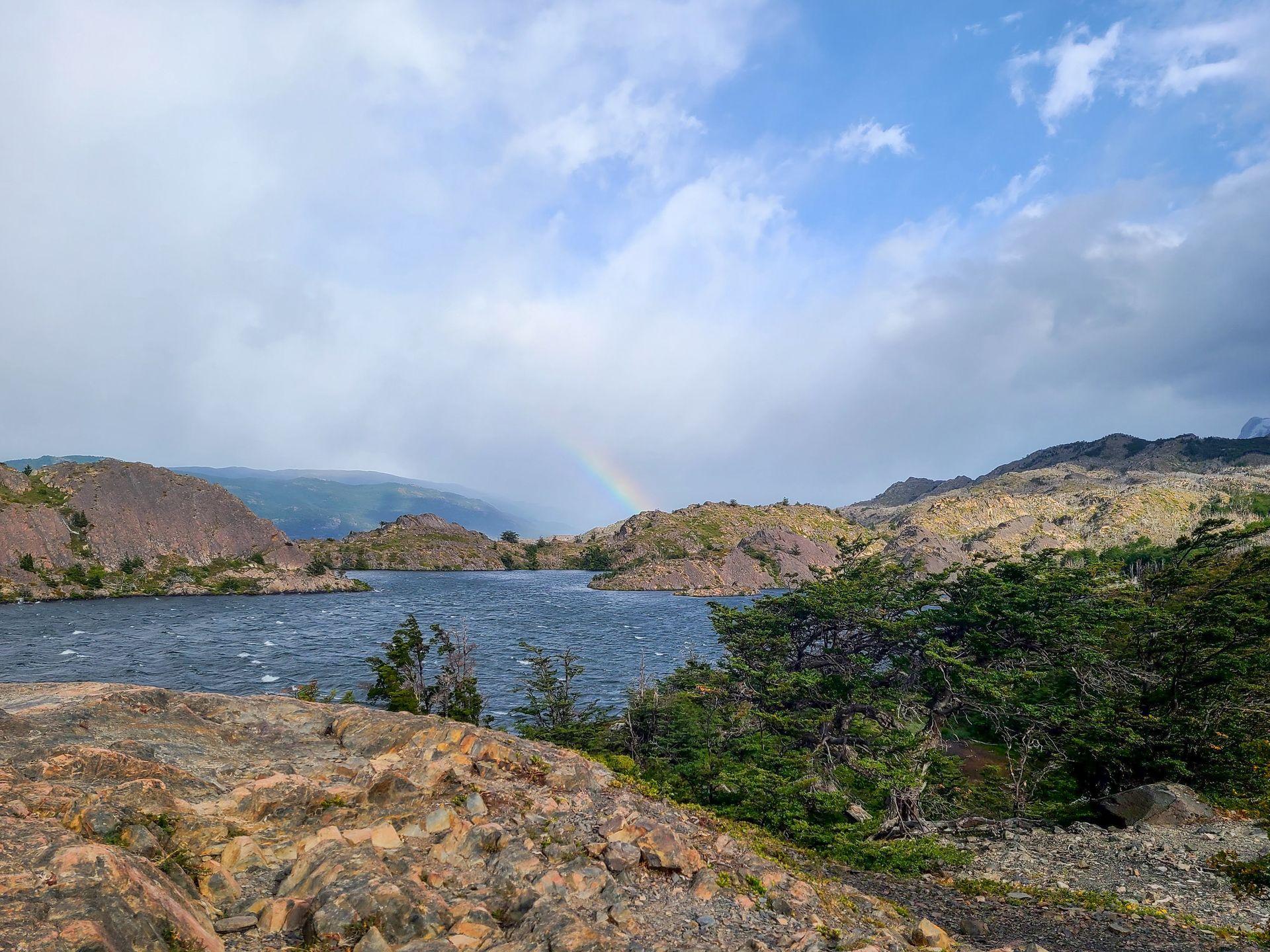
However, the trail has some fantastic views of Grey Lake and about halfway through you’ll start to see the Grey Glacier in the distance. The trail has multiple ups and downs, so you’ll have a nice variety.
At one point about 2 miles from the inn, there is a short portion of the trail where you’ll have to climb down a rock scramble that can be slick. It’s very doable if you have some hiking experience, but I found this to be one of the most technical portions of the entire W Trek.
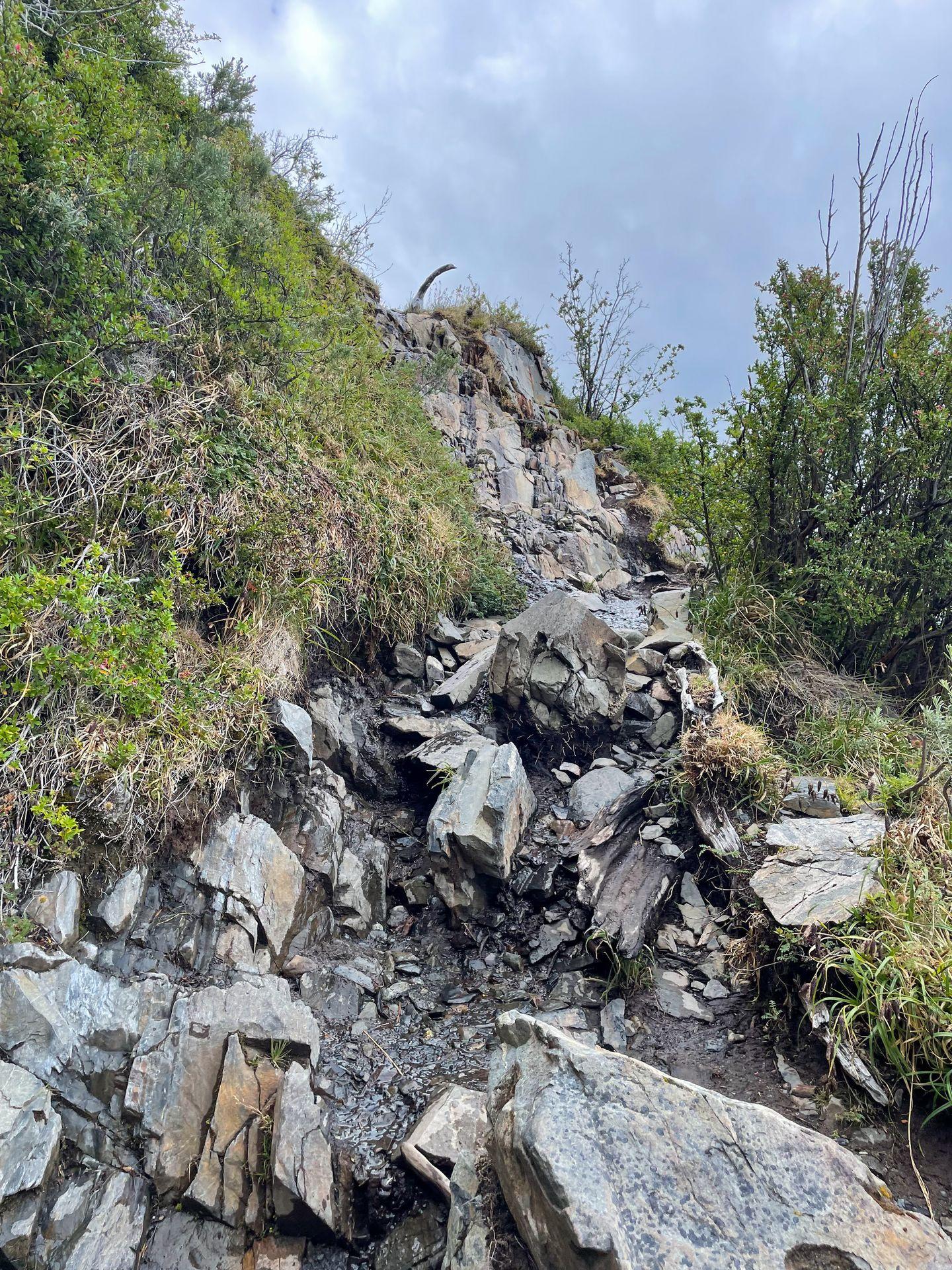
When you reach the Refugio Grey, there are a few excursions and additional trails you can choose from if you’re up to it. First, you have the option to kayak next to the glacier or go on a guided glacier trek. These activities cost extra and you should reserve them in advance if possible. We reserved the kayaking excursion, but unfortunately it was too windy for us to go out. It had been too windy to kayak for a couple weeks, so keep in mind that this cancellation is very common.
Additionally, you can take a hike up to see some incredible suspension bridges and a view of the Gray Glacier. This trail is about 5 miles with a little over 1,000 feet of elevation gain. It is part of the O Circuit, so you’ll likely see hikers on the O coming the other way.
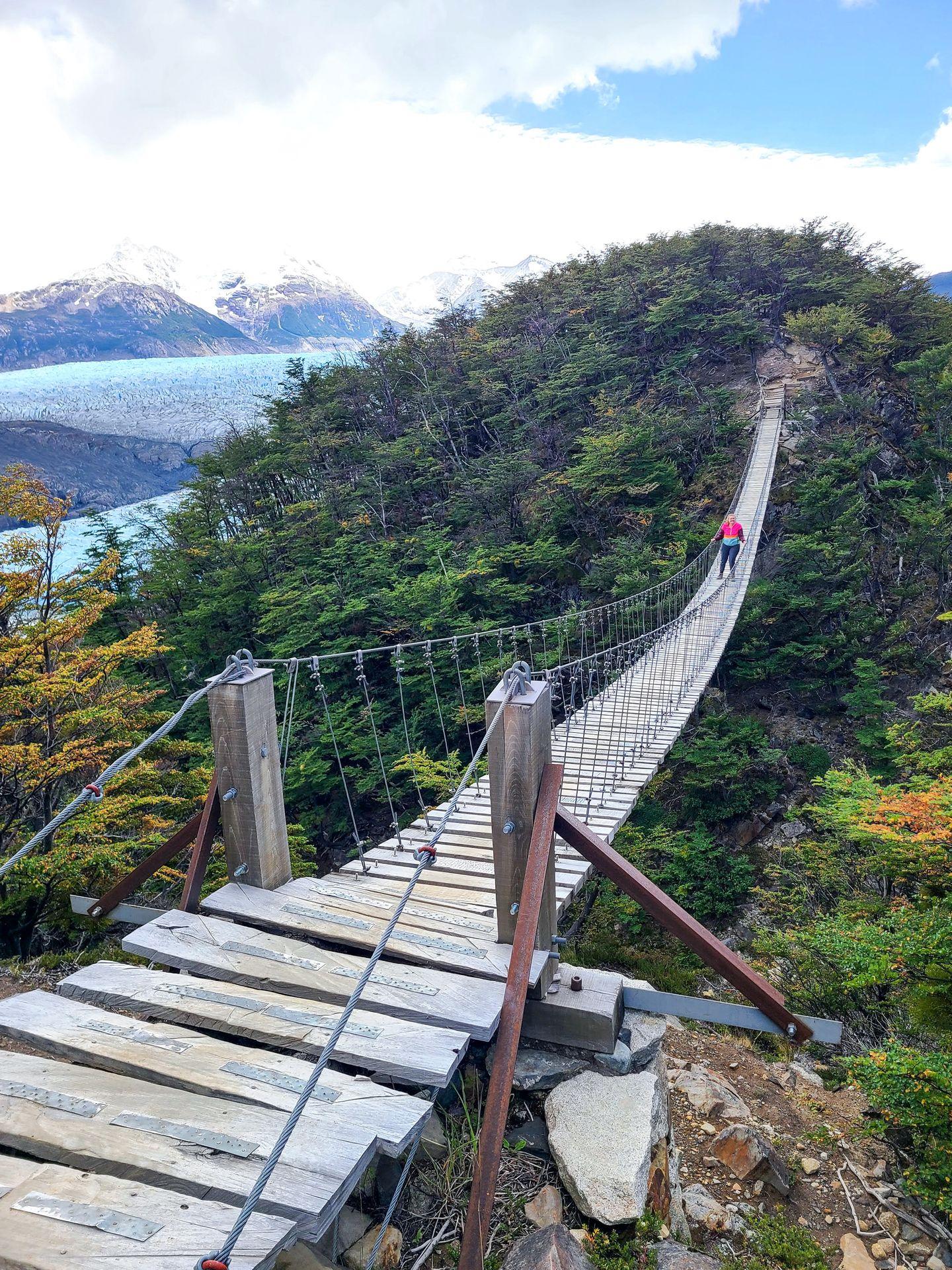
There are three suspension bridges you can hike to, but I only went to the first two.
The second bridge is especially magnificent. It is quite long and dangles 100’s of feet in the air over a large valley. On one side, you get a fantastic view of the glacier. On the opposite side, you can see a tall waterfall coming down from the mountains. I don’t recommend this if you’re afraid of heights, but it’s a really neat experience if heights don’t bother you.
If you aren’t up for the longer trail, there is also a viewpoint very close to the Grey Inn (a half mile) where you can get a nice view of the glacier.
After an additional hike, an excursion or some rest, enjoy your final dinner of the W Trek. I thought that Refugio Gray had some of the best food for dinner on the trip!
Day Five of the W Trek
- Hike from Refugio Grey to Paine Grande, take the catamaran across Pehoe Lake, take a bus back to Puerto Natales.
- 6.9 miles, 1,208 feet of elevation gain
On your final day on the W Circuit, hike back to Paine Grande to catch the Grande Catamaran. This is the same trail that you did on day four in the opposite direction, but you’ll have about 100 less feet of elevation gain. When you reach Paine Grande, line up to take the catamaran to Peduto.
There are actually catamarans from both Refugio Grey and Paine Grande, and they go different places. I was confused about this, so I’m going to explain the difference and the pros and cons of each.
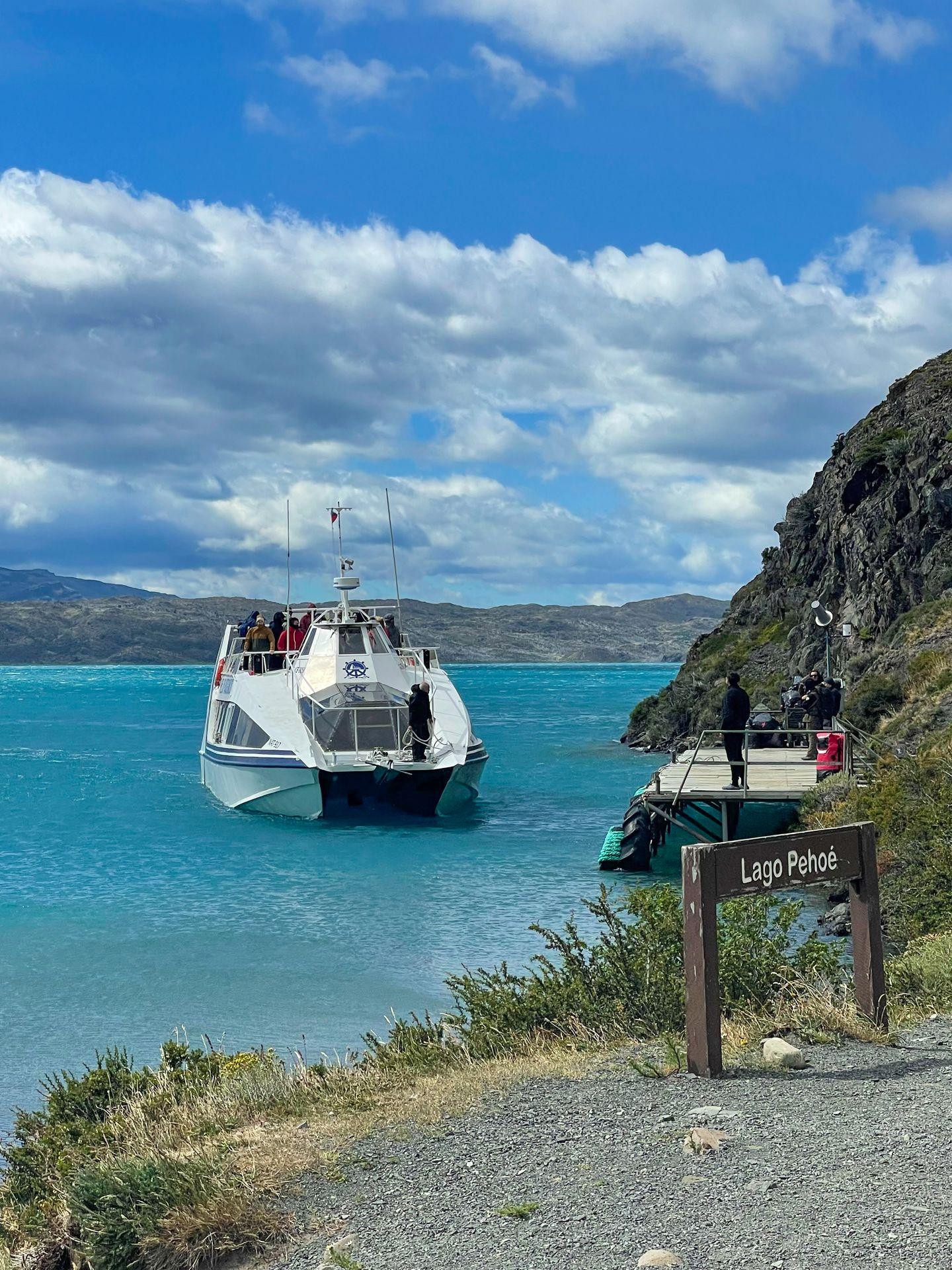
For the least amount of hiking, you can end your trek from Refugio Gray and take the catamaran across Lago Grey. This journey will take about an hour and costs $75 one way. It will take you to Hotel Lago Grey.
Pros of the Lago Grey Catamaran
- Less hiking! You get to leave from your final lodge via a beautiful boat ride.
Cons of the Lago Grey Catamaran
- It’s about 3 times the cost of the Lake Pehoe Catamaran.
- We were told that this boat is much more susceptible to delays and cancellations due to wind.
- It will bring you to the Lago Grey Hotel, which has fewer transportation options to get you back to Puerto Natales. You may need to stay at the hotel and arrange private transportation.
- This boat is not first come first serve like the Lake Pehoe Catamaran. You should make a reservation before your trek because it is likely to sell out.
For the reasons listed above, most hikers return from the trek via the Lake Pehoe Catamaran. The boat ride takes about 25 minutes and runs a few times a day. Check for the most up to date schedule at Paine Grande.
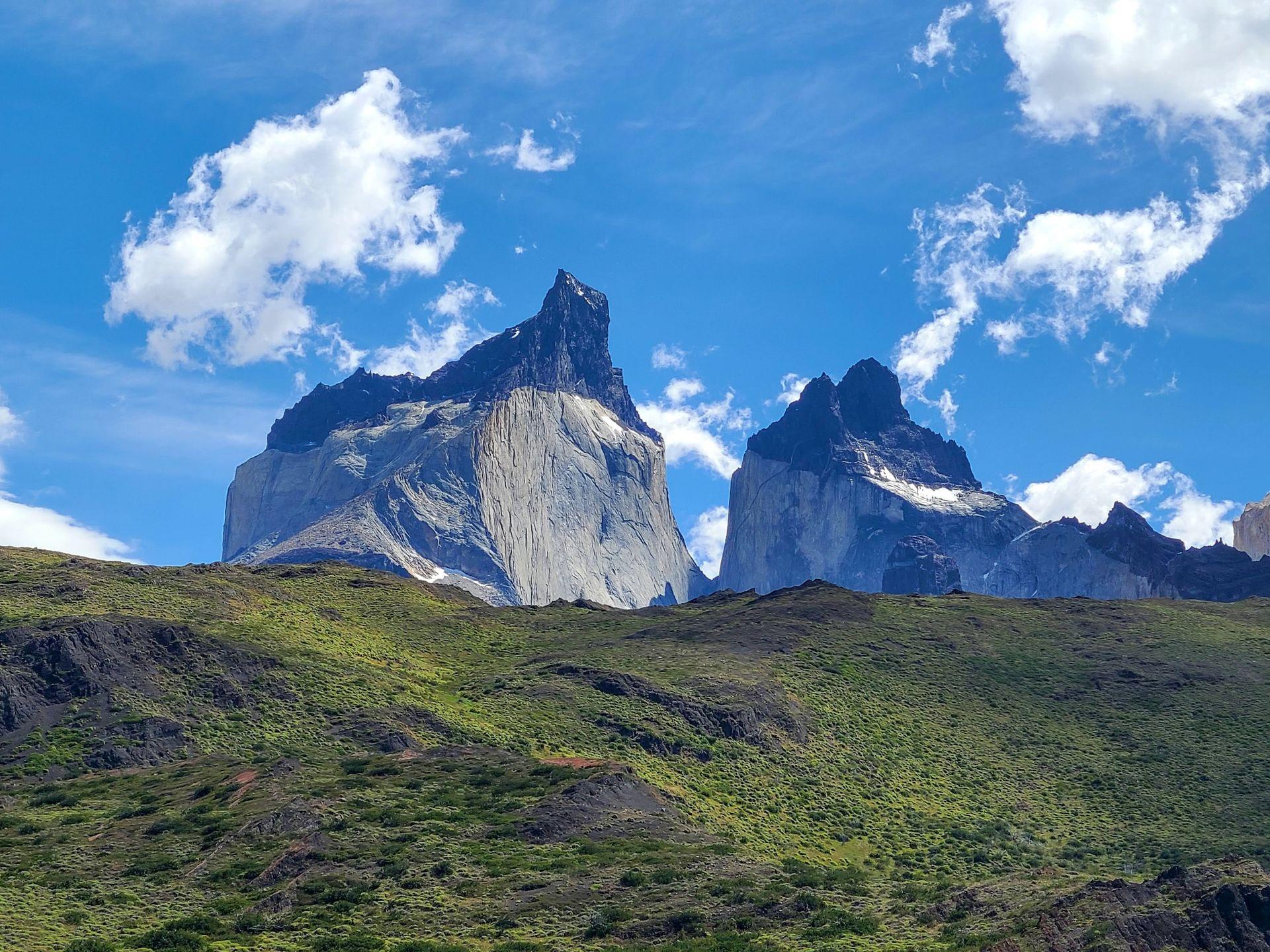
You cannot make a reservation for the Lake Pehoe boat. You’ll need to wait in line by the dock and board first come, first served. You also need to make sure you have cash - the boat requires $30 USD or $25 Chilean pesos per person, each way. During peak season, they take cash in US dollars or Euros as an alternative to Chilean Pesos.
The boat is quite large so you shouldn’t worry if there is a long line to board. Also note that even though there is a schedule, the boats do not always run on time.
The boat also has stunning views! If it’s a clear day, you’ll get a new perspective of the park and see incredible mountain peaks as you ride through turquoise colored water.
When you reach Pudeto, take a bus ride back to Puerto Natales to end your time in Torres Del Paine National park. There is a small cafe to wait in before your bus ride. You should make sure that you have reserved a bus ticket ahead of time.
I took the second ferry of the day back from Paine Grande (it was scheduled for 11 but ended up being closer to 12) and then waited about 2 hours in the cafe for my 2 PM bus ride. The cafe sold lunch items, coffee, beer and more. There is also a one mile waterfall trail you can enjoy if you have the energy!
When you reach Puerto Natales, celebrate your hard work with a delicious meal, a pisco sour and a nice hotel stay. I loved eating at Cafe Artimana, Cafe Kaiken and La Guanaca Pizza.
How Much Does it Cost to Hike the W Trek?
In December/January 2022/2023, we paid $872 per person to hike the W Trek. This included 4 nights of lodging, full room and board, the bus tickets to and from the park, the ferry at the end and the entry ticket into the national park. We had to pay about $37 extra for a special New Year’s Eve Dinner, so you can subtract that if you’re not going over Christmas or New Years!
Here is the cost breakdown:
Night 1: El Chileno - $125 per person for the bed with sheets, $88 per person for the food
Night 2: Los Cuernos - $125 per person for the bed with sheets, $124 per person for the food (This was New Years Eve so the food cost extra - they did something special!)
Night 3: Paine Grande - $92 per person for the bed with sheets, $61 per person for the food
Night 4: Gray - $92 per person for the bed with sheets, $61 per person for the food
Ferry to return from Paine Grande and end the trek: $30 per person (cash only)
Bus Tickets on Bus Sur between Puerto Natales and the national park: $10 per person each way. There is also a shuttle between the entry to the park to the actual start of the trek that cost $5 per person (chilean pesos only)
Entry ticket into Torres Del Paine National Park: $49 per person
You also have the option to pay extra for wifi, alcohol or extra food at all of the inns. They all take credit cards.
Prices are subject to change, these were the prices for the 2022 - 2023 season.
This does not include flights into Puerto Natales to start and end your trip. This can vary a lot based on where you’re flying from! Note that it is very likely to need to connect through Santiago first.
There are definitely ways to cut out some of the costs!
- You can camp instead of staying inside the inns. The inns all offer options to rent out tents so you don’t have to carry your own. Or you will pay the least if you carry your own.
- You can bring your own food instead of paying for full room and board. I would recommend bringing your own breakfast and lunch items and only paying for dinner if this is something you’re considering. I did not love the breakfast service because on some days, I wanted to leave earlier than breakfast was being offered.
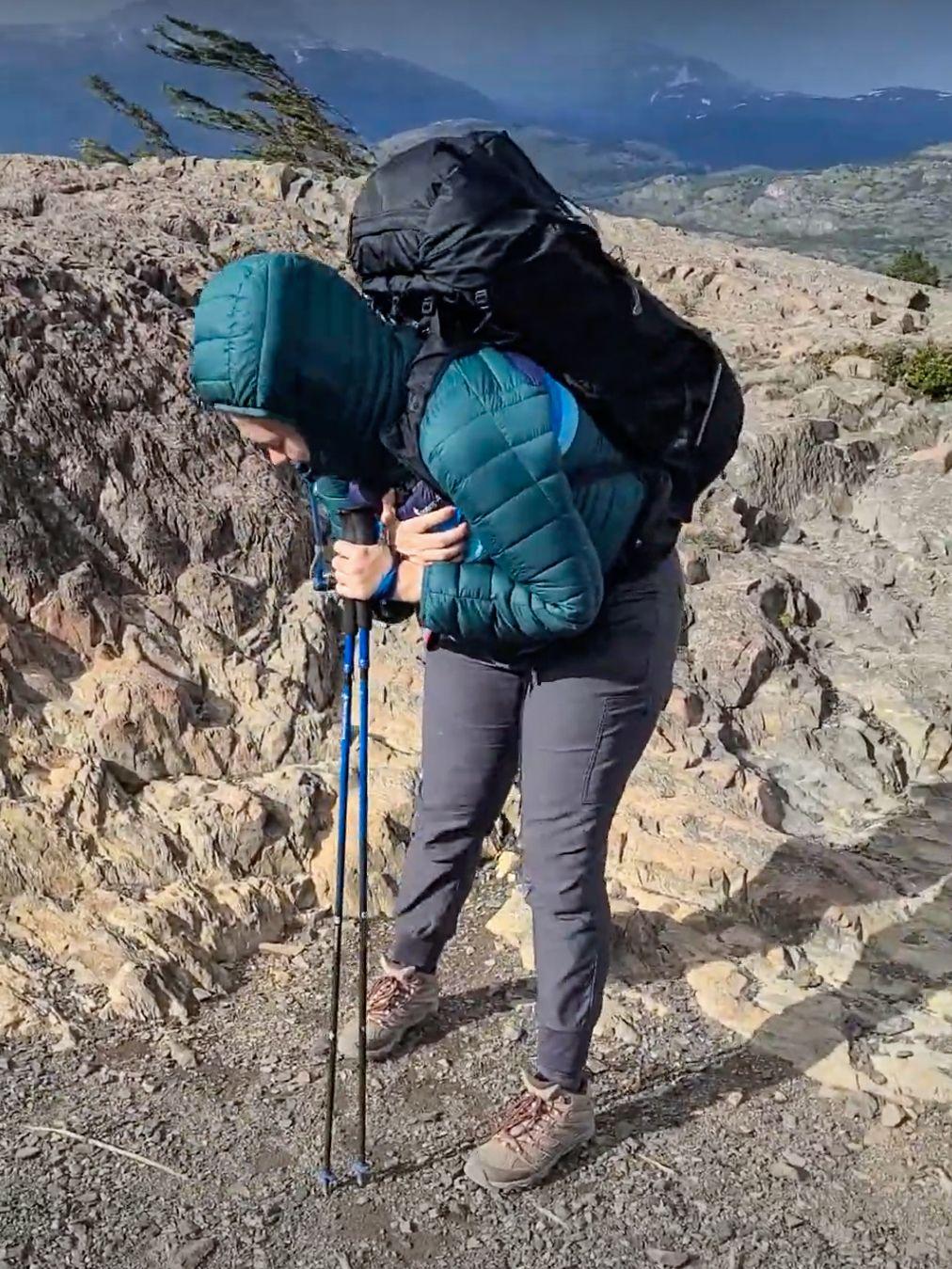
- A backpack that will fit your needs for carrying your things for 5 days and 4 nights. I carried a 40L backpack and thought it was the perfect size.
- A small day pack to carry the essentials for the times you can leave your bigger pack behind.
- A water bladder or water bottle.
- A water filter (We only filled up on water from the inns, which have drinkable water. But it’s good to have a water filter just in case. It depends on your comfort level and sensitivity.)
- Snacks! I did not need any extra food than what was provided from the full room and board, but it’s always good to have some options if there are items in the packed lunches that you don’t like.
- Hiking essentials including a first aid kit , knife, emergency shelter, headlamp and sun protection.
- Your passport, printed out tickets and confirmations, cash and credit card.
- Rain gear. Rain is common on the trek, make sure you have a good rain coat and a rain cover for your backpack.
- Layers. It might get cold, so I recommend bringing a warm hat and gloves.
- Sturdy hiking boots .
- Hiking socks and the clothing you’ll need for 5 days and 4 nights. Avoid cotton and bring items that are moisture wicking.
- Small towel for showering .
- Toiletries such as soap, moisturizer, toothbrush and whatever else you need.
- A second, lightweight pair of shoes to wear around the inns.
- A phone charger and portable battery.
- A buff to help protect against the dust on windy days.
- Insect repellent . I did not encounter mosquitoes, but I’ve heard during certain times of year they can be bad.
- A kula cloth to use instead of toilet paper.
- Trekking poles .
- Ear plugs if noise would bother you in the inns.
For a more detailed packing list for the W Trek, check out my W Trek packing guide !
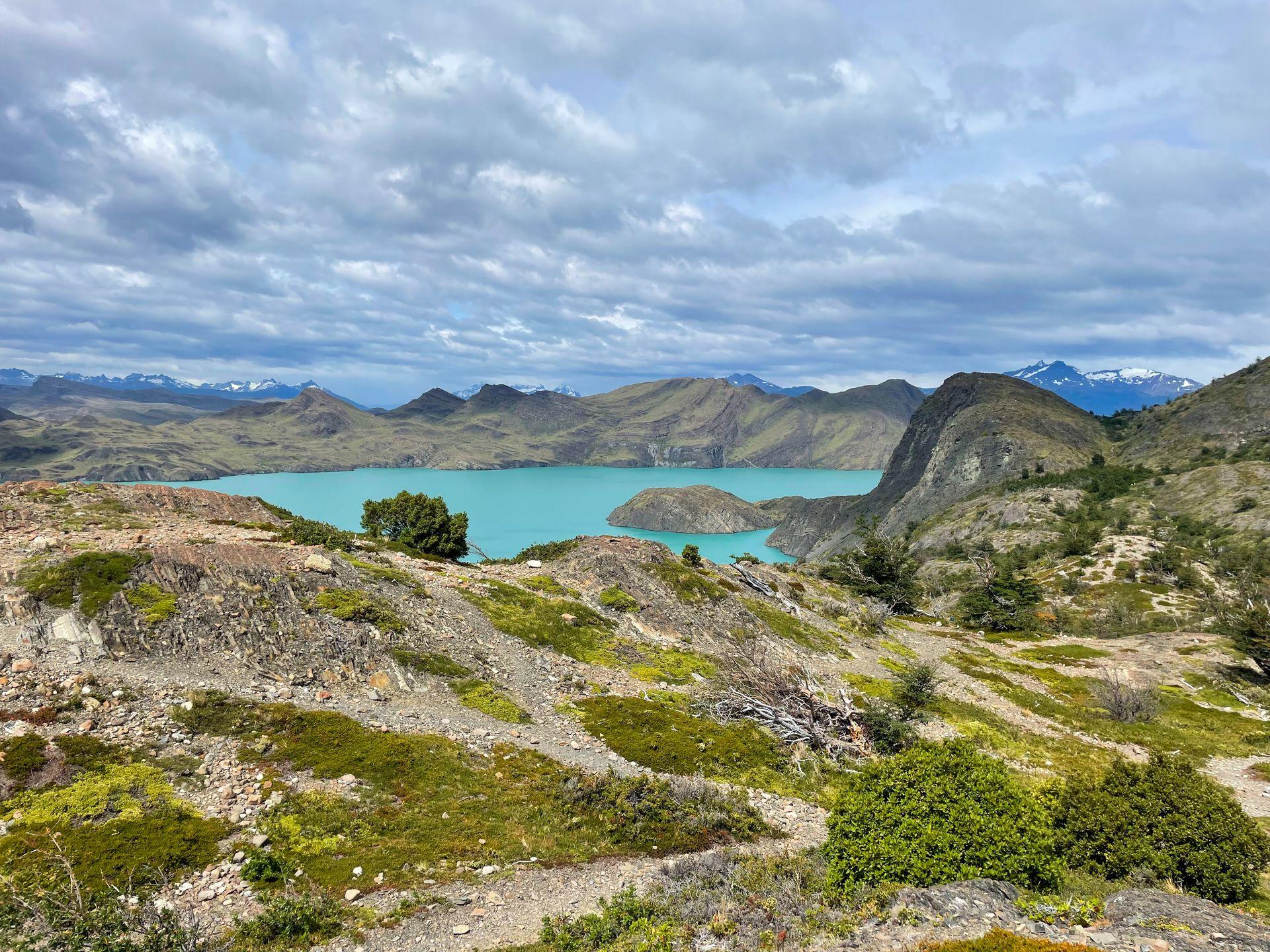
There are certainly many other things to do in Torres Del Paine National Park besides the W Trek!
If you’re up for a more challenging adventure, consider the O-Trek, which is approximately 68 miles and takes 6-10 days.
If hiking for 5 or more days isn’t your thing (or you have less time) but you want to see some of the park, consider some day hikes.
Day Hike Options Include:
- Mirador Las Torres, the most iconic view in the park, is often done as a day hike. Stay at the Hotel Las Torres and the trail will be about 12.5 miles.
- Take the catamaran from Hotel Grey and hike up to the suspension bridges for a view of Glacier Gray. The hike from Refugio Grey is about 5 miles.
- Hike to the Salto Grande from Pudeto, the trail is 0.9 miles.
- Hike to the Rio Pingo waterfall from Hotel Grey, the trail is 5.3 miles.
There are many more day hike options, these are just a few! You can also go horseback riding, fly fishing or biking or a variety of other activities.
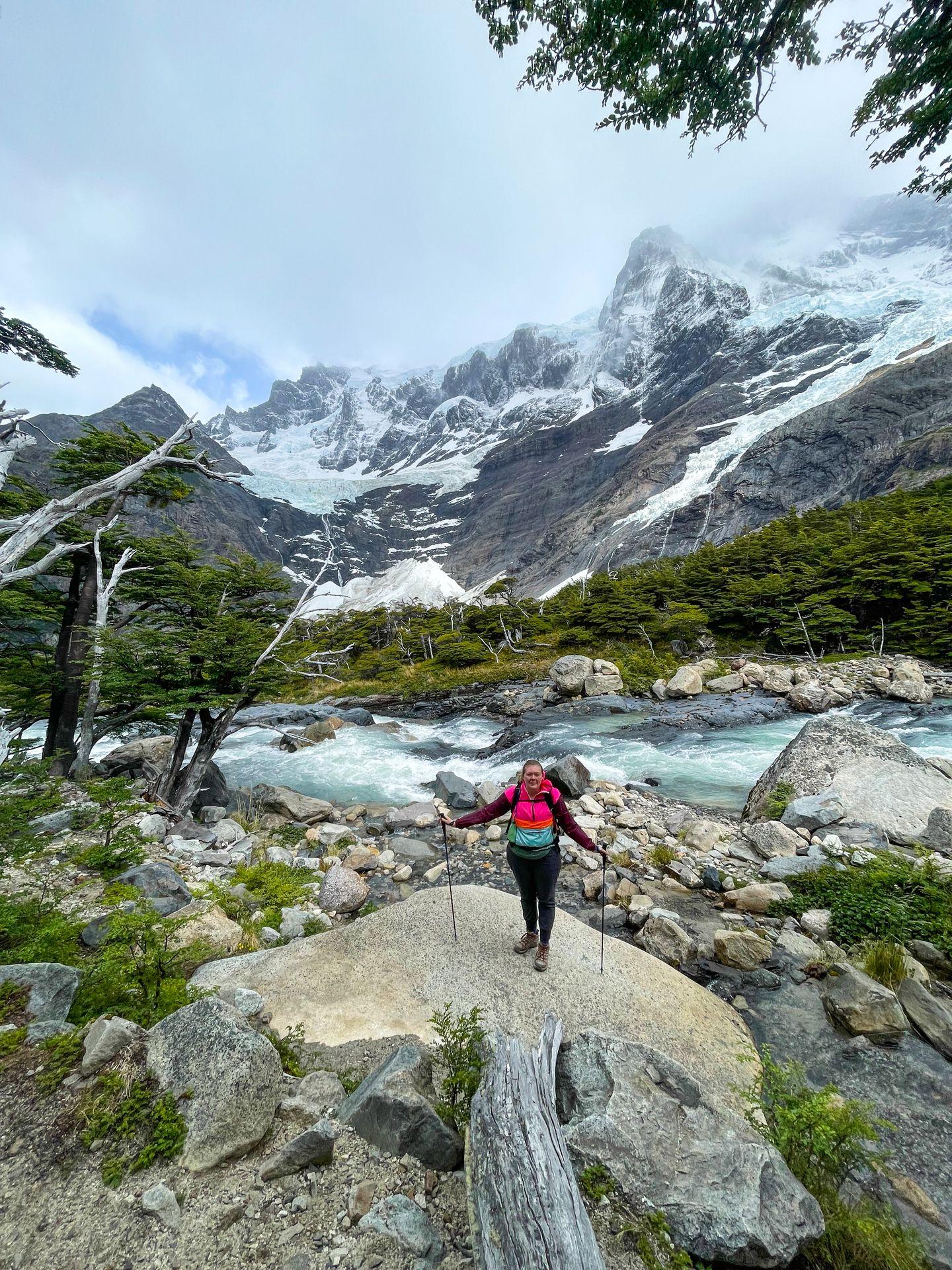
How difficult is the W Trek?
The trail itself is not difficult on the W Trek. It is well marked and there are just a couple areas of rock scrambling. However, the difficult part is hiking a long distance every day and carrying heavy packs. You should be used to hiking 10+ miles on a day hike and carrying a heavy bag.
Can you hike the W Trek solo?
While I did not hike the W Trek solo, I would be very comfortable doing so. I thought that the trail was well marked and felt very safe. With the shared dorms and communal dinners, it’s really easy to meet other hikers and make friends along the way.
Would you recommend the W Trek or doing day hikes?
My experience on the W Trek was one I will never forget and I think it is very much worth doing! If you have the time, I highly recommend doing the entire W trek instead of just day hikes.
Is the water safe to drink in Torres Del Paine National Park?
The water tends to be safe to drink from the water sources at the inns. Some hikers also drink water directly from streams, but I’ve heard mixed reviews and that is not something I would recommend. I recommend bringing a water filter just in case, but it all depends on your comfort level and sensitivity.
Are there mosquitoes on the W Trek?
I did not encounter mosquitoes on the W trek, but I’ve heard that others have during certain months when it is rainy and warm. Bring insect repellent just in case.
What is the hardest part of the W Trek?
I thought the hike to the Base of the Towers was the hardest part of the trek. It’s a long day with a steep climb.
What kind of wildlife will you see on the W Trek?
I saw very little wildlife on the trek, but I did see several condor birds! There are gauchos (llamas) in Torres Del Paine National Park, but it’s rare to see them on this trail. You will likely see them along the roads driving in and out of the parks instead.
Other animals that live in the park but are rare to see are pumas, huemul deer and foxes. There are no bears in Torres Del Paine, so there is no need to carry bear spray.
If you have dreamed about a trip to Patagonia, I hope this guide will help you make it a reality! The W trek and a visit to Torres Del Paine National Park a bucket list experience that you’ll remember for years to come.
If you’re flying all the way to Patagonia, I recommend more adventures than just the W Trek. After the trek, I drove into Argentina to continue my trip. Check out my 2 week Patagonia itinerary and my guide to renting a car in Patagonia to continue planning!
For more Patagonia guides, check out these blogs:
- The Ultimate 2 Week Itinerary for a Patagonia Road Trip
- A Guide to Renting a Car and Driving in Patagonia
- 30 Tips for Hiking the W Trek
- A Detailed Packing List for the W Trek
Thanks for Reading!
Save to Pinterest!
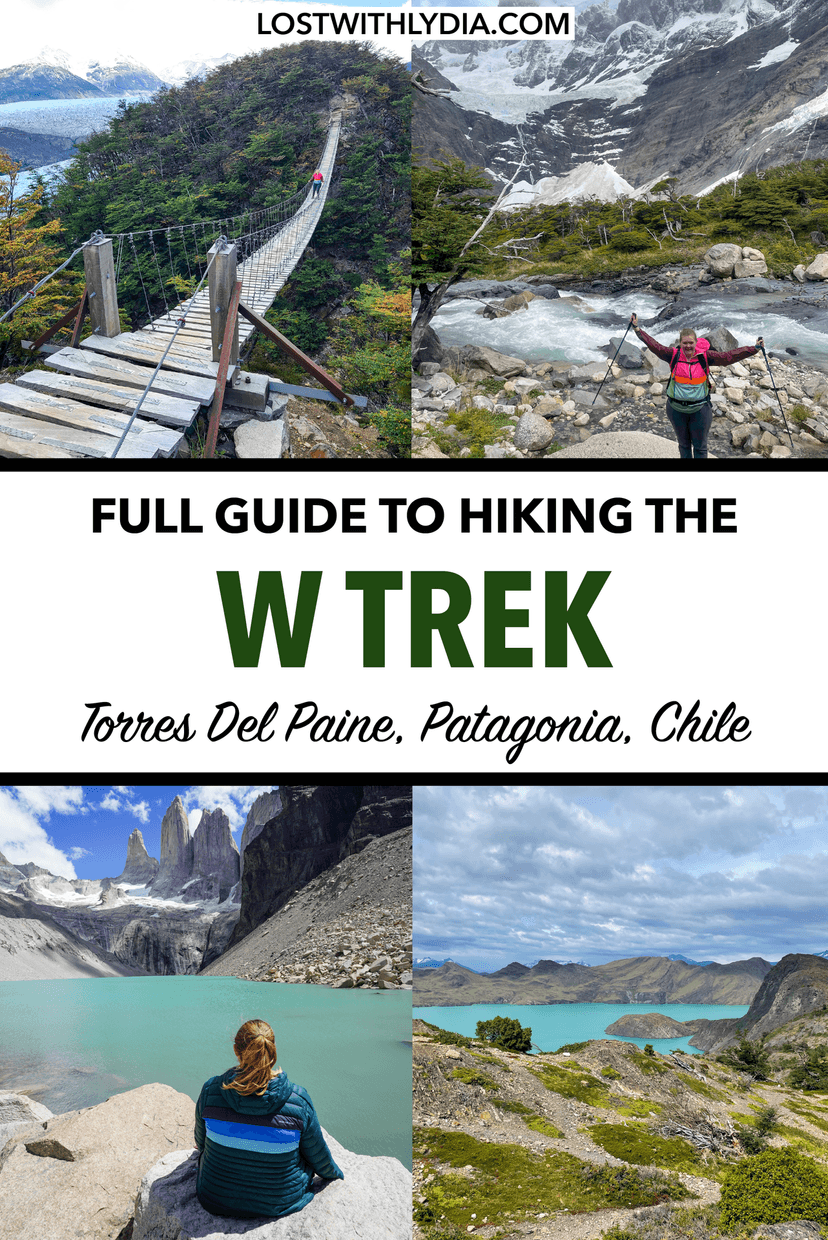
The Best Things To Do in the White Mountains, NH in the Fall
Where to Stay in Yellowstone (Comparing 3 Lodges in the Park)
Let's stay in touch!
Join the Lost with Lydia email list to get monthly travel guides and tips!
You also may like
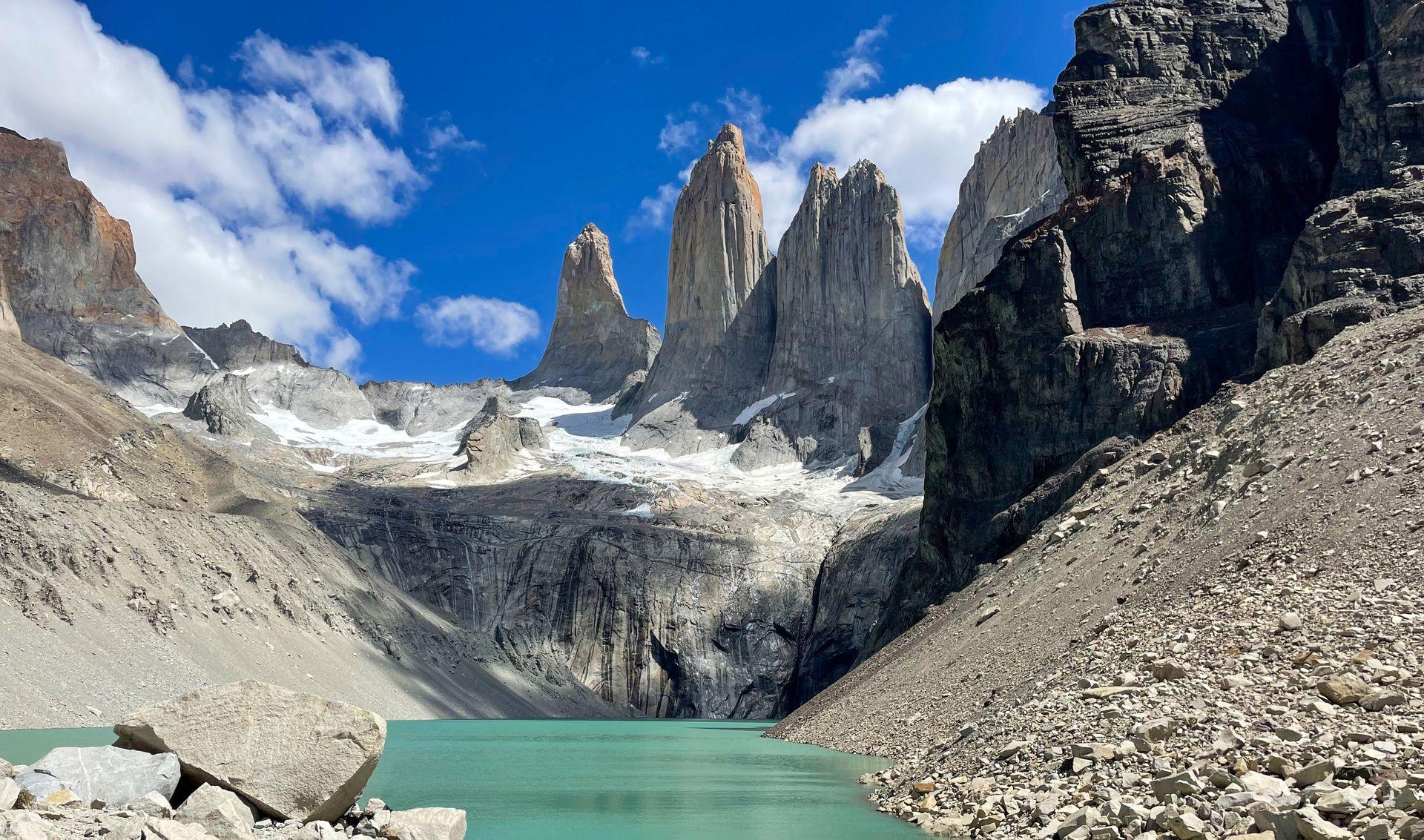
30 Tips for Hiking the W Trek in Patagonia (Self-Guided)
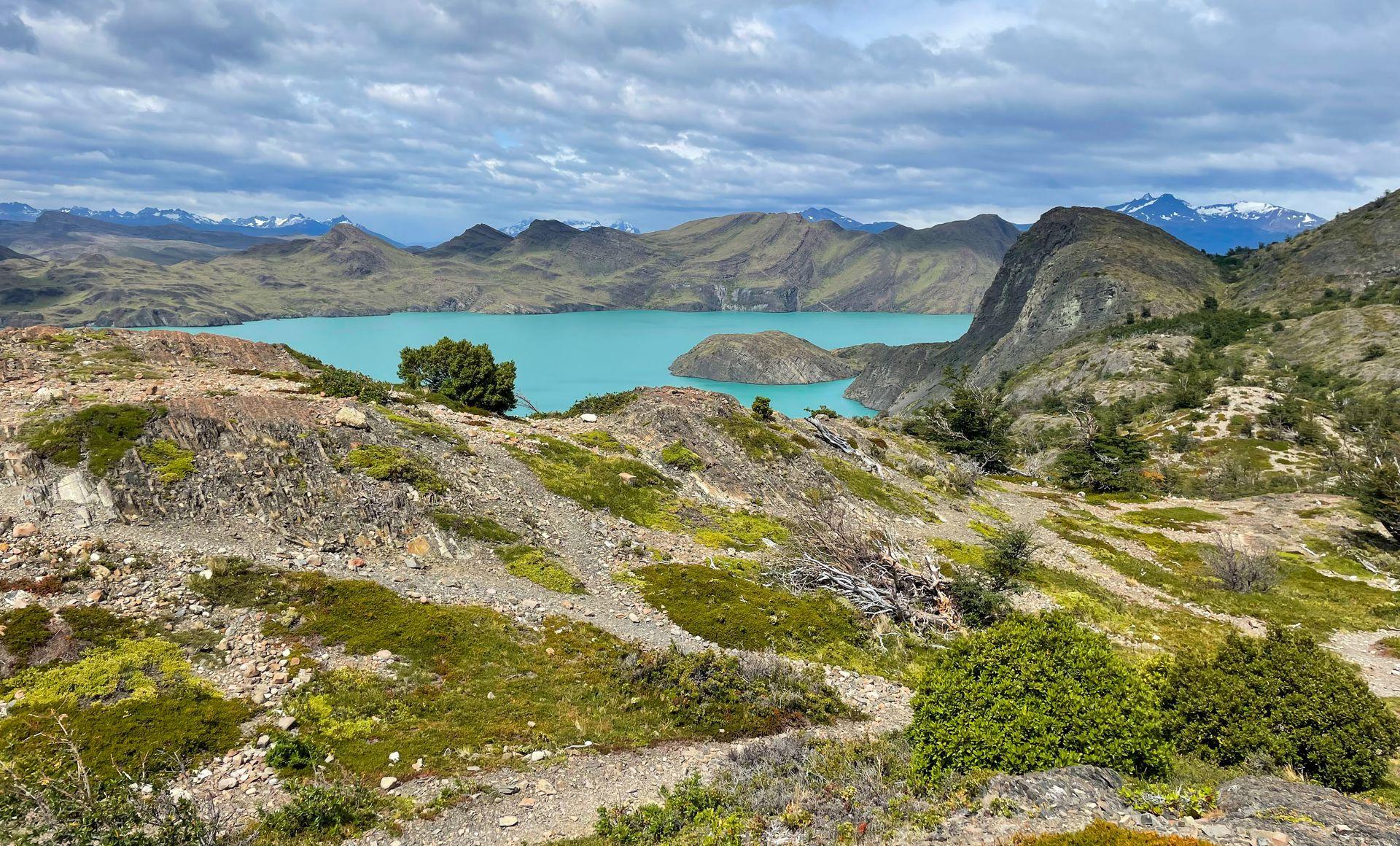
A Detailed W Trek Packing List: The Ultimate Patagonia Hike

IMAGES
VIDEO
COMMENTS
Booking Camping and Accommodation on the W Trail. Bus tickets to and from Torres del Paine. Packing for the W Trek. Our Self-guided itinerary for hiking the W Trail. Day 1 - Puerto Natales to Chileno via Las Torres. Day 2 - Chileno to Francés. Day 3 - Francés to Paine Grande via Francés Valley. Day 4 - Paine Grande to Grey.
Get chilly in Chile on a trek through the winter heart of Torres del Paine!. When one thinks of Torres del Paine National Park, the classic W Trek instantly comes to mind. The two are synonymous. The W offers the absolute best of Torres del Paine: the Grey Glacier, French Valley, the Base of the Towers, and so much more.People hike it and say that it is an unforgettable and life-changing ...
Distance: 13 kilometers (8 miles) plus 8 kilometers (5 miles) for the hike from the Centro de Bienvenida to Laguna Amarga) Duration: 6 hours hiking (add an extra 1.5-2 hours for the hike to Laguna Amarga) 4:30am Wake up and take a small bag (including warm clothes and a snack) to see the torres at dawn.
The Winter W-trek was a truly unique experience, and part of our bucket list of places around the world to go hiking. The highlight of my trip was reaching the Grey Glacier after a long distance hike and having lunch facing the glacier in silence - a moment of pure tranquility. The landscapes we saw varied day to day and we were lucky to see a ...
Overview. As temperatures drop and mountains and valleys sleep, trekkers in-the-know take to Torres del Paine's trails. The W Trek in Winter connects Grey Glacier, the French Valley and Towers lookout on five days of superb hiking fuelled by crisp air and still landscapes - minus the jostling crowds and cramped Refugios.. Trip Highlights • Have Torres del Paine almost to yourself!
The W-Trek is normally walked east to west, starting at Refugio Las Torres and ending at Refugio Paine Grande. It runs up three valleys, creating the W shape that gives it its name. ... Winter (June-August) is more challenging and usually requires a guide but can be an amazing experience. Even during the summer months, be prepared for all types ...
The autumn season runs from March to May, and winter lasts from June to September - and brings with it snow. In winter, only guided group tours are possible, and you must prepare and pack for the cold. ... The W Trek Hiking atop the John Gardner Pass and overlooking the South Patagonia Icefield. Photo: Getty. Distance: 85 miles (136km)
The W Trek can be hiked year-round (including winter with a guide). The busy season is December through late March. This is the warmest time of year, but also when you'll experience the strongest winds. April is Patagonia's fall with beautiful bursts of colors, while November is Spring when you'll encounter wildflower blooms. No matter ...
The Torres Del Paine W Trek in Patagonia is a 5-day, 100km adventure that brings you to some of the best features of Torres Del Paine. Visit Grey Glacier, the base of the Towers, the French Valley, and much more on this epic trek. ... Winter - June to August. Between May- September, self-guided hiking is not permitted in Torres Del Paine. Over ...
The W Trek is a moderately difficult hike lasting around four to five days, covering 46 miles on mainly gentle terrain, with more challenging days involving climbs of 600-800 metres. You need to be in good shape, with some experience of multi-day hiking and prepared for extremely variable weather.
The W Trek in Patagonia is an incredibly scenic hiking trail with three major highlights: the Torres del Paine, French Valley, and Grey Glacier. ... the photography opportunities are endless as the winter snows hang around into spring on the high peaks. Autumn appears in March, April and May, in the South, the temperatures range from 10°C to 2 ...
This is the basic itinerary for the trip: Day 1: Arrival. Day 2: Trek from Las Carretas to Paine Grande. Day 3: Trek to French Valley. Day 4: Trek to Grey. Day 5: Navigation in Grey Lake -- there is not much hiking on this day. Day 6: Base of the Towers trek -- the toughest day (22km)! Day 7: Departure.
Self Guided W Trek Summary. Length: 80 km Duration: 4 nights / 5 days Difficulty: Moderate Highlights: Grey Glacier, Mirador Britanico, Mirador Las Torres National Park entrance fee: $49 Best time: October to April (the only time you can do the W Trek without a guide) You cannot do the W Trek without a guide in Winter
Ascent: 2956 ft of elevation gain. Time: 7 - 9 hours. The first day of this 4 day W trek itinerary in Patagonia will cover a lot of ground. You'll kick off the day bright and early departing from Puerto Natales. A 2-hour drive delivers you to the Laguna Amarga entrance gate of Torres del Paine National Park.
In addition, Torres del Paine is known for its extreme winds which can reach speeds of up to 100 mph (161 kph). The W Trek also packs a lot of walking into single days. For comparison, you are asked to hike between 6-8 miles (9.7-12.9 kilometers) per day on average on an Inca Trail tour.
It may be colder than other months, yet you will be able to experience the real wild Patagonia and a unique feeling of quietness at the feet of snow-covered mountains. And if you're still not convinced, here's why we believe Winter is simply the most epic time to come and do the W Trek. 1. The Trails are Quiet.
Some Highlights of the W Trek in Winter. Changing Colors of Lake Pehoé: ️🌅🎨 During the winter season, the changing colors of Lake Pehoé are an absolute treat for the eyes! As the sun rises and sets, the lake transforms from stunning shades of blue to magical hues of pink, orange, and purple.
DAY 3 - TORRES DEL PAINE W TREK / FRENCH VALLEY DAY HIKE. Distance: 10.67 miles / 17km. Estimated time: 7-8 hours. Maximum altitude: 623 feet / 190 m. What you see: Cuernos del Paine (The Horns), Campamento Italiano, French Valley, French Glacier. We experienced the expertise of our guide on Day 3.
April 12, 2023/. The W trek is roughly a 50 mile (80 km) multi-day hiking route located in Torres del Paine National Park, Chile. The trek is popular because it goes past many of the highlights of the park, requires only a moderate level of fitness, and has a good infrastructure in place which allows hikers to self-guide their own trek.
The best of the W Trek, now in Winter. Ready for a trek of a lifetime? See a different side of the iconic W Trek in Torres del Paine as few have ever seen or experienced it before. Trek into the heart of a Patagonian winter wonderland on this ultimate 6-day experience that takes you to the park's iconic highlights such as the base of the ...
Planning for the W Trek: 1. Research and Plan. Before diving into the packing list, extensive research and meticulous planning are essential. Understand the W Trek's trail conditions, difficulty level, and weather patterns for the specific time of year you plan to visit. Torres del Paine experiences distinct seasons, each with its unique challenges.
What is the W Trek? The W Trek is a 74 to 80 kilometer hike in the Torres Del Paine National Park in the Patagonia region. Torres Del Paine National Park is located in both Chile and Argentina. The W Trek is in the region of the park that is in Chile. It is called the W Trek because the trail takes you in the shape of the letter W.
When to Hike the W Trek. You will most likely hike the W Trek in the summertime for the Southern Hemisphere (winter in the Northern Hemisphere). The W Trek is typically open to hiking self-guided from October to the end of April, and you'll likely have the best weather from November to March.